Managing International Business
VerifiedAdded on 2023/01/23
|69
|20400
|72
AI Summary
This literature review focuses on customer satisfaction and service quality in the context of the general insurance market. It explores the dimensions of service quality, such as tangibles, reliability, responsiveness, assurance, and empathy. The review also discusses the SERVQUAL model and its application in the insurance industry. Recommendations and limitations for further research are provided.
Contribute Materials
Your contribution can guide someone’s learning journey. Share your
documents today.
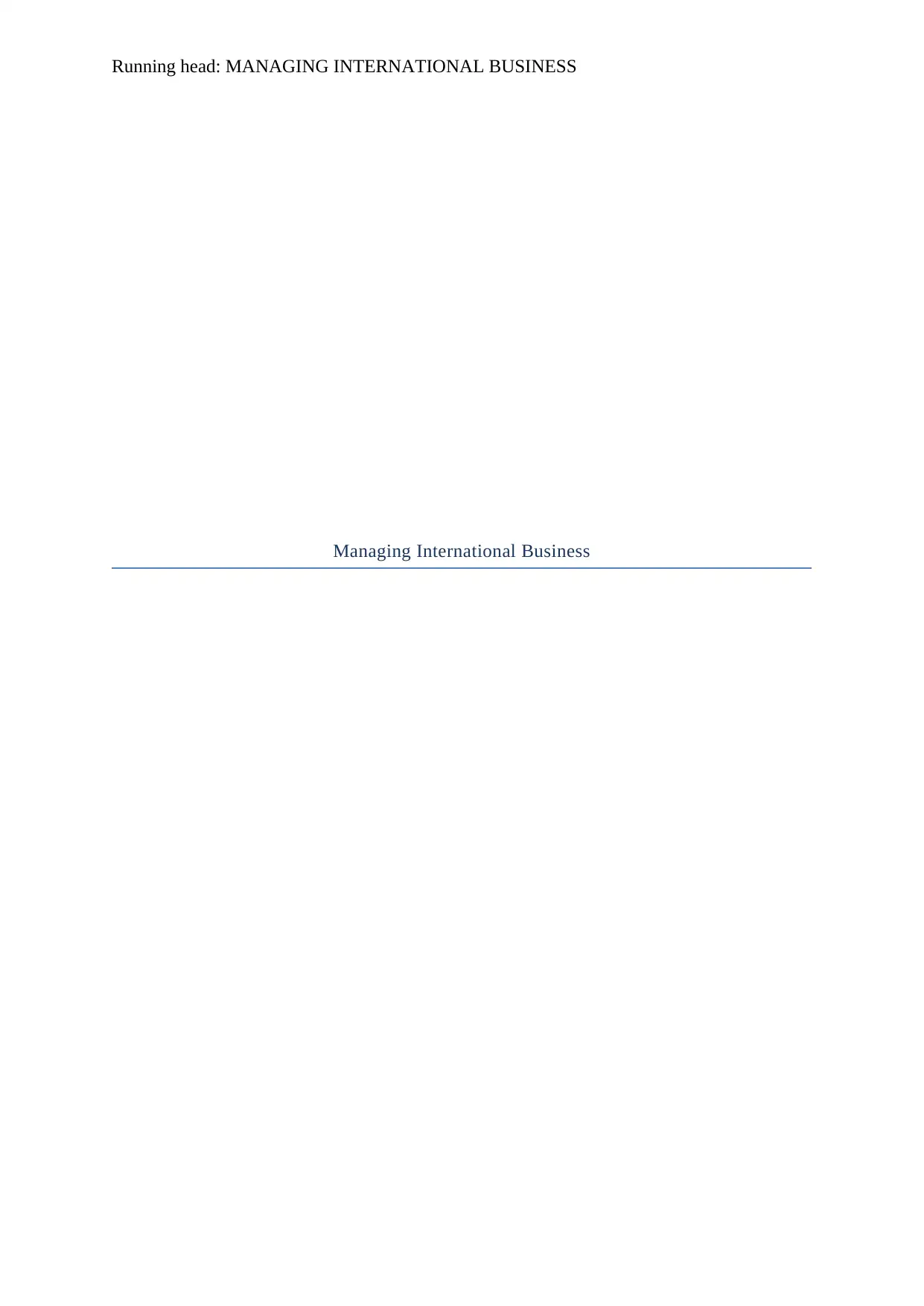
Running head: MANAGING INTERNATIONAL BUSINESS
Managing International Business
Managing International Business
Secure Best Marks with AI Grader
Need help grading? Try our AI Grader for instant feedback on your assignments.
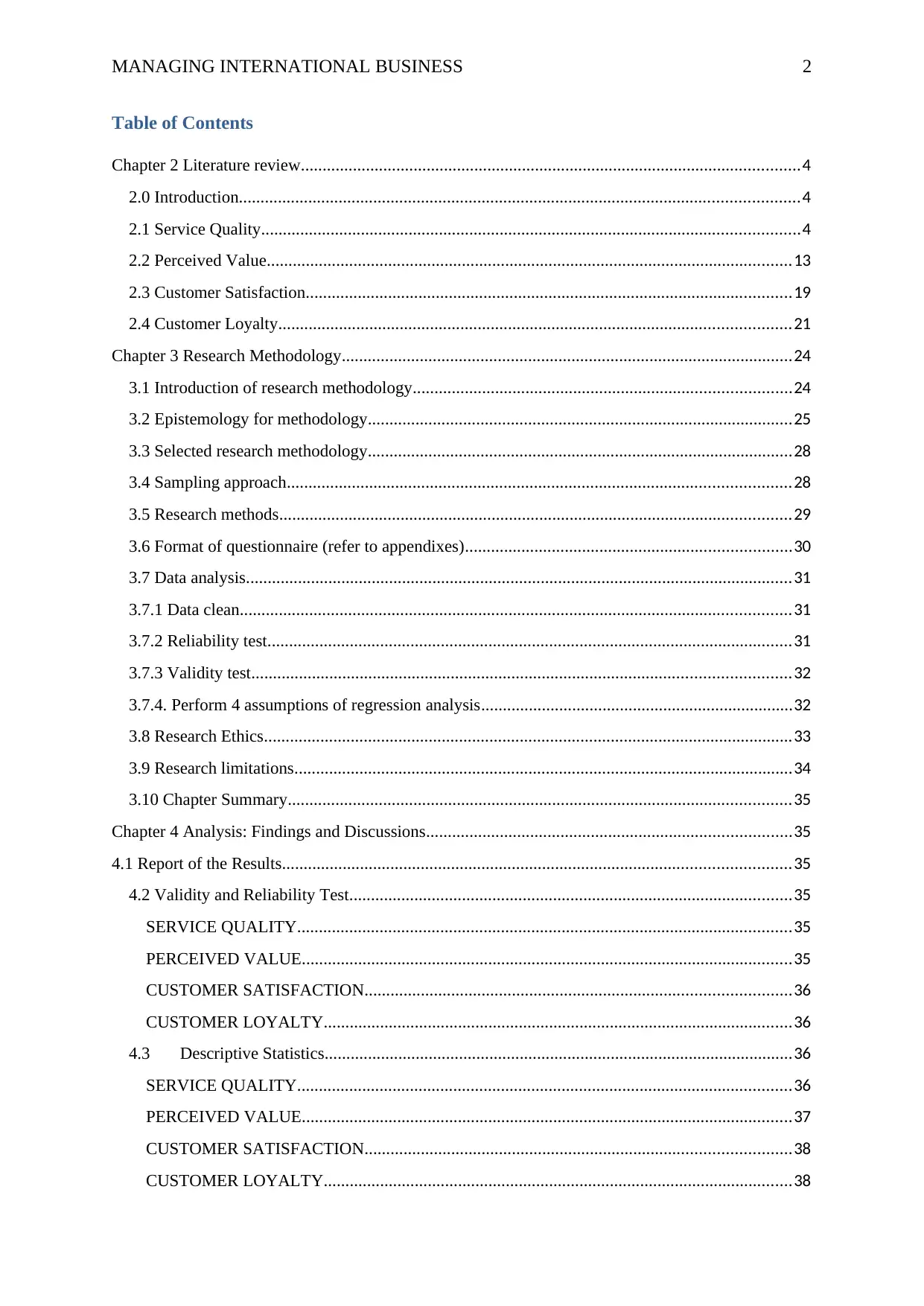
MANAGING INTERNATIONAL BUSINESS 2
Table of Contents
Chapter 2 Literature review...................................................................................................................4
2.0 Introduction.................................................................................................................................4
2.1 Service Quality............................................................................................................................4
2.2 Perceived Value.........................................................................................................................13
2.3 Customer Satisfaction................................................................................................................19
2.4 Customer Loyalty......................................................................................................................21
Chapter 3 Research Methodology........................................................................................................24
3.1 Introduction of research methodology.......................................................................................24
3.2 Epistemology for methodology..................................................................................................25
3.3 Selected research methodology..................................................................................................28
3.4 Sampling approach....................................................................................................................28
3.5 Research methods......................................................................................................................29
3.6 Format of questionnaire (refer to appendixes)...........................................................................30
3.7 Data analysis..............................................................................................................................31
3.7.1 Data clean...............................................................................................................................31
3.7.2 Reliability test.........................................................................................................................31
3.7.3 Validity test............................................................................................................................32
3.7.4. Perform 4 assumptions of regression analysis........................................................................32
3.8 Research Ethics..........................................................................................................................33
3.9 Research limitations...................................................................................................................34
3.10 Chapter Summary....................................................................................................................35
Chapter 4 Analysis: Findings and Discussions....................................................................................35
4.1 Report of the Results.....................................................................................................................35
4.2 Validity and Reliability Test......................................................................................................35
SERVICE QUALITY..................................................................................................................35
PERCEIVED VALUE.................................................................................................................35
CUSTOMER SATISFACTION..................................................................................................36
CUSTOMER LOYALTY............................................................................................................36
4.3 Descriptive Statistics............................................................................................................36
SERVICE QUALITY..................................................................................................................36
PERCEIVED VALUE.................................................................................................................37
CUSTOMER SATISFACTION..................................................................................................38
CUSTOMER LOYALTY............................................................................................................38
Table of Contents
Chapter 2 Literature review...................................................................................................................4
2.0 Introduction.................................................................................................................................4
2.1 Service Quality............................................................................................................................4
2.2 Perceived Value.........................................................................................................................13
2.3 Customer Satisfaction................................................................................................................19
2.4 Customer Loyalty......................................................................................................................21
Chapter 3 Research Methodology........................................................................................................24
3.1 Introduction of research methodology.......................................................................................24
3.2 Epistemology for methodology..................................................................................................25
3.3 Selected research methodology..................................................................................................28
3.4 Sampling approach....................................................................................................................28
3.5 Research methods......................................................................................................................29
3.6 Format of questionnaire (refer to appendixes)...........................................................................30
3.7 Data analysis..............................................................................................................................31
3.7.1 Data clean...............................................................................................................................31
3.7.2 Reliability test.........................................................................................................................31
3.7.3 Validity test............................................................................................................................32
3.7.4. Perform 4 assumptions of regression analysis........................................................................32
3.8 Research Ethics..........................................................................................................................33
3.9 Research limitations...................................................................................................................34
3.10 Chapter Summary....................................................................................................................35
Chapter 4 Analysis: Findings and Discussions....................................................................................35
4.1 Report of the Results.....................................................................................................................35
4.2 Validity and Reliability Test......................................................................................................35
SERVICE QUALITY..................................................................................................................35
PERCEIVED VALUE.................................................................................................................35
CUSTOMER SATISFACTION..................................................................................................36
CUSTOMER LOYALTY............................................................................................................36
4.3 Descriptive Statistics............................................................................................................36
SERVICE QUALITY..................................................................................................................36
PERCEIVED VALUE.................................................................................................................37
CUSTOMER SATISFACTION..................................................................................................38
CUSTOMER LOYALTY............................................................................................................38
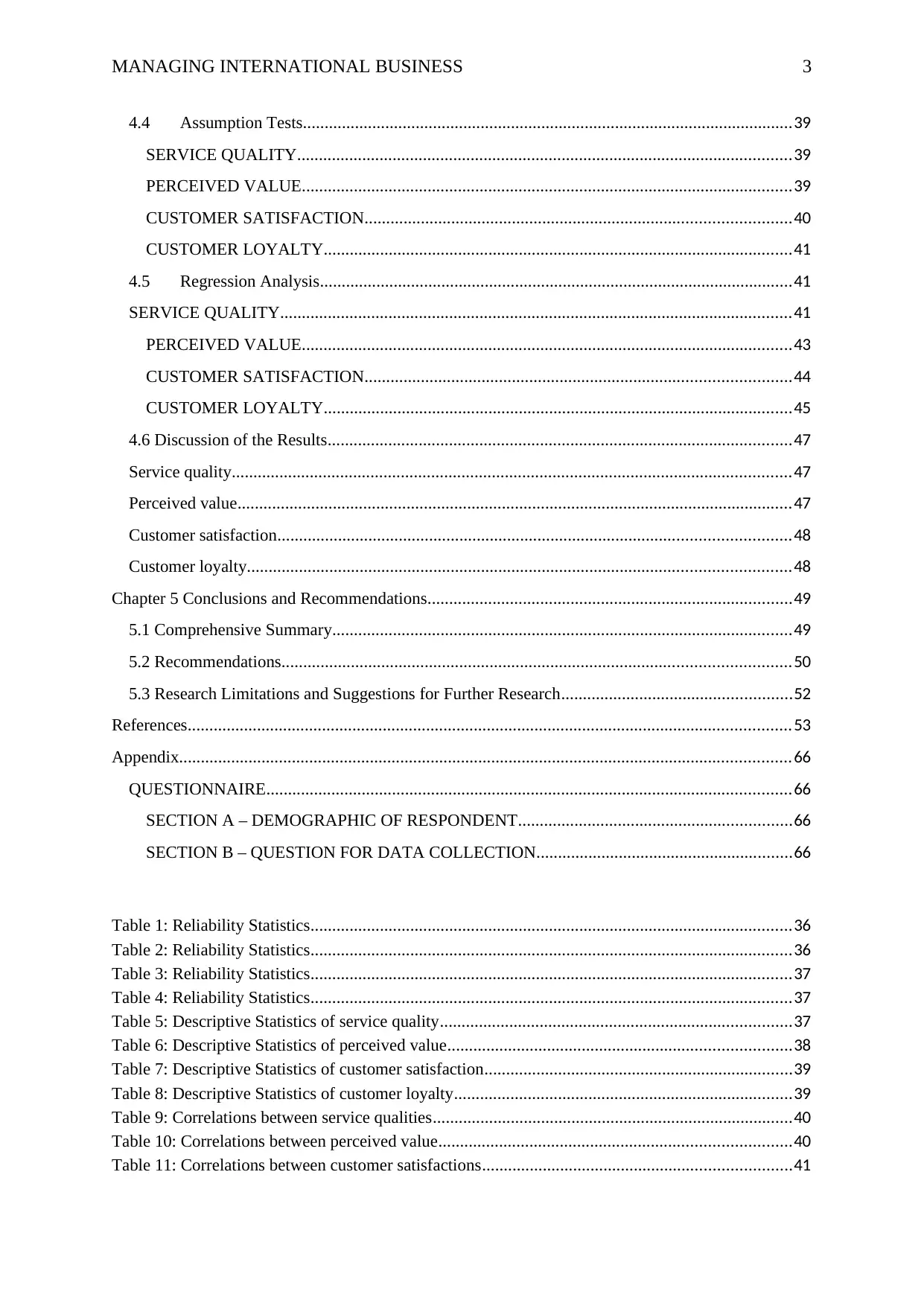
MANAGING INTERNATIONAL BUSINESS 3
4.4 Assumption Tests.................................................................................................................39
SERVICE QUALITY..................................................................................................................39
PERCEIVED VALUE.................................................................................................................39
CUSTOMER SATISFACTION..................................................................................................40
CUSTOMER LOYALTY............................................................................................................41
4.5 Regression Analysis.............................................................................................................41
SERVICE QUALITY......................................................................................................................41
PERCEIVED VALUE.................................................................................................................43
CUSTOMER SATISFACTION..................................................................................................44
CUSTOMER LOYALTY............................................................................................................45
4.6 Discussion of the Results...........................................................................................................47
Service quality.................................................................................................................................47
Perceived value................................................................................................................................47
Customer satisfaction......................................................................................................................48
Customer loyalty.............................................................................................................................48
Chapter 5 Conclusions and Recommendations....................................................................................49
5.1 Comprehensive Summary..........................................................................................................49
5.2 Recommendations.....................................................................................................................50
5.3 Research Limitations and Suggestions for Further Research.....................................................52
References...........................................................................................................................................53
Appendix.............................................................................................................................................66
QUESTIONNAIRE.........................................................................................................................66
SECTION A – DEMOGRAPHIC OF RESPONDENT...............................................................66
SECTION B – QUESTION FOR DATA COLLECTION...........................................................66
Table 1: Reliability Statistics...............................................................................................................36
Table 2: Reliability Statistics...............................................................................................................36
Table 3: Reliability Statistics...............................................................................................................37
Table 4: Reliability Statistics...............................................................................................................37
Table 5: Descriptive Statistics of service quality.................................................................................37
Table 6: Descriptive Statistics of perceived value...............................................................................38
Table 7: Descriptive Statistics of customer satisfaction.......................................................................39
Table 8: Descriptive Statistics of customer loyalty..............................................................................39
Table 9: Correlations between service qualities...................................................................................40
Table 10: Correlations between perceived value.................................................................................40
Table 11: Correlations between customer satisfactions.......................................................................41
4.4 Assumption Tests.................................................................................................................39
SERVICE QUALITY..................................................................................................................39
PERCEIVED VALUE.................................................................................................................39
CUSTOMER SATISFACTION..................................................................................................40
CUSTOMER LOYALTY............................................................................................................41
4.5 Regression Analysis.............................................................................................................41
SERVICE QUALITY......................................................................................................................41
PERCEIVED VALUE.................................................................................................................43
CUSTOMER SATISFACTION..................................................................................................44
CUSTOMER LOYALTY............................................................................................................45
4.6 Discussion of the Results...........................................................................................................47
Service quality.................................................................................................................................47
Perceived value................................................................................................................................47
Customer satisfaction......................................................................................................................48
Customer loyalty.............................................................................................................................48
Chapter 5 Conclusions and Recommendations....................................................................................49
5.1 Comprehensive Summary..........................................................................................................49
5.2 Recommendations.....................................................................................................................50
5.3 Research Limitations and Suggestions for Further Research.....................................................52
References...........................................................................................................................................53
Appendix.............................................................................................................................................66
QUESTIONNAIRE.........................................................................................................................66
SECTION A – DEMOGRAPHIC OF RESPONDENT...............................................................66
SECTION B – QUESTION FOR DATA COLLECTION...........................................................66
Table 1: Reliability Statistics...............................................................................................................36
Table 2: Reliability Statistics...............................................................................................................36
Table 3: Reliability Statistics...............................................................................................................37
Table 4: Reliability Statistics...............................................................................................................37
Table 5: Descriptive Statistics of service quality.................................................................................37
Table 6: Descriptive Statistics of perceived value...............................................................................38
Table 7: Descriptive Statistics of customer satisfaction.......................................................................39
Table 8: Descriptive Statistics of customer loyalty..............................................................................39
Table 9: Correlations between service qualities...................................................................................40
Table 10: Correlations between perceived value.................................................................................40
Table 11: Correlations between customer satisfactions.......................................................................41
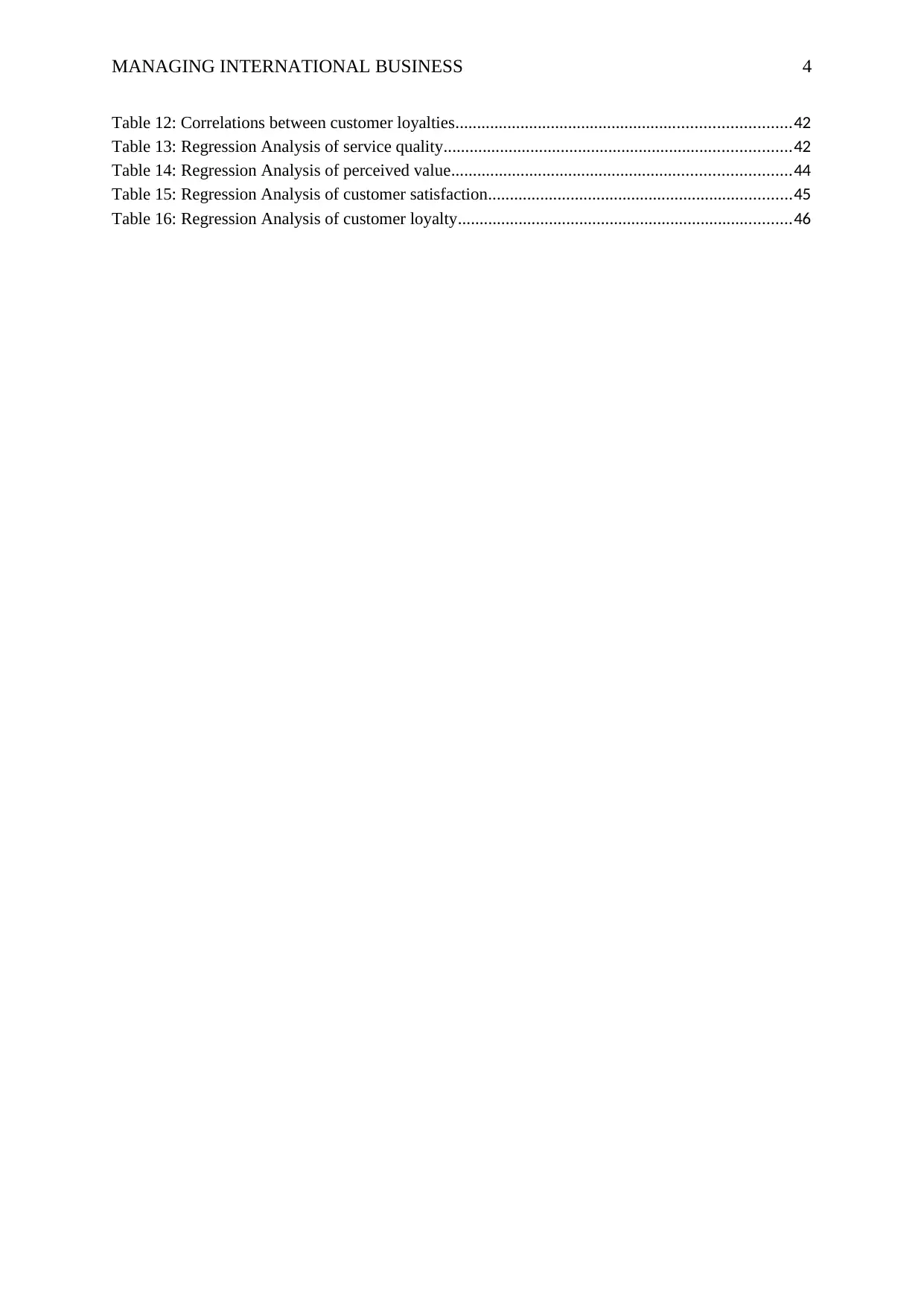
MANAGING INTERNATIONAL BUSINESS 4
Table 12: Correlations between customer loyalties.............................................................................42
Table 13: Regression Analysis of service quality................................................................................42
Table 14: Regression Analysis of perceived value..............................................................................44
Table 15: Regression Analysis of customer satisfaction......................................................................45
Table 16: Regression Analysis of customer loyalty.............................................................................46
Table 12: Correlations between customer loyalties.............................................................................42
Table 13: Regression Analysis of service quality................................................................................42
Table 14: Regression Analysis of perceived value..............................................................................44
Table 15: Regression Analysis of customer satisfaction......................................................................45
Table 16: Regression Analysis of customer loyalty.............................................................................46
Secure Best Marks with AI Grader
Need help grading? Try our AI Grader for instant feedback on your assignments.
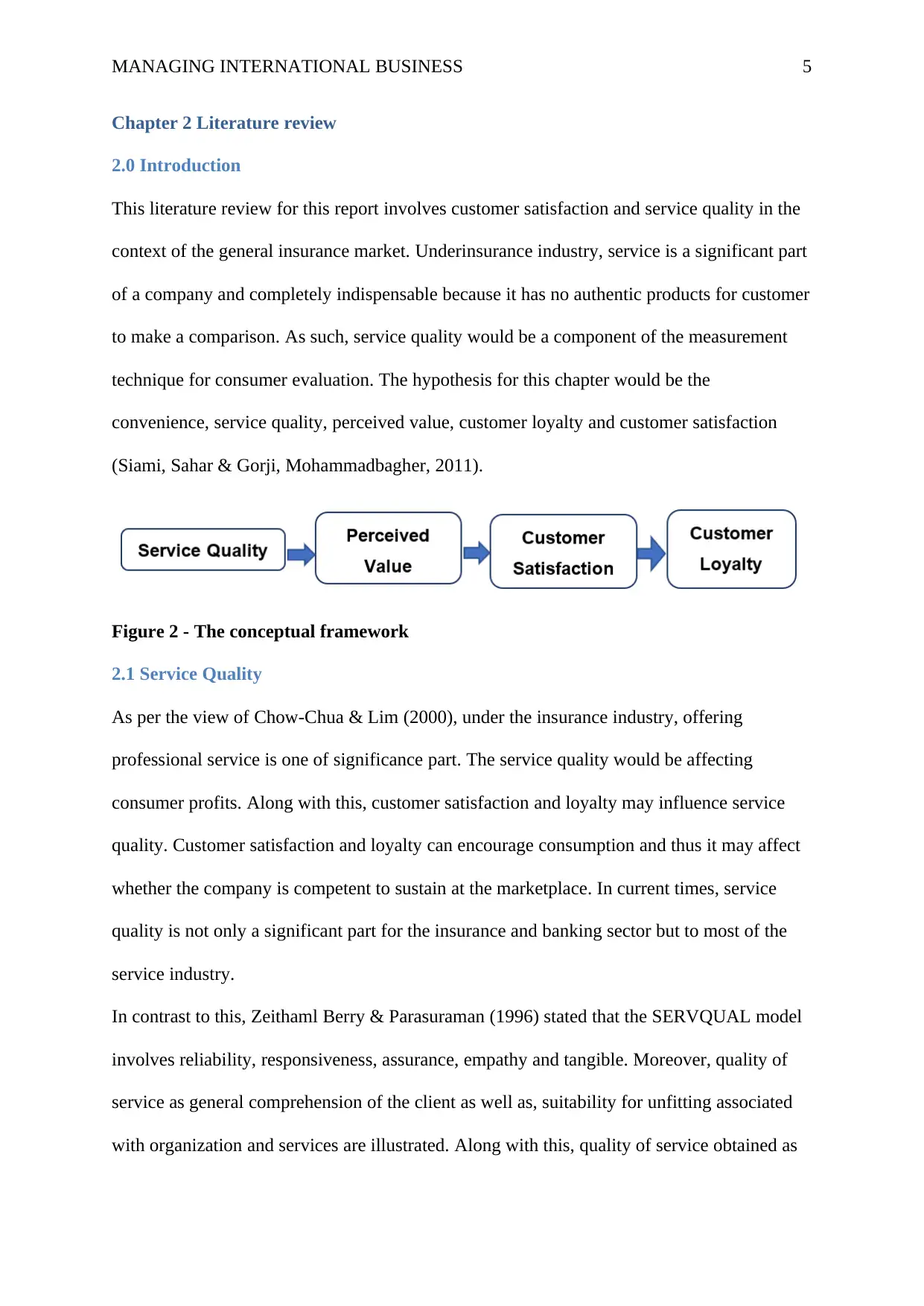
MANAGING INTERNATIONAL BUSINESS 5
Chapter 2 Literature review
2.0 Introduction
This literature review for this report involves customer satisfaction and service quality in the
context of the general insurance market. Underinsurance industry, service is a significant part
of a company and completely indispensable because it has no authentic products for customer
to make a comparison. As such, service quality would be a component of the measurement
technique for consumer evaluation. The hypothesis for this chapter would be the
convenience, service quality, perceived value, customer loyalty and customer satisfaction
(Siami, Sahar & Gorji, Mohammadbagher, 2011).
Figure 2 - The conceptual framework
2.1 Service Quality
As per the view of Chow-Chua & Lim (2000), under the insurance industry, offering
professional service is one of significance part. The service quality would be affecting
consumer profits. Along with this, customer satisfaction and loyalty may influence service
quality. Customer satisfaction and loyalty can encourage consumption and thus it may affect
whether the company is competent to sustain at the marketplace. In current times, service
quality is not only a significant part for the insurance and banking sector but to most of the
service industry.
In contrast to this, Zeithaml Berry & Parasuraman (1996) stated that the SERVQUAL model
involves reliability, responsiveness, assurance, empathy and tangible. Moreover, quality of
service as general comprehension of the client as well as, suitability for unfitting associated
with organization and services are illustrated. Along with this, quality of service obtained as
Chapter 2 Literature review
2.0 Introduction
This literature review for this report involves customer satisfaction and service quality in the
context of the general insurance market. Underinsurance industry, service is a significant part
of a company and completely indispensable because it has no authentic products for customer
to make a comparison. As such, service quality would be a component of the measurement
technique for consumer evaluation. The hypothesis for this chapter would be the
convenience, service quality, perceived value, customer loyalty and customer satisfaction
(Siami, Sahar & Gorji, Mohammadbagher, 2011).
Figure 2 - The conceptual framework
2.1 Service Quality
As per the view of Chow-Chua & Lim (2000), under the insurance industry, offering
professional service is one of significance part. The service quality would be affecting
consumer profits. Along with this, customer satisfaction and loyalty may influence service
quality. Customer satisfaction and loyalty can encourage consumption and thus it may affect
whether the company is competent to sustain at the marketplace. In current times, service
quality is not only a significant part for the insurance and banking sector but to most of the
service industry.
In contrast to this, Zeithaml Berry & Parasuraman (1996) stated that the SERVQUAL model
involves reliability, responsiveness, assurance, empathy and tangible. Moreover, quality of
service as general comprehension of the client as well as, suitability for unfitting associated
with organization and services are illustrated. Along with this, quality of service obtained as
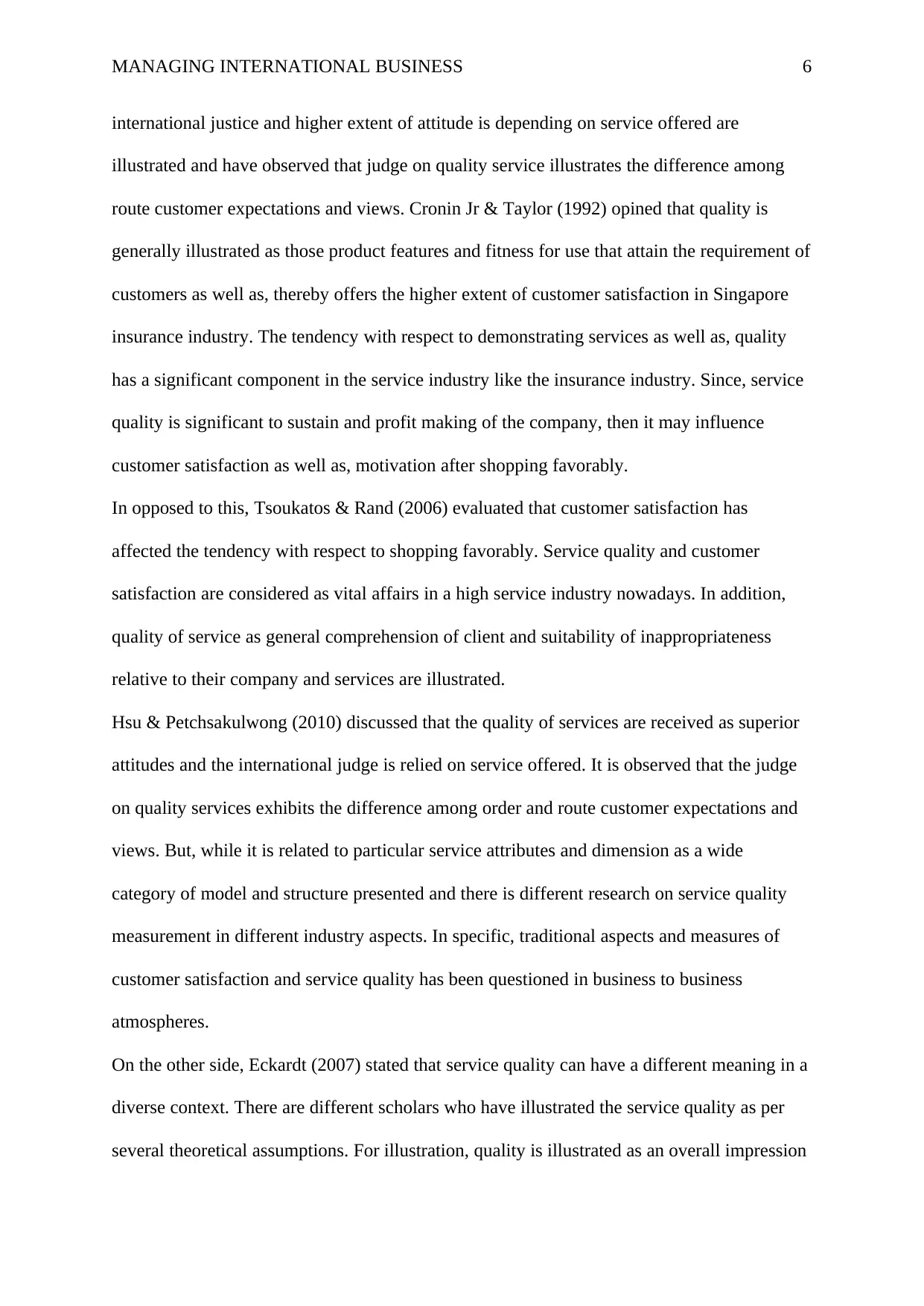
MANAGING INTERNATIONAL BUSINESS 6
international justice and higher extent of attitude is depending on service offered are
illustrated and have observed that judge on quality service illustrates the difference among
route customer expectations and views. Cronin Jr & Taylor (1992) opined that quality is
generally illustrated as those product features and fitness for use that attain the requirement of
customers as well as, thereby offers the higher extent of customer satisfaction in Singapore
insurance industry. The tendency with respect to demonstrating services as well as, quality
has a significant component in the service industry like the insurance industry. Since, service
quality is significant to sustain and profit making of the company, then it may influence
customer satisfaction as well as, motivation after shopping favorably.
In opposed to this, Tsoukatos & Rand (2006) evaluated that customer satisfaction has
affected the tendency with respect to shopping favorably. Service quality and customer
satisfaction are considered as vital affairs in a high service industry nowadays. In addition,
quality of service as general comprehension of client and suitability of inappropriateness
relative to their company and services are illustrated.
Hsu & Petchsakulwong (2010) discussed that the quality of services are received as superior
attitudes and the international judge is relied on service offered. It is observed that the judge
on quality services exhibits the difference among order and route customer expectations and
views. But, while it is related to particular service attributes and dimension as a wide
category of model and structure presented and there is different research on service quality
measurement in different industry aspects. In specific, traditional aspects and measures of
customer satisfaction and service quality has been questioned in business to business
atmospheres.
On the other side, Eckardt (2007) stated that service quality can have a different meaning in a
diverse context. There are different scholars who have illustrated the service quality as per
several theoretical assumptions. For illustration, quality is illustrated as an overall impression
international justice and higher extent of attitude is depending on service offered are
illustrated and have observed that judge on quality service illustrates the difference among
route customer expectations and views. Cronin Jr & Taylor (1992) opined that quality is
generally illustrated as those product features and fitness for use that attain the requirement of
customers as well as, thereby offers the higher extent of customer satisfaction in Singapore
insurance industry. The tendency with respect to demonstrating services as well as, quality
has a significant component in the service industry like the insurance industry. Since, service
quality is significant to sustain and profit making of the company, then it may influence
customer satisfaction as well as, motivation after shopping favorably.
In opposed to this, Tsoukatos & Rand (2006) evaluated that customer satisfaction has
affected the tendency with respect to shopping favorably. Service quality and customer
satisfaction are considered as vital affairs in a high service industry nowadays. In addition,
quality of service as general comprehension of client and suitability of inappropriateness
relative to their company and services are illustrated.
Hsu & Petchsakulwong (2010) discussed that the quality of services are received as superior
attitudes and the international judge is relied on service offered. It is observed that the judge
on quality services exhibits the difference among order and route customer expectations and
views. But, while it is related to particular service attributes and dimension as a wide
category of model and structure presented and there is different research on service quality
measurement in different industry aspects. In specific, traditional aspects and measures of
customer satisfaction and service quality has been questioned in business to business
atmospheres.
On the other side, Eckardt (2007) stated that service quality can have a different meaning in a
diverse context. There are different scholars who have illustrated the service quality as per
several theoretical assumptions. For illustration, quality is illustrated as an overall impression
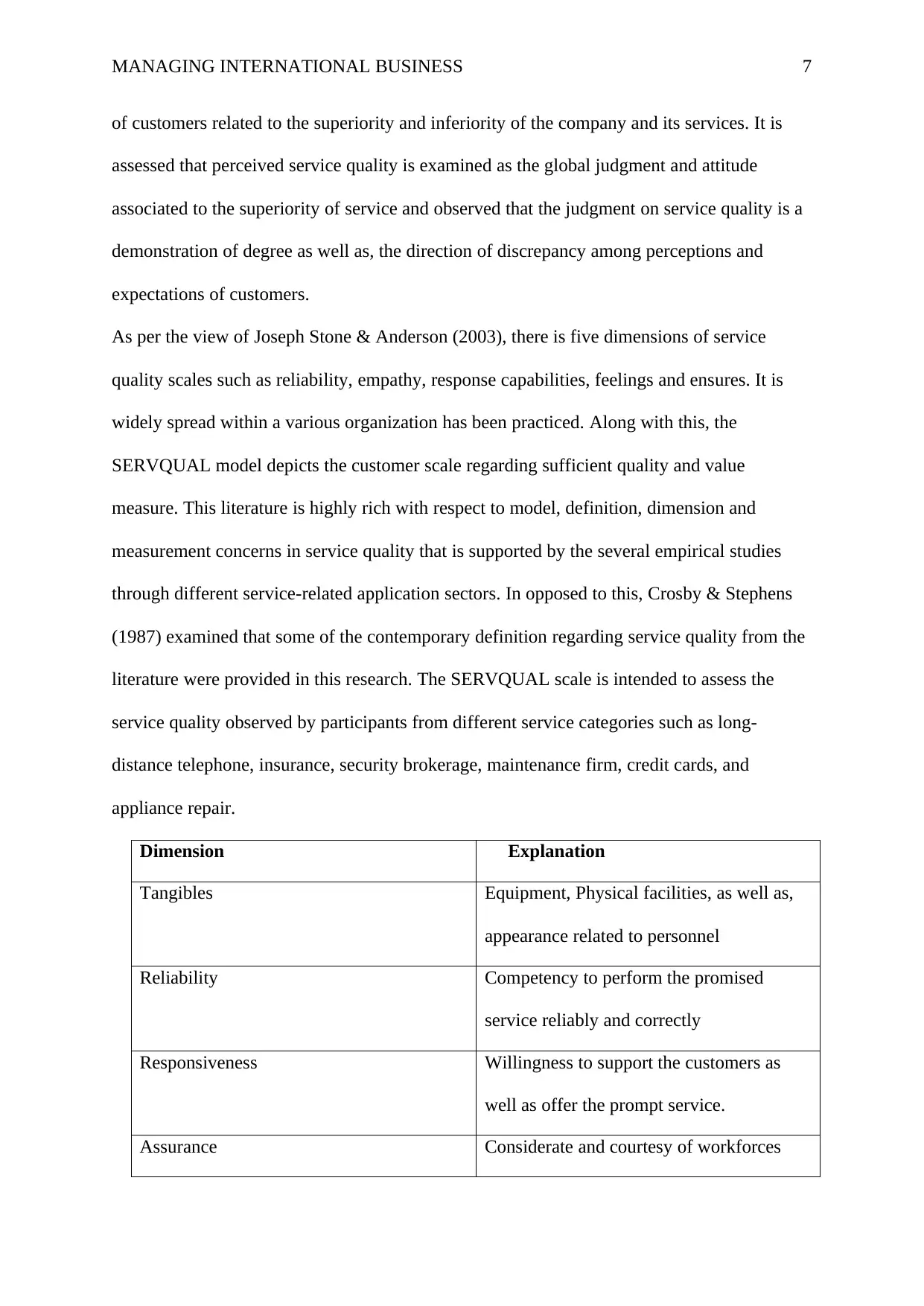
MANAGING INTERNATIONAL BUSINESS 7
of customers related to the superiority and inferiority of the company and its services. It is
assessed that perceived service quality is examined as the global judgment and attitude
associated to the superiority of service and observed that the judgment on service quality is a
demonstration of degree as well as, the direction of discrepancy among perceptions and
expectations of customers.
As per the view of Joseph Stone & Anderson (2003), there is five dimensions of service
quality scales such as reliability, empathy, response capabilities, feelings and ensures. It is
widely spread within a various organization has been practiced. Along with this, the
SERVQUAL model depicts the customer scale regarding sufficient quality and value
measure. This literature is highly rich with respect to model, definition, dimension and
measurement concerns in service quality that is supported by the several empirical studies
through different service-related application sectors. In opposed to this, Crosby & Stephens
(1987) examined that some of the contemporary definition regarding service quality from the
literature were provided in this research. The SERVQUAL scale is intended to assess the
service quality observed by participants from different service categories such as long-
distance telephone, insurance, security brokerage, maintenance firm, credit cards, and
appliance repair.
Dimension Explanation
Tangibles Equipment, Physical facilities, as well as,
appearance related to personnel
Reliability Competency to perform the promised
service reliably and correctly
Responsiveness Willingness to support the customers as
well as offer the prompt service.
Assurance Considerate and courtesy of workforces
of customers related to the superiority and inferiority of the company and its services. It is
assessed that perceived service quality is examined as the global judgment and attitude
associated to the superiority of service and observed that the judgment on service quality is a
demonstration of degree as well as, the direction of discrepancy among perceptions and
expectations of customers.
As per the view of Joseph Stone & Anderson (2003), there is five dimensions of service
quality scales such as reliability, empathy, response capabilities, feelings and ensures. It is
widely spread within a various organization has been practiced. Along with this, the
SERVQUAL model depicts the customer scale regarding sufficient quality and value
measure. This literature is highly rich with respect to model, definition, dimension and
measurement concerns in service quality that is supported by the several empirical studies
through different service-related application sectors. In opposed to this, Crosby & Stephens
(1987) examined that some of the contemporary definition regarding service quality from the
literature were provided in this research. The SERVQUAL scale is intended to assess the
service quality observed by participants from different service categories such as long-
distance telephone, insurance, security brokerage, maintenance firm, credit cards, and
appliance repair.
Dimension Explanation
Tangibles Equipment, Physical facilities, as well as,
appearance related to personnel
Reliability Competency to perform the promised
service reliably and correctly
Responsiveness Willingness to support the customers as
well as offer the prompt service.
Assurance Considerate and courtesy of workforces
Paraphrase This Document
Need a fresh take? Get an instant paraphrase of this document with our AI Paraphraser
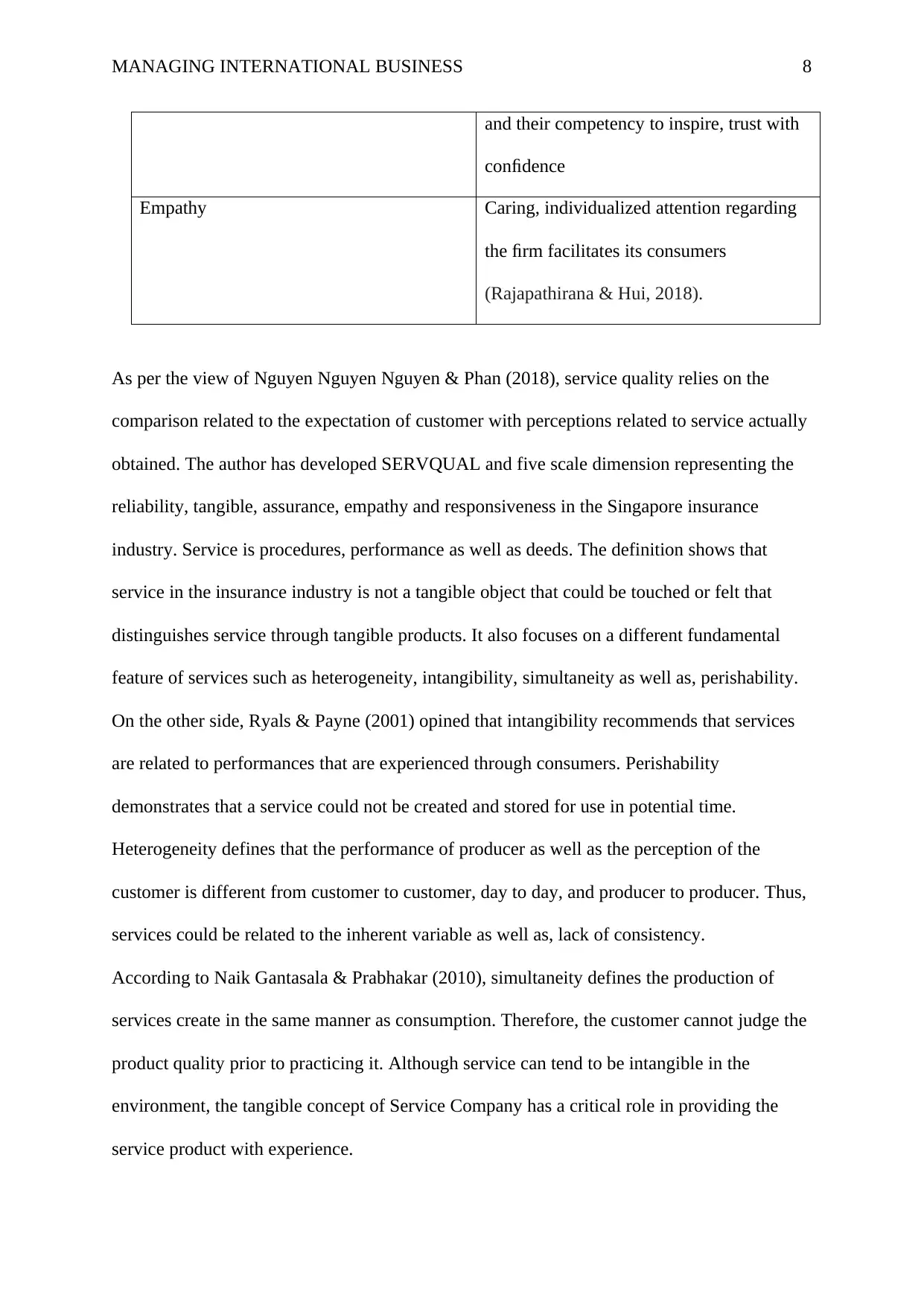
MANAGING INTERNATIONAL BUSINESS 8
and their competency to inspire, trust with
confidence
Empathy Caring, individualized attention regarding
the firm facilitates its consumers
(Rajapathirana & Hui, 2018).
As per the view of Nguyen Nguyen Nguyen & Phan (2018), service quality relies on the
comparison related to the expectation of customer with perceptions related to service actually
obtained. The author has developed SERVQUAL and five scale dimension representing the
reliability, tangible, assurance, empathy and responsiveness in the Singapore insurance
industry. Service is procedures, performance as well as deeds. The definition shows that
service in the insurance industry is not a tangible object that could be touched or felt that
distinguishes service through tangible products. It also focuses on a different fundamental
feature of services such as heterogeneity, intangibility, simultaneity as well as, perishability.
On the other side, Ryals & Payne (2001) opined that intangibility recommends that services
are related to performances that are experienced through consumers. Perishability
demonstrates that a service could not be created and stored for use in potential time.
Heterogeneity defines that the performance of producer as well as the perception of the
customer is different from customer to customer, day to day, and producer to producer. Thus,
services could be related to the inherent variable as well as, lack of consistency.
According to Naik Gantasala & Prabhakar (2010), simultaneity defines the production of
services create in the same manner as consumption. Therefore, the customer cannot judge the
product quality prior to practicing it. Although service can tend to be intangible in the
environment, the tangible concept of Service Company has a critical role in providing the
service product with experience.
and their competency to inspire, trust with
confidence
Empathy Caring, individualized attention regarding
the firm facilitates its consumers
(Rajapathirana & Hui, 2018).
As per the view of Nguyen Nguyen Nguyen & Phan (2018), service quality relies on the
comparison related to the expectation of customer with perceptions related to service actually
obtained. The author has developed SERVQUAL and five scale dimension representing the
reliability, tangible, assurance, empathy and responsiveness in the Singapore insurance
industry. Service is procedures, performance as well as deeds. The definition shows that
service in the insurance industry is not a tangible object that could be touched or felt that
distinguishes service through tangible products. It also focuses on a different fundamental
feature of services such as heterogeneity, intangibility, simultaneity as well as, perishability.
On the other side, Ryals & Payne (2001) opined that intangibility recommends that services
are related to performances that are experienced through consumers. Perishability
demonstrates that a service could not be created and stored for use in potential time.
Heterogeneity defines that the performance of producer as well as the perception of the
customer is different from customer to customer, day to day, and producer to producer. Thus,
services could be related to the inherent variable as well as, lack of consistency.
According to Naik Gantasala & Prabhakar (2010), simultaneity defines the production of
services create in the same manner as consumption. Therefore, the customer cannot judge the
product quality prior to practicing it. Although service can tend to be intangible in the
environment, the tangible concept of Service Company has a critical role in providing the
service product with experience.
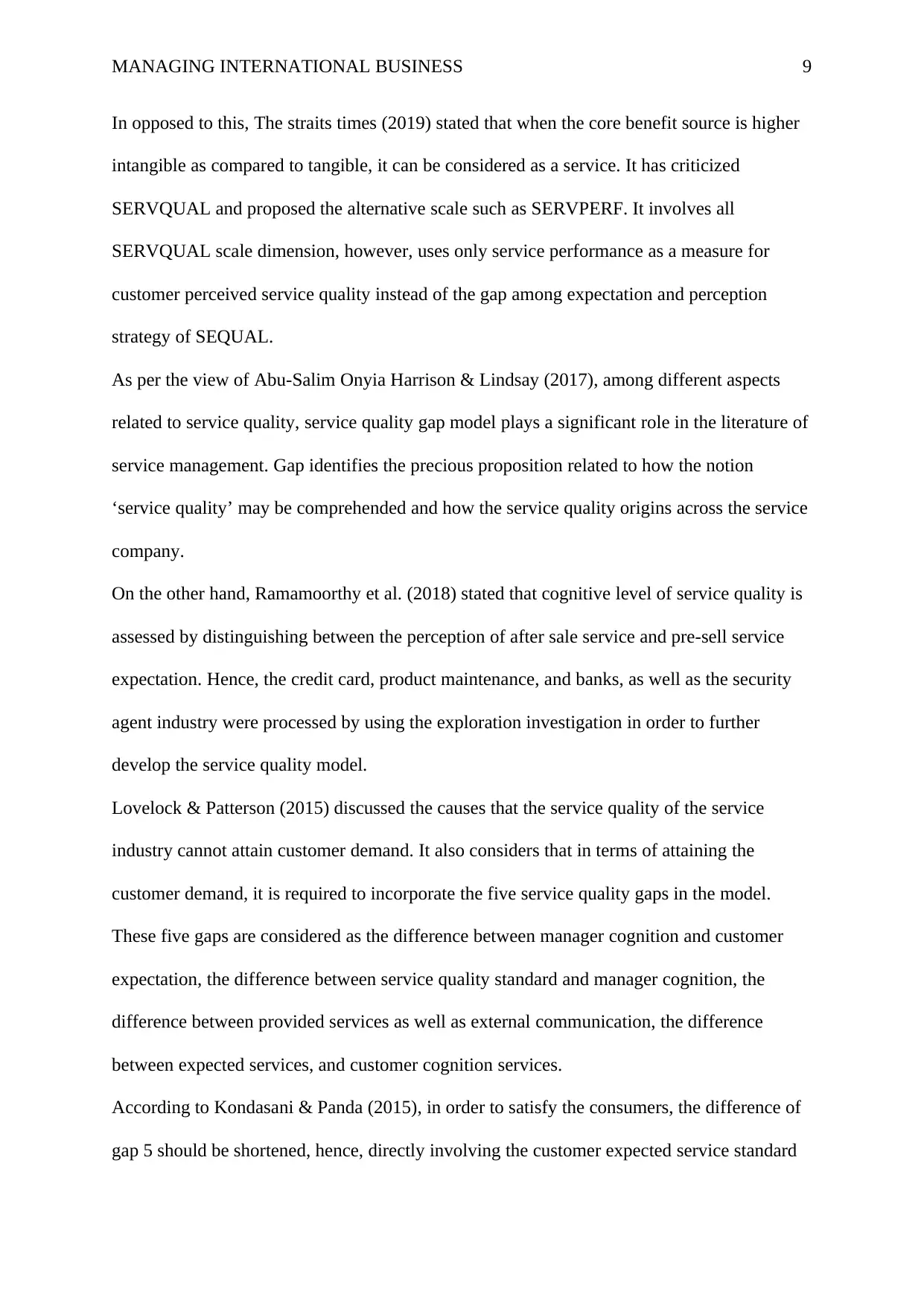
MANAGING INTERNATIONAL BUSINESS 9
In opposed to this, The straits times (2019) stated that when the core benefit source is higher
intangible as compared to tangible, it can be considered as a service. It has criticized
SERVQUAL and proposed the alternative scale such as SERVPERF. It involves all
SERVQUAL scale dimension, however, uses only service performance as a measure for
customer perceived service quality instead of the gap among expectation and perception
strategy of SEQUAL.
As per the view of Abu-Salim Onyia Harrison & Lindsay (2017), among different aspects
related to service quality, service quality gap model plays a significant role in the literature of
service management. Gap identifies the precious proposition related to how the notion
‘service quality’ may be comprehended and how the service quality origins across the service
company.
On the other hand, Ramamoorthy et al. (2018) stated that cognitive level of service quality is
assessed by distinguishing between the perception of after sale service and pre-sell service
expectation. Hence, the credit card, product maintenance, and banks, as well as the security
agent industry were processed by using the exploration investigation in order to further
develop the service quality model.
Lovelock & Patterson (2015) discussed the causes that the service quality of the service
industry cannot attain customer demand. It also considers that in terms of attaining the
customer demand, it is required to incorporate the five service quality gaps in the model.
These five gaps are considered as the difference between manager cognition and customer
expectation, the difference between service quality standard and manager cognition, the
difference between provided services as well as external communication, the difference
between expected services, and customer cognition services.
According to Kondasani & Panda (2015), in order to satisfy the consumers, the difference of
gap 5 should be shortened, hence, directly involving the customer expected service standard
In opposed to this, The straits times (2019) stated that when the core benefit source is higher
intangible as compared to tangible, it can be considered as a service. It has criticized
SERVQUAL and proposed the alternative scale such as SERVPERF. It involves all
SERVQUAL scale dimension, however, uses only service performance as a measure for
customer perceived service quality instead of the gap among expectation and perception
strategy of SEQUAL.
As per the view of Abu-Salim Onyia Harrison & Lindsay (2017), among different aspects
related to service quality, service quality gap model plays a significant role in the literature of
service management. Gap identifies the precious proposition related to how the notion
‘service quality’ may be comprehended and how the service quality origins across the service
company.
On the other hand, Ramamoorthy et al. (2018) stated that cognitive level of service quality is
assessed by distinguishing between the perception of after sale service and pre-sell service
expectation. Hence, the credit card, product maintenance, and banks, as well as the security
agent industry were processed by using the exploration investigation in order to further
develop the service quality model.
Lovelock & Patterson (2015) discussed the causes that the service quality of the service
industry cannot attain customer demand. It also considers that in terms of attaining the
customer demand, it is required to incorporate the five service quality gaps in the model.
These five gaps are considered as the difference between manager cognition and customer
expectation, the difference between service quality standard and manager cognition, the
difference between provided services as well as external communication, the difference
between expected services, and customer cognition services.
According to Kondasani & Panda (2015), in order to satisfy the consumers, the difference of
gap 5 should be shortened, hence, directly involving the customer expected service standard
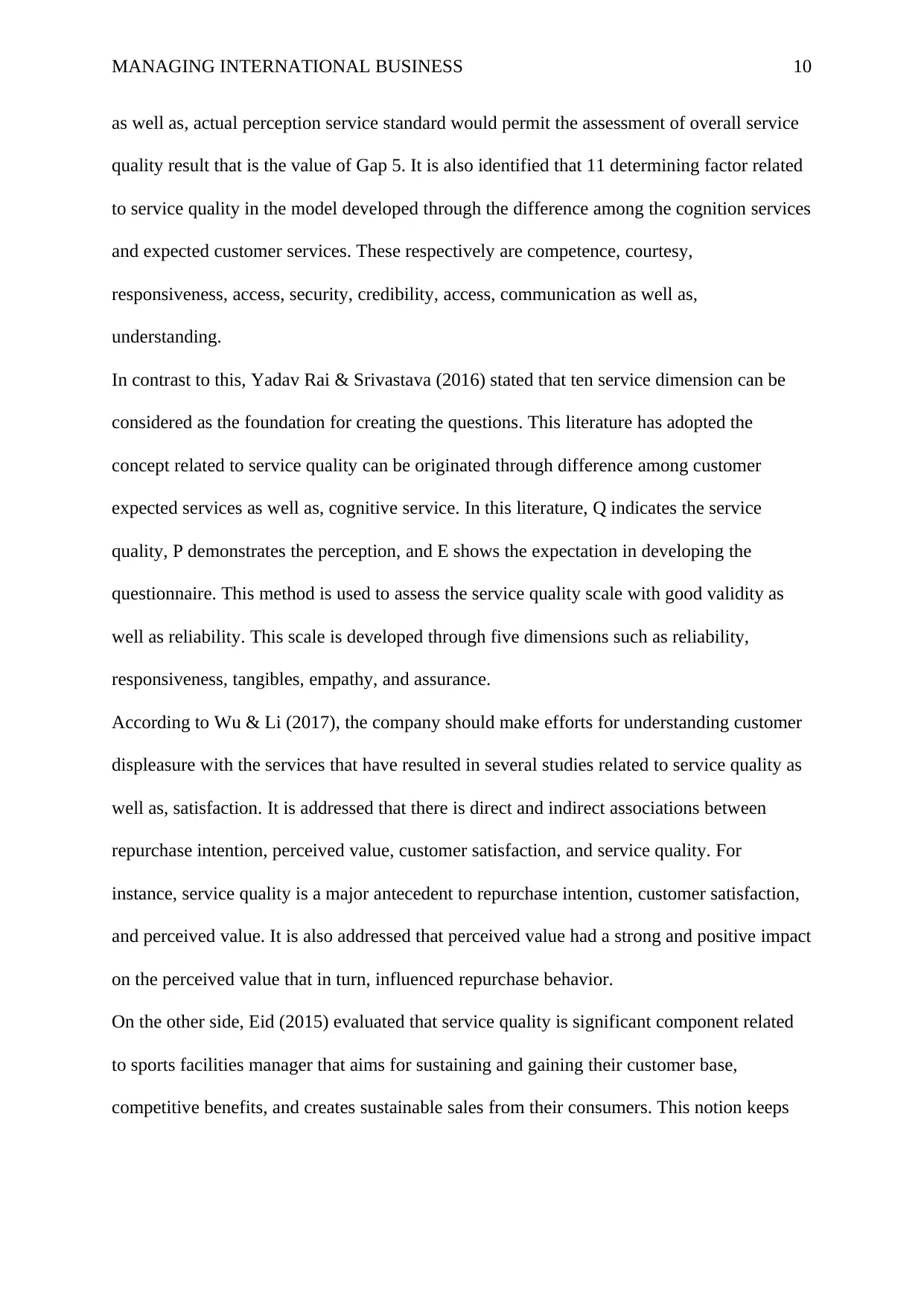
MANAGING INTERNATIONAL BUSINESS 10
as well as, actual perception service standard would permit the assessment of overall service
quality result that is the value of Gap 5. It is also identified that 11 determining factor related
to service quality in the model developed through the difference among the cognition services
and expected customer services. These respectively are competence, courtesy,
responsiveness, access, security, credibility, access, communication as well as,
understanding.
In contrast to this, Yadav Rai & Srivastava (2016) stated that ten service dimension can be
considered as the foundation for creating the questions. This literature has adopted the
concept related to service quality can be originated through difference among customer
expected services as well as, cognitive service. In this literature, Q indicates the service
quality, P demonstrates the perception, and E shows the expectation in developing the
questionnaire. This method is used to assess the service quality scale with good validity as
well as reliability. This scale is developed through five dimensions such as reliability,
responsiveness, tangibles, empathy, and assurance.
According to Wu & Li (2017), the company should make efforts for understanding customer
displeasure with the services that have resulted in several studies related to service quality as
well as, satisfaction. It is addressed that there is direct and indirect associations between
repurchase intention, perceived value, customer satisfaction, and service quality. For
instance, service quality is a major antecedent to repurchase intention, customer satisfaction,
and perceived value. It is also addressed that perceived value had a strong and positive impact
on the perceived value that in turn, influenced repurchase behavior.
On the other side, Eid (2015) evaluated that service quality is significant component related
to sports facilities manager that aims for sustaining and gaining their customer base,
competitive benefits, and creates sustainable sales from their consumers. This notion keeps
as well as, actual perception service standard would permit the assessment of overall service
quality result that is the value of Gap 5. It is also identified that 11 determining factor related
to service quality in the model developed through the difference among the cognition services
and expected customer services. These respectively are competence, courtesy,
responsiveness, access, security, credibility, access, communication as well as,
understanding.
In contrast to this, Yadav Rai & Srivastava (2016) stated that ten service dimension can be
considered as the foundation for creating the questions. This literature has adopted the
concept related to service quality can be originated through difference among customer
expected services as well as, cognitive service. In this literature, Q indicates the service
quality, P demonstrates the perception, and E shows the expectation in developing the
questionnaire. This method is used to assess the service quality scale with good validity as
well as reliability. This scale is developed through five dimensions such as reliability,
responsiveness, tangibles, empathy, and assurance.
According to Wu & Li (2017), the company should make efforts for understanding customer
displeasure with the services that have resulted in several studies related to service quality as
well as, satisfaction. It is addressed that there is direct and indirect associations between
repurchase intention, perceived value, customer satisfaction, and service quality. For
instance, service quality is a major antecedent to repurchase intention, customer satisfaction,
and perceived value. It is also addressed that perceived value had a strong and positive impact
on the perceived value that in turn, influenced repurchase behavior.
On the other side, Eid (2015) evaluated that service quality is significant component related
to sports facilities manager that aims for sustaining and gaining their customer base,
competitive benefits, and creates sustainable sales from their consumers. This notion keeps
Secure Best Marks with AI Grader
Need help grading? Try our AI Grader for instant feedback on your assignments.
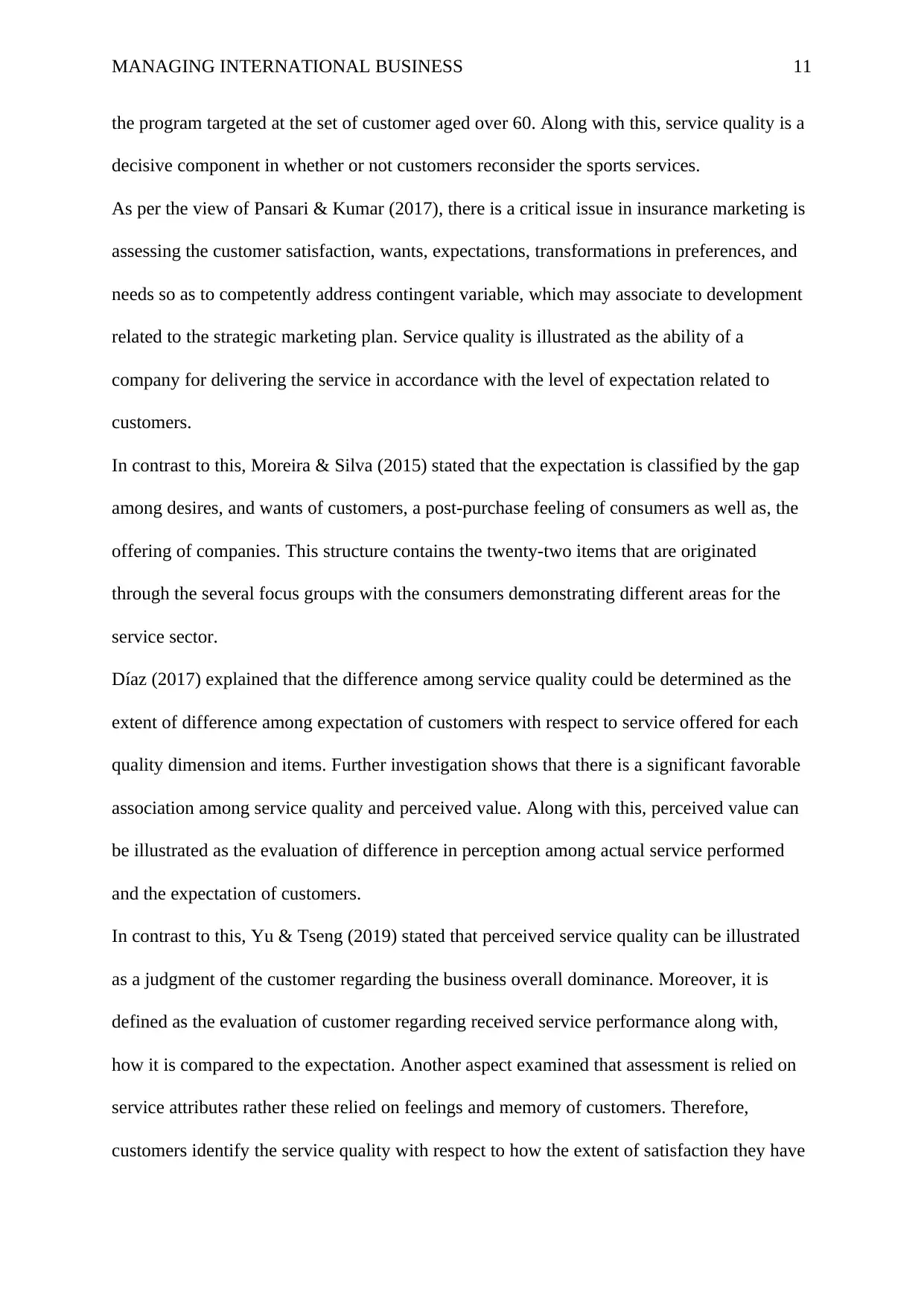
MANAGING INTERNATIONAL BUSINESS 11
the program targeted at the set of customer aged over 60. Along with this, service quality is a
decisive component in whether or not customers reconsider the sports services.
As per the view of Pansari & Kumar (2017), there is a critical issue in insurance marketing is
assessing the customer satisfaction, wants, expectations, transformations in preferences, and
needs so as to competently address contingent variable, which may associate to development
related to the strategic marketing plan. Service quality is illustrated as the ability of a
company for delivering the service in accordance with the level of expectation related to
customers.
In contrast to this, Moreira & Silva (2015) stated that the expectation is classified by the gap
among desires, and wants of customers, a post-purchase feeling of consumers as well as, the
offering of companies. This structure contains the twenty-two items that are originated
through the several focus groups with the consumers demonstrating different areas for the
service sector.
Díaz (2017) explained that the difference among service quality could be determined as the
extent of difference among expectation of customers with respect to service offered for each
quality dimension and items. Further investigation shows that there is a significant favorable
association among service quality and perceived value. Along with this, perceived value can
be illustrated as the evaluation of difference in perception among actual service performed
and the expectation of customers.
In contrast to this, Yu & Tseng (2019) stated that perceived service quality can be illustrated
as a judgment of the customer regarding the business overall dominance. Moreover, it is
defined as the evaluation of customer regarding received service performance along with,
how it is compared to the expectation. Another aspect examined that assessment is relied on
service attributes rather these relied on feelings and memory of customers. Therefore,
customers identify the service quality with respect to how the extent of satisfaction they have
the program targeted at the set of customer aged over 60. Along with this, service quality is a
decisive component in whether or not customers reconsider the sports services.
As per the view of Pansari & Kumar (2017), there is a critical issue in insurance marketing is
assessing the customer satisfaction, wants, expectations, transformations in preferences, and
needs so as to competently address contingent variable, which may associate to development
related to the strategic marketing plan. Service quality is illustrated as the ability of a
company for delivering the service in accordance with the level of expectation related to
customers.
In contrast to this, Moreira & Silva (2015) stated that the expectation is classified by the gap
among desires, and wants of customers, a post-purchase feeling of consumers as well as, the
offering of companies. This structure contains the twenty-two items that are originated
through the several focus groups with the consumers demonstrating different areas for the
service sector.
Díaz (2017) explained that the difference among service quality could be determined as the
extent of difference among expectation of customers with respect to service offered for each
quality dimension and items. Further investigation shows that there is a significant favorable
association among service quality and perceived value. Along with this, perceived value can
be illustrated as the evaluation of difference in perception among actual service performed
and the expectation of customers.
In contrast to this, Yu & Tseng (2019) stated that perceived service quality can be illustrated
as a judgment of the customer regarding the business overall dominance. Moreover, it is
defined as the evaluation of customer regarding received service performance along with,
how it is compared to the expectation. Another aspect examined that assessment is relied on
service attributes rather these relied on feelings and memory of customers. Therefore,
customers identify the service quality with respect to how the extent of satisfaction they have
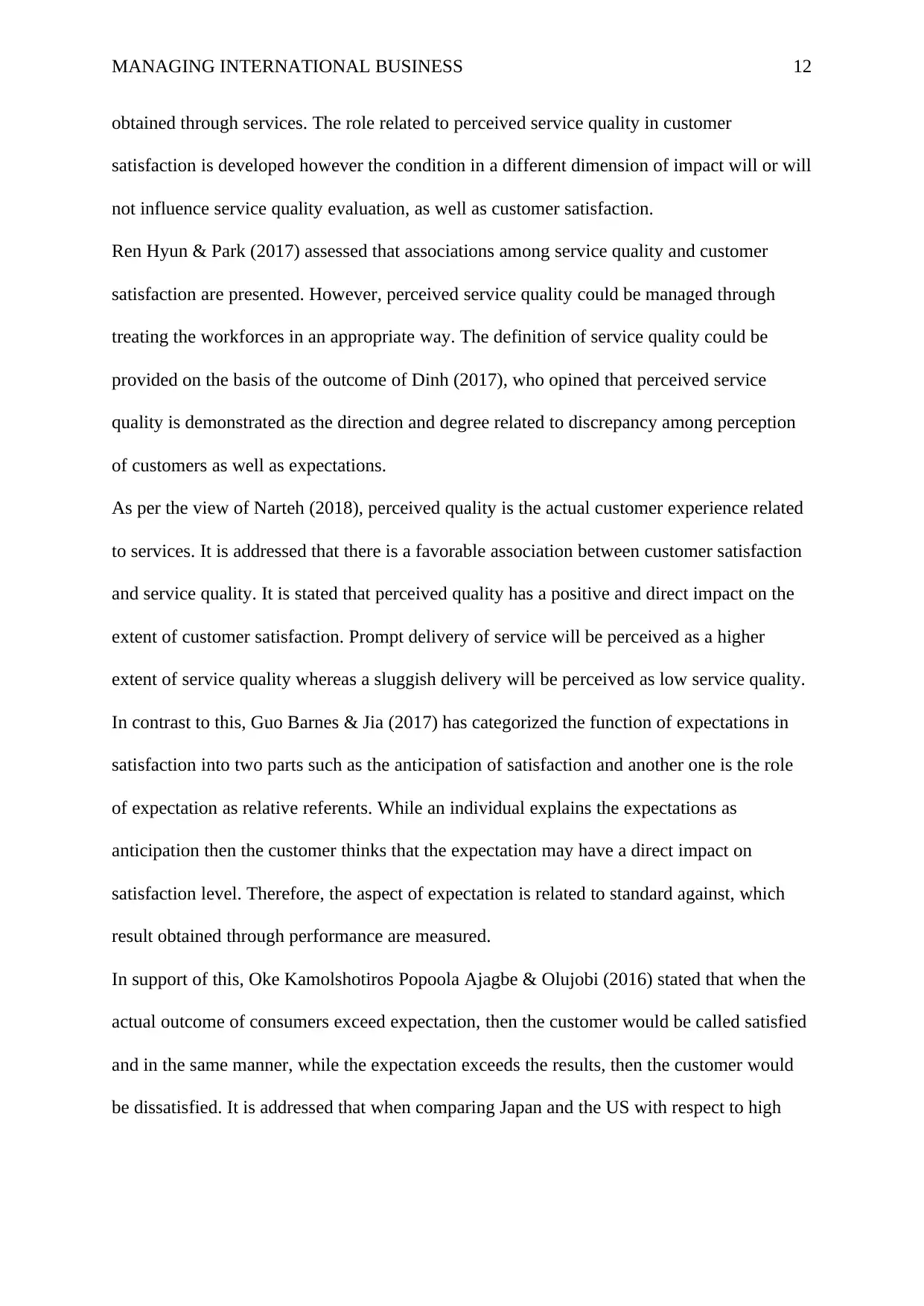
MANAGING INTERNATIONAL BUSINESS 12
obtained through services. The role related to perceived service quality in customer
satisfaction is developed however the condition in a different dimension of impact will or will
not influence service quality evaluation, as well as customer satisfaction.
Ren Hyun & Park (2017) assessed that associations among service quality and customer
satisfaction are presented. However, perceived service quality could be managed through
treating the workforces in an appropriate way. The definition of service quality could be
provided on the basis of the outcome of Dinh (2017), who opined that perceived service
quality is demonstrated as the direction and degree related to discrepancy among perception
of customers as well as expectations.
As per the view of Narteh (2018), perceived quality is the actual customer experience related
to services. It is addressed that there is a favorable association between customer satisfaction
and service quality. It is stated that perceived quality has a positive and direct impact on the
extent of customer satisfaction. Prompt delivery of service will be perceived as a higher
extent of service quality whereas a sluggish delivery will be perceived as low service quality.
In contrast to this, Guo Barnes & Jia (2017) has categorized the function of expectations in
satisfaction into two parts such as the anticipation of satisfaction and another one is the role
of expectation as relative referents. While an individual explains the expectations as
anticipation then the customer thinks that the expectation may have a direct impact on
satisfaction level. Therefore, the aspect of expectation is related to standard against, which
result obtained through performance are measured.
In support of this, Oke Kamolshotiros Popoola Ajagbe & Olujobi (2016) stated that when the
actual outcome of consumers exceed expectation, then the customer would be called satisfied
and in the same manner, while the expectation exceeds the results, then the customer would
be dissatisfied. It is addressed that when comparing Japan and the US with respect to high
obtained through services. The role related to perceived service quality in customer
satisfaction is developed however the condition in a different dimension of impact will or will
not influence service quality evaluation, as well as customer satisfaction.
Ren Hyun & Park (2017) assessed that associations among service quality and customer
satisfaction are presented. However, perceived service quality could be managed through
treating the workforces in an appropriate way. The definition of service quality could be
provided on the basis of the outcome of Dinh (2017), who opined that perceived service
quality is demonstrated as the direction and degree related to discrepancy among perception
of customers as well as expectations.
As per the view of Narteh (2018), perceived quality is the actual customer experience related
to services. It is addressed that there is a favorable association between customer satisfaction
and service quality. It is stated that perceived quality has a positive and direct impact on the
extent of customer satisfaction. Prompt delivery of service will be perceived as a higher
extent of service quality whereas a sluggish delivery will be perceived as low service quality.
In contrast to this, Guo Barnes & Jia (2017) has categorized the function of expectations in
satisfaction into two parts such as the anticipation of satisfaction and another one is the role
of expectation as relative referents. While an individual explains the expectations as
anticipation then the customer thinks that the expectation may have a direct impact on
satisfaction level. Therefore, the aspect of expectation is related to standard against, which
result obtained through performance are measured.
In support of this, Oke Kamolshotiros Popoola Ajagbe & Olujobi (2016) stated that when the
actual outcome of consumers exceed expectation, then the customer would be called satisfied
and in the same manner, while the expectation exceeds the results, then the customer would
be dissatisfied. It is addressed that when comparing Japan and the US with respect to high
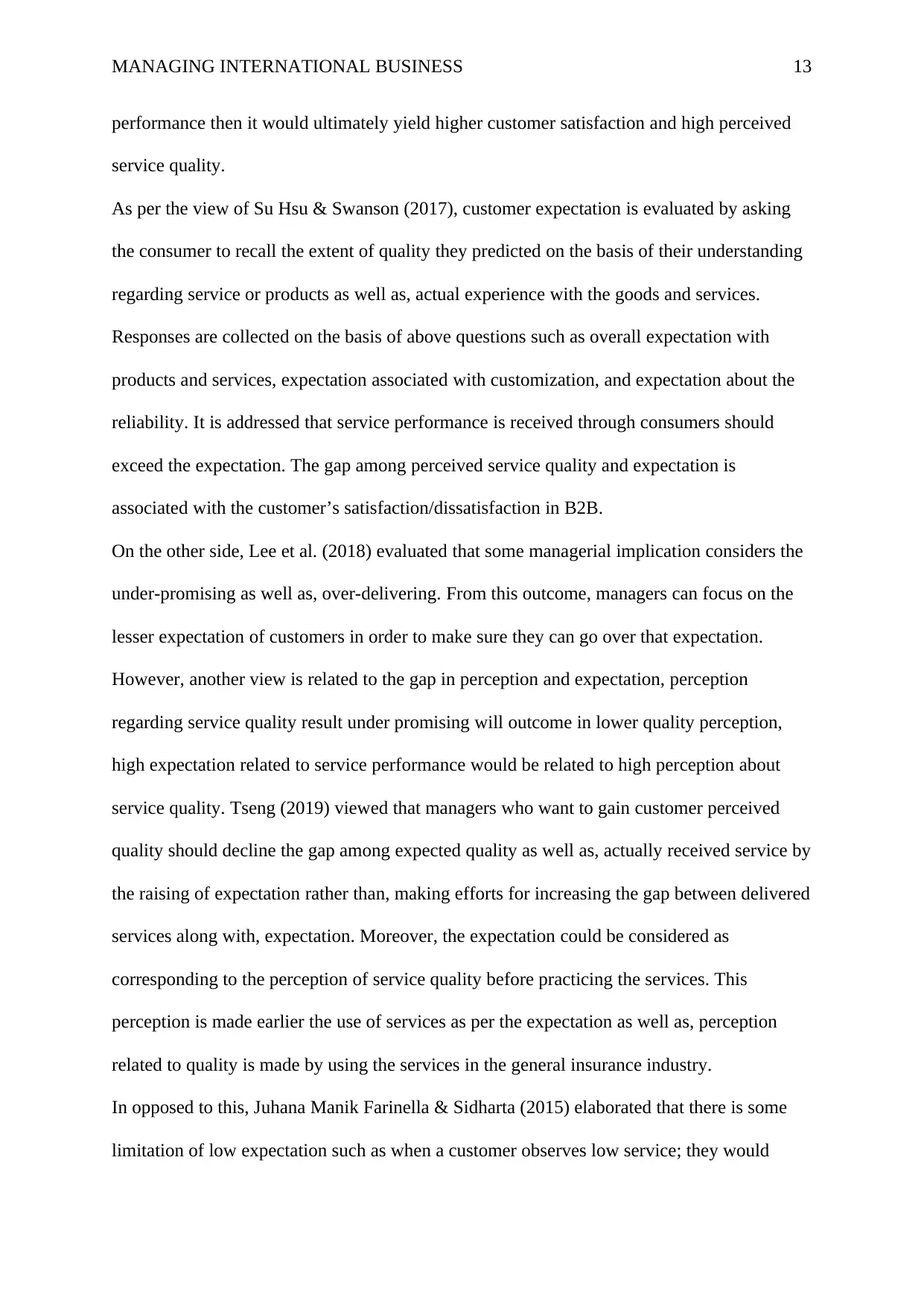
MANAGING INTERNATIONAL BUSINESS 13
performance then it would ultimately yield higher customer satisfaction and high perceived
service quality.
As per the view of Su Hsu & Swanson (2017), customer expectation is evaluated by asking
the consumer to recall the extent of quality they predicted on the basis of their understanding
regarding service or products as well as, actual experience with the goods and services.
Responses are collected on the basis of above questions such as overall expectation with
products and services, expectation associated with customization, and expectation about the
reliability. It is addressed that service performance is received through consumers should
exceed the expectation. The gap among perceived service quality and expectation is
associated with the customer’s satisfaction/dissatisfaction in B2B.
On the other side, Lee et al. (2018) evaluated that some managerial implication considers the
under-promising as well as, over-delivering. From this outcome, managers can focus on the
lesser expectation of customers in order to make sure they can go over that expectation.
However, another view is related to the gap in perception and expectation, perception
regarding service quality result under promising will outcome in lower quality perception,
high expectation related to service performance would be related to high perception about
service quality. Tseng (2019) viewed that managers who want to gain customer perceived
quality should decline the gap among expected quality as well as, actually received service by
the raising of expectation rather than, making efforts for increasing the gap between delivered
services along with, expectation. Moreover, the expectation could be considered as
corresponding to the perception of service quality before practicing the services. This
perception is made earlier the use of services as per the expectation as well as, perception
related to quality is made by using the services in the general insurance industry.
In opposed to this, Juhana Manik Farinella & Sidharta (2015) elaborated that there is some
limitation of low expectation such as when a customer observes low service; they would
performance then it would ultimately yield higher customer satisfaction and high perceived
service quality.
As per the view of Su Hsu & Swanson (2017), customer expectation is evaluated by asking
the consumer to recall the extent of quality they predicted on the basis of their understanding
regarding service or products as well as, actual experience with the goods and services.
Responses are collected on the basis of above questions such as overall expectation with
products and services, expectation associated with customization, and expectation about the
reliability. It is addressed that service performance is received through consumers should
exceed the expectation. The gap among perceived service quality and expectation is
associated with the customer’s satisfaction/dissatisfaction in B2B.
On the other side, Lee et al. (2018) evaluated that some managerial implication considers the
under-promising as well as, over-delivering. From this outcome, managers can focus on the
lesser expectation of customers in order to make sure they can go over that expectation.
However, another view is related to the gap in perception and expectation, perception
regarding service quality result under promising will outcome in lower quality perception,
high expectation related to service performance would be related to high perception about
service quality. Tseng (2019) viewed that managers who want to gain customer perceived
quality should decline the gap among expected quality as well as, actually received service by
the raising of expectation rather than, making efforts for increasing the gap between delivered
services along with, expectation. Moreover, the expectation could be considered as
corresponding to the perception of service quality before practicing the services. This
perception is made earlier the use of services as per the expectation as well as, perception
related to quality is made by using the services in the general insurance industry.
In opposed to this, Juhana Manik Farinella & Sidharta (2015) elaborated that there is some
limitation of low expectation such as when a customer observes low service; they would
Paraphrase This Document
Need a fresh take? Get an instant paraphrase of this document with our AI Paraphraser
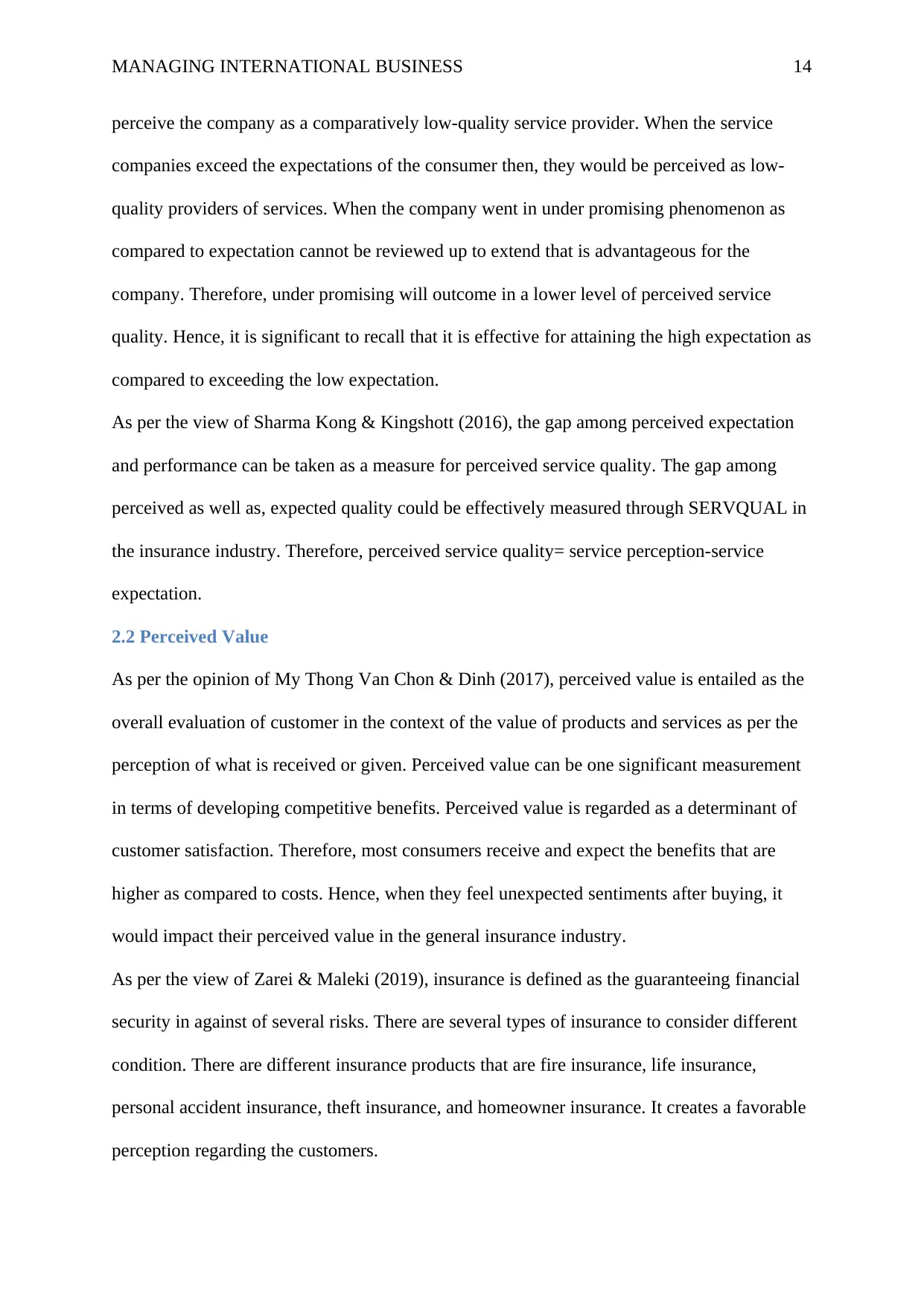
MANAGING INTERNATIONAL BUSINESS 14
perceive the company as a comparatively low-quality service provider. When the service
companies exceed the expectations of the consumer then, they would be perceived as low-
quality providers of services. When the company went in under promising phenomenon as
compared to expectation cannot be reviewed up to extend that is advantageous for the
company. Therefore, under promising will outcome in a lower level of perceived service
quality. Hence, it is significant to recall that it is effective for attaining the high expectation as
compared to exceeding the low expectation.
As per the view of Sharma Kong & Kingshott (2016), the gap among perceived expectation
and performance can be taken as a measure for perceived service quality. The gap among
perceived as well as, expected quality could be effectively measured through SERVQUAL in
the insurance industry. Therefore, perceived service quality= service perception-service
expectation.
2.2 Perceived Value
As per the opinion of My Thong Van Chon & Dinh (2017), perceived value is entailed as the
overall evaluation of customer in the context of the value of products and services as per the
perception of what is received or given. Perceived value can be one significant measurement
in terms of developing competitive benefits. Perceived value is regarded as a determinant of
customer satisfaction. Therefore, most consumers receive and expect the benefits that are
higher as compared to costs. Hence, when they feel unexpected sentiments after buying, it
would impact their perceived value in the general insurance industry.
As per the view of Zarei & Maleki (2019), insurance is defined as the guaranteeing financial
security in against of several risks. There are several types of insurance to consider different
condition. There are different insurance products that are fire insurance, life insurance,
personal accident insurance, theft insurance, and homeowner insurance. It creates a favorable
perception regarding the customers.
perceive the company as a comparatively low-quality service provider. When the service
companies exceed the expectations of the consumer then, they would be perceived as low-
quality providers of services. When the company went in under promising phenomenon as
compared to expectation cannot be reviewed up to extend that is advantageous for the
company. Therefore, under promising will outcome in a lower level of perceived service
quality. Hence, it is significant to recall that it is effective for attaining the high expectation as
compared to exceeding the low expectation.
As per the view of Sharma Kong & Kingshott (2016), the gap among perceived expectation
and performance can be taken as a measure for perceived service quality. The gap among
perceived as well as, expected quality could be effectively measured through SERVQUAL in
the insurance industry. Therefore, perceived service quality= service perception-service
expectation.
2.2 Perceived Value
As per the opinion of My Thong Van Chon & Dinh (2017), perceived value is entailed as the
overall evaluation of customer in the context of the value of products and services as per the
perception of what is received or given. Perceived value can be one significant measurement
in terms of developing competitive benefits. Perceived value is regarded as a determinant of
customer satisfaction. Therefore, most consumers receive and expect the benefits that are
higher as compared to costs. Hence, when they feel unexpected sentiments after buying, it
would impact their perceived value in the general insurance industry.
As per the view of Zarei & Maleki (2019), insurance is defined as the guaranteeing financial
security in against of several risks. There are several types of insurance to consider different
condition. There are different insurance products that are fire insurance, life insurance,
personal accident insurance, theft insurance, and homeowner insurance. It creates a favorable
perception regarding the customers.

MANAGING INTERNATIONAL BUSINESS 15
On the other side, Rahman Abdel Fattah Zaman & Hassan (2018) identified that life
insurance is intended to keep against two distinct uncertainties such as premature death as
well as, superannuation. Life insurance is perceived by customers as a positive value because
it makes sure the continuous stream related to income to beneficiaries. In addition to this,
insurance companies are concerned regarding superannuating as an individual can endure
their income earning competency. It can serve as a technique for making sure the constant
stream for income.
In the view of Kumar & Reinartz (2016), life insurance is intended to indemnify the insured
related to lose of or damage to furniture, fixtures, buildings and other personal property as a
consequence of lighting, hail, and fire. This may create a favorable impact on the perceived
value of customer’s in the general insurance industry of Singapore. Moreover, Singapore
matches the trend of epidemic proportion in certain western nations in which, there has been
an enormous gain in incidence related to burning. The company should offer some protection
against the hazards of fire.
On the other side, Alharbi & Qassim (2017) evaluated that health insurance is the protection
system in against loss by disease or other uncertainties that are health associated. The loss can
be associated with loss in wages caused by sickness, hospital bills, and expenses for doctor’s
bills. Moreover, health insurance can be purchased as a single policy or as a kind of riders
attached to certain basic life insurance strategy.
Liao Lin Luo & Chea (2017) stated that each Singaporean includes a Medisave account
related to the central provident fund. Along with this, Singaporean involved the Medishield
that are a low-cost medical insurance plan that enables the policyholders and dependants
financial security against the high medical expenses created from the treatment of severe and
prolonged sicknesses. However, some are a bit more careful by obtaining a modest private
medical insurance policy. Each individual needs medical treatment for something later or
On the other side, Rahman Abdel Fattah Zaman & Hassan (2018) identified that life
insurance is intended to keep against two distinct uncertainties such as premature death as
well as, superannuation. Life insurance is perceived by customers as a positive value because
it makes sure the continuous stream related to income to beneficiaries. In addition to this,
insurance companies are concerned regarding superannuating as an individual can endure
their income earning competency. It can serve as a technique for making sure the constant
stream for income.
In the view of Kumar & Reinartz (2016), life insurance is intended to indemnify the insured
related to lose of or damage to furniture, fixtures, buildings and other personal property as a
consequence of lighting, hail, and fire. This may create a favorable impact on the perceived
value of customer’s in the general insurance industry of Singapore. Moreover, Singapore
matches the trend of epidemic proportion in certain western nations in which, there has been
an enormous gain in incidence related to burning. The company should offer some protection
against the hazards of fire.
On the other side, Alharbi & Qassim (2017) evaluated that health insurance is the protection
system in against loss by disease or other uncertainties that are health associated. The loss can
be associated with loss in wages caused by sickness, hospital bills, and expenses for doctor’s
bills. Moreover, health insurance can be purchased as a single policy or as a kind of riders
attached to certain basic life insurance strategy.
Liao Lin Luo & Chea (2017) stated that each Singaporean includes a Medisave account
related to the central provident fund. Along with this, Singaporean involved the Medishield
that are a low-cost medical insurance plan that enables the policyholders and dependants
financial security against the high medical expenses created from the treatment of severe and
prolonged sicknesses. However, some are a bit more careful by obtaining a modest private
medical insurance policy. Each individual needs medical treatment for something later or
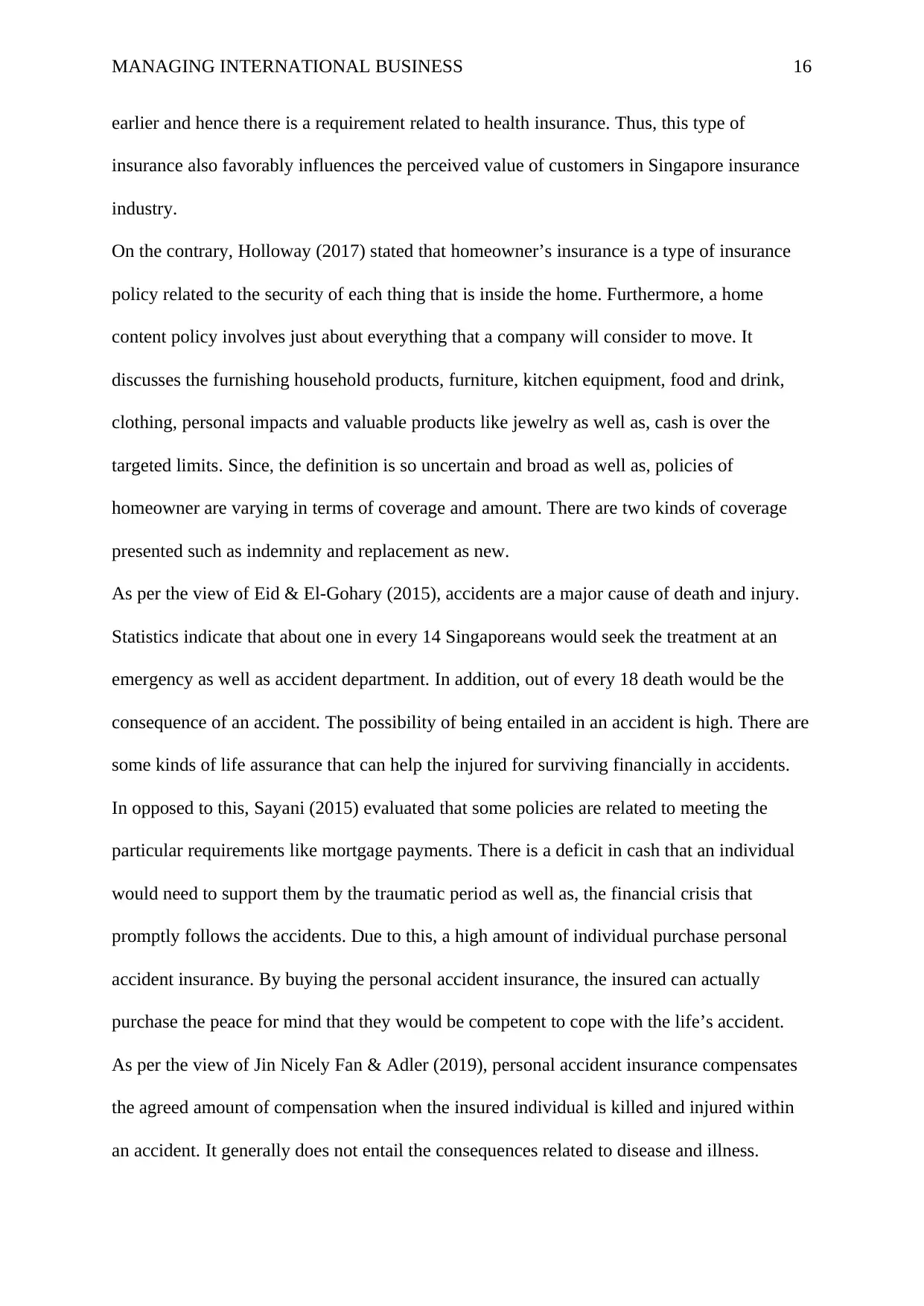
MANAGING INTERNATIONAL BUSINESS 16
earlier and hence there is a requirement related to health insurance. Thus, this type of
insurance also favorably influences the perceived value of customers in Singapore insurance
industry.
On the contrary, Holloway (2017) stated that homeowner’s insurance is a type of insurance
policy related to the security of each thing that is inside the home. Furthermore, a home
content policy involves just about everything that a company will consider to move. It
discusses the furnishing household products, furniture, kitchen equipment, food and drink,
clothing, personal impacts and valuable products like jewelry as well as, cash is over the
targeted limits. Since, the definition is so uncertain and broad as well as, policies of
homeowner are varying in terms of coverage and amount. There are two kinds of coverage
presented such as indemnity and replacement as new.
As per the view of Eid & El-Gohary (2015), accidents are a major cause of death and injury.
Statistics indicate that about one in every 14 Singaporeans would seek the treatment at an
emergency as well as accident department. In addition, out of every 18 death would be the
consequence of an accident. The possibility of being entailed in an accident is high. There are
some kinds of life assurance that can help the injured for surviving financially in accidents.
In opposed to this, Sayani (2015) evaluated that some policies are related to meeting the
particular requirements like mortgage payments. There is a deficit in cash that an individual
would need to support them by the traumatic period as well as, the financial crisis that
promptly follows the accidents. Due to this, a high amount of individual purchase personal
accident insurance. By buying the personal accident insurance, the insured can actually
purchase the peace for mind that they would be competent to cope with the life’s accident.
As per the view of Jin Nicely Fan & Adler (2019), personal accident insurance compensates
the agreed amount of compensation when the insured individual is killed and injured within
an accident. It generally does not entail the consequences related to disease and illness.
earlier and hence there is a requirement related to health insurance. Thus, this type of
insurance also favorably influences the perceived value of customers in Singapore insurance
industry.
On the contrary, Holloway (2017) stated that homeowner’s insurance is a type of insurance
policy related to the security of each thing that is inside the home. Furthermore, a home
content policy involves just about everything that a company will consider to move. It
discusses the furnishing household products, furniture, kitchen equipment, food and drink,
clothing, personal impacts and valuable products like jewelry as well as, cash is over the
targeted limits. Since, the definition is so uncertain and broad as well as, policies of
homeowner are varying in terms of coverage and amount. There are two kinds of coverage
presented such as indemnity and replacement as new.
As per the view of Eid & El-Gohary (2015), accidents are a major cause of death and injury.
Statistics indicate that about one in every 14 Singaporeans would seek the treatment at an
emergency as well as accident department. In addition, out of every 18 death would be the
consequence of an accident. The possibility of being entailed in an accident is high. There are
some kinds of life assurance that can help the injured for surviving financially in accidents.
In opposed to this, Sayani (2015) evaluated that some policies are related to meeting the
particular requirements like mortgage payments. There is a deficit in cash that an individual
would need to support them by the traumatic period as well as, the financial crisis that
promptly follows the accidents. Due to this, a high amount of individual purchase personal
accident insurance. By buying the personal accident insurance, the insured can actually
purchase the peace for mind that they would be competent to cope with the life’s accident.
As per the view of Jin Nicely Fan & Adler (2019), personal accident insurance compensates
the agreed amount of compensation when the insured individual is killed and injured within
an accident. It generally does not entail the consequences related to disease and illness.
Secure Best Marks with AI Grader
Need help grading? Try our AI Grader for instant feedback on your assignments.
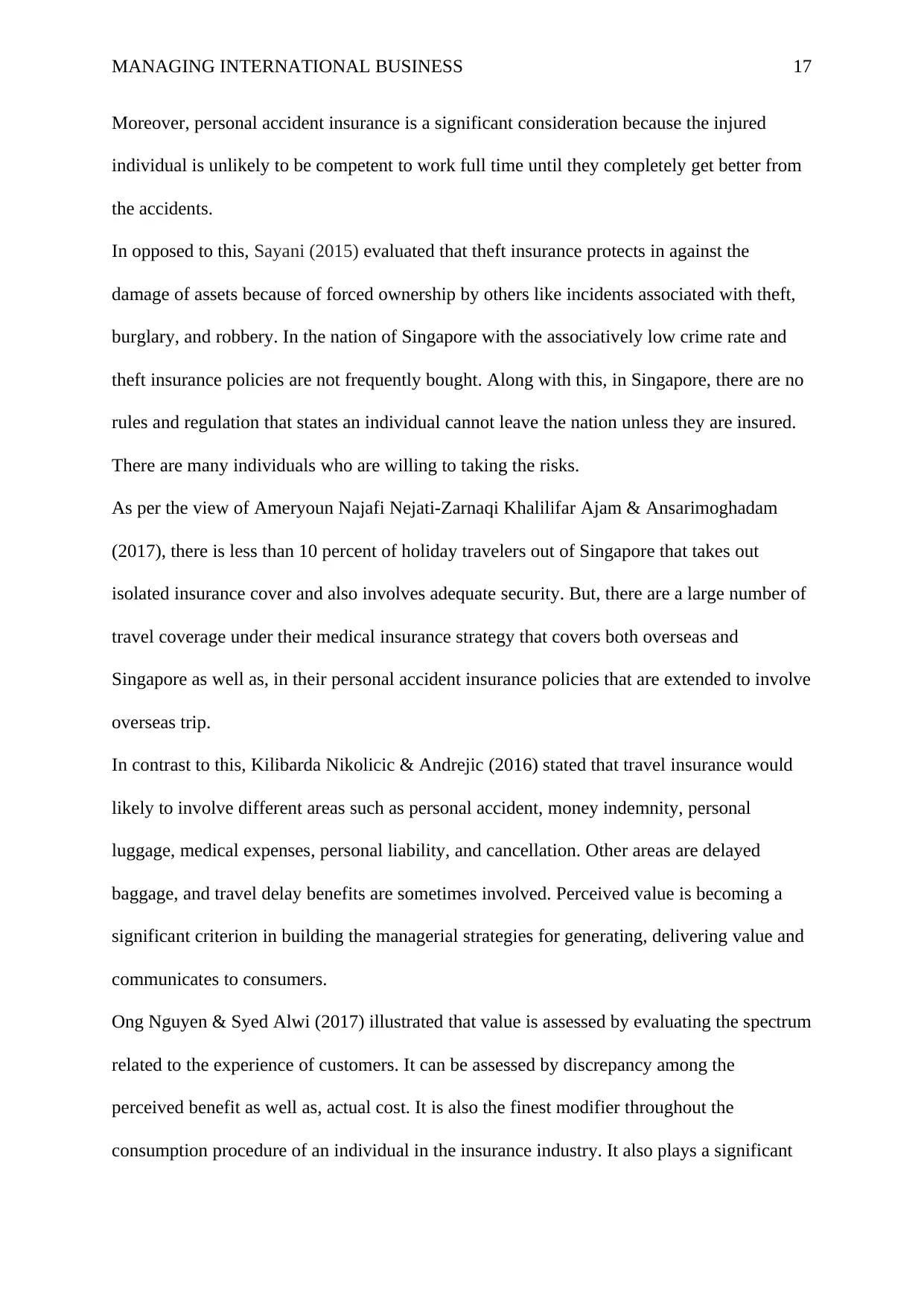
MANAGING INTERNATIONAL BUSINESS 17
Moreover, personal accident insurance is a significant consideration because the injured
individual is unlikely to be competent to work full time until they completely get better from
the accidents.
In opposed to this, Sayani (2015) evaluated that theft insurance protects in against the
damage of assets because of forced ownership by others like incidents associated with theft,
burglary, and robbery. In the nation of Singapore with the associatively low crime rate and
theft insurance policies are not frequently bought. Along with this, in Singapore, there are no
rules and regulation that states an individual cannot leave the nation unless they are insured.
There are many individuals who are willing to taking the risks.
As per the view of Ameryoun Najafi Nejati-Zarnaqi Khalilifar Ajam & Ansarimoghadam
(2017), there is less than 10 percent of holiday travelers out of Singapore that takes out
isolated insurance cover and also involves adequate security. But, there are a large number of
travel coverage under their medical insurance strategy that covers both overseas and
Singapore as well as, in their personal accident insurance policies that are extended to involve
overseas trip.
In contrast to this, Kilibarda Nikolicic & Andrejic (2016) stated that travel insurance would
likely to involve different areas such as personal accident, money indemnity, personal
luggage, medical expenses, personal liability, and cancellation. Other areas are delayed
baggage, and travel delay benefits are sometimes involved. Perceived value is becoming a
significant criterion in building the managerial strategies for generating, delivering value and
communicates to consumers.
Ong Nguyen & Syed Alwi (2017) illustrated that value is assessed by evaluating the spectrum
related to the experience of customers. It can be assessed by discrepancy among the
perceived benefit as well as, actual cost. It is also the finest modifier throughout the
consumption procedure of an individual in the insurance industry. It also plays a significant
Moreover, personal accident insurance is a significant consideration because the injured
individual is unlikely to be competent to work full time until they completely get better from
the accidents.
In opposed to this, Sayani (2015) evaluated that theft insurance protects in against the
damage of assets because of forced ownership by others like incidents associated with theft,
burglary, and robbery. In the nation of Singapore with the associatively low crime rate and
theft insurance policies are not frequently bought. Along with this, in Singapore, there are no
rules and regulation that states an individual cannot leave the nation unless they are insured.
There are many individuals who are willing to taking the risks.
As per the view of Ameryoun Najafi Nejati-Zarnaqi Khalilifar Ajam & Ansarimoghadam
(2017), there is less than 10 percent of holiday travelers out of Singapore that takes out
isolated insurance cover and also involves adequate security. But, there are a large number of
travel coverage under their medical insurance strategy that covers both overseas and
Singapore as well as, in their personal accident insurance policies that are extended to involve
overseas trip.
In contrast to this, Kilibarda Nikolicic & Andrejic (2016) stated that travel insurance would
likely to involve different areas such as personal accident, money indemnity, personal
luggage, medical expenses, personal liability, and cancellation. Other areas are delayed
baggage, and travel delay benefits are sometimes involved. Perceived value is becoming a
significant criterion in building the managerial strategies for generating, delivering value and
communicates to consumers.
Ong Nguyen & Syed Alwi (2017) illustrated that value is assessed by evaluating the spectrum
related to the experience of customers. It can be assessed by discrepancy among the
perceived benefit as well as, actual cost. It is also the finest modifier throughout the
consumption procedure of an individual in the insurance industry. It also plays a significant
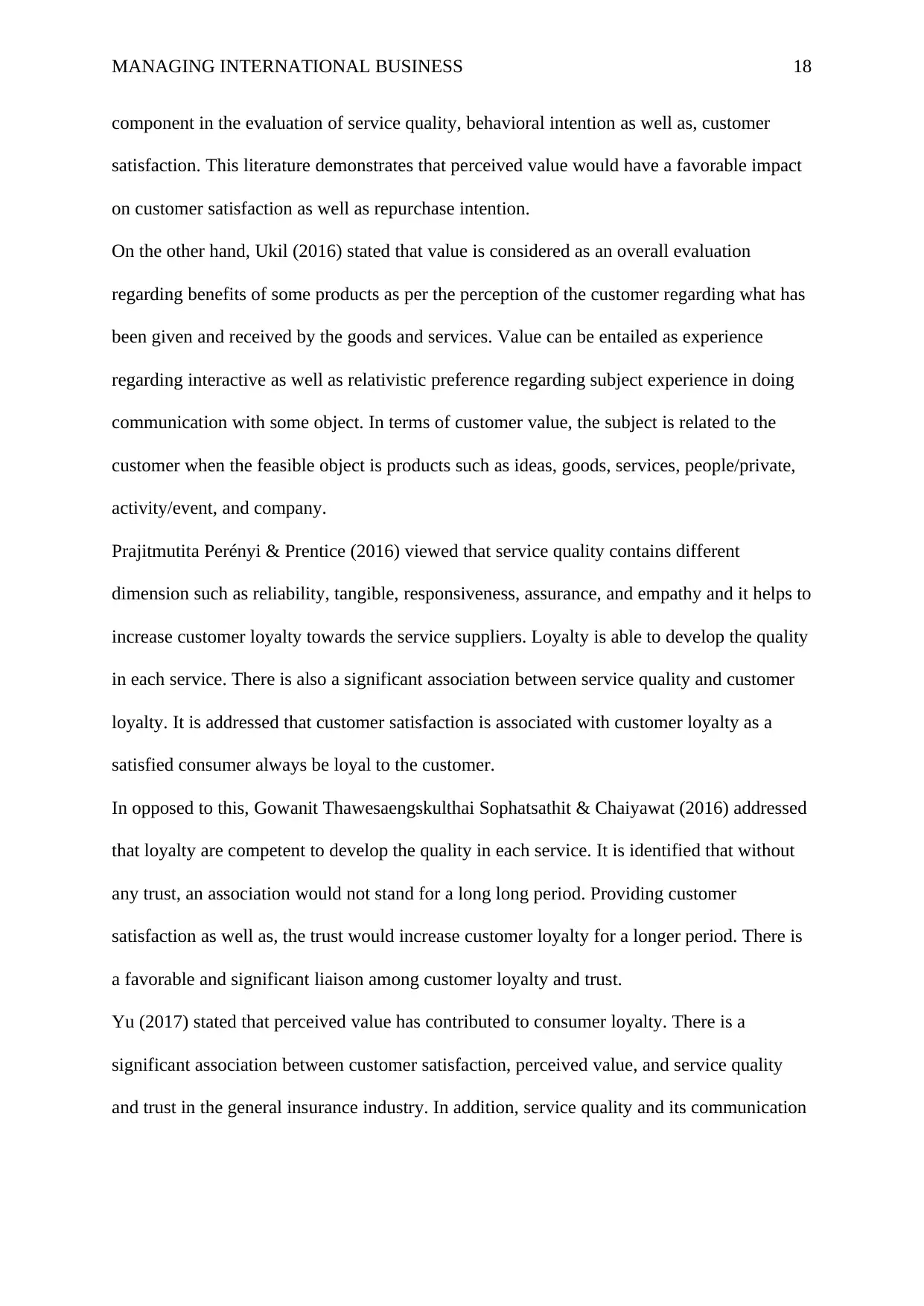
MANAGING INTERNATIONAL BUSINESS 18
component in the evaluation of service quality, behavioral intention as well as, customer
satisfaction. This literature demonstrates that perceived value would have a favorable impact
on customer satisfaction as well as repurchase intention.
On the other hand, Ukil (2016) stated that value is considered as an overall evaluation
regarding benefits of some products as per the perception of the customer regarding what has
been given and received by the goods and services. Value can be entailed as experience
regarding interactive as well as relativistic preference regarding subject experience in doing
communication with some object. In terms of customer value, the subject is related to the
customer when the feasible object is products such as ideas, goods, services, people/private,
activity/event, and company.
Prajitmutita Perényi & Prentice (2016) viewed that service quality contains different
dimension such as reliability, tangible, responsiveness, assurance, and empathy and it helps to
increase customer loyalty towards the service suppliers. Loyalty is able to develop the quality
in each service. There is also a significant association between service quality and customer
loyalty. It is addressed that customer satisfaction is associated with customer loyalty as a
satisfied consumer always be loyal to the customer.
In opposed to this, Gowanit Thawesaengskulthai Sophatsathit & Chaiyawat (2016) addressed
that loyalty are competent to develop the quality in each service. It is identified that without
any trust, an association would not stand for a long long period. Providing customer
satisfaction as well as, the trust would increase customer loyalty for a longer period. There is
a favorable and significant liaison among customer loyalty and trust.
Yu (2017) stated that perceived value has contributed to consumer loyalty. There is a
significant association between customer satisfaction, perceived value, and service quality
and trust in the general insurance industry. In addition, service quality and its communication
component in the evaluation of service quality, behavioral intention as well as, customer
satisfaction. This literature demonstrates that perceived value would have a favorable impact
on customer satisfaction as well as repurchase intention.
On the other hand, Ukil (2016) stated that value is considered as an overall evaluation
regarding benefits of some products as per the perception of the customer regarding what has
been given and received by the goods and services. Value can be entailed as experience
regarding interactive as well as relativistic preference regarding subject experience in doing
communication with some object. In terms of customer value, the subject is related to the
customer when the feasible object is products such as ideas, goods, services, people/private,
activity/event, and company.
Prajitmutita Perényi & Prentice (2016) viewed that service quality contains different
dimension such as reliability, tangible, responsiveness, assurance, and empathy and it helps to
increase customer loyalty towards the service suppliers. Loyalty is able to develop the quality
in each service. There is also a significant association between service quality and customer
loyalty. It is addressed that customer satisfaction is associated with customer loyalty as a
satisfied consumer always be loyal to the customer.
In opposed to this, Gowanit Thawesaengskulthai Sophatsathit & Chaiyawat (2016) addressed
that loyalty are competent to develop the quality in each service. It is identified that without
any trust, an association would not stand for a long long period. Providing customer
satisfaction as well as, the trust would increase customer loyalty for a longer period. There is
a favorable and significant liaison among customer loyalty and trust.
Yu (2017) stated that perceived value has contributed to consumer loyalty. There is a
significant association between customer satisfaction, perceived value, and service quality
and trust in the general insurance industry. In addition, service quality and its communication
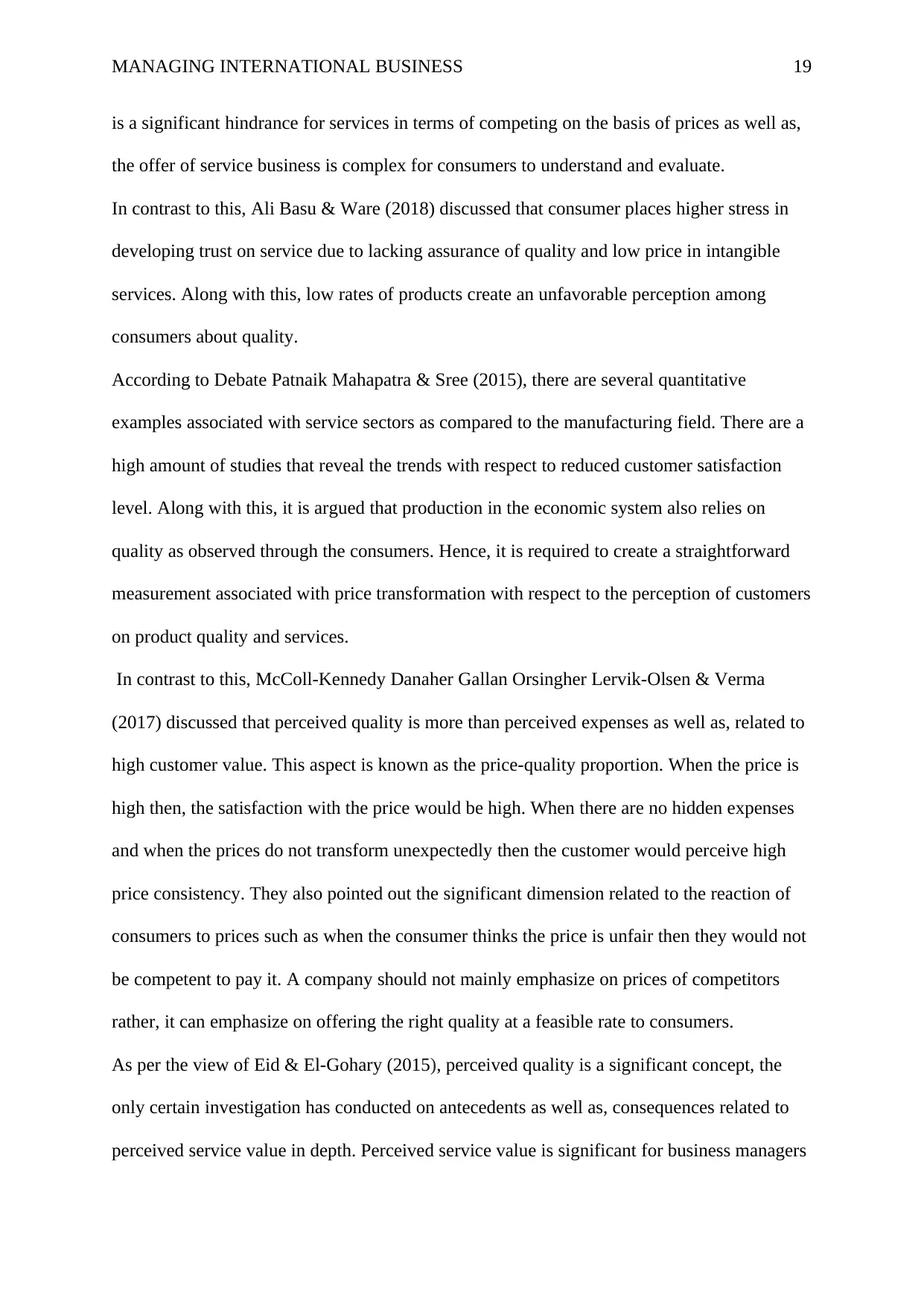
MANAGING INTERNATIONAL BUSINESS 19
is a significant hindrance for services in terms of competing on the basis of prices as well as,
the offer of service business is complex for consumers to understand and evaluate.
In contrast to this, Ali Basu & Ware (2018) discussed that consumer places higher stress in
developing trust on service due to lacking assurance of quality and low price in intangible
services. Along with this, low rates of products create an unfavorable perception among
consumers about quality.
According to Debate Patnaik Mahapatra & Sree (2015), there are several quantitative
examples associated with service sectors as compared to the manufacturing field. There are a
high amount of studies that reveal the trends with respect to reduced customer satisfaction
level. Along with this, it is argued that production in the economic system also relies on
quality as observed through the consumers. Hence, it is required to create a straightforward
measurement associated with price transformation with respect to the perception of customers
on product quality and services.
In contrast to this, McColl-Kennedy Danaher Gallan Orsingher Lervik-Olsen & Verma
(2017) discussed that perceived quality is more than perceived expenses as well as, related to
high customer value. This aspect is known as the price-quality proportion. When the price is
high then, the satisfaction with the price would be high. When there are no hidden expenses
and when the prices do not transform unexpectedly then the customer would perceive high
price consistency. They also pointed out the significant dimension related to the reaction of
consumers to prices such as when the consumer thinks the price is unfair then they would not
be competent to pay it. A company should not mainly emphasize on prices of competitors
rather, it can emphasize on offering the right quality at a feasible rate to consumers.
As per the view of Eid & El-Gohary (2015), perceived quality is a significant concept, the
only certain investigation has conducted on antecedents as well as, consequences related to
perceived service value in depth. Perceived service value is significant for business managers
is a significant hindrance for services in terms of competing on the basis of prices as well as,
the offer of service business is complex for consumers to understand and evaluate.
In contrast to this, Ali Basu & Ware (2018) discussed that consumer places higher stress in
developing trust on service due to lacking assurance of quality and low price in intangible
services. Along with this, low rates of products create an unfavorable perception among
consumers about quality.
According to Debate Patnaik Mahapatra & Sree (2015), there are several quantitative
examples associated with service sectors as compared to the manufacturing field. There are a
high amount of studies that reveal the trends with respect to reduced customer satisfaction
level. Along with this, it is argued that production in the economic system also relies on
quality as observed through the consumers. Hence, it is required to create a straightforward
measurement associated with price transformation with respect to the perception of customers
on product quality and services.
In contrast to this, McColl-Kennedy Danaher Gallan Orsingher Lervik-Olsen & Verma
(2017) discussed that perceived quality is more than perceived expenses as well as, related to
high customer value. This aspect is known as the price-quality proportion. When the price is
high then, the satisfaction with the price would be high. When there are no hidden expenses
and when the prices do not transform unexpectedly then the customer would perceive high
price consistency. They also pointed out the significant dimension related to the reaction of
consumers to prices such as when the consumer thinks the price is unfair then they would not
be competent to pay it. A company should not mainly emphasize on prices of competitors
rather, it can emphasize on offering the right quality at a feasible rate to consumers.
As per the view of Eid & El-Gohary (2015), perceived quality is a significant concept, the
only certain investigation has conducted on antecedents as well as, consequences related to
perceived service value in depth. Perceived service value is significant for business managers
Paraphrase This Document
Need a fresh take? Get an instant paraphrase of this document with our AI Paraphraser
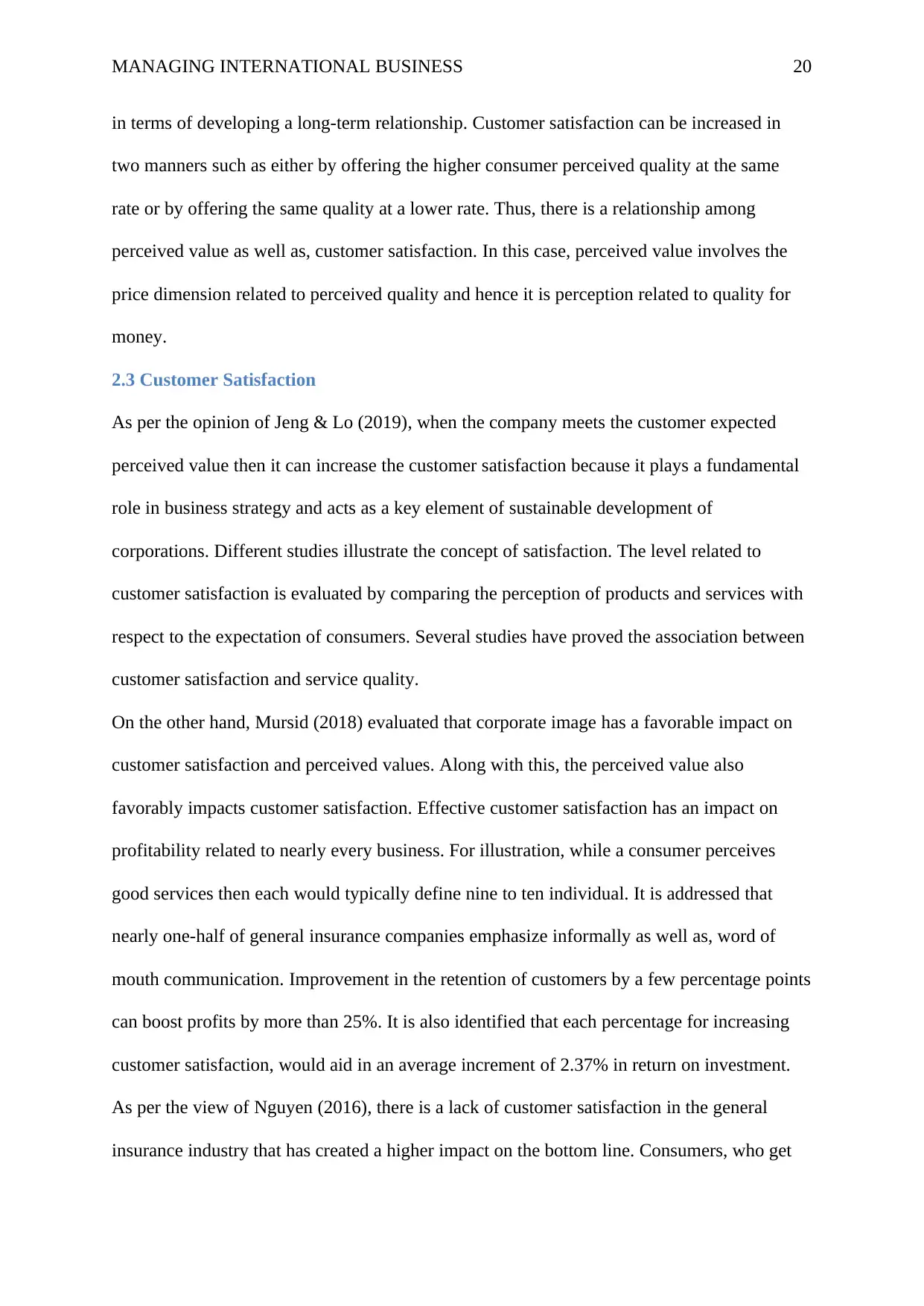
MANAGING INTERNATIONAL BUSINESS 20
in terms of developing a long-term relationship. Customer satisfaction can be increased in
two manners such as either by offering the higher consumer perceived quality at the same
rate or by offering the same quality at a lower rate. Thus, there is a relationship among
perceived value as well as, customer satisfaction. In this case, perceived value involves the
price dimension related to perceived quality and hence it is perception related to quality for
money.
2.3 Customer Satisfaction
As per the opinion of Jeng & Lo (2019), when the company meets the customer expected
perceived value then it can increase the customer satisfaction because it plays a fundamental
role in business strategy and acts as a key element of sustainable development of
corporations. Different studies illustrate the concept of satisfaction. The level related to
customer satisfaction is evaluated by comparing the perception of products and services with
respect to the expectation of consumers. Several studies have proved the association between
customer satisfaction and service quality.
On the other hand, Mursid (2018) evaluated that corporate image has a favorable impact on
customer satisfaction and perceived values. Along with this, the perceived value also
favorably impacts customer satisfaction. Effective customer satisfaction has an impact on
profitability related to nearly every business. For illustration, while a consumer perceives
good services then each would typically define nine to ten individual. It is addressed that
nearly one-half of general insurance companies emphasize informally as well as, word of
mouth communication. Improvement in the retention of customers by a few percentage points
can boost profits by more than 25%. It is also identified that each percentage for increasing
customer satisfaction, would aid in an average increment of 2.37% in return on investment.
As per the view of Nguyen (2016), there is a lack of customer satisfaction in the general
insurance industry that has created a higher impact on the bottom line. Consumers, who get
in terms of developing a long-term relationship. Customer satisfaction can be increased in
two manners such as either by offering the higher consumer perceived quality at the same
rate or by offering the same quality at a lower rate. Thus, there is a relationship among
perceived value as well as, customer satisfaction. In this case, perceived value involves the
price dimension related to perceived quality and hence it is perception related to quality for
money.
2.3 Customer Satisfaction
As per the opinion of Jeng & Lo (2019), when the company meets the customer expected
perceived value then it can increase the customer satisfaction because it plays a fundamental
role in business strategy and acts as a key element of sustainable development of
corporations. Different studies illustrate the concept of satisfaction. The level related to
customer satisfaction is evaluated by comparing the perception of products and services with
respect to the expectation of consumers. Several studies have proved the association between
customer satisfaction and service quality.
On the other hand, Mursid (2018) evaluated that corporate image has a favorable impact on
customer satisfaction and perceived values. Along with this, the perceived value also
favorably impacts customer satisfaction. Effective customer satisfaction has an impact on
profitability related to nearly every business. For illustration, while a consumer perceives
good services then each would typically define nine to ten individual. It is addressed that
nearly one-half of general insurance companies emphasize informally as well as, word of
mouth communication. Improvement in the retention of customers by a few percentage points
can boost profits by more than 25%. It is also identified that each percentage for increasing
customer satisfaction, would aid in an average increment of 2.37% in return on investment.
As per the view of Nguyen (2016), there is a lack of customer satisfaction in the general
insurance industry that has created a higher impact on the bottom line. Consumers, who get
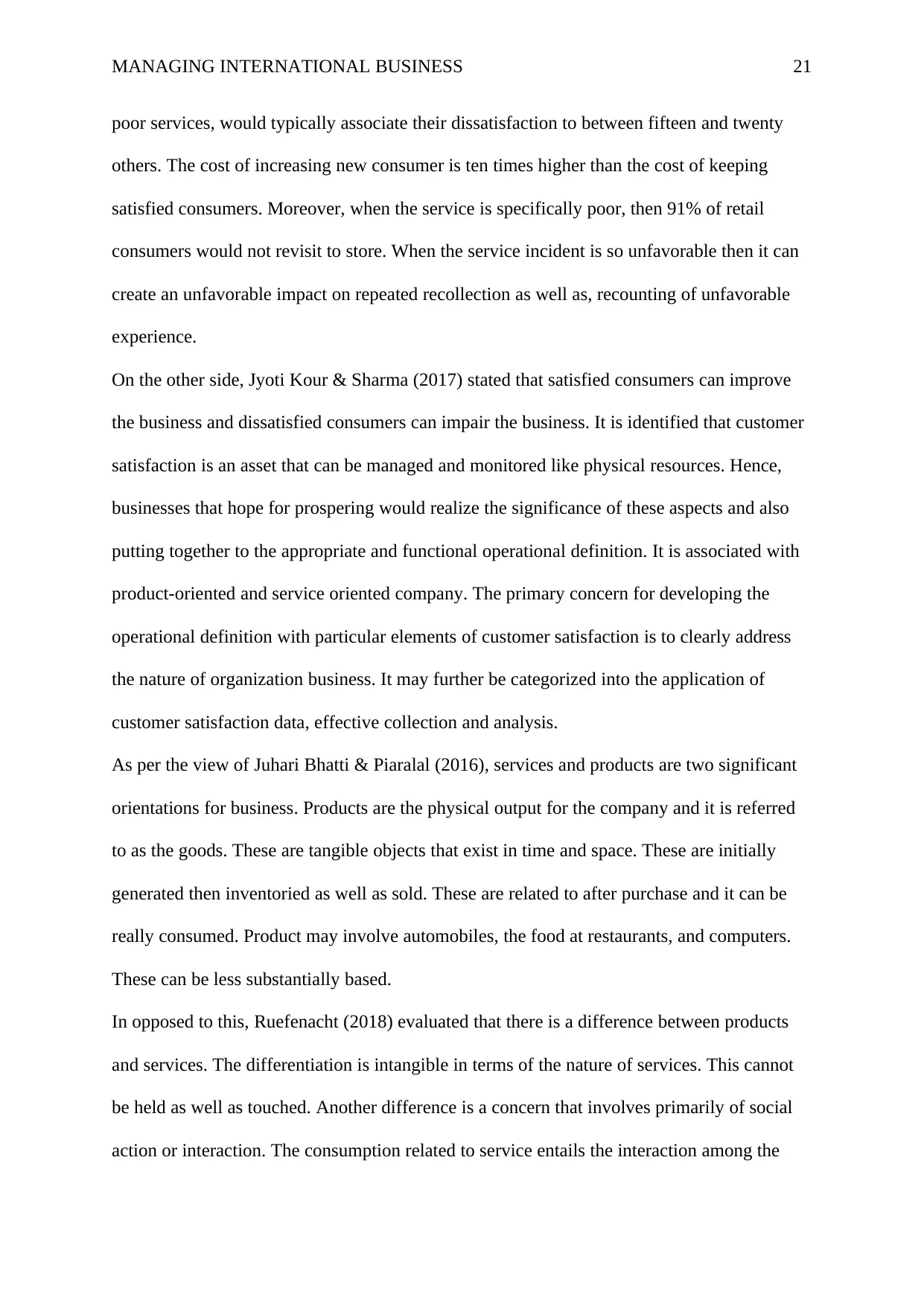
MANAGING INTERNATIONAL BUSINESS 21
poor services, would typically associate their dissatisfaction to between fifteen and twenty
others. The cost of increasing new consumer is ten times higher than the cost of keeping
satisfied consumers. Moreover, when the service is specifically poor, then 91% of retail
consumers would not revisit to store. When the service incident is so unfavorable then it can
create an unfavorable impact on repeated recollection as well as, recounting of unfavorable
experience.
On the other side, Jyoti Kour & Sharma (2017) stated that satisfied consumers can improve
the business and dissatisfied consumers can impair the business. It is identified that customer
satisfaction is an asset that can be managed and monitored like physical resources. Hence,
businesses that hope for prospering would realize the significance of these aspects and also
putting together to the appropriate and functional operational definition. It is associated with
product-oriented and service oriented company. The primary concern for developing the
operational definition with particular elements of customer satisfaction is to clearly address
the nature of organization business. It may further be categorized into the application of
customer satisfaction data, effective collection and analysis.
As per the view of Juhari Bhatti & Piaralal (2016), services and products are two significant
orientations for business. Products are the physical output for the company and it is referred
to as the goods. These are tangible objects that exist in time and space. These are initially
generated then inventoried as well as sold. These are related to after purchase and it can be
really consumed. Product may involve automobiles, the food at restaurants, and computers.
These can be less substantially based.
In opposed to this, Ruefenacht (2018) evaluated that there is a difference between products
and services. The differentiation is intangible in terms of the nature of services. This cannot
be held as well as touched. Another difference is a concern that involves primarily of social
action or interaction. The consumption related to service entails the interaction among the
poor services, would typically associate their dissatisfaction to between fifteen and twenty
others. The cost of increasing new consumer is ten times higher than the cost of keeping
satisfied consumers. Moreover, when the service is specifically poor, then 91% of retail
consumers would not revisit to store. When the service incident is so unfavorable then it can
create an unfavorable impact on repeated recollection as well as, recounting of unfavorable
experience.
On the other side, Jyoti Kour & Sharma (2017) stated that satisfied consumers can improve
the business and dissatisfied consumers can impair the business. It is identified that customer
satisfaction is an asset that can be managed and monitored like physical resources. Hence,
businesses that hope for prospering would realize the significance of these aspects and also
putting together to the appropriate and functional operational definition. It is associated with
product-oriented and service oriented company. The primary concern for developing the
operational definition with particular elements of customer satisfaction is to clearly address
the nature of organization business. It may further be categorized into the application of
customer satisfaction data, effective collection and analysis.
As per the view of Juhari Bhatti & Piaralal (2016), services and products are two significant
orientations for business. Products are the physical output for the company and it is referred
to as the goods. These are tangible objects that exist in time and space. These are initially
generated then inventoried as well as sold. These are related to after purchase and it can be
really consumed. Product may involve automobiles, the food at restaurants, and computers.
These can be less substantially based.
In opposed to this, Ruefenacht (2018) evaluated that there is a difference between products
and services. The differentiation is intangible in terms of the nature of services. This cannot
be held as well as touched. Another difference is a concern that involves primarily of social
action or interaction. The consumption related to service entails the interaction among the
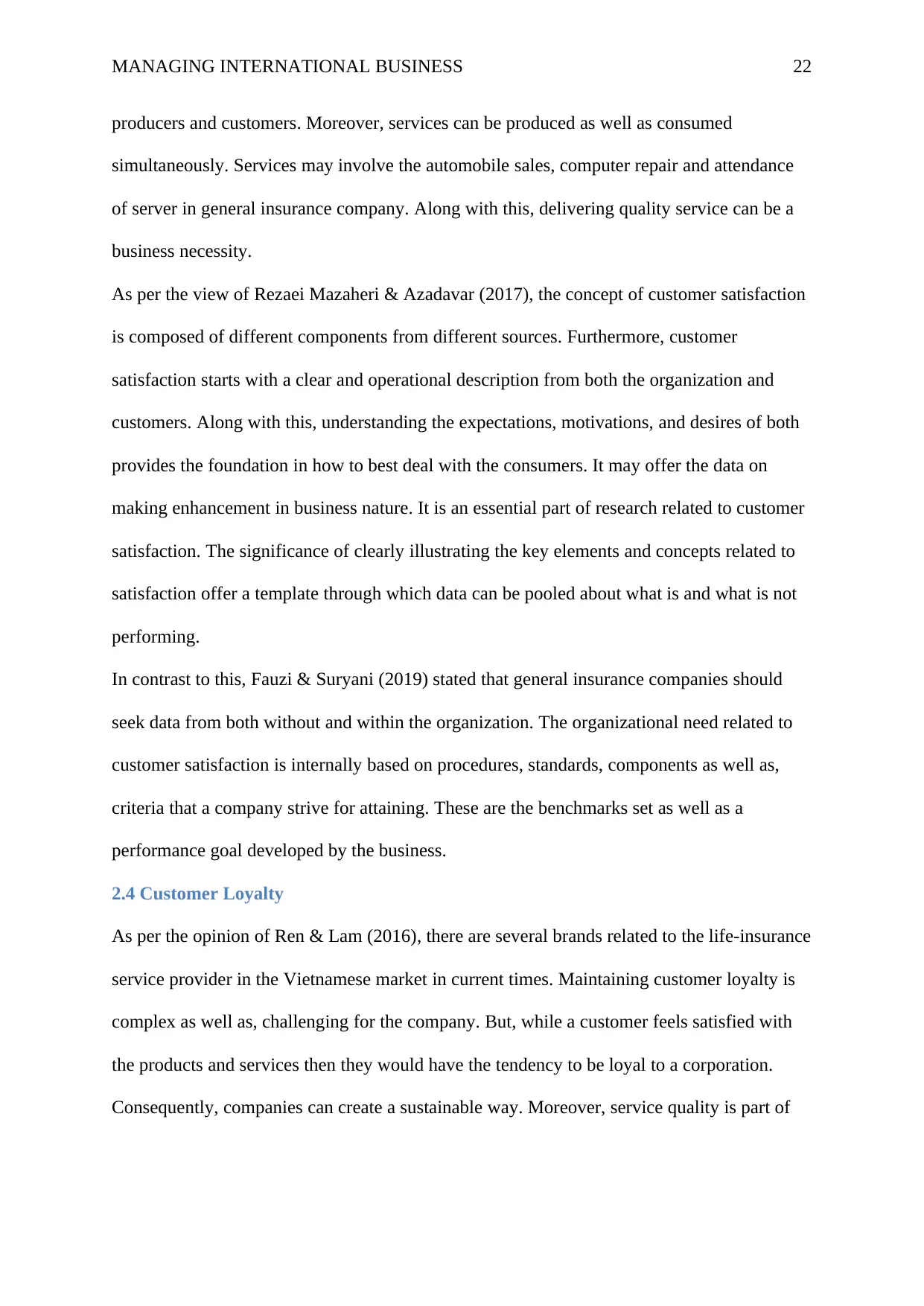
MANAGING INTERNATIONAL BUSINESS 22
producers and customers. Moreover, services can be produced as well as consumed
simultaneously. Services may involve the automobile sales, computer repair and attendance
of server in general insurance company. Along with this, delivering quality service can be a
business necessity.
As per the view of Rezaei Mazaheri & Azadavar (2017), the concept of customer satisfaction
is composed of different components from different sources. Furthermore, customer
satisfaction starts with a clear and operational description from both the organization and
customers. Along with this, understanding the expectations, motivations, and desires of both
provides the foundation in how to best deal with the consumers. It may offer the data on
making enhancement in business nature. It is an essential part of research related to customer
satisfaction. The significance of clearly illustrating the key elements and concepts related to
satisfaction offer a template through which data can be pooled about what is and what is not
performing.
In contrast to this, Fauzi & Suryani (2019) stated that general insurance companies should
seek data from both without and within the organization. The organizational need related to
customer satisfaction is internally based on procedures, standards, components as well as,
criteria that a company strive for attaining. These are the benchmarks set as well as a
performance goal developed by the business.
2.4 Customer Loyalty
As per the opinion of Ren & Lam (2016), there are several brands related to the life-insurance
service provider in the Vietnamese market in current times. Maintaining customer loyalty is
complex as well as, challenging for the company. But, while a customer feels satisfied with
the products and services then they would have the tendency to be loyal to a corporation.
Consequently, companies can create a sustainable way. Moreover, service quality is part of
producers and customers. Moreover, services can be produced as well as consumed
simultaneously. Services may involve the automobile sales, computer repair and attendance
of server in general insurance company. Along with this, delivering quality service can be a
business necessity.
As per the view of Rezaei Mazaheri & Azadavar (2017), the concept of customer satisfaction
is composed of different components from different sources. Furthermore, customer
satisfaction starts with a clear and operational description from both the organization and
customers. Along with this, understanding the expectations, motivations, and desires of both
provides the foundation in how to best deal with the consumers. It may offer the data on
making enhancement in business nature. It is an essential part of research related to customer
satisfaction. The significance of clearly illustrating the key elements and concepts related to
satisfaction offer a template through which data can be pooled about what is and what is not
performing.
In contrast to this, Fauzi & Suryani (2019) stated that general insurance companies should
seek data from both without and within the organization. The organizational need related to
customer satisfaction is internally based on procedures, standards, components as well as,
criteria that a company strive for attaining. These are the benchmarks set as well as a
performance goal developed by the business.
2.4 Customer Loyalty
As per the opinion of Ren & Lam (2016), there are several brands related to the life-insurance
service provider in the Vietnamese market in current times. Maintaining customer loyalty is
complex as well as, challenging for the company. But, while a customer feels satisfied with
the products and services then they would have the tendency to be loyal to a corporation.
Consequently, companies can create a sustainable way. Moreover, service quality is part of
Secure Best Marks with AI Grader
Need help grading? Try our AI Grader for instant feedback on your assignments.
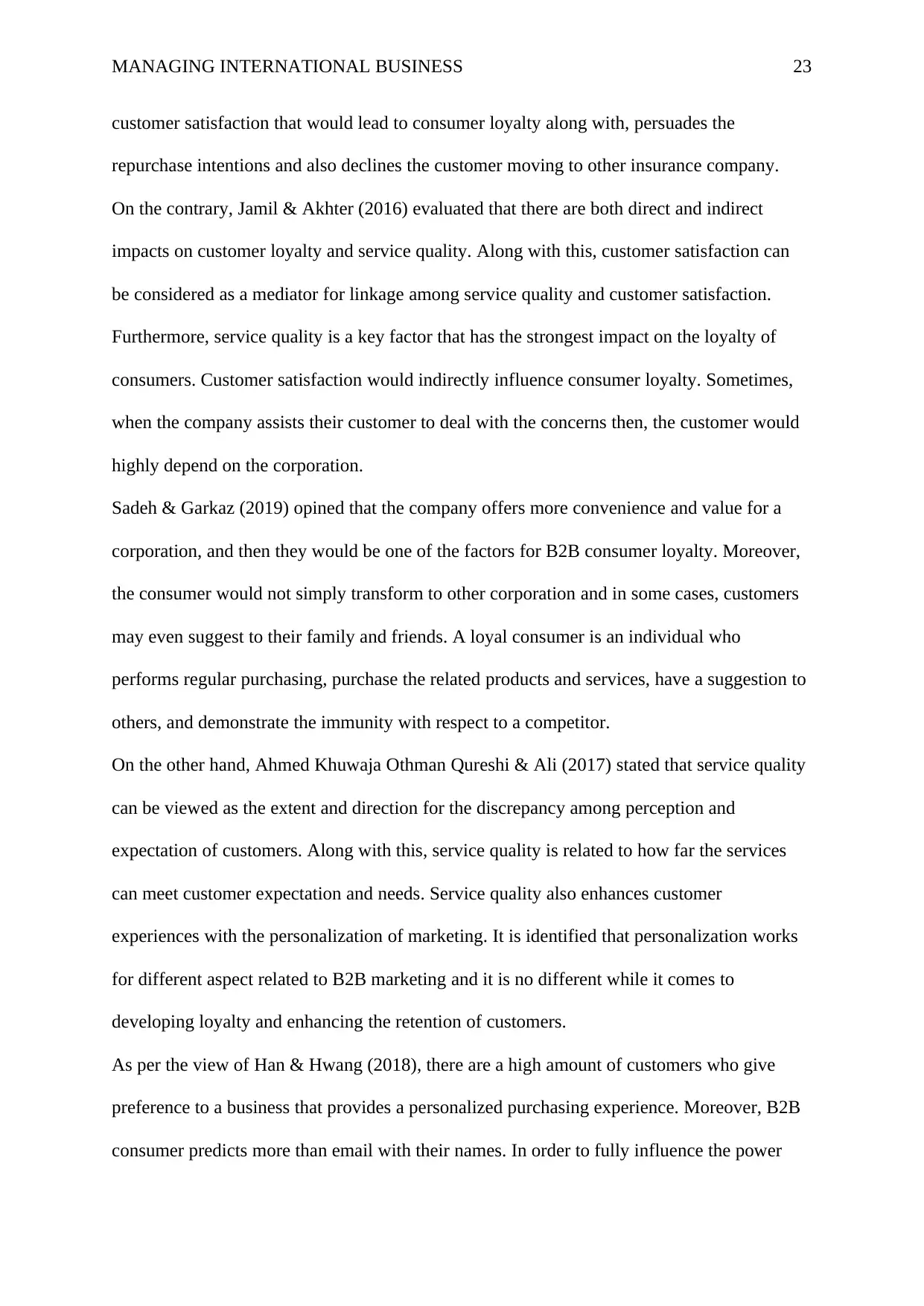
MANAGING INTERNATIONAL BUSINESS 23
customer satisfaction that would lead to consumer loyalty along with, persuades the
repurchase intentions and also declines the customer moving to other insurance company.
On the contrary, Jamil & Akhter (2016) evaluated that there are both direct and indirect
impacts on customer loyalty and service quality. Along with this, customer satisfaction can
be considered as a mediator for linkage among service quality and customer satisfaction.
Furthermore, service quality is a key factor that has the strongest impact on the loyalty of
consumers. Customer satisfaction would indirectly influence consumer loyalty. Sometimes,
when the company assists their customer to deal with the concerns then, the customer would
highly depend on the corporation.
Sadeh & Garkaz (2019) opined that the company offers more convenience and value for a
corporation, and then they would be one of the factors for B2B consumer loyalty. Moreover,
the consumer would not simply transform to other corporation and in some cases, customers
may even suggest to their family and friends. A loyal consumer is an individual who
performs regular purchasing, purchase the related products and services, have a suggestion to
others, and demonstrate the immunity with respect to a competitor.
On the other hand, Ahmed Khuwaja Othman Qureshi & Ali (2017) stated that service quality
can be viewed as the extent and direction for the discrepancy among perception and
expectation of customers. Along with this, service quality is related to how far the services
can meet customer expectation and needs. Service quality also enhances customer
experiences with the personalization of marketing. It is identified that personalization works
for different aspect related to B2B marketing and it is no different while it comes to
developing loyalty and enhancing the retention of customers.
As per the view of Han & Hwang (2018), there are a high amount of customers who give
preference to a business that provides a personalized purchasing experience. Moreover, B2B
consumer predicts more than email with their names. In order to fully influence the power
customer satisfaction that would lead to consumer loyalty along with, persuades the
repurchase intentions and also declines the customer moving to other insurance company.
On the contrary, Jamil & Akhter (2016) evaluated that there are both direct and indirect
impacts on customer loyalty and service quality. Along with this, customer satisfaction can
be considered as a mediator for linkage among service quality and customer satisfaction.
Furthermore, service quality is a key factor that has the strongest impact on the loyalty of
consumers. Customer satisfaction would indirectly influence consumer loyalty. Sometimes,
when the company assists their customer to deal with the concerns then, the customer would
highly depend on the corporation.
Sadeh & Garkaz (2019) opined that the company offers more convenience and value for a
corporation, and then they would be one of the factors for B2B consumer loyalty. Moreover,
the consumer would not simply transform to other corporation and in some cases, customers
may even suggest to their family and friends. A loyal consumer is an individual who
performs regular purchasing, purchase the related products and services, have a suggestion to
others, and demonstrate the immunity with respect to a competitor.
On the other hand, Ahmed Khuwaja Othman Qureshi & Ali (2017) stated that service quality
can be viewed as the extent and direction for the discrepancy among perception and
expectation of customers. Along with this, service quality is related to how far the services
can meet customer expectation and needs. Service quality also enhances customer
experiences with the personalization of marketing. It is identified that personalization works
for different aspect related to B2B marketing and it is no different while it comes to
developing loyalty and enhancing the retention of customers.
As per the view of Han & Hwang (2018), there are a high amount of customers who give
preference to a business that provides a personalized purchasing experience. Moreover, B2B
consumer predicts more than email with their names. In order to fully influence the power
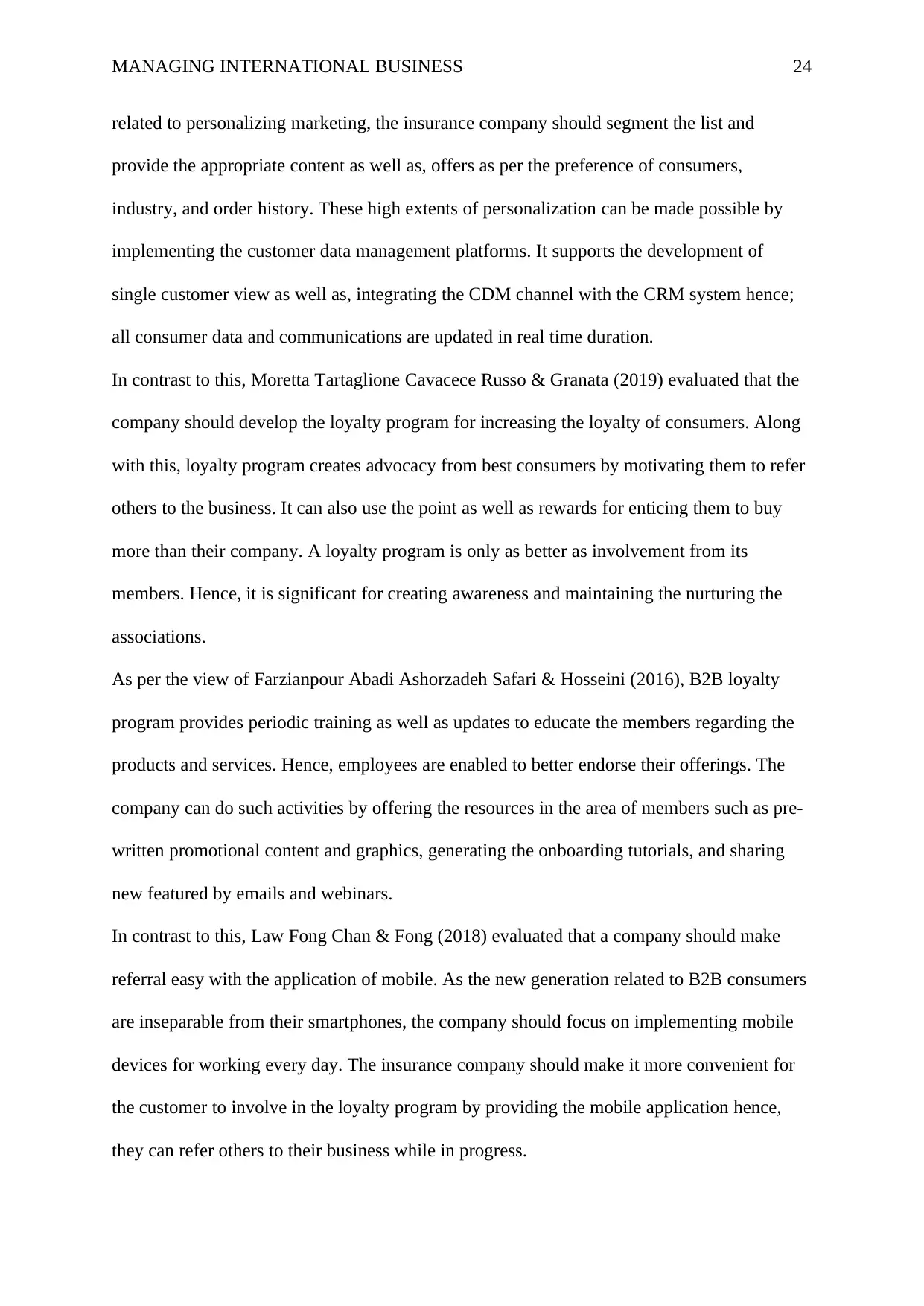
MANAGING INTERNATIONAL BUSINESS 24
related to personalizing marketing, the insurance company should segment the list and
provide the appropriate content as well as, offers as per the preference of consumers,
industry, and order history. These high extents of personalization can be made possible by
implementing the customer data management platforms. It supports the development of
single customer view as well as, integrating the CDM channel with the CRM system hence;
all consumer data and communications are updated in real time duration.
In contrast to this, Moretta Tartaglione Cavacece Russo & Granata (2019) evaluated that the
company should develop the loyalty program for increasing the loyalty of consumers. Along
with this, loyalty program creates advocacy from best consumers by motivating them to refer
others to the business. It can also use the point as well as rewards for enticing them to buy
more than their company. A loyalty program is only as better as involvement from its
members. Hence, it is significant for creating awareness and maintaining the nurturing the
associations.
As per the view of Farzianpour Abadi Ashorzadeh Safari & Hosseini (2016), B2B loyalty
program provides periodic training as well as updates to educate the members regarding the
products and services. Hence, employees are enabled to better endorse their offerings. The
company can do such activities by offering the resources in the area of members such as pre-
written promotional content and graphics, generating the onboarding tutorials, and sharing
new featured by emails and webinars.
In contrast to this, Law Fong Chan & Fong (2018) evaluated that a company should make
referral easy with the application of mobile. As the new generation related to B2B consumers
are inseparable from their smartphones, the company should focus on implementing mobile
devices for working every day. The insurance company should make it more convenient for
the customer to involve in the loyalty program by providing the mobile application hence,
they can refer others to their business while in progress.
related to personalizing marketing, the insurance company should segment the list and
provide the appropriate content as well as, offers as per the preference of consumers,
industry, and order history. These high extents of personalization can be made possible by
implementing the customer data management platforms. It supports the development of
single customer view as well as, integrating the CDM channel with the CRM system hence;
all consumer data and communications are updated in real time duration.
In contrast to this, Moretta Tartaglione Cavacece Russo & Granata (2019) evaluated that the
company should develop the loyalty program for increasing the loyalty of consumers. Along
with this, loyalty program creates advocacy from best consumers by motivating them to refer
others to the business. It can also use the point as well as rewards for enticing them to buy
more than their company. A loyalty program is only as better as involvement from its
members. Hence, it is significant for creating awareness and maintaining the nurturing the
associations.
As per the view of Farzianpour Abadi Ashorzadeh Safari & Hosseini (2016), B2B loyalty
program provides periodic training as well as updates to educate the members regarding the
products and services. Hence, employees are enabled to better endorse their offerings. The
company can do such activities by offering the resources in the area of members such as pre-
written promotional content and graphics, generating the onboarding tutorials, and sharing
new featured by emails and webinars.
In contrast to this, Law Fong Chan & Fong (2018) evaluated that a company should make
referral easy with the application of mobile. As the new generation related to B2B consumers
are inseparable from their smartphones, the company should focus on implementing mobile
devices for working every day. The insurance company should make it more convenient for
the customer to involve in the loyalty program by providing the mobile application hence,
they can refer others to their business while in progress.

MANAGING INTERNATIONAL BUSINESS 25
As per the view of Wirtz & Zeithaml (2018), the company should use the referral program for
B2B loyalty. It can endorse the mobile application to loyalty program members as well as,
encourages the usage by providing the extra points while consumer downloads the
applications. It can also create customer onboarding procedures. Since, customers are more
likely to return in the case, they want more added values from products and services. The
company can support them by providing post-sale support and consumer onboarding
initiatives.
In contrast to this, Aziz Md Husin Hussin & Afaq (2019) stated that the design of onboarding
procedure can motivate the adoption and usage for supporting the customer experience
related to benefits of products and increasing their return on investment. Thus, the customer
would be more likely to keep purchasing from their general insurance company. It can be
stated that the onboarding program can entail the multiple tactics as well as, touch-points like
tutorials and training, live chat, Q&A webinars, personalized follow-up emails, and phone
supports.
As per the view of Rajaobelina Lacroix & St-Onge (2019), the company should re-engage
inactive loyalty program members. Customers can get quite excited regarding the loyalty
program while they initial sign up but their enthusiasm may discourage over time. By
comprehending the loyalty lifecycle of customers, the company can deliver the feasible
content as well as incentives to keep long-standing members engaged. Hence, customers can
keep promoting products and services. The company can leverage AI-based targeting and
segmentation to assess the involvement of member so; it can fine-tune the communication as
well as rewards.
As per the view of Wirtz & Zeithaml (2018), the company should use the referral program for
B2B loyalty. It can endorse the mobile application to loyalty program members as well as,
encourages the usage by providing the extra points while consumer downloads the
applications. It can also create customer onboarding procedures. Since, customers are more
likely to return in the case, they want more added values from products and services. The
company can support them by providing post-sale support and consumer onboarding
initiatives.
In contrast to this, Aziz Md Husin Hussin & Afaq (2019) stated that the design of onboarding
procedure can motivate the adoption and usage for supporting the customer experience
related to benefits of products and increasing their return on investment. Thus, the customer
would be more likely to keep purchasing from their general insurance company. It can be
stated that the onboarding program can entail the multiple tactics as well as, touch-points like
tutorials and training, live chat, Q&A webinars, personalized follow-up emails, and phone
supports.
As per the view of Rajaobelina Lacroix & St-Onge (2019), the company should re-engage
inactive loyalty program members. Customers can get quite excited regarding the loyalty
program while they initial sign up but their enthusiasm may discourage over time. By
comprehending the loyalty lifecycle of customers, the company can deliver the feasible
content as well as incentives to keep long-standing members engaged. Hence, customers can
keep promoting products and services. The company can leverage AI-based targeting and
segmentation to assess the involvement of member so; it can fine-tune the communication as
well as rewards.
Paraphrase This Document
Need a fresh take? Get an instant paraphrase of this document with our AI Paraphraser
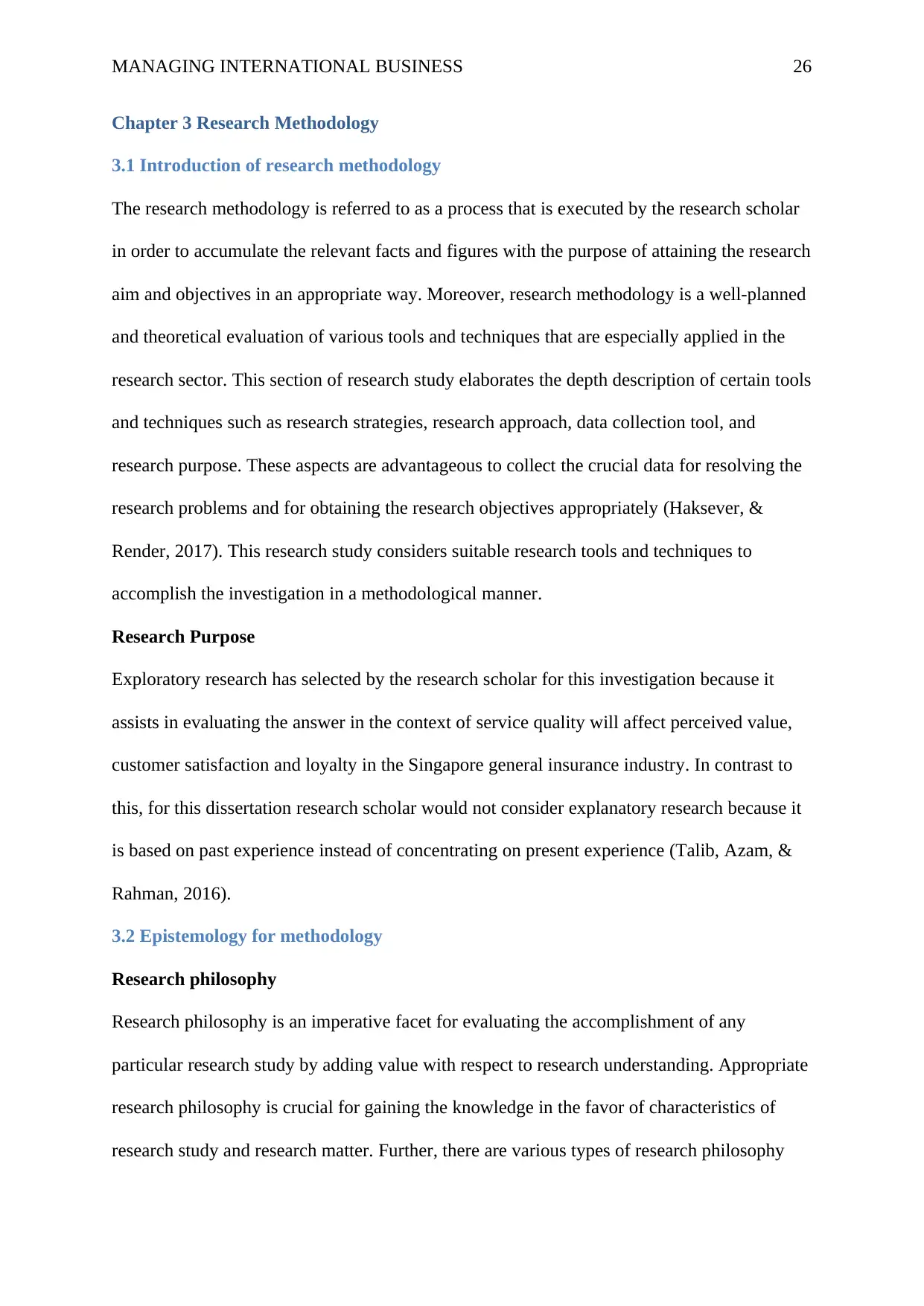
MANAGING INTERNATIONAL BUSINESS 26
Chapter 3 Research Methodology
3.1 Introduction of research methodology
The research methodology is referred to as a process that is executed by the research scholar
in order to accumulate the relevant facts and figures with the purpose of attaining the research
aim and objectives in an appropriate way. Moreover, research methodology is a well-planned
and theoretical evaluation of various tools and techniques that are especially applied in the
research sector. This section of research study elaborates the depth description of certain tools
and techniques such as research strategies, research approach, data collection tool, and
research purpose. These aspects are advantageous to collect the crucial data for resolving the
research problems and for obtaining the research objectives appropriately (Haksever, &
Render, 2017). This research study considers suitable research tools and techniques to
accomplish the investigation in a methodological manner.
Research Purpose
Exploratory research has selected by the research scholar for this investigation because it
assists in evaluating the answer in the context of service quality will affect perceived value,
customer satisfaction and loyalty in the Singapore general insurance industry. In contrast to
this, for this dissertation research scholar would not consider explanatory research because it
is based on past experience instead of concentrating on present experience (Talib, Azam, &
Rahman, 2016).
3.2 Epistemology for methodology
Research philosophy
Research philosophy is an imperative facet for evaluating the accomplishment of any
particular research study by adding value with respect to research understanding. Appropriate
research philosophy is crucial for gaining the knowledge in the favor of characteristics of
research study and research matter. Further, there are various types of research philosophy
Chapter 3 Research Methodology
3.1 Introduction of research methodology
The research methodology is referred to as a process that is executed by the research scholar
in order to accumulate the relevant facts and figures with the purpose of attaining the research
aim and objectives in an appropriate way. Moreover, research methodology is a well-planned
and theoretical evaluation of various tools and techniques that are especially applied in the
research sector. This section of research study elaborates the depth description of certain tools
and techniques such as research strategies, research approach, data collection tool, and
research purpose. These aspects are advantageous to collect the crucial data for resolving the
research problems and for obtaining the research objectives appropriately (Haksever, &
Render, 2017). This research study considers suitable research tools and techniques to
accomplish the investigation in a methodological manner.
Research Purpose
Exploratory research has selected by the research scholar for this investigation because it
assists in evaluating the answer in the context of service quality will affect perceived value,
customer satisfaction and loyalty in the Singapore general insurance industry. In contrast to
this, for this dissertation research scholar would not consider explanatory research because it
is based on past experience instead of concentrating on present experience (Talib, Azam, &
Rahman, 2016).
3.2 Epistemology for methodology
Research philosophy
Research philosophy is an imperative facet for evaluating the accomplishment of any
particular research study by adding value with respect to research understanding. Appropriate
research philosophy is crucial for gaining the knowledge in the favor of characteristics of
research study and research matter. Further, there are various types of research philosophy
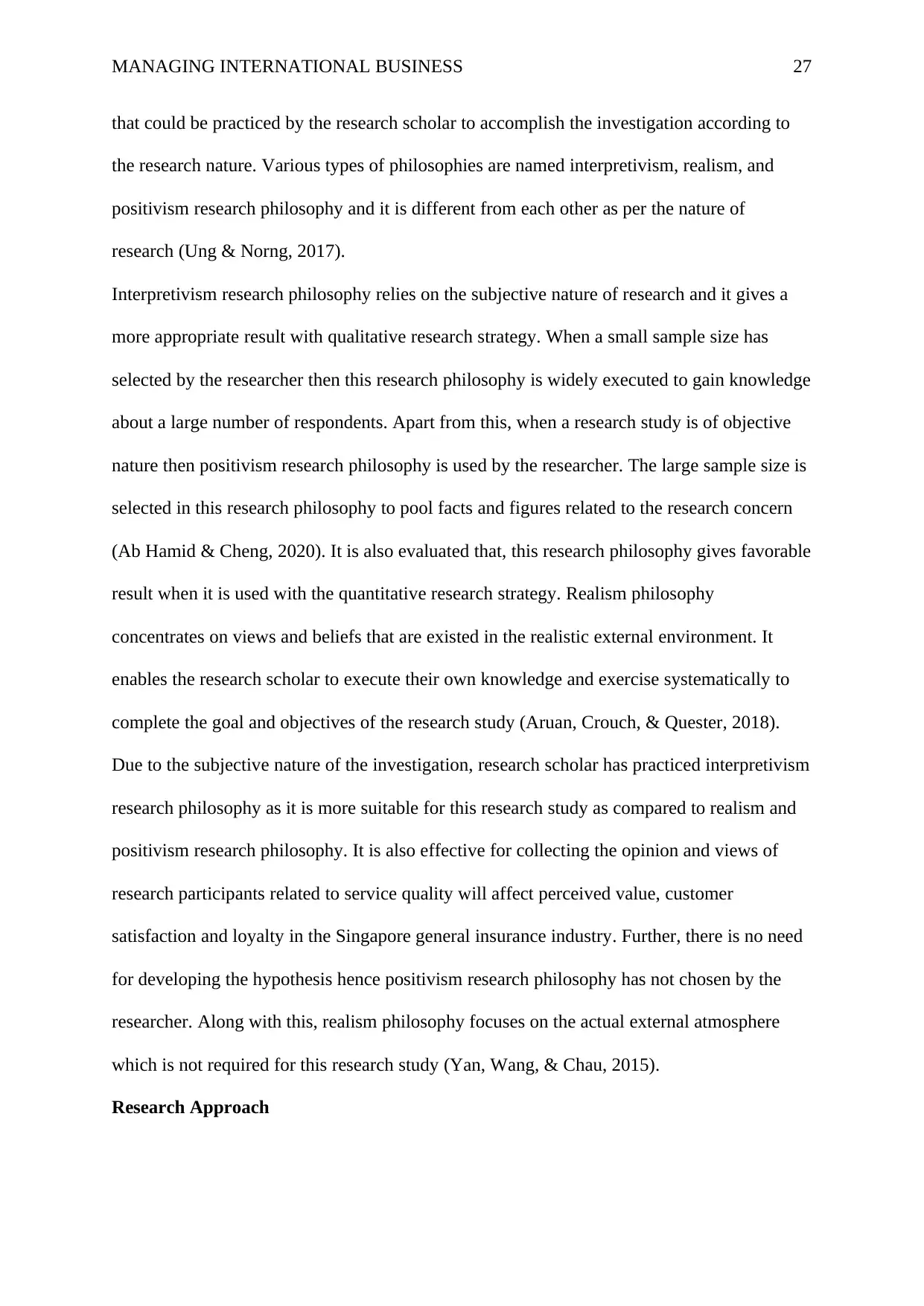
MANAGING INTERNATIONAL BUSINESS 27
that could be practiced by the research scholar to accomplish the investigation according to
the research nature. Various types of philosophies are named interpretivism, realism, and
positivism research philosophy and it is different from each other as per the nature of
research (Ung & Norng, 2017).
Interpretivism research philosophy relies on the subjective nature of research and it gives a
more appropriate result with qualitative research strategy. When a small sample size has
selected by the researcher then this research philosophy is widely executed to gain knowledge
about a large number of respondents. Apart from this, when a research study is of objective
nature then positivism research philosophy is used by the researcher. The large sample size is
selected in this research philosophy to pool facts and figures related to the research concern
(Ab Hamid & Cheng, 2020). It is also evaluated that, this research philosophy gives favorable
result when it is used with the quantitative research strategy. Realism philosophy
concentrates on views and beliefs that are existed in the realistic external environment. It
enables the research scholar to execute their own knowledge and exercise systematically to
complete the goal and objectives of the research study (Aruan, Crouch, & Quester, 2018).
Due to the subjective nature of the investigation, research scholar has practiced interpretivism
research philosophy as it is more suitable for this research study as compared to realism and
positivism research philosophy. It is also effective for collecting the opinion and views of
research participants related to service quality will affect perceived value, customer
satisfaction and loyalty in the Singapore general insurance industry. Further, there is no need
for developing the hypothesis hence positivism research philosophy has not chosen by the
researcher. Along with this, realism philosophy focuses on the actual external atmosphere
which is not required for this research study (Yan, Wang, & Chau, 2015).
Research Approach
that could be practiced by the research scholar to accomplish the investigation according to
the research nature. Various types of philosophies are named interpretivism, realism, and
positivism research philosophy and it is different from each other as per the nature of
research (Ung & Norng, 2017).
Interpretivism research philosophy relies on the subjective nature of research and it gives a
more appropriate result with qualitative research strategy. When a small sample size has
selected by the researcher then this research philosophy is widely executed to gain knowledge
about a large number of respondents. Apart from this, when a research study is of objective
nature then positivism research philosophy is used by the researcher. The large sample size is
selected in this research philosophy to pool facts and figures related to the research concern
(Ab Hamid & Cheng, 2020). It is also evaluated that, this research philosophy gives favorable
result when it is used with the quantitative research strategy. Realism philosophy
concentrates on views and beliefs that are existed in the realistic external environment. It
enables the research scholar to execute their own knowledge and exercise systematically to
complete the goal and objectives of the research study (Aruan, Crouch, & Quester, 2018).
Due to the subjective nature of the investigation, research scholar has practiced interpretivism
research philosophy as it is more suitable for this research study as compared to realism and
positivism research philosophy. It is also effective for collecting the opinion and views of
research participants related to service quality will affect perceived value, customer
satisfaction and loyalty in the Singapore general insurance industry. Further, there is no need
for developing the hypothesis hence positivism research philosophy has not chosen by the
researcher. Along with this, realism philosophy focuses on the actual external atmosphere
which is not required for this research study (Yan, Wang, & Chau, 2015).
Research Approach
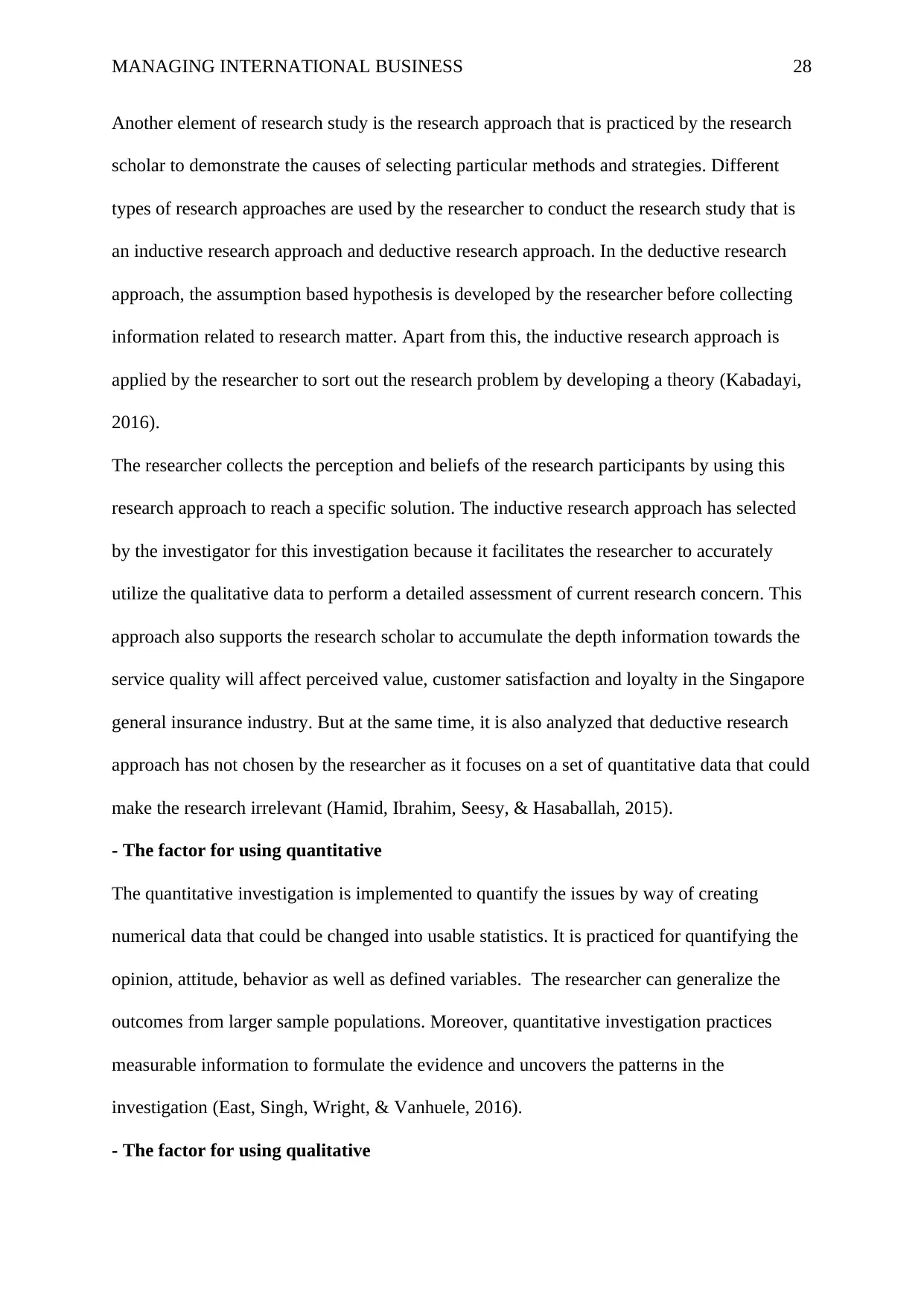
MANAGING INTERNATIONAL BUSINESS 28
Another element of research study is the research approach that is practiced by the research
scholar to demonstrate the causes of selecting particular methods and strategies. Different
types of research approaches are used by the researcher to conduct the research study that is
an inductive research approach and deductive research approach. In the deductive research
approach, the assumption based hypothesis is developed by the researcher before collecting
information related to research matter. Apart from this, the inductive research approach is
applied by the researcher to sort out the research problem by developing a theory (Kabadayi,
2016).
The researcher collects the perception and beliefs of the research participants by using this
research approach to reach a specific solution. The inductive research approach has selected
by the investigator for this investigation because it facilitates the researcher to accurately
utilize the qualitative data to perform a detailed assessment of current research concern. This
approach also supports the research scholar to accumulate the depth information towards the
service quality will affect perceived value, customer satisfaction and loyalty in the Singapore
general insurance industry. But at the same time, it is also analyzed that deductive research
approach has not chosen by the researcher as it focuses on a set of quantitative data that could
make the research irrelevant (Hamid, Ibrahim, Seesy, & Hasaballah, 2015).
- The factor for using quantitative
The quantitative investigation is implemented to quantify the issues by way of creating
numerical data that could be changed into usable statistics. It is practiced for quantifying the
opinion, attitude, behavior as well as defined variables. The researcher can generalize the
outcomes from larger sample populations. Moreover, quantitative investigation practices
measurable information to formulate the evidence and uncovers the patterns in the
investigation (East, Singh, Wright, & Vanhuele, 2016).
- The factor for using qualitative
Another element of research study is the research approach that is practiced by the research
scholar to demonstrate the causes of selecting particular methods and strategies. Different
types of research approaches are used by the researcher to conduct the research study that is
an inductive research approach and deductive research approach. In the deductive research
approach, the assumption based hypothesis is developed by the researcher before collecting
information related to research matter. Apart from this, the inductive research approach is
applied by the researcher to sort out the research problem by developing a theory (Kabadayi,
2016).
The researcher collects the perception and beliefs of the research participants by using this
research approach to reach a specific solution. The inductive research approach has selected
by the investigator for this investigation because it facilitates the researcher to accurately
utilize the qualitative data to perform a detailed assessment of current research concern. This
approach also supports the research scholar to accumulate the depth information towards the
service quality will affect perceived value, customer satisfaction and loyalty in the Singapore
general insurance industry. But at the same time, it is also analyzed that deductive research
approach has not chosen by the researcher as it focuses on a set of quantitative data that could
make the research irrelevant (Hamid, Ibrahim, Seesy, & Hasaballah, 2015).
- The factor for using quantitative
The quantitative investigation is implemented to quantify the issues by way of creating
numerical data that could be changed into usable statistics. It is practiced for quantifying the
opinion, attitude, behavior as well as defined variables. The researcher can generalize the
outcomes from larger sample populations. Moreover, quantitative investigation practices
measurable information to formulate the evidence and uncovers the patterns in the
investigation (East, Singh, Wright, & Vanhuele, 2016).
- The factor for using qualitative
Secure Best Marks with AI Grader
Need help grading? Try our AI Grader for instant feedback on your assignments.
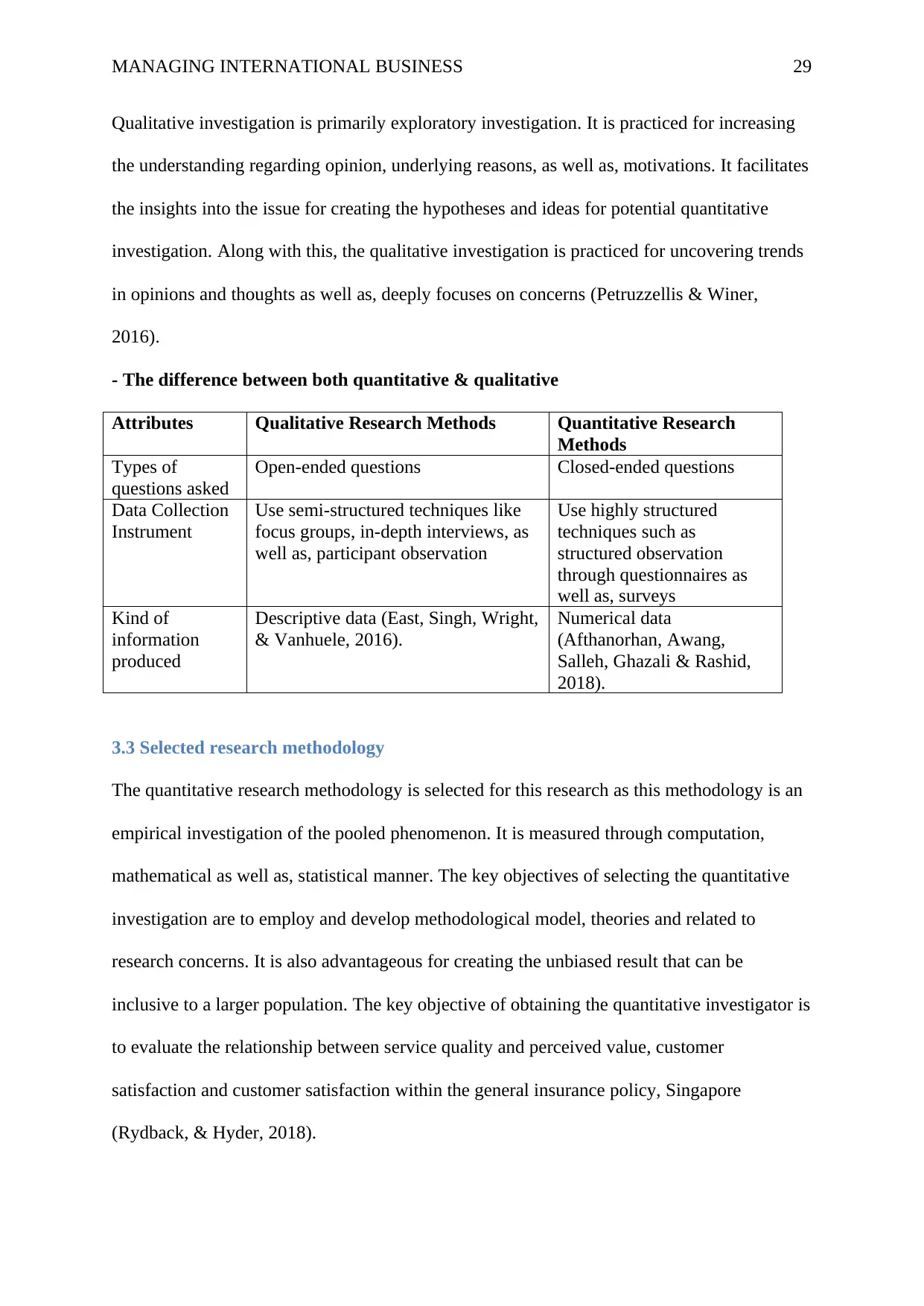
MANAGING INTERNATIONAL BUSINESS 29
Qualitative investigation is primarily exploratory investigation. It is practiced for increasing
the understanding regarding opinion, underlying reasons, as well as, motivations. It facilitates
the insights into the issue for creating the hypotheses and ideas for potential quantitative
investigation. Along with this, the qualitative investigation is practiced for uncovering trends
in opinions and thoughts as well as, deeply focuses on concerns (Petruzzellis & Winer,
2016).
- The difference between both quantitative & qualitative
Attributes Qualitative Research Methods Quantitative Research
Methods
Types of
questions asked
Open-ended questions Closed-ended questions
Data Collection
Instrument
Use semi-structured techniques like
focus groups, in-depth interviews, as
well as, participant observation
Use highly structured
techniques such as
structured observation
through questionnaires as
well as, surveys
Kind of
information
produced
Descriptive data (East, Singh, Wright,
& Vanhuele, 2016).
Numerical data
(Afthanorhan, Awang,
Salleh, Ghazali & Rashid,
2018).
3.3 Selected research methodology
The quantitative research methodology is selected for this research as this methodology is an
empirical investigation of the pooled phenomenon. It is measured through computation,
mathematical as well as, statistical manner. The key objectives of selecting the quantitative
investigation are to employ and develop methodological model, theories and related to
research concerns. It is also advantageous for creating the unbiased result that can be
inclusive to a larger population. The key objective of obtaining the quantitative investigator is
to evaluate the relationship between service quality and perceived value, customer
satisfaction and customer satisfaction within the general insurance policy, Singapore
(Rydback, & Hyder, 2018).
Qualitative investigation is primarily exploratory investigation. It is practiced for increasing
the understanding regarding opinion, underlying reasons, as well as, motivations. It facilitates
the insights into the issue for creating the hypotheses and ideas for potential quantitative
investigation. Along with this, the qualitative investigation is practiced for uncovering trends
in opinions and thoughts as well as, deeply focuses on concerns (Petruzzellis & Winer,
2016).
- The difference between both quantitative & qualitative
Attributes Qualitative Research Methods Quantitative Research
Methods
Types of
questions asked
Open-ended questions Closed-ended questions
Data Collection
Instrument
Use semi-structured techniques like
focus groups, in-depth interviews, as
well as, participant observation
Use highly structured
techniques such as
structured observation
through questionnaires as
well as, surveys
Kind of
information
produced
Descriptive data (East, Singh, Wright,
& Vanhuele, 2016).
Numerical data
(Afthanorhan, Awang,
Salleh, Ghazali & Rashid,
2018).
3.3 Selected research methodology
The quantitative research methodology is selected for this research as this methodology is an
empirical investigation of the pooled phenomenon. It is measured through computation,
mathematical as well as, statistical manner. The key objectives of selecting the quantitative
investigation are to employ and develop methodological model, theories and related to
research concerns. It is also advantageous for creating the unbiased result that can be
inclusive to a larger population. The key objective of obtaining the quantitative investigator is
to evaluate the relationship between service quality and perceived value, customer
satisfaction and customer satisfaction within the general insurance policy, Singapore
(Rydback, & Hyder, 2018).
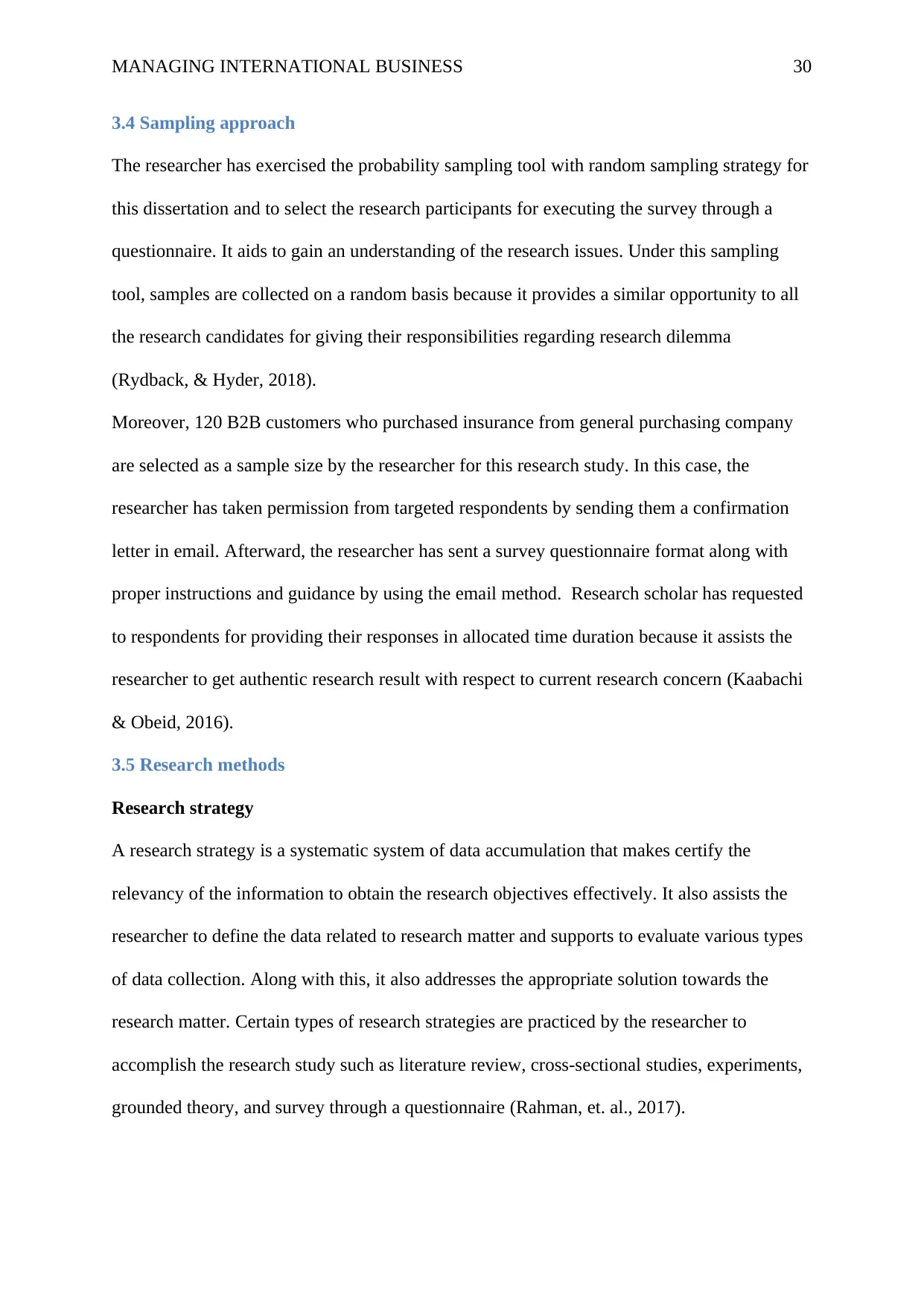
MANAGING INTERNATIONAL BUSINESS 30
3.4 Sampling approach
The researcher has exercised the probability sampling tool with random sampling strategy for
this dissertation and to select the research participants for executing the survey through a
questionnaire. It aids to gain an understanding of the research issues. Under this sampling
tool, samples are collected on a random basis because it provides a similar opportunity to all
the research candidates for giving their responsibilities regarding research dilemma
(Rydback, & Hyder, 2018).
Moreover, 120 B2B customers who purchased insurance from general purchasing company
are selected as a sample size by the researcher for this research study. In this case, the
researcher has taken permission from targeted respondents by sending them a confirmation
letter in email. Afterward, the researcher has sent a survey questionnaire format along with
proper instructions and guidance by using the email method. Research scholar has requested
to respondents for providing their responses in allocated time duration because it assists the
researcher to get authentic research result with respect to current research concern (Kaabachi
& Obeid, 2016).
3.5 Research methods
Research strategy
A research strategy is a systematic system of data accumulation that makes certify the
relevancy of the information to obtain the research objectives effectively. It also assists the
researcher to define the data related to research matter and supports to evaluate various types
of data collection. Along with this, it also addresses the appropriate solution towards the
research matter. Certain types of research strategies are practiced by the researcher to
accomplish the research study such as literature review, cross-sectional studies, experiments,
grounded theory, and survey through a questionnaire (Rahman, et. al., 2017).
3.4 Sampling approach
The researcher has exercised the probability sampling tool with random sampling strategy for
this dissertation and to select the research participants for executing the survey through a
questionnaire. It aids to gain an understanding of the research issues. Under this sampling
tool, samples are collected on a random basis because it provides a similar opportunity to all
the research candidates for giving their responsibilities regarding research dilemma
(Rydback, & Hyder, 2018).
Moreover, 120 B2B customers who purchased insurance from general purchasing company
are selected as a sample size by the researcher for this research study. In this case, the
researcher has taken permission from targeted respondents by sending them a confirmation
letter in email. Afterward, the researcher has sent a survey questionnaire format along with
proper instructions and guidance by using the email method. Research scholar has requested
to respondents for providing their responses in allocated time duration because it assists the
researcher to get authentic research result with respect to current research concern (Kaabachi
& Obeid, 2016).
3.5 Research methods
Research strategy
A research strategy is a systematic system of data accumulation that makes certify the
relevancy of the information to obtain the research objectives effectively. It also assists the
researcher to define the data related to research matter and supports to evaluate various types
of data collection. Along with this, it also addresses the appropriate solution towards the
research matter. Certain types of research strategies are practiced by the researcher to
accomplish the research study such as literature review, cross-sectional studies, experiments,
grounded theory, and survey through a questionnaire (Rahman, et. al., 2017).
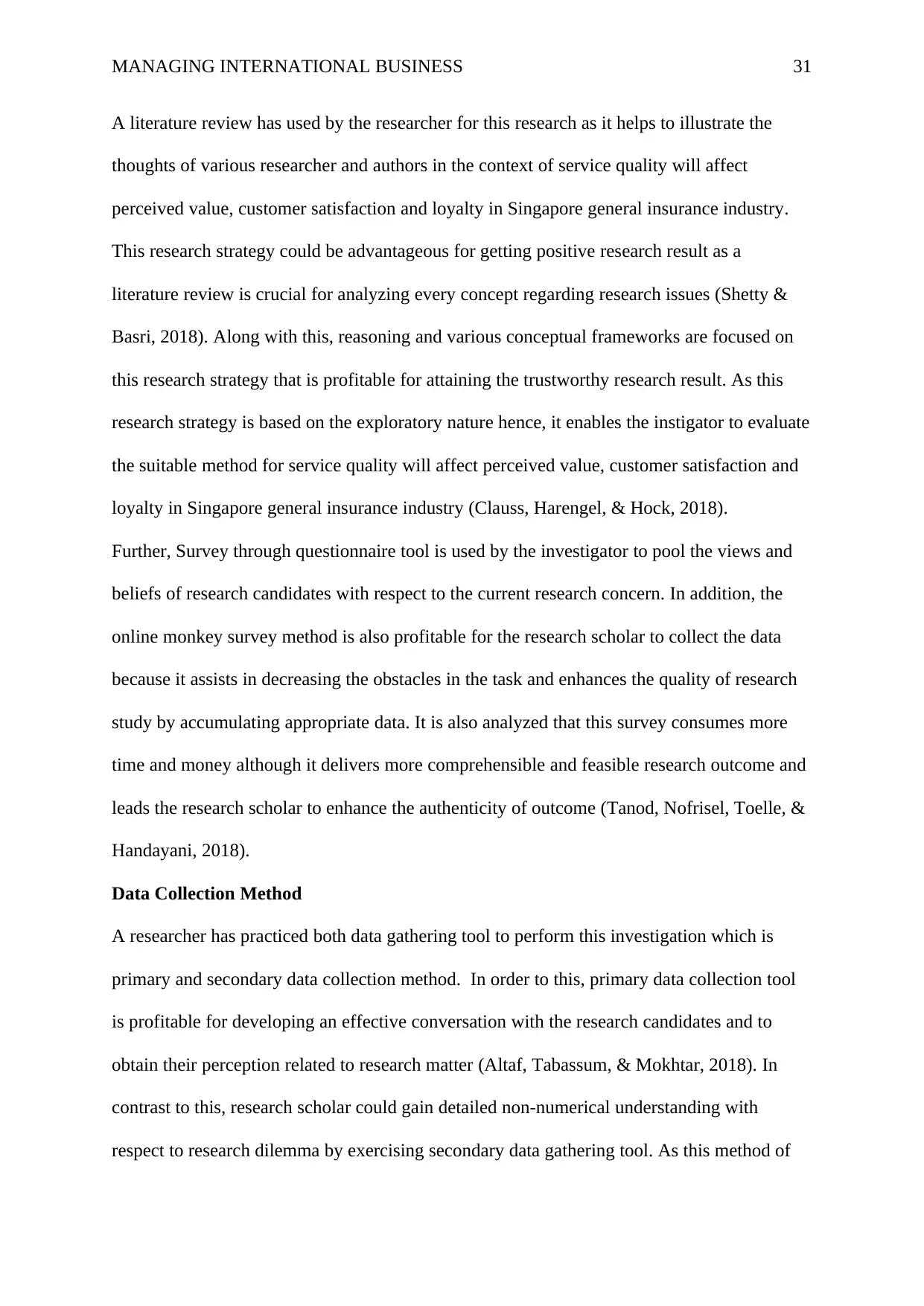
MANAGING INTERNATIONAL BUSINESS 31
A literature review has used by the researcher for this research as it helps to illustrate the
thoughts of various researcher and authors in the context of service quality will affect
perceived value, customer satisfaction and loyalty in Singapore general insurance industry.
This research strategy could be advantageous for getting positive research result as a
literature review is crucial for analyzing every concept regarding research issues (Shetty &
Basri, 2018). Along with this, reasoning and various conceptual frameworks are focused on
this research strategy that is profitable for attaining the trustworthy research result. As this
research strategy is based on the exploratory nature hence, it enables the instigator to evaluate
the suitable method for service quality will affect perceived value, customer satisfaction and
loyalty in Singapore general insurance industry (Clauss, Harengel, & Hock, 2018).
Further, Survey through questionnaire tool is used by the investigator to pool the views and
beliefs of research candidates with respect to the current research concern. In addition, the
online monkey survey method is also profitable for the research scholar to collect the data
because it assists in decreasing the obstacles in the task and enhances the quality of research
study by accumulating appropriate data. It is also analyzed that this survey consumes more
time and money although it delivers more comprehensible and feasible research outcome and
leads the research scholar to enhance the authenticity of outcome (Tanod, Nofrisel, Toelle, &
Handayani, 2018).
Data Collection Method
A researcher has practiced both data gathering tool to perform this investigation which is
primary and secondary data collection method. In order to this, primary data collection tool
is profitable for developing an effective conversation with the research candidates and to
obtain their perception related to research matter (Altaf, Tabassum, & Mokhtar, 2018). In
contrast to this, research scholar could gain detailed non-numerical understanding with
respect to research dilemma by exercising secondary data gathering tool. As this method of
A literature review has used by the researcher for this research as it helps to illustrate the
thoughts of various researcher and authors in the context of service quality will affect
perceived value, customer satisfaction and loyalty in Singapore general insurance industry.
This research strategy could be advantageous for getting positive research result as a
literature review is crucial for analyzing every concept regarding research issues (Shetty &
Basri, 2018). Along with this, reasoning and various conceptual frameworks are focused on
this research strategy that is profitable for attaining the trustworthy research result. As this
research strategy is based on the exploratory nature hence, it enables the instigator to evaluate
the suitable method for service quality will affect perceived value, customer satisfaction and
loyalty in Singapore general insurance industry (Clauss, Harengel, & Hock, 2018).
Further, Survey through questionnaire tool is used by the investigator to pool the views and
beliefs of research candidates with respect to the current research concern. In addition, the
online monkey survey method is also profitable for the research scholar to collect the data
because it assists in decreasing the obstacles in the task and enhances the quality of research
study by accumulating appropriate data. It is also analyzed that this survey consumes more
time and money although it delivers more comprehensible and feasible research outcome and
leads the research scholar to enhance the authenticity of outcome (Tanod, Nofrisel, Toelle, &
Handayani, 2018).
Data Collection Method
A researcher has practiced both data gathering tool to perform this investigation which is
primary and secondary data collection method. In order to this, primary data collection tool
is profitable for developing an effective conversation with the research candidates and to
obtain their perception related to research matter (Altaf, Tabassum, & Mokhtar, 2018). In
contrast to this, research scholar could gain detailed non-numerical understanding with
respect to research dilemma by exercising secondary data gathering tool. As this method of
Paraphrase This Document
Need a fresh take? Get an instant paraphrase of this document with our AI Paraphraser
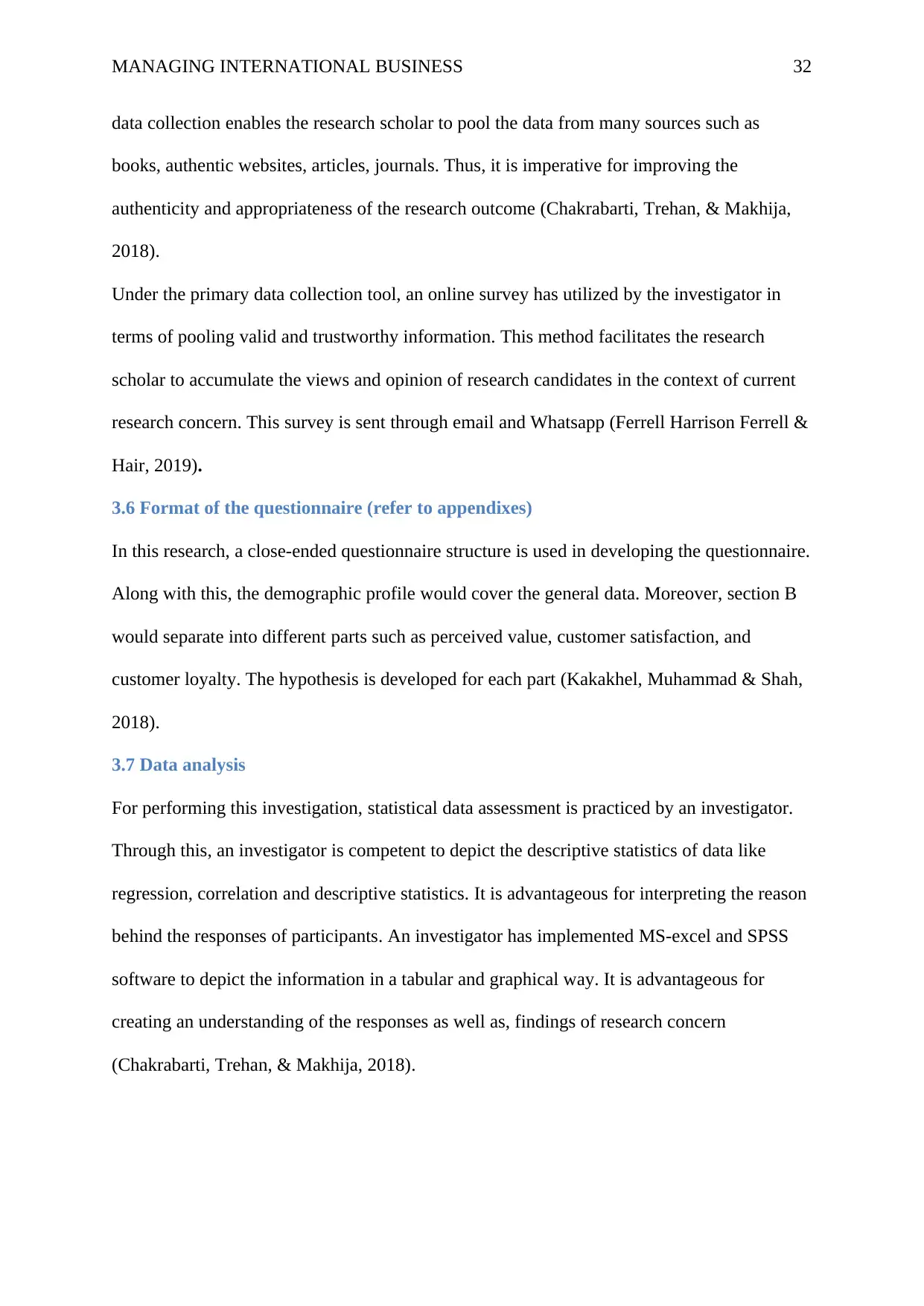
MANAGING INTERNATIONAL BUSINESS 32
data collection enables the research scholar to pool the data from many sources such as
books, authentic websites, articles, journals. Thus, it is imperative for improving the
authenticity and appropriateness of the research outcome (Chakrabarti, Trehan, & Makhija,
2018).
Under the primary data collection tool, an online survey has utilized by the investigator in
terms of pooling valid and trustworthy information. This method facilitates the research
scholar to accumulate the views and opinion of research candidates in the context of current
research concern. This survey is sent through email and Whatsapp (Ferrell Harrison Ferrell &
Hair, 2019).
3.6 Format of the questionnaire (refer to appendixes)
In this research, a close-ended questionnaire structure is used in developing the questionnaire.
Along with this, the demographic profile would cover the general data. Moreover, section B
would separate into different parts such as perceived value, customer satisfaction, and
customer loyalty. The hypothesis is developed for each part (Kakakhel, Muhammad & Shah,
2018).
3.7 Data analysis
For performing this investigation, statistical data assessment is practiced by an investigator.
Through this, an investigator is competent to depict the descriptive statistics of data like
regression, correlation and descriptive statistics. It is advantageous for interpreting the reason
behind the responses of participants. An investigator has implemented MS-excel and SPSS
software to depict the information in a tabular and graphical way. It is advantageous for
creating an understanding of the responses as well as, findings of research concern
(Chakrabarti, Trehan, & Makhija, 2018).
data collection enables the research scholar to pool the data from many sources such as
books, authentic websites, articles, journals. Thus, it is imperative for improving the
authenticity and appropriateness of the research outcome (Chakrabarti, Trehan, & Makhija,
2018).
Under the primary data collection tool, an online survey has utilized by the investigator in
terms of pooling valid and trustworthy information. This method facilitates the research
scholar to accumulate the views and opinion of research candidates in the context of current
research concern. This survey is sent through email and Whatsapp (Ferrell Harrison Ferrell &
Hair, 2019).
3.6 Format of the questionnaire (refer to appendixes)
In this research, a close-ended questionnaire structure is used in developing the questionnaire.
Along with this, the demographic profile would cover the general data. Moreover, section B
would separate into different parts such as perceived value, customer satisfaction, and
customer loyalty. The hypothesis is developed for each part (Kakakhel, Muhammad & Shah,
2018).
3.7 Data analysis
For performing this investigation, statistical data assessment is practiced by an investigator.
Through this, an investigator is competent to depict the descriptive statistics of data like
regression, correlation and descriptive statistics. It is advantageous for interpreting the reason
behind the responses of participants. An investigator has implemented MS-excel and SPSS
software to depict the information in a tabular and graphical way. It is advantageous for
creating an understanding of the responses as well as, findings of research concern
(Chakrabarti, Trehan, & Makhija, 2018).
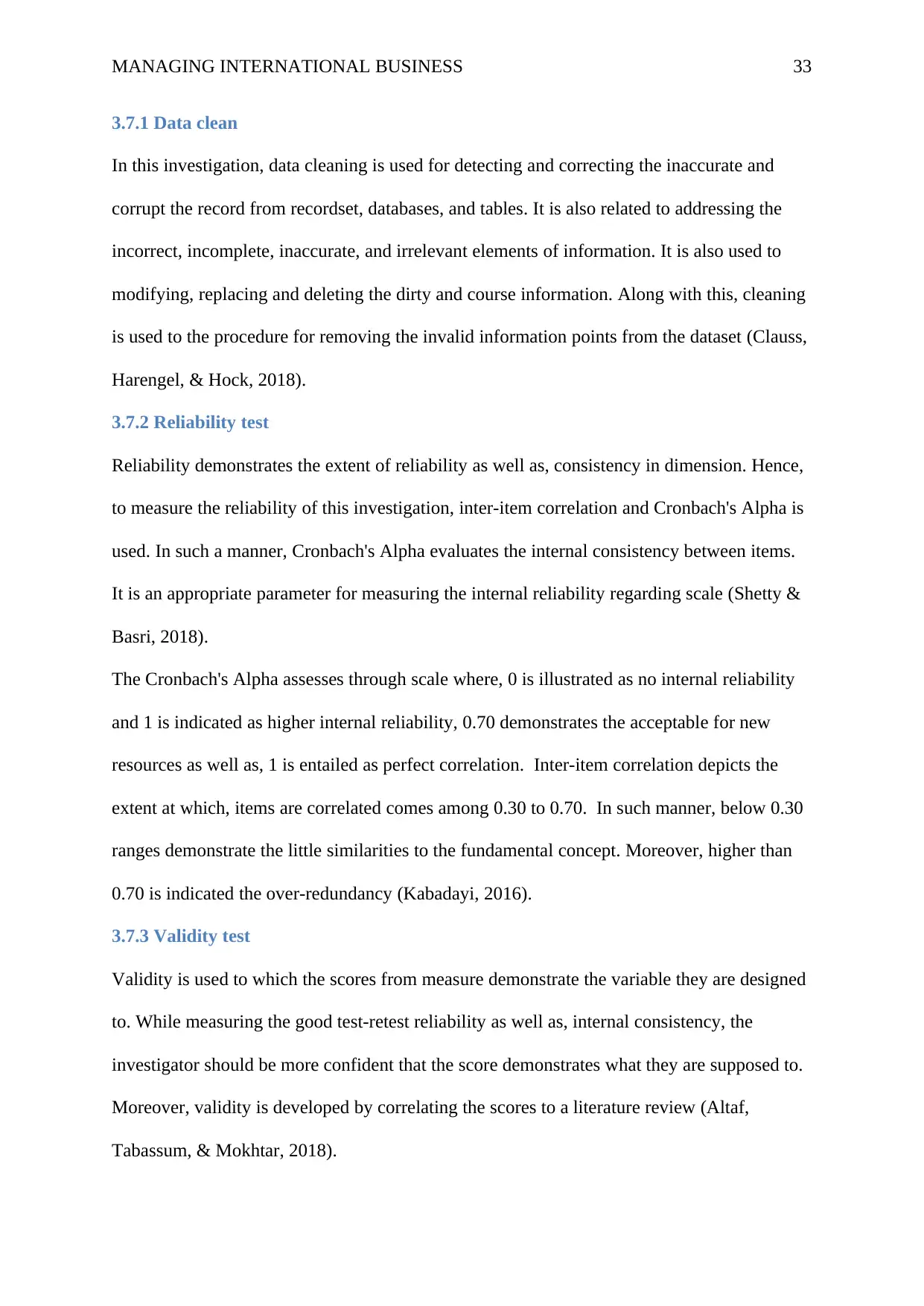
MANAGING INTERNATIONAL BUSINESS 33
3.7.1 Data clean
In this investigation, data cleaning is used for detecting and correcting the inaccurate and
corrupt the record from recordset, databases, and tables. It is also related to addressing the
incorrect, incomplete, inaccurate, and irrelevant elements of information. It is also used to
modifying, replacing and deleting the dirty and course information. Along with this, cleaning
is used to the procedure for removing the invalid information points from the dataset (Clauss,
Harengel, & Hock, 2018).
3.7.2 Reliability test
Reliability demonstrates the extent of reliability as well as, consistency in dimension. Hence,
to measure the reliability of this investigation, inter-item correlation and Cronbach's Alpha is
used. In such a manner, Cronbach's Alpha evaluates the internal consistency between items.
It is an appropriate parameter for measuring the internal reliability regarding scale (Shetty &
Basri, 2018).
The Cronbach's Alpha assesses through scale where, 0 is illustrated as no internal reliability
and 1 is indicated as higher internal reliability, 0.70 demonstrates the acceptable for new
resources as well as, 1 is entailed as perfect correlation. Inter-item correlation depicts the
extent at which, items are correlated comes among 0.30 to 0.70. In such manner, below 0.30
ranges demonstrate the little similarities to the fundamental concept. Moreover, higher than
0.70 is indicated the over-redundancy (Kabadayi, 2016).
3.7.3 Validity test
Validity is used to which the scores from measure demonstrate the variable they are designed
to. While measuring the good test-retest reliability as well as, internal consistency, the
investigator should be more confident that the score demonstrates what they are supposed to.
Moreover, validity is developed by correlating the scores to a literature review (Altaf,
Tabassum, & Mokhtar, 2018).
3.7.1 Data clean
In this investigation, data cleaning is used for detecting and correcting the inaccurate and
corrupt the record from recordset, databases, and tables. It is also related to addressing the
incorrect, incomplete, inaccurate, and irrelevant elements of information. It is also used to
modifying, replacing and deleting the dirty and course information. Along with this, cleaning
is used to the procedure for removing the invalid information points from the dataset (Clauss,
Harengel, & Hock, 2018).
3.7.2 Reliability test
Reliability demonstrates the extent of reliability as well as, consistency in dimension. Hence,
to measure the reliability of this investigation, inter-item correlation and Cronbach's Alpha is
used. In such a manner, Cronbach's Alpha evaluates the internal consistency between items.
It is an appropriate parameter for measuring the internal reliability regarding scale (Shetty &
Basri, 2018).
The Cronbach's Alpha assesses through scale where, 0 is illustrated as no internal reliability
and 1 is indicated as higher internal reliability, 0.70 demonstrates the acceptable for new
resources as well as, 1 is entailed as perfect correlation. Inter-item correlation depicts the
extent at which, items are correlated comes among 0.30 to 0.70. In such manner, below 0.30
ranges demonstrate the little similarities to the fundamental concept. Moreover, higher than
0.70 is indicated the over-redundancy (Kabadayi, 2016).
3.7.3 Validity test
Validity is used to which the scores from measure demonstrate the variable they are designed
to. While measuring the good test-retest reliability as well as, internal consistency, the
investigator should be more confident that the score demonstrates what they are supposed to.
Moreover, validity is developed by correlating the scores to a literature review (Altaf,
Tabassum, & Mokhtar, 2018).
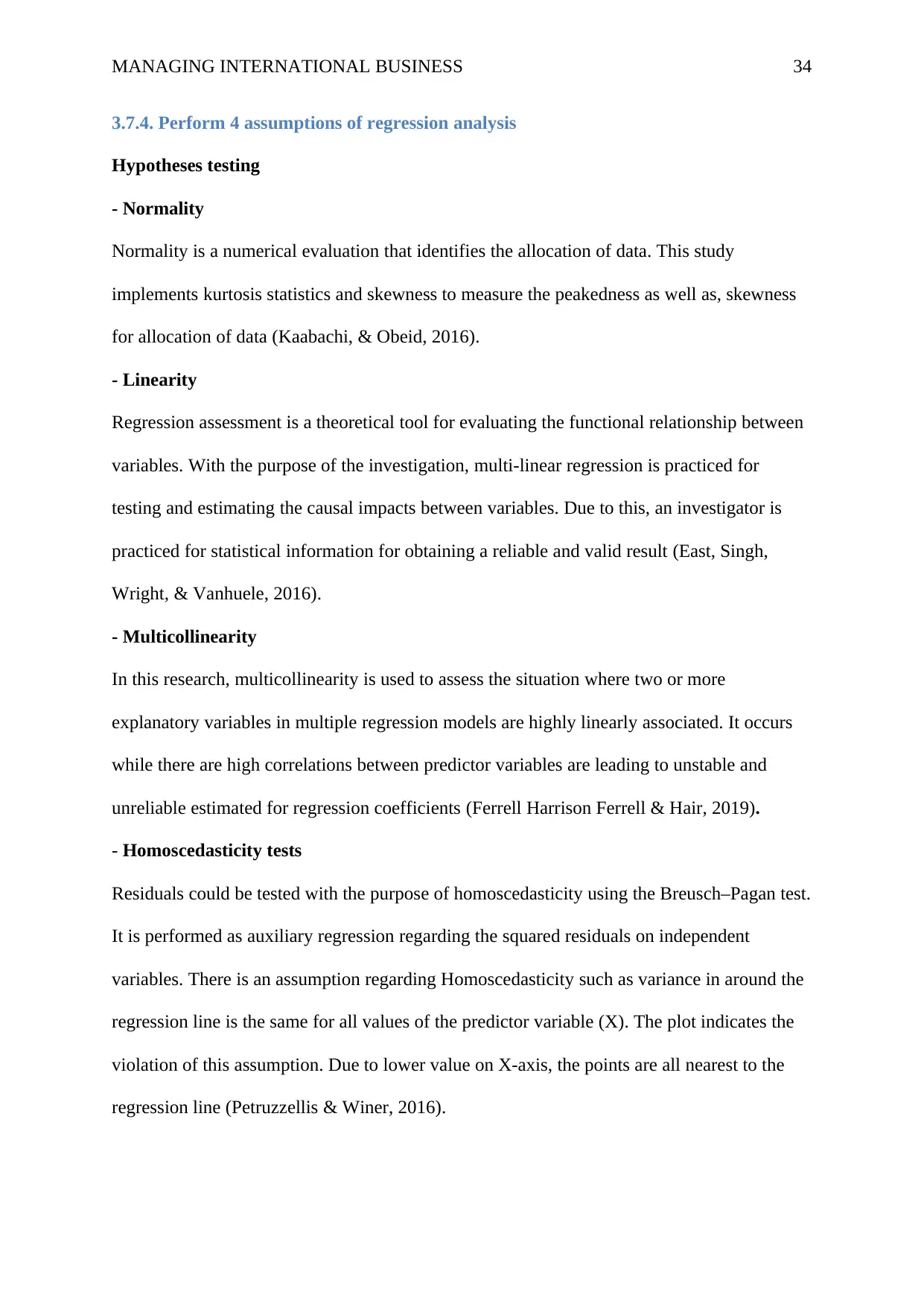
MANAGING INTERNATIONAL BUSINESS 34
3.7.4. Perform 4 assumptions of regression analysis
Hypotheses testing
- Normality
Normality is a numerical evaluation that identifies the allocation of data. This study
implements kurtosis statistics and skewness to measure the peakedness as well as, skewness
for allocation of data (Kaabachi, & Obeid, 2016).
- Linearity
Regression assessment is a theoretical tool for evaluating the functional relationship between
variables. With the purpose of the investigation, multi-linear regression is practiced for
testing and estimating the causal impacts between variables. Due to this, an investigator is
practiced for statistical information for obtaining a reliable and valid result (East, Singh,
Wright, & Vanhuele, 2016).
- Multicollinearity
In this research, multicollinearity is used to assess the situation where two or more
explanatory variables in multiple regression models are highly linearly associated. It occurs
while there are high correlations between predictor variables are leading to unstable and
unreliable estimated for regression coefficients (Ferrell Harrison Ferrell & Hair, 2019).
- Homoscedasticity tests
Residuals could be tested with the purpose of homoscedasticity using the Breusch–Pagan test.
It is performed as auxiliary regression regarding the squared residuals on independent
variables. There is an assumption regarding Homoscedasticity such as variance in around the
regression line is the same for all values of the predictor variable (X). The plot indicates the
violation of this assumption. Due to lower value on X-axis, the points are all nearest to the
regression line (Petruzzellis & Winer, 2016).
3.7.4. Perform 4 assumptions of regression analysis
Hypotheses testing
- Normality
Normality is a numerical evaluation that identifies the allocation of data. This study
implements kurtosis statistics and skewness to measure the peakedness as well as, skewness
for allocation of data (Kaabachi, & Obeid, 2016).
- Linearity
Regression assessment is a theoretical tool for evaluating the functional relationship between
variables. With the purpose of the investigation, multi-linear regression is practiced for
testing and estimating the causal impacts between variables. Due to this, an investigator is
practiced for statistical information for obtaining a reliable and valid result (East, Singh,
Wright, & Vanhuele, 2016).
- Multicollinearity
In this research, multicollinearity is used to assess the situation where two or more
explanatory variables in multiple regression models are highly linearly associated. It occurs
while there are high correlations between predictor variables are leading to unstable and
unreliable estimated for regression coefficients (Ferrell Harrison Ferrell & Hair, 2019).
- Homoscedasticity tests
Residuals could be tested with the purpose of homoscedasticity using the Breusch–Pagan test.
It is performed as auxiliary regression regarding the squared residuals on independent
variables. There is an assumption regarding Homoscedasticity such as variance in around the
regression line is the same for all values of the predictor variable (X). The plot indicates the
violation of this assumption. Due to lower value on X-axis, the points are all nearest to the
regression line (Petruzzellis & Winer, 2016).
Secure Best Marks with AI Grader
Need help grading? Try our AI Grader for instant feedback on your assignments.
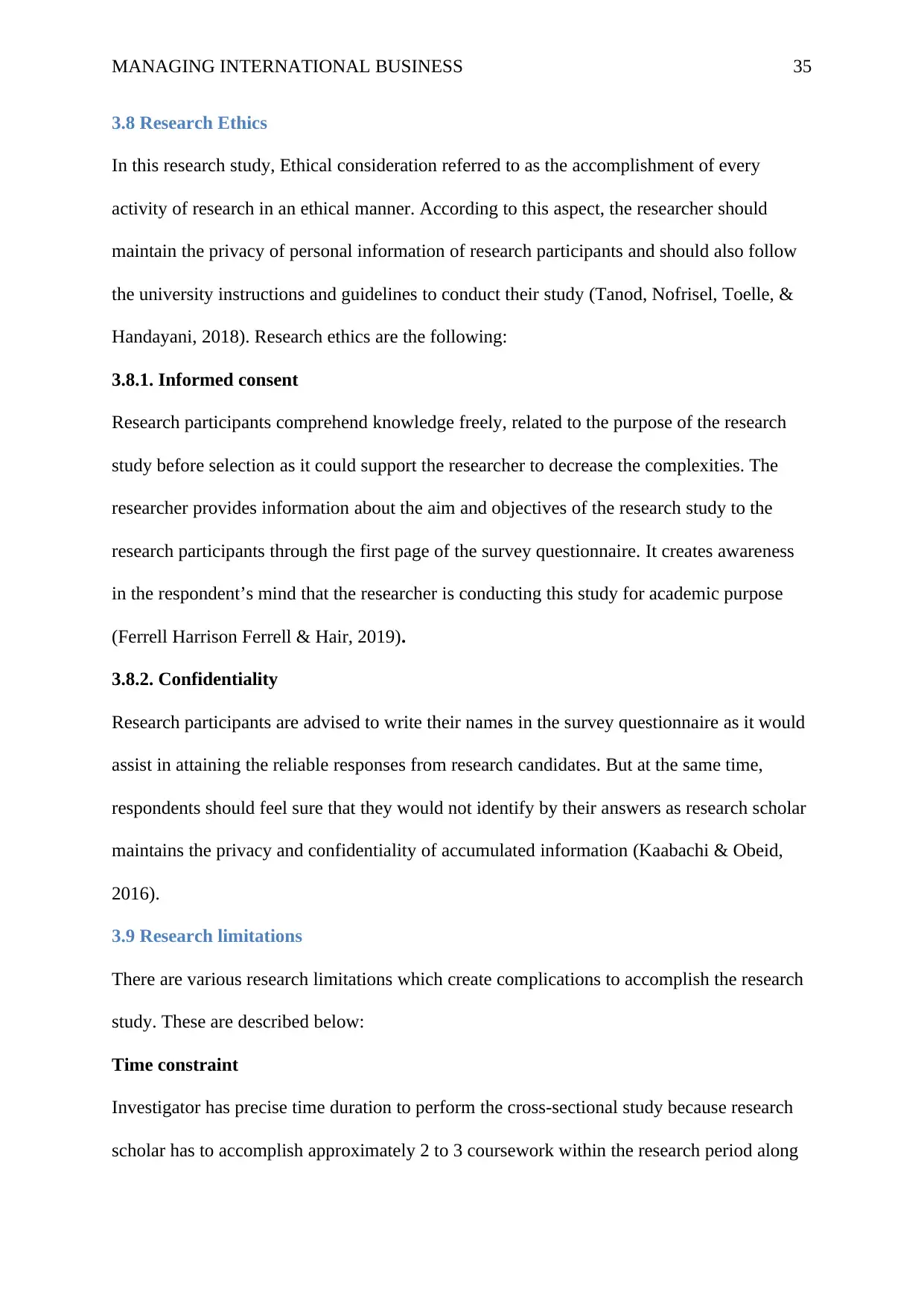
MANAGING INTERNATIONAL BUSINESS 35
3.8 Research Ethics
In this research study, Ethical consideration referred to as the accomplishment of every
activity of research in an ethical manner. According to this aspect, the researcher should
maintain the privacy of personal information of research participants and should also follow
the university instructions and guidelines to conduct their study (Tanod, Nofrisel, Toelle, &
Handayani, 2018). Research ethics are the following:
3.8.1. Informed consent
Research participants comprehend knowledge freely, related to the purpose of the research
study before selection as it could support the researcher to decrease the complexities. The
researcher provides information about the aim and objectives of the research study to the
research participants through the first page of the survey questionnaire. It creates awareness
in the respondent’s mind that the researcher is conducting this study for academic purpose
(Ferrell Harrison Ferrell & Hair, 2019).
3.8.2. Confidentiality
Research participants are advised to write their names in the survey questionnaire as it would
assist in attaining the reliable responses from research candidates. But at the same time,
respondents should feel sure that they would not identify by their answers as research scholar
maintains the privacy and confidentiality of accumulated information (Kaabachi & Obeid,
2016).
3.9 Research limitations
There are various research limitations which create complications to accomplish the research
study. These are described below:
Time constraint
Investigator has precise time duration to perform the cross-sectional study because research
scholar has to accomplish approximately 2 to 3 coursework within the research period along
3.8 Research Ethics
In this research study, Ethical consideration referred to as the accomplishment of every
activity of research in an ethical manner. According to this aspect, the researcher should
maintain the privacy of personal information of research participants and should also follow
the university instructions and guidelines to conduct their study (Tanod, Nofrisel, Toelle, &
Handayani, 2018). Research ethics are the following:
3.8.1. Informed consent
Research participants comprehend knowledge freely, related to the purpose of the research
study before selection as it could support the researcher to decrease the complexities. The
researcher provides information about the aim and objectives of the research study to the
research participants through the first page of the survey questionnaire. It creates awareness
in the respondent’s mind that the researcher is conducting this study for academic purpose
(Ferrell Harrison Ferrell & Hair, 2019).
3.8.2. Confidentiality
Research participants are advised to write their names in the survey questionnaire as it would
assist in attaining the reliable responses from research candidates. But at the same time,
respondents should feel sure that they would not identify by their answers as research scholar
maintains the privacy and confidentiality of accumulated information (Kaabachi & Obeid,
2016).
3.9 Research limitations
There are various research limitations which create complications to accomplish the research
study. These are described below:
Time constraint
Investigator has precise time duration to perform the cross-sectional study because research
scholar has to accomplish approximately 2 to 3 coursework within the research period along
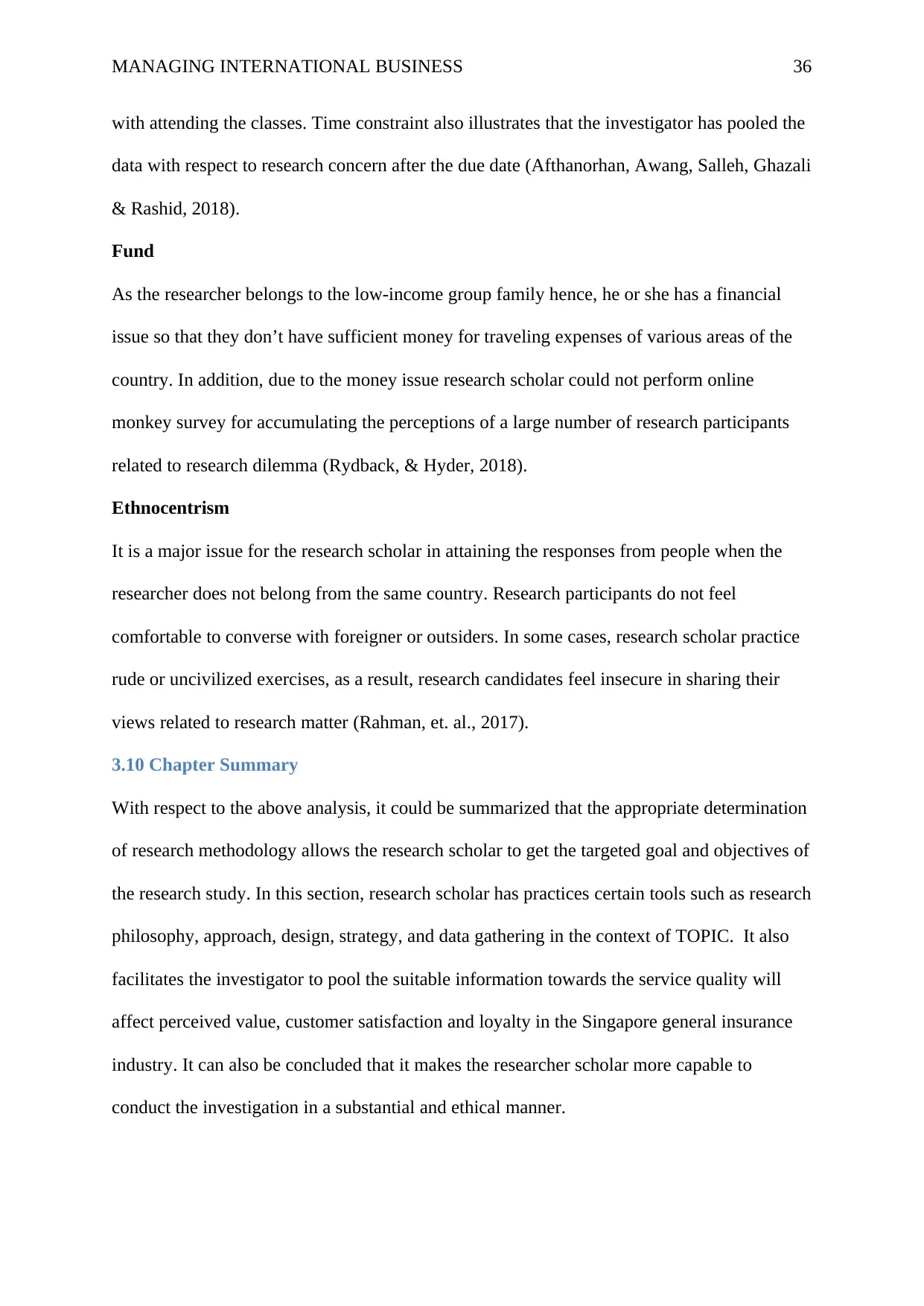
MANAGING INTERNATIONAL BUSINESS 36
with attending the classes. Time constraint also illustrates that the investigator has pooled the
data with respect to research concern after the due date (Afthanorhan, Awang, Salleh, Ghazali
& Rashid, 2018).
Fund
As the researcher belongs to the low-income group family hence, he or she has a financial
issue so that they don’t have sufficient money for traveling expenses of various areas of the
country. In addition, due to the money issue research scholar could not perform online
monkey survey for accumulating the perceptions of a large number of research participants
related to research dilemma (Rydback, & Hyder, 2018).
Ethnocentrism
It is a major issue for the research scholar in attaining the responses from people when the
researcher does not belong from the same country. Research participants do not feel
comfortable to converse with foreigner or outsiders. In some cases, research scholar practice
rude or uncivilized exercises, as a result, research candidates feel insecure in sharing their
views related to research matter (Rahman, et. al., 2017).
3.10 Chapter Summary
With respect to the above analysis, it could be summarized that the appropriate determination
of research methodology allows the research scholar to get the targeted goal and objectives of
the research study. In this section, research scholar has practices certain tools such as research
philosophy, approach, design, strategy, and data gathering in the context of TOPIC. It also
facilitates the investigator to pool the suitable information towards the service quality will
affect perceived value, customer satisfaction and loyalty in the Singapore general insurance
industry. It can also be concluded that it makes the researcher scholar more capable to
conduct the investigation in a substantial and ethical manner.
with attending the classes. Time constraint also illustrates that the investigator has pooled the
data with respect to research concern after the due date (Afthanorhan, Awang, Salleh, Ghazali
& Rashid, 2018).
Fund
As the researcher belongs to the low-income group family hence, he or she has a financial
issue so that they don’t have sufficient money for traveling expenses of various areas of the
country. In addition, due to the money issue research scholar could not perform online
monkey survey for accumulating the perceptions of a large number of research participants
related to research dilemma (Rydback, & Hyder, 2018).
Ethnocentrism
It is a major issue for the research scholar in attaining the responses from people when the
researcher does not belong from the same country. Research participants do not feel
comfortable to converse with foreigner or outsiders. In some cases, research scholar practice
rude or uncivilized exercises, as a result, research candidates feel insecure in sharing their
views related to research matter (Rahman, et. al., 2017).
3.10 Chapter Summary
With respect to the above analysis, it could be summarized that the appropriate determination
of research methodology allows the research scholar to get the targeted goal and objectives of
the research study. In this section, research scholar has practices certain tools such as research
philosophy, approach, design, strategy, and data gathering in the context of TOPIC. It also
facilitates the investigator to pool the suitable information towards the service quality will
affect perceived value, customer satisfaction and loyalty in the Singapore general insurance
industry. It can also be concluded that it makes the researcher scholar more capable to
conduct the investigation in a substantial and ethical manner.
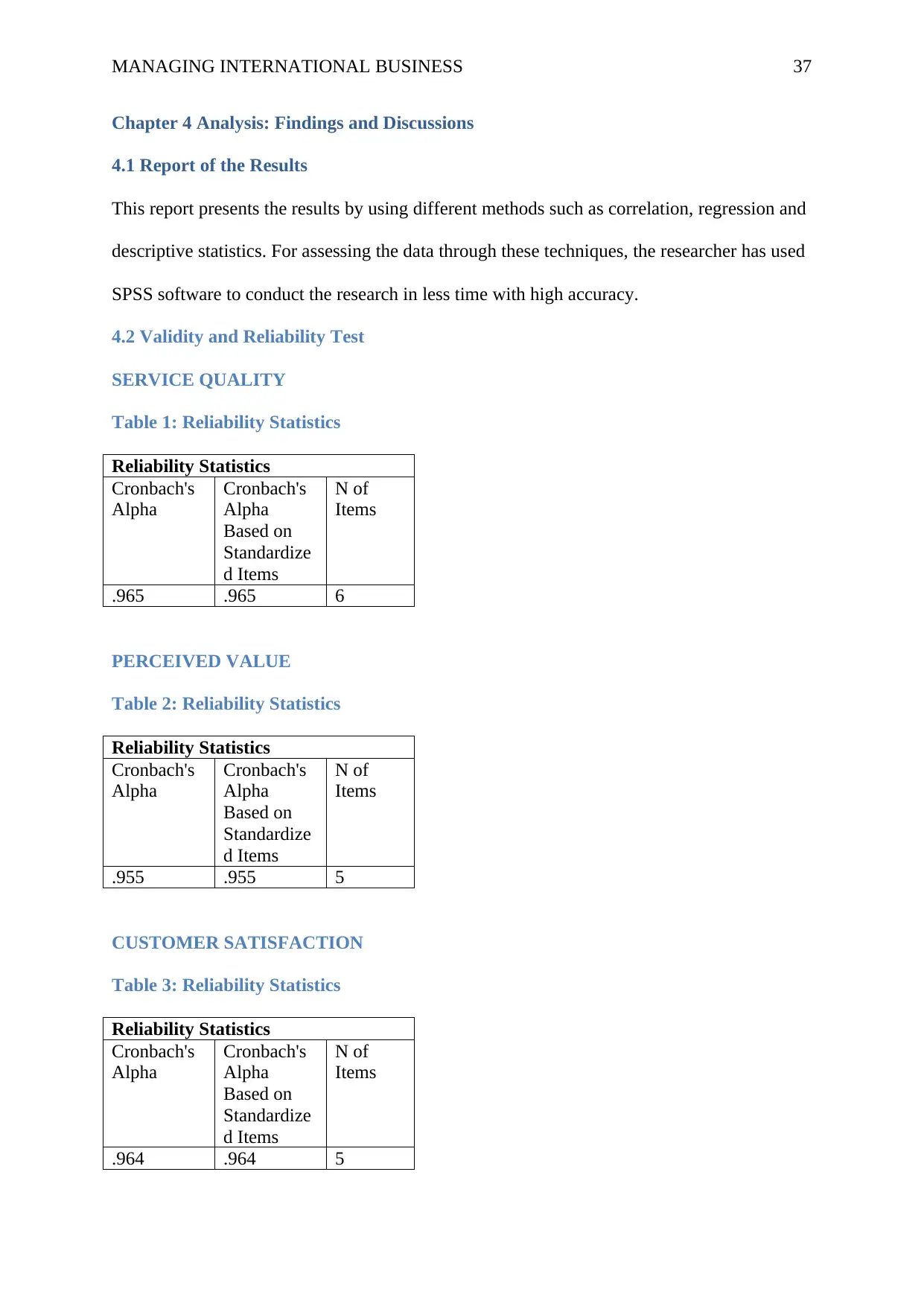
MANAGING INTERNATIONAL BUSINESS 37
Chapter 4 Analysis: Findings and Discussions
4.1 Report of the Results
This report presents the results by using different methods such as correlation, regression and
descriptive statistics. For assessing the data through these techniques, the researcher has used
SPSS software to conduct the research in less time with high accuracy.
4.2 Validity and Reliability Test
SERVICE QUALITY
Table 1: Reliability Statistics
Reliability Statistics
Cronbach's
Alpha
Cronbach's
Alpha
Based on
Standardize
d Items
N of
Items
.965 .965 6
PERCEIVED VALUE
Table 2: Reliability Statistics
Reliability Statistics
Cronbach's
Alpha
Cronbach's
Alpha
Based on
Standardize
d Items
N of
Items
.955 .955 5
CUSTOMER SATISFACTION
Table 3: Reliability Statistics
Reliability Statistics
Cronbach's
Alpha
Cronbach's
Alpha
Based on
Standardize
d Items
N of
Items
.964 .964 5
Chapter 4 Analysis: Findings and Discussions
4.1 Report of the Results
This report presents the results by using different methods such as correlation, regression and
descriptive statistics. For assessing the data through these techniques, the researcher has used
SPSS software to conduct the research in less time with high accuracy.
4.2 Validity and Reliability Test
SERVICE QUALITY
Table 1: Reliability Statistics
Reliability Statistics
Cronbach's
Alpha
Cronbach's
Alpha
Based on
Standardize
d Items
N of
Items
.965 .965 6
PERCEIVED VALUE
Table 2: Reliability Statistics
Reliability Statistics
Cronbach's
Alpha
Cronbach's
Alpha
Based on
Standardize
d Items
N of
Items
.955 .955 5
CUSTOMER SATISFACTION
Table 3: Reliability Statistics
Reliability Statistics
Cronbach's
Alpha
Cronbach's
Alpha
Based on
Standardize
d Items
N of
Items
.964 .964 5
Paraphrase This Document
Need a fresh take? Get an instant paraphrase of this document with our AI Paraphraser
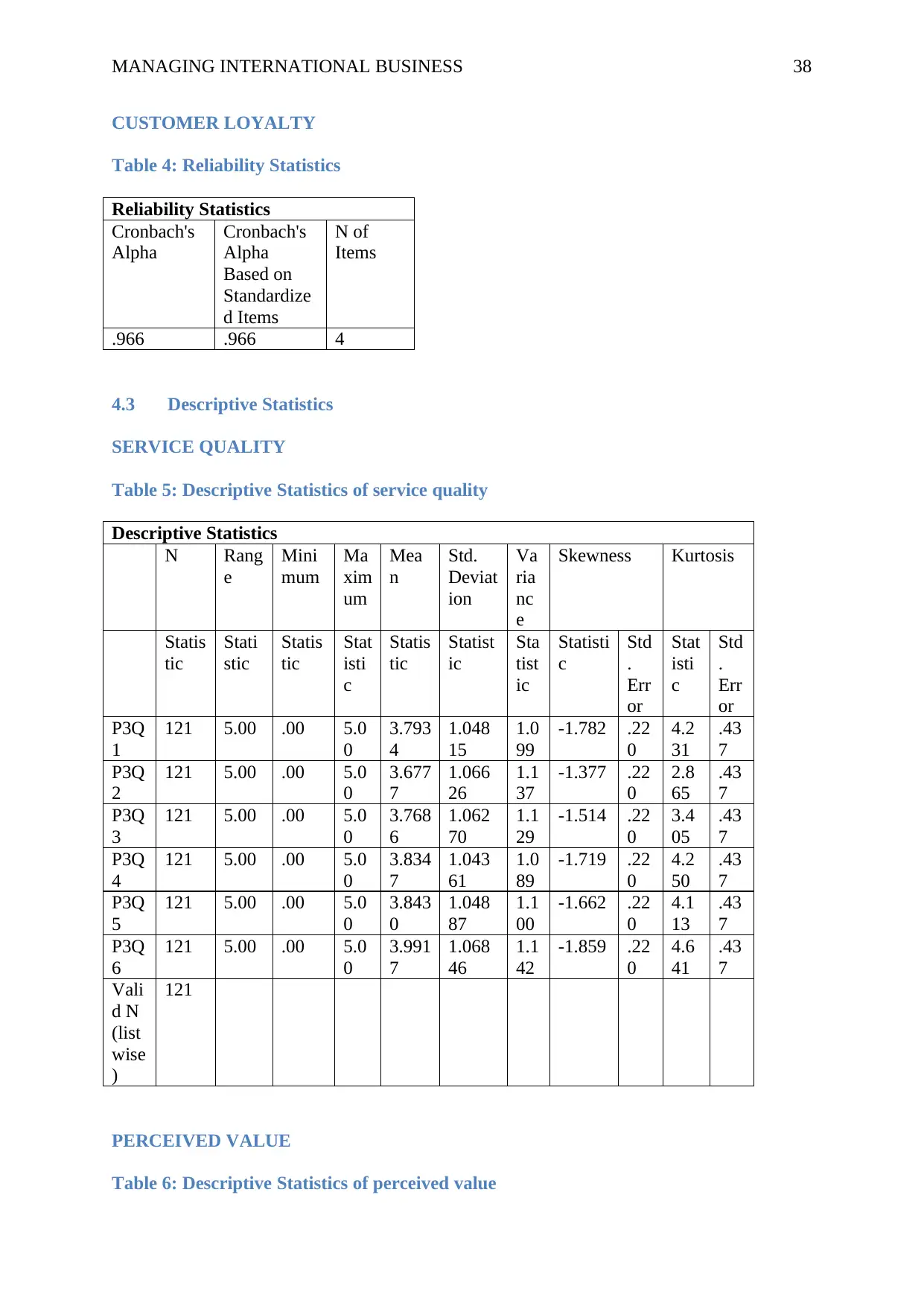
MANAGING INTERNATIONAL BUSINESS 38
CUSTOMER LOYALTY
Table 4: Reliability Statistics
Reliability Statistics
Cronbach's
Alpha
Cronbach's
Alpha
Based on
Standardize
d Items
N of
Items
.966 .966 4
4.3 Descriptive Statistics
SERVICE QUALITY
Table 5: Descriptive Statistics of service quality
Descriptive Statistics
N Rang
e
Mini
mum
Ma
xim
um
Mea
n
Std.
Deviat
ion
Va
ria
nc
e
Skewness Kurtosis
Statis
tic
Stati
stic
Statis
tic
Stat
isti
c
Statis
tic
Statist
ic
Sta
tist
ic
Statisti
c
Std
.
Err
or
Stat
isti
c
Std
.
Err
or
P3Q
1
121 5.00 .00 5.0
0
3.793
4
1.048
15
1.0
99
-1.782 .22
0
4.2
31
.43
7
P3Q
2
121 5.00 .00 5.0
0
3.677
7
1.066
26
1.1
37
-1.377 .22
0
2.8
65
.43
7
P3Q
3
121 5.00 .00 5.0
0
3.768
6
1.062
70
1.1
29
-1.514 .22
0
3.4
05
.43
7
P3Q
4
121 5.00 .00 5.0
0
3.834
7
1.043
61
1.0
89
-1.719 .22
0
4.2
50
.43
7
P3Q
5
121 5.00 .00 5.0
0
3.843
0
1.048
87
1.1
00
-1.662 .22
0
4.1
13
.43
7
P3Q
6
121 5.00 .00 5.0
0
3.991
7
1.068
46
1.1
42
-1.859 .22
0
4.6
41
.43
7
Vali
d N
(list
wise
)
121
PERCEIVED VALUE
Table 6: Descriptive Statistics of perceived value
CUSTOMER LOYALTY
Table 4: Reliability Statistics
Reliability Statistics
Cronbach's
Alpha
Cronbach's
Alpha
Based on
Standardize
d Items
N of
Items
.966 .966 4
4.3 Descriptive Statistics
SERVICE QUALITY
Table 5: Descriptive Statistics of service quality
Descriptive Statistics
N Rang
e
Mini
mum
Ma
xim
um
Mea
n
Std.
Deviat
ion
Va
ria
nc
e
Skewness Kurtosis
Statis
tic
Stati
stic
Statis
tic
Stat
isti
c
Statis
tic
Statist
ic
Sta
tist
ic
Statisti
c
Std
.
Err
or
Stat
isti
c
Std
.
Err
or
P3Q
1
121 5.00 .00 5.0
0
3.793
4
1.048
15
1.0
99
-1.782 .22
0
4.2
31
.43
7
P3Q
2
121 5.00 .00 5.0
0
3.677
7
1.066
26
1.1
37
-1.377 .22
0
2.8
65
.43
7
P3Q
3
121 5.00 .00 5.0
0
3.768
6
1.062
70
1.1
29
-1.514 .22
0
3.4
05
.43
7
P3Q
4
121 5.00 .00 5.0
0
3.834
7
1.043
61
1.0
89
-1.719 .22
0
4.2
50
.43
7
P3Q
5
121 5.00 .00 5.0
0
3.843
0
1.048
87
1.1
00
-1.662 .22
0
4.1
13
.43
7
P3Q
6
121 5.00 .00 5.0
0
3.991
7
1.068
46
1.1
42
-1.859 .22
0
4.6
41
.43
7
Vali
d N
(list
wise
)
121
PERCEIVED VALUE
Table 6: Descriptive Statistics of perceived value
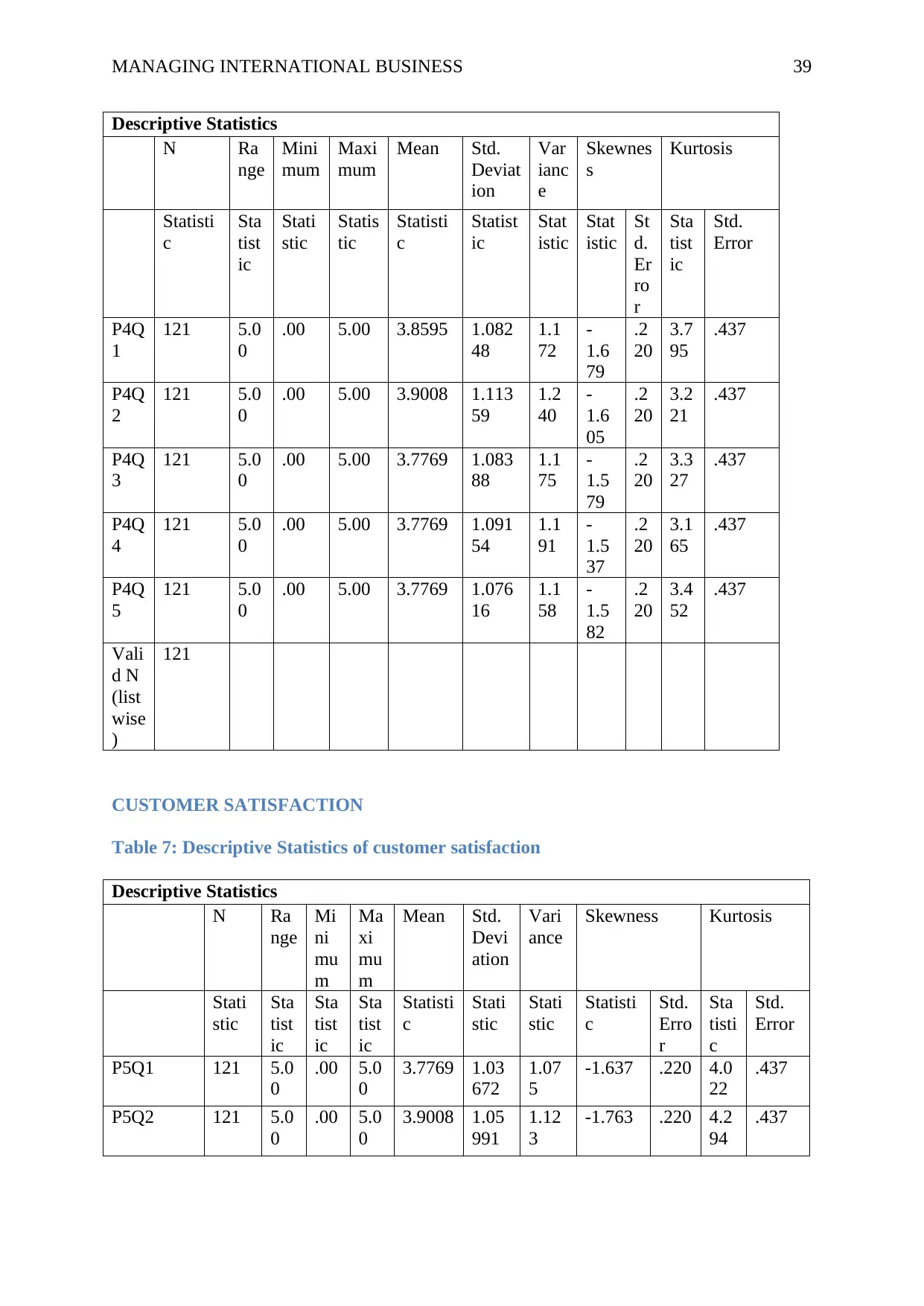
MANAGING INTERNATIONAL BUSINESS 39
Descriptive Statistics
N Ra
nge
Mini
mum
Maxi
mum
Mean Std.
Deviat
ion
Var
ianc
e
Skewnes
s
Kurtosis
Statisti
c
Sta
tist
ic
Stati
stic
Statis
tic
Statisti
c
Statist
ic
Stat
istic
Stat
istic
St
d.
Er
ro
r
Sta
tist
ic
Std.
Error
P4Q
1
121 5.0
0
.00 5.00 3.8595 1.082
48
1.1
72
-
1.6
79
.2
20
3.7
95
.437
P4Q
2
121 5.0
0
.00 5.00 3.9008 1.113
59
1.2
40
-
1.6
05
.2
20
3.2
21
.437
P4Q
3
121 5.0
0
.00 5.00 3.7769 1.083
88
1.1
75
-
1.5
79
.2
20
3.3
27
.437
P4Q
4
121 5.0
0
.00 5.00 3.7769 1.091
54
1.1
91
-
1.5
37
.2
20
3.1
65
.437
P4Q
5
121 5.0
0
.00 5.00 3.7769 1.076
16
1.1
58
-
1.5
82
.2
20
3.4
52
.437
Vali
d N
(list
wise
)
121
CUSTOMER SATISFACTION
Table 7: Descriptive Statistics of customer satisfaction
Descriptive Statistics
N Ra
nge
Mi
ni
mu
m
Ma
xi
mu
m
Mean Std.
Devi
ation
Vari
ance
Skewness Kurtosis
Stati
stic
Sta
tist
ic
Sta
tist
ic
Sta
tist
ic
Statisti
c
Stati
stic
Stati
stic
Statisti
c
Std.
Erro
r
Sta
tisti
c
Std.
Error
P5Q1 121 5.0
0
.00 5.0
0
3.7769 1.03
672
1.07
5
-1.637 .220 4.0
22
.437
P5Q2 121 5.0
0
.00 5.0
0
3.9008 1.05
991
1.12
3
-1.763 .220 4.2
94
.437
Descriptive Statistics
N Ra
nge
Mini
mum
Maxi
mum
Mean Std.
Deviat
ion
Var
ianc
e
Skewnes
s
Kurtosis
Statisti
c
Sta
tist
ic
Stati
stic
Statis
tic
Statisti
c
Statist
ic
Stat
istic
Stat
istic
St
d.
Er
ro
r
Sta
tist
ic
Std.
Error
P4Q
1
121 5.0
0
.00 5.00 3.8595 1.082
48
1.1
72
-
1.6
79
.2
20
3.7
95
.437
P4Q
2
121 5.0
0
.00 5.00 3.9008 1.113
59
1.2
40
-
1.6
05
.2
20
3.2
21
.437
P4Q
3
121 5.0
0
.00 5.00 3.7769 1.083
88
1.1
75
-
1.5
79
.2
20
3.3
27
.437
P4Q
4
121 5.0
0
.00 5.00 3.7769 1.091
54
1.1
91
-
1.5
37
.2
20
3.1
65
.437
P4Q
5
121 5.0
0
.00 5.00 3.7769 1.076
16
1.1
58
-
1.5
82
.2
20
3.4
52
.437
Vali
d N
(list
wise
)
121
CUSTOMER SATISFACTION
Table 7: Descriptive Statistics of customer satisfaction
Descriptive Statistics
N Ra
nge
Mi
ni
mu
m
Ma
xi
mu
m
Mean Std.
Devi
ation
Vari
ance
Skewness Kurtosis
Stati
stic
Sta
tist
ic
Sta
tist
ic
Sta
tist
ic
Statisti
c
Stati
stic
Stati
stic
Statisti
c
Std.
Erro
r
Sta
tisti
c
Std.
Error
P5Q1 121 5.0
0
.00 5.0
0
3.7769 1.03
672
1.07
5
-1.637 .220 4.0
22
.437
P5Q2 121 5.0
0
.00 5.0
0
3.9008 1.05
991
1.12
3
-1.763 .220 4.2
94
.437
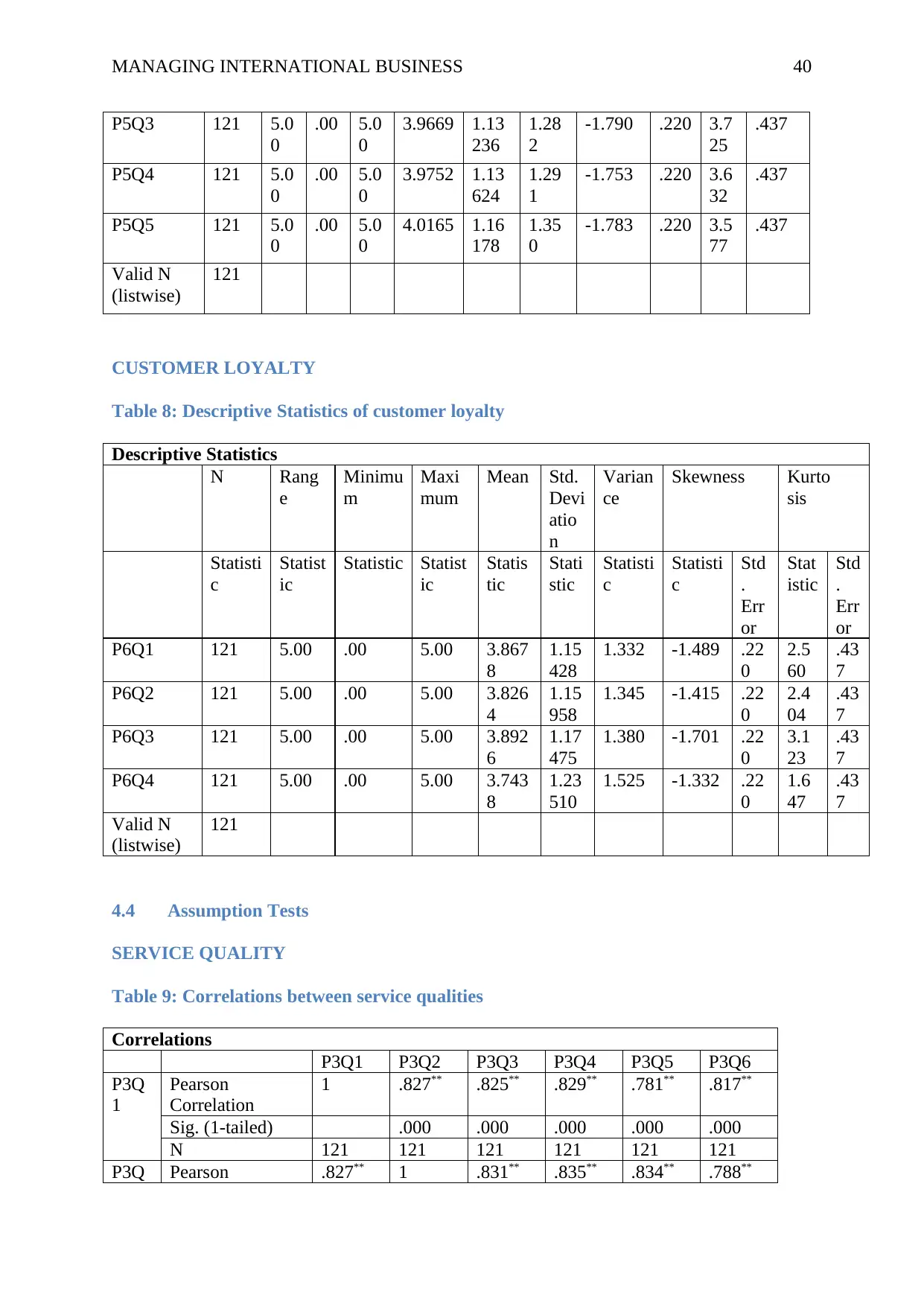
MANAGING INTERNATIONAL BUSINESS 40
P5Q3 121 5.0
0
.00 5.0
0
3.9669 1.13
236
1.28
2
-1.790 .220 3.7
25
.437
P5Q4 121 5.0
0
.00 5.0
0
3.9752 1.13
624
1.29
1
-1.753 .220 3.6
32
.437
P5Q5 121 5.0
0
.00 5.0
0
4.0165 1.16
178
1.35
0
-1.783 .220 3.5
77
.437
Valid N
(listwise)
121
CUSTOMER LOYALTY
Table 8: Descriptive Statistics of customer loyalty
Descriptive Statistics
N Rang
e
Minimu
m
Maxi
mum
Mean Std.
Devi
atio
n
Varian
ce
Skewness Kurto
sis
Statisti
c
Statist
ic
Statistic Statist
ic
Statis
tic
Stati
stic
Statisti
c
Statisti
c
Std
.
Err
or
Stat
istic
Std
.
Err
or
P6Q1 121 5.00 .00 5.00 3.867
8
1.15
428
1.332 -1.489 .22
0
2.5
60
.43
7
P6Q2 121 5.00 .00 5.00 3.826
4
1.15
958
1.345 -1.415 .22
0
2.4
04
.43
7
P6Q3 121 5.00 .00 5.00 3.892
6
1.17
475
1.380 -1.701 .22
0
3.1
23
.43
7
P6Q4 121 5.00 .00 5.00 3.743
8
1.23
510
1.525 -1.332 .22
0
1.6
47
.43
7
Valid N
(listwise)
121
4.4 Assumption Tests
SERVICE QUALITY
Table 9: Correlations between service qualities
Correlations
P3Q1 P3Q2 P3Q3 P3Q4 P3Q5 P3Q6
P3Q
1
Pearson
Correlation
1 .827** .825** .829** .781** .817**
Sig. (1-tailed) .000 .000 .000 .000 .000
N 121 121 121 121 121 121
P3Q Pearson .827** 1 .831** .835** .834** .788**
P5Q3 121 5.0
0
.00 5.0
0
3.9669 1.13
236
1.28
2
-1.790 .220 3.7
25
.437
P5Q4 121 5.0
0
.00 5.0
0
3.9752 1.13
624
1.29
1
-1.753 .220 3.6
32
.437
P5Q5 121 5.0
0
.00 5.0
0
4.0165 1.16
178
1.35
0
-1.783 .220 3.5
77
.437
Valid N
(listwise)
121
CUSTOMER LOYALTY
Table 8: Descriptive Statistics of customer loyalty
Descriptive Statistics
N Rang
e
Minimu
m
Maxi
mum
Mean Std.
Devi
atio
n
Varian
ce
Skewness Kurto
sis
Statisti
c
Statist
ic
Statistic Statist
ic
Statis
tic
Stati
stic
Statisti
c
Statisti
c
Std
.
Err
or
Stat
istic
Std
.
Err
or
P6Q1 121 5.00 .00 5.00 3.867
8
1.15
428
1.332 -1.489 .22
0
2.5
60
.43
7
P6Q2 121 5.00 .00 5.00 3.826
4
1.15
958
1.345 -1.415 .22
0
2.4
04
.43
7
P6Q3 121 5.00 .00 5.00 3.892
6
1.17
475
1.380 -1.701 .22
0
3.1
23
.43
7
P6Q4 121 5.00 .00 5.00 3.743
8
1.23
510
1.525 -1.332 .22
0
1.6
47
.43
7
Valid N
(listwise)
121
4.4 Assumption Tests
SERVICE QUALITY
Table 9: Correlations between service qualities
Correlations
P3Q1 P3Q2 P3Q3 P3Q4 P3Q5 P3Q6
P3Q
1
Pearson
Correlation
1 .827** .825** .829** .781** .817**
Sig. (1-tailed) .000 .000 .000 .000 .000
N 121 121 121 121 121 121
P3Q Pearson .827** 1 .831** .835** .834** .788**
Secure Best Marks with AI Grader
Need help grading? Try our AI Grader for instant feedback on your assignments.
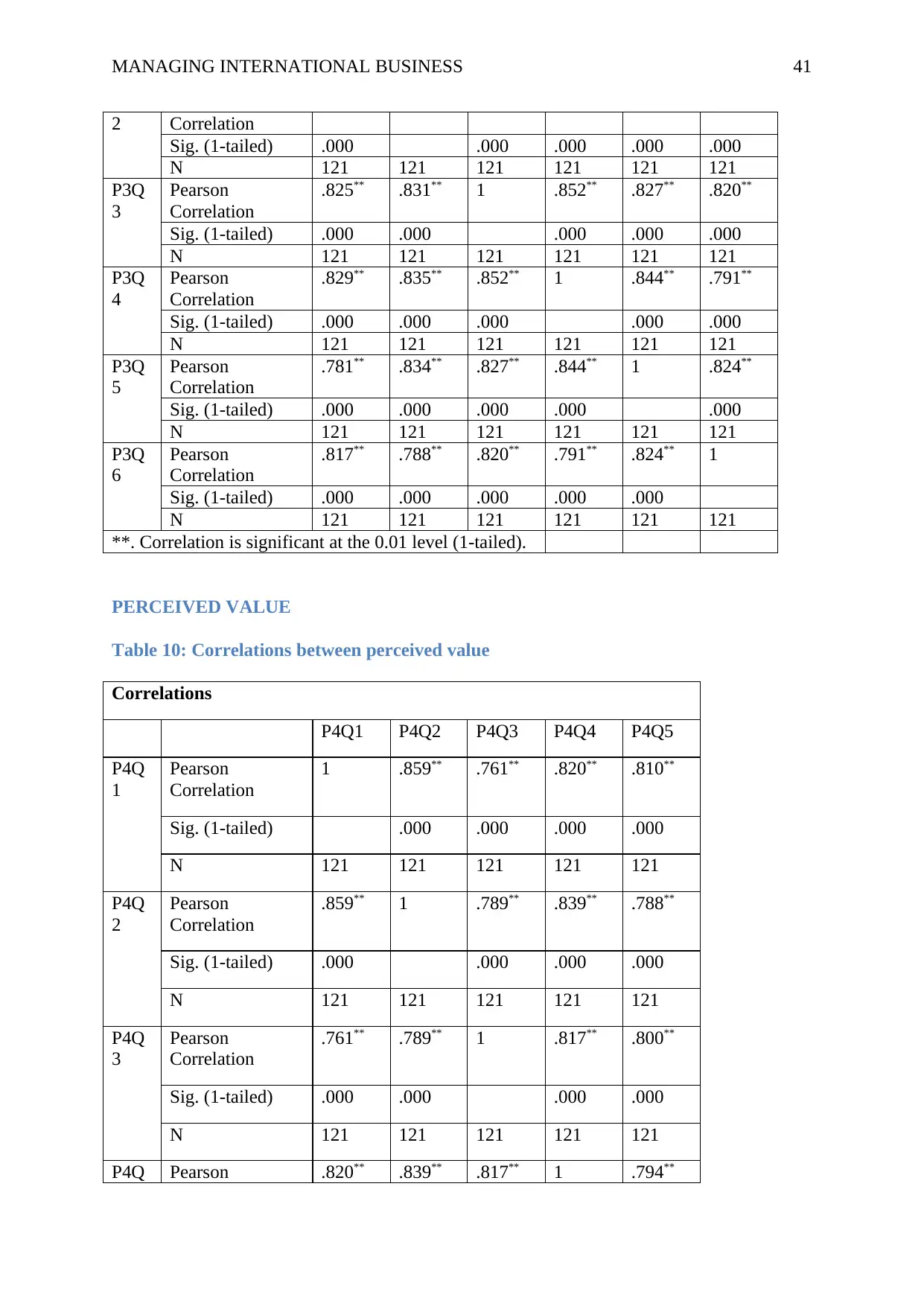
MANAGING INTERNATIONAL BUSINESS 41
2 Correlation
Sig. (1-tailed) .000 .000 .000 .000 .000
N 121 121 121 121 121 121
P3Q
3
Pearson
Correlation
.825** .831** 1 .852** .827** .820**
Sig. (1-tailed) .000 .000 .000 .000 .000
N 121 121 121 121 121 121
P3Q
4
Pearson
Correlation
.829** .835** .852** 1 .844** .791**
Sig. (1-tailed) .000 .000 .000 .000 .000
N 121 121 121 121 121 121
P3Q
5
Pearson
Correlation
.781** .834** .827** .844** 1 .824**
Sig. (1-tailed) .000 .000 .000 .000 .000
N 121 121 121 121 121 121
P3Q
6
Pearson
Correlation
.817** .788** .820** .791** .824** 1
Sig. (1-tailed) .000 .000 .000 .000 .000
N 121 121 121 121 121 121
**. Correlation is significant at the 0.01 level (1-tailed).
PERCEIVED VALUE
Table 10: Correlations between perceived value
Correlations
P4Q1 P4Q2 P4Q3 P4Q4 P4Q5
P4Q
1
Pearson
Correlation
1 .859** .761** .820** .810**
Sig. (1-tailed) .000 .000 .000 .000
N 121 121 121 121 121
P4Q
2
Pearson
Correlation
.859** 1 .789** .839** .788**
Sig. (1-tailed) .000 .000 .000 .000
N 121 121 121 121 121
P4Q
3
Pearson
Correlation
.761** .789** 1 .817** .800**
Sig. (1-tailed) .000 .000 .000 .000
N 121 121 121 121 121
P4Q Pearson .820** .839** .817** 1 .794**
2 Correlation
Sig. (1-tailed) .000 .000 .000 .000 .000
N 121 121 121 121 121 121
P3Q
3
Pearson
Correlation
.825** .831** 1 .852** .827** .820**
Sig. (1-tailed) .000 .000 .000 .000 .000
N 121 121 121 121 121 121
P3Q
4
Pearson
Correlation
.829** .835** .852** 1 .844** .791**
Sig. (1-tailed) .000 .000 .000 .000 .000
N 121 121 121 121 121 121
P3Q
5
Pearson
Correlation
.781** .834** .827** .844** 1 .824**
Sig. (1-tailed) .000 .000 .000 .000 .000
N 121 121 121 121 121 121
P3Q
6
Pearson
Correlation
.817** .788** .820** .791** .824** 1
Sig. (1-tailed) .000 .000 .000 .000 .000
N 121 121 121 121 121 121
**. Correlation is significant at the 0.01 level (1-tailed).
PERCEIVED VALUE
Table 10: Correlations between perceived value
Correlations
P4Q1 P4Q2 P4Q3 P4Q4 P4Q5
P4Q
1
Pearson
Correlation
1 .859** .761** .820** .810**
Sig. (1-tailed) .000 .000 .000 .000
N 121 121 121 121 121
P4Q
2
Pearson
Correlation
.859** 1 .789** .839** .788**
Sig. (1-tailed) .000 .000 .000 .000
N 121 121 121 121 121
P4Q
3
Pearson
Correlation
.761** .789** 1 .817** .800**
Sig. (1-tailed) .000 .000 .000 .000
N 121 121 121 121 121
P4Q Pearson .820** .839** .817** 1 .794**

MANAGING INTERNATIONAL BUSINESS 42
4 Correlation
Sig. (1-tailed) .000 .000 .000 .000
N 121 121 121 121 121
P4Q
5
Pearson
Correlation
.810** .788** .800** .794** 1
Sig. (1-tailed) .000 .000 .000 .000
N 121 121 121 121 121
**. Correlation is significant at the 0.01 level (1-tailed).
CUSTOMER SATISFACTION
Table 11: Correlations between customer satisfaction
Correlations
P5Q1 P5Q2 P5Q3 P5Q4 P5Q5
P5Q
1
Pearson
Correlation
1 .829** .817** .788** .785**
Sig. (1-tailed) .000 .000 .000 .000
N 121 121 121 121 121
P5Q
2
Pearson
Correlation
.829** 1 .893** .842** .841**
Sig. (1-tailed) .000 .000 .000 .000
N 121 121 121 121 121
P5Q
3
Pearson
Correlation
.817** .893** 1 .861** .875**
Sig. (1-tailed) .000 .000 .000 .000
N 121 121 121 121 121
P5Q
4
Pearson
Correlation
.788** .842** .861** 1 .909**
Sig. (1-tailed) .000 .000 .000 .000
N 121 121 121 121 121
P5Q
5
Pearson
Correlation
.785** .841** .875** .909** 1
Sig. (1-tailed) .000 .000 .000 .000
N 121 121 121 121 121
**. Correlation is significant at the 0.01 level (1-tailed).
CUSTOMER LOYALTY
Table 12: Correlations between customer loyalties
Correlations
4 Correlation
Sig. (1-tailed) .000 .000 .000 .000
N 121 121 121 121 121
P4Q
5
Pearson
Correlation
.810** .788** .800** .794** 1
Sig. (1-tailed) .000 .000 .000 .000
N 121 121 121 121 121
**. Correlation is significant at the 0.01 level (1-tailed).
CUSTOMER SATISFACTION
Table 11: Correlations between customer satisfaction
Correlations
P5Q1 P5Q2 P5Q3 P5Q4 P5Q5
P5Q
1
Pearson
Correlation
1 .829** .817** .788** .785**
Sig. (1-tailed) .000 .000 .000 .000
N 121 121 121 121 121
P5Q
2
Pearson
Correlation
.829** 1 .893** .842** .841**
Sig. (1-tailed) .000 .000 .000 .000
N 121 121 121 121 121
P5Q
3
Pearson
Correlation
.817** .893** 1 .861** .875**
Sig. (1-tailed) .000 .000 .000 .000
N 121 121 121 121 121
P5Q
4
Pearson
Correlation
.788** .842** .861** 1 .909**
Sig. (1-tailed) .000 .000 .000 .000
N 121 121 121 121 121
P5Q
5
Pearson
Correlation
.785** .841** .875** .909** 1
Sig. (1-tailed) .000 .000 .000 .000
N 121 121 121 121 121
**. Correlation is significant at the 0.01 level (1-tailed).
CUSTOMER LOYALTY
Table 12: Correlations between customer loyalties
Correlations
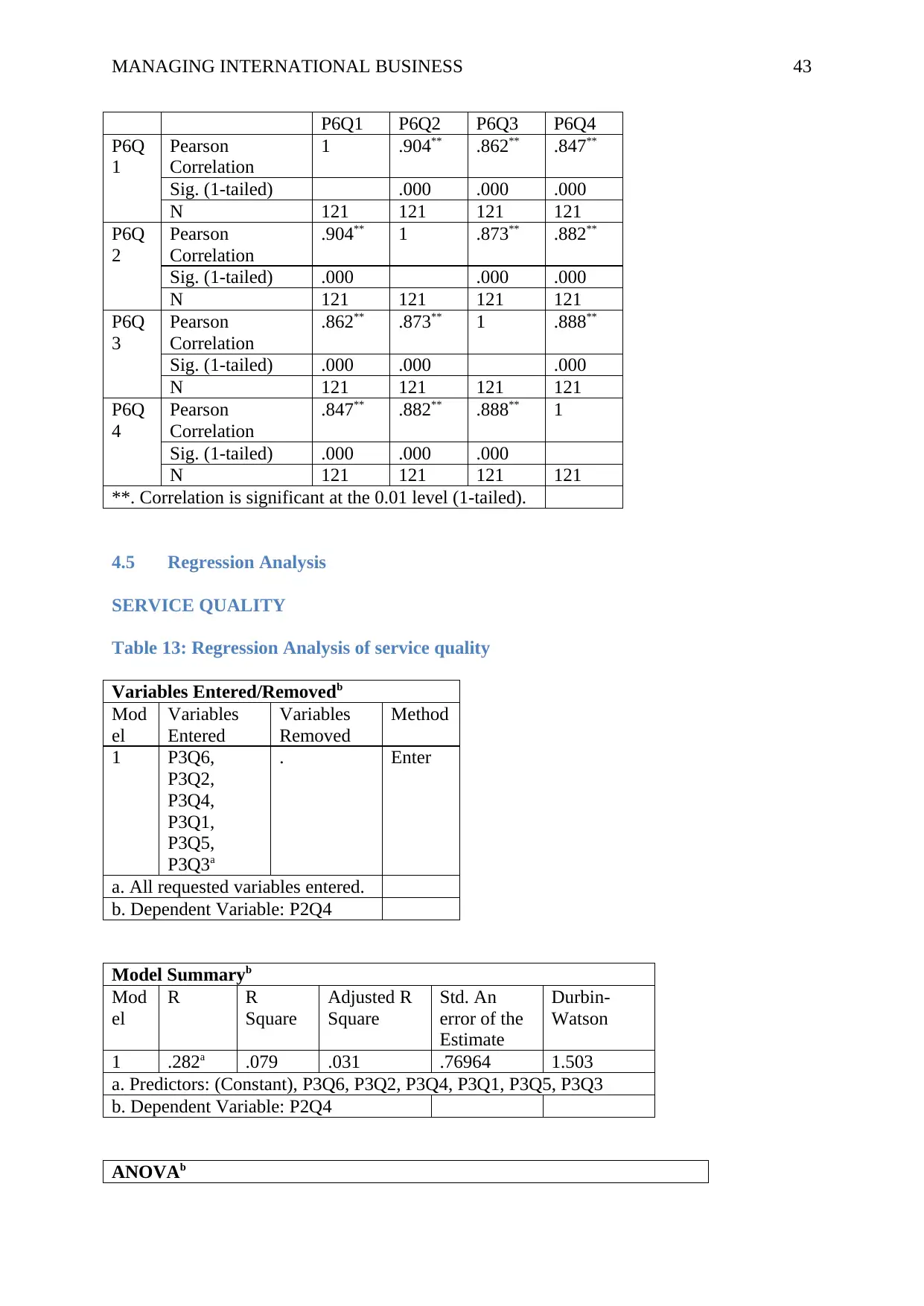
MANAGING INTERNATIONAL BUSINESS 43
P6Q1 P6Q2 P6Q3 P6Q4
P6Q
1
Pearson
Correlation
1 .904** .862** .847**
Sig. (1-tailed) .000 .000 .000
N 121 121 121 121
P6Q
2
Pearson
Correlation
.904** 1 .873** .882**
Sig. (1-tailed) .000 .000 .000
N 121 121 121 121
P6Q
3
Pearson
Correlation
.862** .873** 1 .888**
Sig. (1-tailed) .000 .000 .000
N 121 121 121 121
P6Q
4
Pearson
Correlation
.847** .882** .888** 1
Sig. (1-tailed) .000 .000 .000
N 121 121 121 121
**. Correlation is significant at the 0.01 level (1-tailed).
4.5 Regression Analysis
SERVICE QUALITY
Table 13: Regression Analysis of service quality
Variables Entered/Removedb
Mod
el
Variables
Entered
Variables
Removed
Method
1 P3Q6,
P3Q2,
P3Q4,
P3Q1,
P3Q5,
P3Q3a
. Enter
a. All requested variables entered.
b. Dependent Variable: P2Q4
Model Summaryb
Mod
el
R R
Square
Adjusted R
Square
Std. An
error of the
Estimate
Durbin-
Watson
1 .282a .079 .031 .76964 1.503
a. Predictors: (Constant), P3Q6, P3Q2, P3Q4, P3Q1, P3Q5, P3Q3
b. Dependent Variable: P2Q4
ANOVAb
P6Q1 P6Q2 P6Q3 P6Q4
P6Q
1
Pearson
Correlation
1 .904** .862** .847**
Sig. (1-tailed) .000 .000 .000
N 121 121 121 121
P6Q
2
Pearson
Correlation
.904** 1 .873** .882**
Sig. (1-tailed) .000 .000 .000
N 121 121 121 121
P6Q
3
Pearson
Correlation
.862** .873** 1 .888**
Sig. (1-tailed) .000 .000 .000
N 121 121 121 121
P6Q
4
Pearson
Correlation
.847** .882** .888** 1
Sig. (1-tailed) .000 .000 .000
N 121 121 121 121
**. Correlation is significant at the 0.01 level (1-tailed).
4.5 Regression Analysis
SERVICE QUALITY
Table 13: Regression Analysis of service quality
Variables Entered/Removedb
Mod
el
Variables
Entered
Variables
Removed
Method
1 P3Q6,
P3Q2,
P3Q4,
P3Q1,
P3Q5,
P3Q3a
. Enter
a. All requested variables entered.
b. Dependent Variable: P2Q4
Model Summaryb
Mod
el
R R
Square
Adjusted R
Square
Std. An
error of the
Estimate
Durbin-
Watson
1 .282a .079 .031 .76964 1.503
a. Predictors: (Constant), P3Q6, P3Q2, P3Q4, P3Q1, P3Q5, P3Q3
b. Dependent Variable: P2Q4
ANOVAb
Paraphrase This Document
Need a fresh take? Get an instant paraphrase of this document with our AI Paraphraser

MANAGING INTERNATIONAL BUSINESS 44
Model Sum of
Squares
df Mean
Square
F Sig.
1 Regressio
n
5.812 6 .969 1.635 .144a
Residual 67.527 114 .592
Total 73.339 120
a. Predictors: (Constant), P3Q6, P3Q2, P3Q4, P3Q1, P3Q5, P3Q3
b. Dependent Variable: P2Q4
Coefficientsa
Model Unstandardized
Coefficients
Standardize
d
Coefficient
s
t Sig. Collinearity
Statistics
B Std. Error Beta Toleran
ce
VIF
1 (Constant
)
.864 .287 3.007 .003
P3Q1 .185 .146 .248 1.270 .207 .212 4.725
P3Q2 -.129 .146 -.176 -.883 .379 .203 4.926
P3Q3 -.002 .152 -.003 -.015 .988 .189 5.283
P3Q4 -.139 .157 -.185 -.882 .380 .183 5.468
P3Q5 .212 .151 .285 1.402 .164 .196 5.108
P3Q6 .055 .138 .076 .403 .688 .228 4.376
a. Dependent Variable:
P2Q4
Residuals Statisticsa
Minimu
m
Maximu
m
Mean Std.
Deviation
N
Predicted Value .8637 1.9904 1.5868 .22008 121
Residual -.90528 1.61848 .00000 .75015 121
Std. Predicted
Value
-3.285 1.834 .000 1.000 121
Std. Residual -1.176 2.103 .000 .975 121
a. Dependent Variable: P2Q4
PERCEIVED VALUE
Table 14: Regression Analysis of perceived value
Variables Entered/Removedb
Mod
el
Variables
Entered
Variables
Removed
Method
1 P4Q5,
P4Q2,
. Enter
Model Sum of
Squares
df Mean
Square
F Sig.
1 Regressio
n
5.812 6 .969 1.635 .144a
Residual 67.527 114 .592
Total 73.339 120
a. Predictors: (Constant), P3Q6, P3Q2, P3Q4, P3Q1, P3Q5, P3Q3
b. Dependent Variable: P2Q4
Coefficientsa
Model Unstandardized
Coefficients
Standardize
d
Coefficient
s
t Sig. Collinearity
Statistics
B Std. Error Beta Toleran
ce
VIF
1 (Constant
)
.864 .287 3.007 .003
P3Q1 .185 .146 .248 1.270 .207 .212 4.725
P3Q2 -.129 .146 -.176 -.883 .379 .203 4.926
P3Q3 -.002 .152 -.003 -.015 .988 .189 5.283
P3Q4 -.139 .157 -.185 -.882 .380 .183 5.468
P3Q5 .212 .151 .285 1.402 .164 .196 5.108
P3Q6 .055 .138 .076 .403 .688 .228 4.376
a. Dependent Variable:
P2Q4
Residuals Statisticsa
Minimu
m
Maximu
m
Mean Std.
Deviation
N
Predicted Value .8637 1.9904 1.5868 .22008 121
Residual -.90528 1.61848 .00000 .75015 121
Std. Predicted
Value
-3.285 1.834 .000 1.000 121
Std. Residual -1.176 2.103 .000 .975 121
a. Dependent Variable: P2Q4
PERCEIVED VALUE
Table 14: Regression Analysis of perceived value
Variables Entered/Removedb
Mod
el
Variables
Entered
Variables
Removed
Method
1 P4Q5,
P4Q2,
. Enter
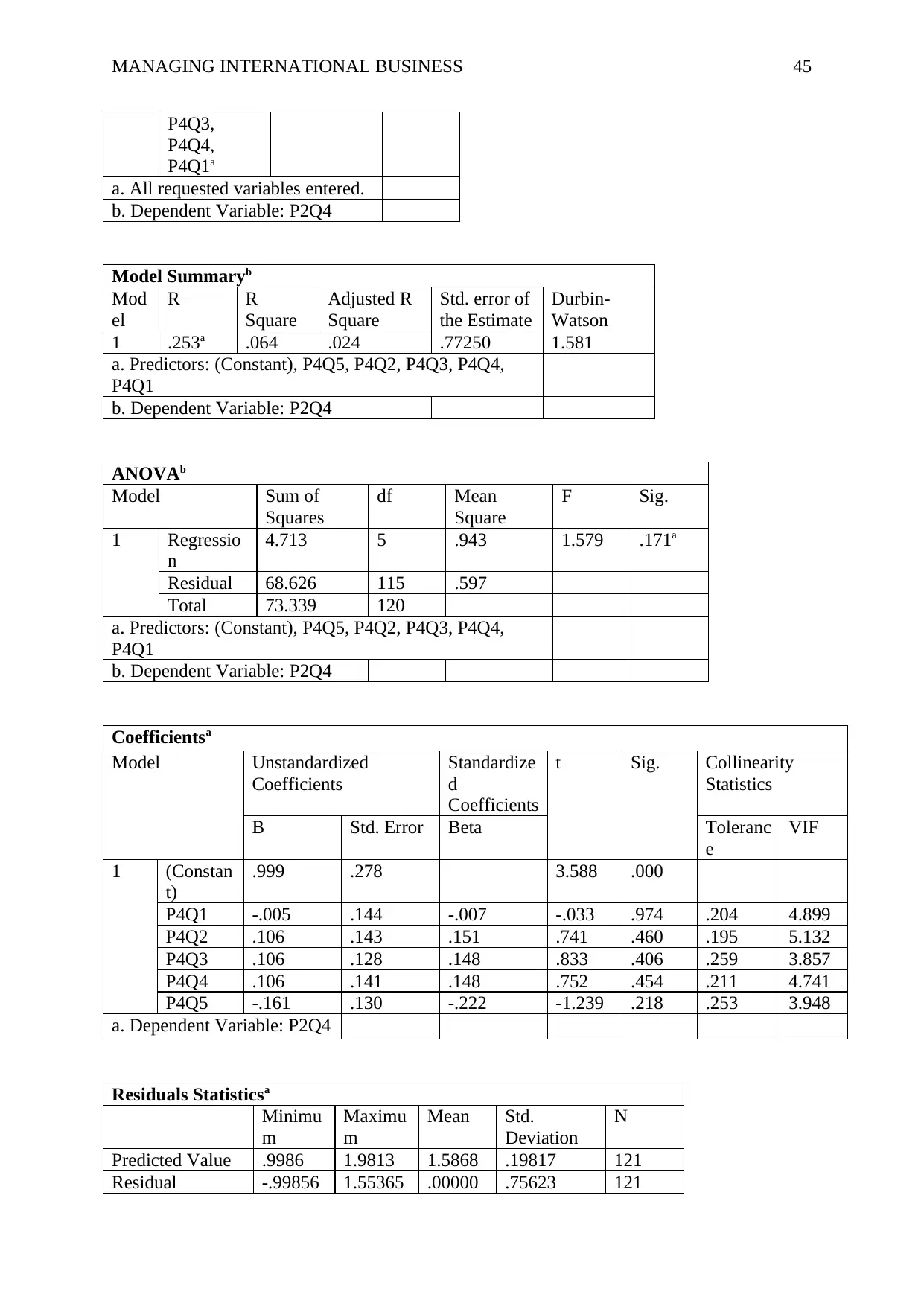
MANAGING INTERNATIONAL BUSINESS 45
P4Q3,
P4Q4,
P4Q1a
a. All requested variables entered.
b. Dependent Variable: P2Q4
Model Summaryb
Mod
el
R R
Square
Adjusted R
Square
Std. error of
the Estimate
Durbin-
Watson
1 .253a .064 .024 .77250 1.581
a. Predictors: (Constant), P4Q5, P4Q2, P4Q3, P4Q4,
P4Q1
b. Dependent Variable: P2Q4
ANOVAb
Model Sum of
Squares
df Mean
Square
F Sig.
1 Regressio
n
4.713 5 .943 1.579 .171a
Residual 68.626 115 .597
Total 73.339 120
a. Predictors: (Constant), P4Q5, P4Q2, P4Q3, P4Q4,
P4Q1
b. Dependent Variable: P2Q4
Coefficientsa
Model Unstandardized
Coefficients
Standardize
d
Coefficients
t Sig. Collinearity
Statistics
B Std. Error Beta Toleranc
e
VIF
1 (Constan
t)
.999 .278 3.588 .000
P4Q1 -.005 .144 -.007 -.033 .974 .204 4.899
P4Q2 .106 .143 .151 .741 .460 .195 5.132
P4Q3 .106 .128 .148 .833 .406 .259 3.857
P4Q4 .106 .141 .148 .752 .454 .211 4.741
P4Q5 -.161 .130 -.222 -1.239 .218 .253 3.948
a. Dependent Variable: P2Q4
Residuals Statisticsa
Minimu
m
Maximu
m
Mean Std.
Deviation
N
Predicted Value .9986 1.9813 1.5868 .19817 121
Residual -.99856 1.55365 .00000 .75623 121
P4Q3,
P4Q4,
P4Q1a
a. All requested variables entered.
b. Dependent Variable: P2Q4
Model Summaryb
Mod
el
R R
Square
Adjusted R
Square
Std. error of
the Estimate
Durbin-
Watson
1 .253a .064 .024 .77250 1.581
a. Predictors: (Constant), P4Q5, P4Q2, P4Q3, P4Q4,
P4Q1
b. Dependent Variable: P2Q4
ANOVAb
Model Sum of
Squares
df Mean
Square
F Sig.
1 Regressio
n
4.713 5 .943 1.579 .171a
Residual 68.626 115 .597
Total 73.339 120
a. Predictors: (Constant), P4Q5, P4Q2, P4Q3, P4Q4,
P4Q1
b. Dependent Variable: P2Q4
Coefficientsa
Model Unstandardized
Coefficients
Standardize
d
Coefficients
t Sig. Collinearity
Statistics
B Std. Error Beta Toleranc
e
VIF
1 (Constan
t)
.999 .278 3.588 .000
P4Q1 -.005 .144 -.007 -.033 .974 .204 4.899
P4Q2 .106 .143 .151 .741 .460 .195 5.132
P4Q3 .106 .128 .148 .833 .406 .259 3.857
P4Q4 .106 .141 .148 .752 .454 .211 4.741
P4Q5 -.161 .130 -.222 -1.239 .218 .253 3.948
a. Dependent Variable: P2Q4
Residuals Statisticsa
Minimu
m
Maximu
m
Mean Std.
Deviation
N
Predicted Value .9986 1.9813 1.5868 .19817 121
Residual -.99856 1.55365 .00000 .75623 121
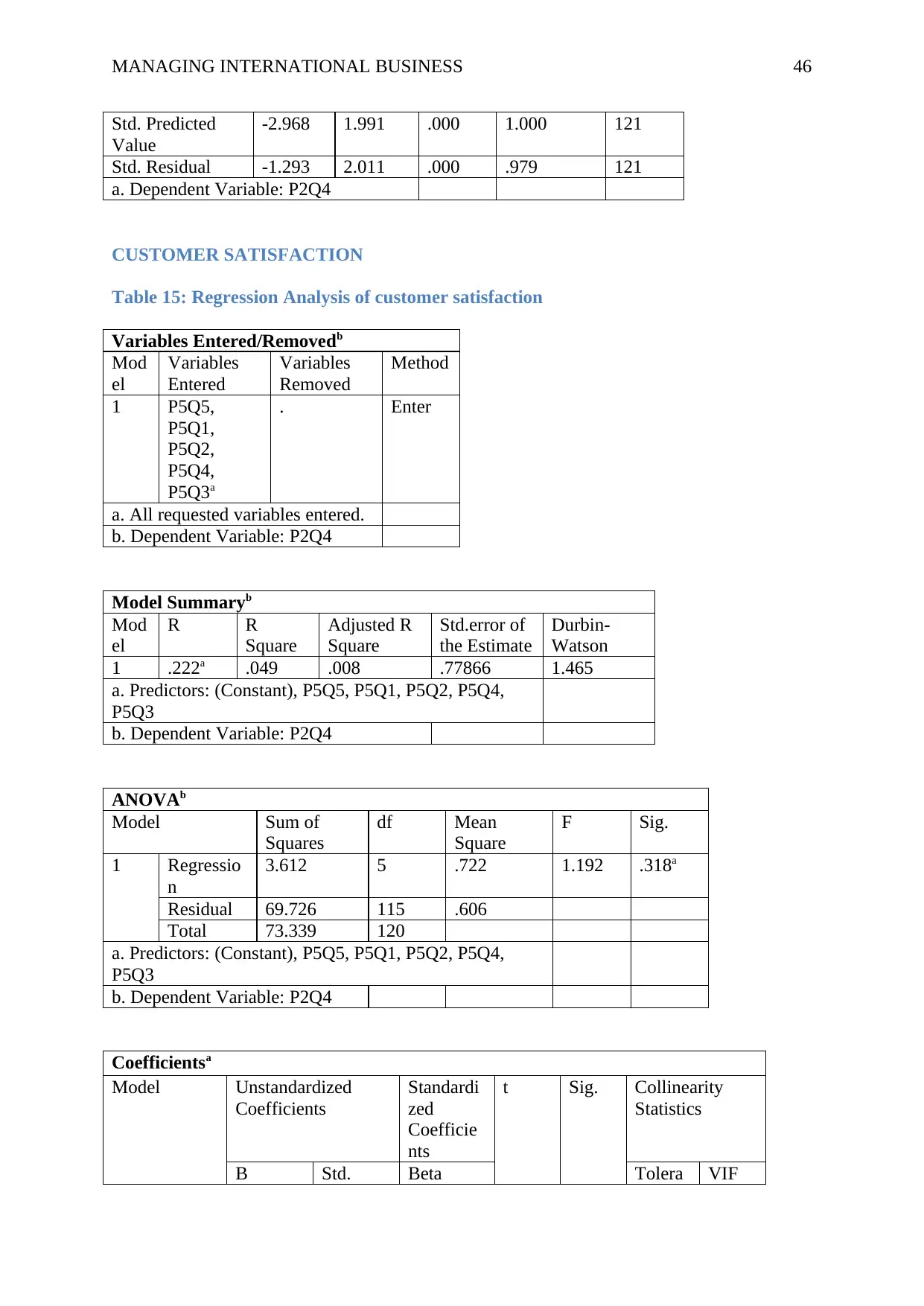
MANAGING INTERNATIONAL BUSINESS 46
Std. Predicted
Value
-2.968 1.991 .000 1.000 121
Std. Residual -1.293 2.011 .000 .979 121
a. Dependent Variable: P2Q4
CUSTOMER SATISFACTION
Table 15: Regression Analysis of customer satisfaction
Variables Entered/Removedb
Mod
el
Variables
Entered
Variables
Removed
Method
1 P5Q5,
P5Q1,
P5Q2,
P5Q4,
P5Q3a
. Enter
a. All requested variables entered.
b. Dependent Variable: P2Q4
Model Summaryb
Mod
el
R R
Square
Adjusted R
Square
Std.error of
the Estimate
Durbin-
Watson
1 .222a .049 .008 .77866 1.465
a. Predictors: (Constant), P5Q5, P5Q1, P5Q2, P5Q4,
P5Q3
b. Dependent Variable: P2Q4
ANOVAb
Model Sum of
Squares
df Mean
Square
F Sig.
1 Regressio
n
3.612 5 .722 1.192 .318a
Residual 69.726 115 .606
Total 73.339 120
a. Predictors: (Constant), P5Q5, P5Q1, P5Q2, P5Q4,
P5Q3
b. Dependent Variable: P2Q4
Coefficientsa
Model Unstandardized
Coefficients
Standardi
zed
Coefficie
nts
t Sig. Collinearity
Statistics
B Std. Beta Tolera VIF
Std. Predicted
Value
-2.968 1.991 .000 1.000 121
Std. Residual -1.293 2.011 .000 .979 121
a. Dependent Variable: P2Q4
CUSTOMER SATISFACTION
Table 15: Regression Analysis of customer satisfaction
Variables Entered/Removedb
Mod
el
Variables
Entered
Variables
Removed
Method
1 P5Q5,
P5Q1,
P5Q2,
P5Q4,
P5Q3a
. Enter
a. All requested variables entered.
b. Dependent Variable: P2Q4
Model Summaryb
Mod
el
R R
Square
Adjusted R
Square
Std.error of
the Estimate
Durbin-
Watson
1 .222a .049 .008 .77866 1.465
a. Predictors: (Constant), P5Q5, P5Q1, P5Q2, P5Q4,
P5Q3
b. Dependent Variable: P2Q4
ANOVAb
Model Sum of
Squares
df Mean
Square
F Sig.
1 Regressio
n
3.612 5 .722 1.192 .318a
Residual 69.726 115 .606
Total 73.339 120
a. Predictors: (Constant), P5Q5, P5Q1, P5Q2, P5Q4,
P5Q3
b. Dependent Variable: P2Q4
Coefficientsa
Model Unstandardized
Coefficients
Standardi
zed
Coefficie
nts
t Sig. Collinearity
Statistics
B Std. Beta Tolera VIF
Secure Best Marks with AI Grader
Need help grading? Try our AI Grader for instant feedback on your assignments.
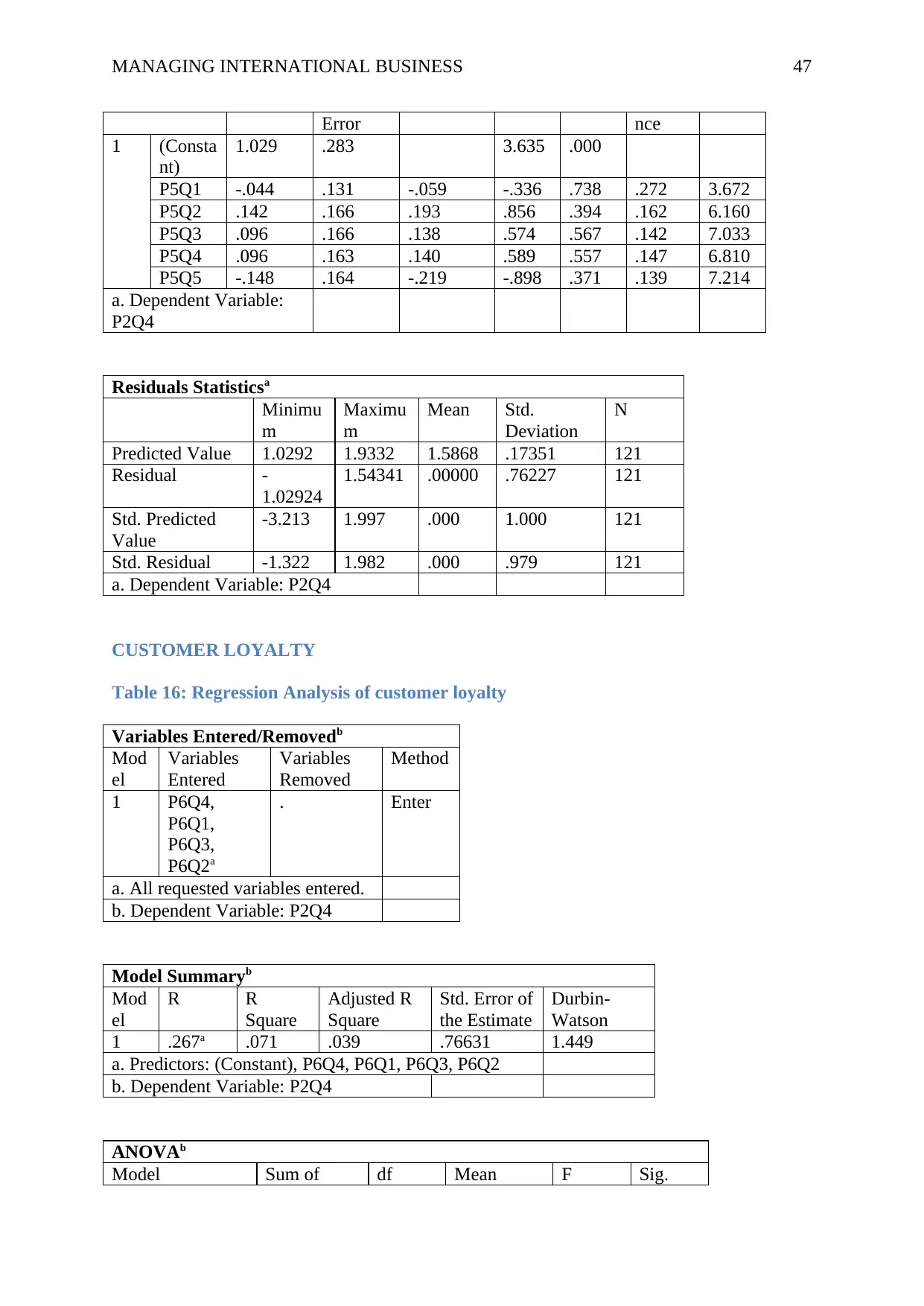
MANAGING INTERNATIONAL BUSINESS 47
Error nce
1 (Consta
nt)
1.029 .283 3.635 .000
P5Q1 -.044 .131 -.059 -.336 .738 .272 3.672
P5Q2 .142 .166 .193 .856 .394 .162 6.160
P5Q3 .096 .166 .138 .574 .567 .142 7.033
P5Q4 .096 .163 .140 .589 .557 .147 6.810
P5Q5 -.148 .164 -.219 -.898 .371 .139 7.214
a. Dependent Variable:
P2Q4
Residuals Statisticsa
Minimu
m
Maximu
m
Mean Std.
Deviation
N
Predicted Value 1.0292 1.9332 1.5868 .17351 121
Residual -
1.02924
1.54341 .00000 .76227 121
Std. Predicted
Value
-3.213 1.997 .000 1.000 121
Std. Residual -1.322 1.982 .000 .979 121
a. Dependent Variable: P2Q4
CUSTOMER LOYALTY
Table 16: Regression Analysis of customer loyalty
Variables Entered/Removedb
Mod
el
Variables
Entered
Variables
Removed
Method
1 P6Q4,
P6Q1,
P6Q3,
P6Q2a
. Enter
a. All requested variables entered.
b. Dependent Variable: P2Q4
Model Summaryb
Mod
el
R R
Square
Adjusted R
Square
Std. Error of
the Estimate
Durbin-
Watson
1 .267a .071 .039 .76631 1.449
a. Predictors: (Constant), P6Q4, P6Q1, P6Q3, P6Q2
b. Dependent Variable: P2Q4
ANOVAb
Model Sum of df Mean F Sig.
Error nce
1 (Consta
nt)
1.029 .283 3.635 .000
P5Q1 -.044 .131 -.059 -.336 .738 .272 3.672
P5Q2 .142 .166 .193 .856 .394 .162 6.160
P5Q3 .096 .166 .138 .574 .567 .142 7.033
P5Q4 .096 .163 .140 .589 .557 .147 6.810
P5Q5 -.148 .164 -.219 -.898 .371 .139 7.214
a. Dependent Variable:
P2Q4
Residuals Statisticsa
Minimu
m
Maximu
m
Mean Std.
Deviation
N
Predicted Value 1.0292 1.9332 1.5868 .17351 121
Residual -
1.02924
1.54341 .00000 .76227 121
Std. Predicted
Value
-3.213 1.997 .000 1.000 121
Std. Residual -1.322 1.982 .000 .979 121
a. Dependent Variable: P2Q4
CUSTOMER LOYALTY
Table 16: Regression Analysis of customer loyalty
Variables Entered/Removedb
Mod
el
Variables
Entered
Variables
Removed
Method
1 P6Q4,
P6Q1,
P6Q3,
P6Q2a
. Enter
a. All requested variables entered.
b. Dependent Variable: P2Q4
Model Summaryb
Mod
el
R R
Square
Adjusted R
Square
Std. Error of
the Estimate
Durbin-
Watson
1 .267a .071 .039 .76631 1.449
a. Predictors: (Constant), P6Q4, P6Q1, P6Q3, P6Q2
b. Dependent Variable: P2Q4
ANOVAb
Model Sum of df Mean F Sig.
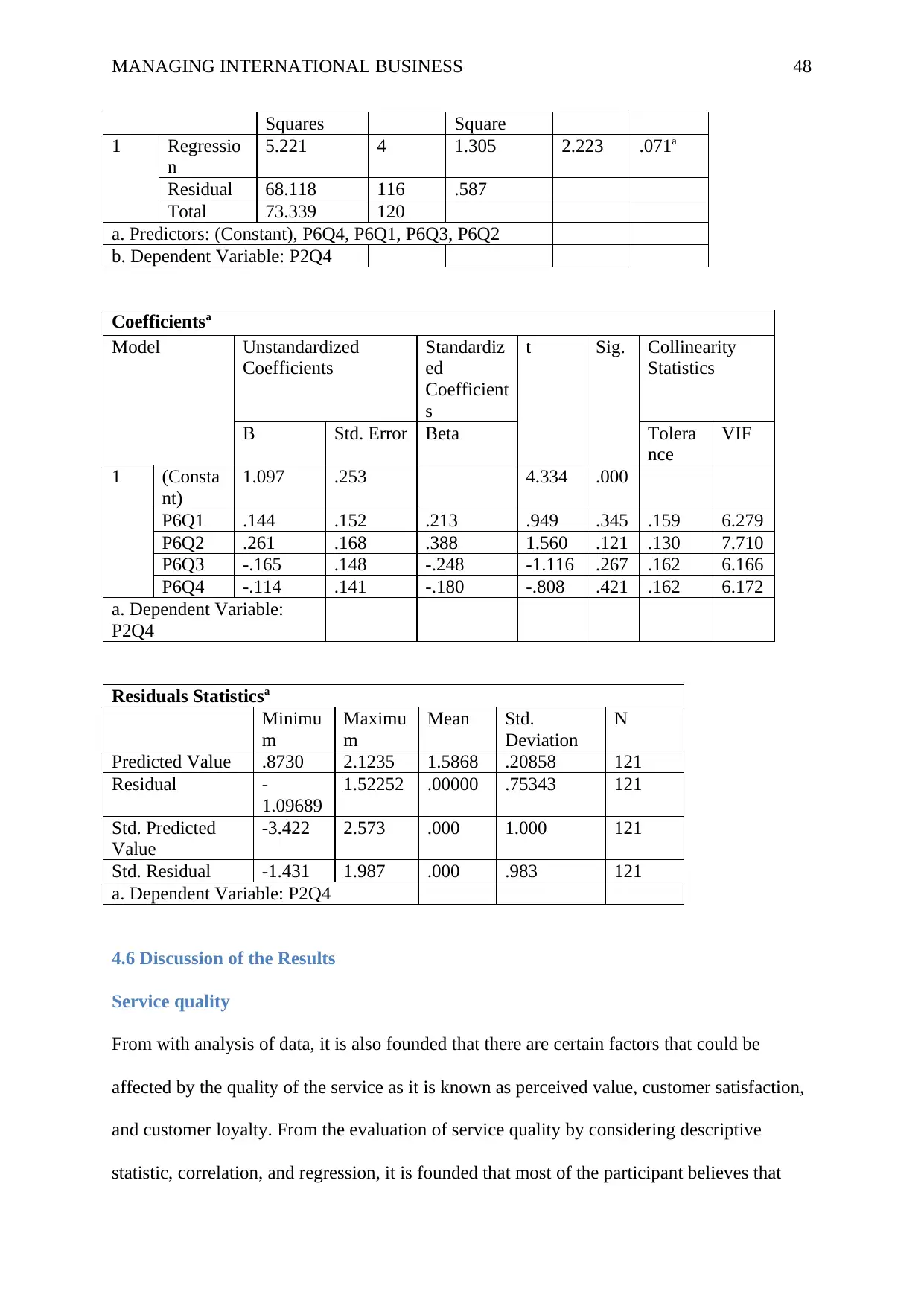
MANAGING INTERNATIONAL BUSINESS 48
Squares Square
1 Regressio
n
5.221 4 1.305 2.223 .071a
Residual 68.118 116 .587
Total 73.339 120
a. Predictors: (Constant), P6Q4, P6Q1, P6Q3, P6Q2
b. Dependent Variable: P2Q4
Coefficientsa
Model Unstandardized
Coefficients
Standardiz
ed
Coefficient
s
t Sig. Collinearity
Statistics
B Std. Error Beta Tolera
nce
VIF
1 (Consta
nt)
1.097 .253 4.334 .000
P6Q1 .144 .152 .213 .949 .345 .159 6.279
P6Q2 .261 .168 .388 1.560 .121 .130 7.710
P6Q3 -.165 .148 -.248 -1.116 .267 .162 6.166
P6Q4 -.114 .141 -.180 -.808 .421 .162 6.172
a. Dependent Variable:
P2Q4
Residuals Statisticsa
Minimu
m
Maximu
m
Mean Std.
Deviation
N
Predicted Value .8730 2.1235 1.5868 .20858 121
Residual -
1.09689
1.52252 .00000 .75343 121
Std. Predicted
Value
-3.422 2.573 .000 1.000 121
Std. Residual -1.431 1.987 .000 .983 121
a. Dependent Variable: P2Q4
4.6 Discussion of the Results
Service quality
From with analysis of data, it is also founded that there are certain factors that could be
affected by the quality of the service as it is known as perceived value, customer satisfaction,
and customer loyalty. From the evaluation of service quality by considering descriptive
statistic, correlation, and regression, it is founded that most of the participant believes that
Squares Square
1 Regressio
n
5.221 4 1.305 2.223 .071a
Residual 68.118 116 .587
Total 73.339 120
a. Predictors: (Constant), P6Q4, P6Q1, P6Q3, P6Q2
b. Dependent Variable: P2Q4
Coefficientsa
Model Unstandardized
Coefficients
Standardiz
ed
Coefficient
s
t Sig. Collinearity
Statistics
B Std. Error Beta Tolera
nce
VIF
1 (Consta
nt)
1.097 .253 4.334 .000
P6Q1 .144 .152 .213 .949 .345 .159 6.279
P6Q2 .261 .168 .388 1.560 .121 .130 7.710
P6Q3 -.165 .148 -.248 -1.116 .267 .162 6.166
P6Q4 -.114 .141 -.180 -.808 .421 .162 6.172
a. Dependent Variable:
P2Q4
Residuals Statisticsa
Minimu
m
Maximu
m
Mean Std.
Deviation
N
Predicted Value .8730 2.1235 1.5868 .20858 121
Residual -
1.09689
1.52252 .00000 .75343 121
Std. Predicted
Value
-3.422 2.573 .000 1.000 121
Std. Residual -1.431 1.987 .000 .983 121
a. Dependent Variable: P2Q4
4.6 Discussion of the Results
Service quality
From with analysis of data, it is also founded that there are certain factors that could be
affected by the quality of the service as it is known as perceived value, customer satisfaction,
and customer loyalty. From the evaluation of service quality by considering descriptive
statistic, correlation, and regression, it is founded that most of the participant believes that
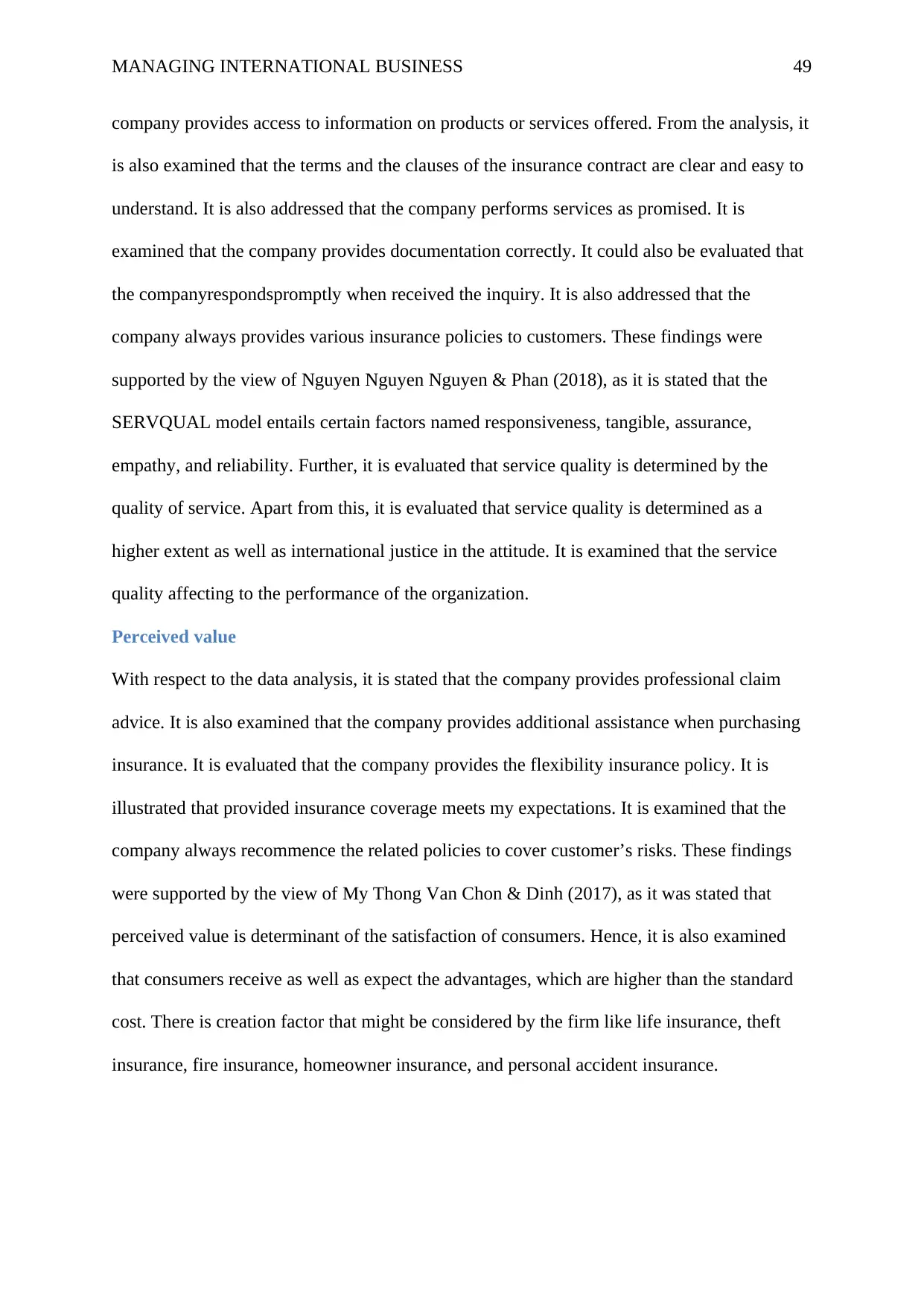
MANAGING INTERNATIONAL BUSINESS 49
company provides access to information on products or services offered. From the analysis, it
is also examined that the terms and the clauses of the insurance contract are clear and easy to
understand. It is also addressed that the company performs services as promised. It is
examined that the company provides documentation correctly. It could also be evaluated that
the companyrespondspromptly when received the inquiry. It is also addressed that the
company always provides various insurance policies to customers. These findings were
supported by the view of Nguyen Nguyen Nguyen & Phan (2018), as it is stated that the
SERVQUAL model entails certain factors named responsiveness, tangible, assurance,
empathy, and reliability. Further, it is evaluated that service quality is determined by the
quality of service. Apart from this, it is evaluated that service quality is determined as a
higher extent as well as international justice in the attitude. It is examined that the service
quality affecting to the performance of the organization.
Perceived value
With respect to the data analysis, it is stated that the company provides professional claim
advice. It is also examined that the company provides additional assistance when purchasing
insurance. It is evaluated that the company provides the flexibility insurance policy. It is
illustrated that provided insurance coverage meets my expectations. It is examined that the
company always recommence the related policies to cover customer’s risks. These findings
were supported by the view of My Thong Van Chon & Dinh (2017), as it was stated that
perceived value is determinant of the satisfaction of consumers. Hence, it is also examined
that consumers receive as well as expect the advantages, which are higher than the standard
cost. There is creation factor that might be considered by the firm like life insurance, theft
insurance, fire insurance, homeowner insurance, and personal accident insurance.
company provides access to information on products or services offered. From the analysis, it
is also examined that the terms and the clauses of the insurance contract are clear and easy to
understand. It is also addressed that the company performs services as promised. It is
examined that the company provides documentation correctly. It could also be evaluated that
the companyrespondspromptly when received the inquiry. It is also addressed that the
company always provides various insurance policies to customers. These findings were
supported by the view of Nguyen Nguyen Nguyen & Phan (2018), as it is stated that the
SERVQUAL model entails certain factors named responsiveness, tangible, assurance,
empathy, and reliability. Further, it is evaluated that service quality is determined by the
quality of service. Apart from this, it is evaluated that service quality is determined as a
higher extent as well as international justice in the attitude. It is examined that the service
quality affecting to the performance of the organization.
Perceived value
With respect to the data analysis, it is stated that the company provides professional claim
advice. It is also examined that the company provides additional assistance when purchasing
insurance. It is evaluated that the company provides the flexibility insurance policy. It is
illustrated that provided insurance coverage meets my expectations. It is examined that the
company always recommence the related policies to cover customer’s risks. These findings
were supported by the view of My Thong Van Chon & Dinh (2017), as it was stated that
perceived value is determinant of the satisfaction of consumers. Hence, it is also examined
that consumers receive as well as expect the advantages, which are higher than the standard
cost. There is creation factor that might be considered by the firm like life insurance, theft
insurance, fire insurance, homeowner insurance, and personal accident insurance.
Paraphrase This Document
Need a fresh take? Get an instant paraphrase of this document with our AI Paraphraser
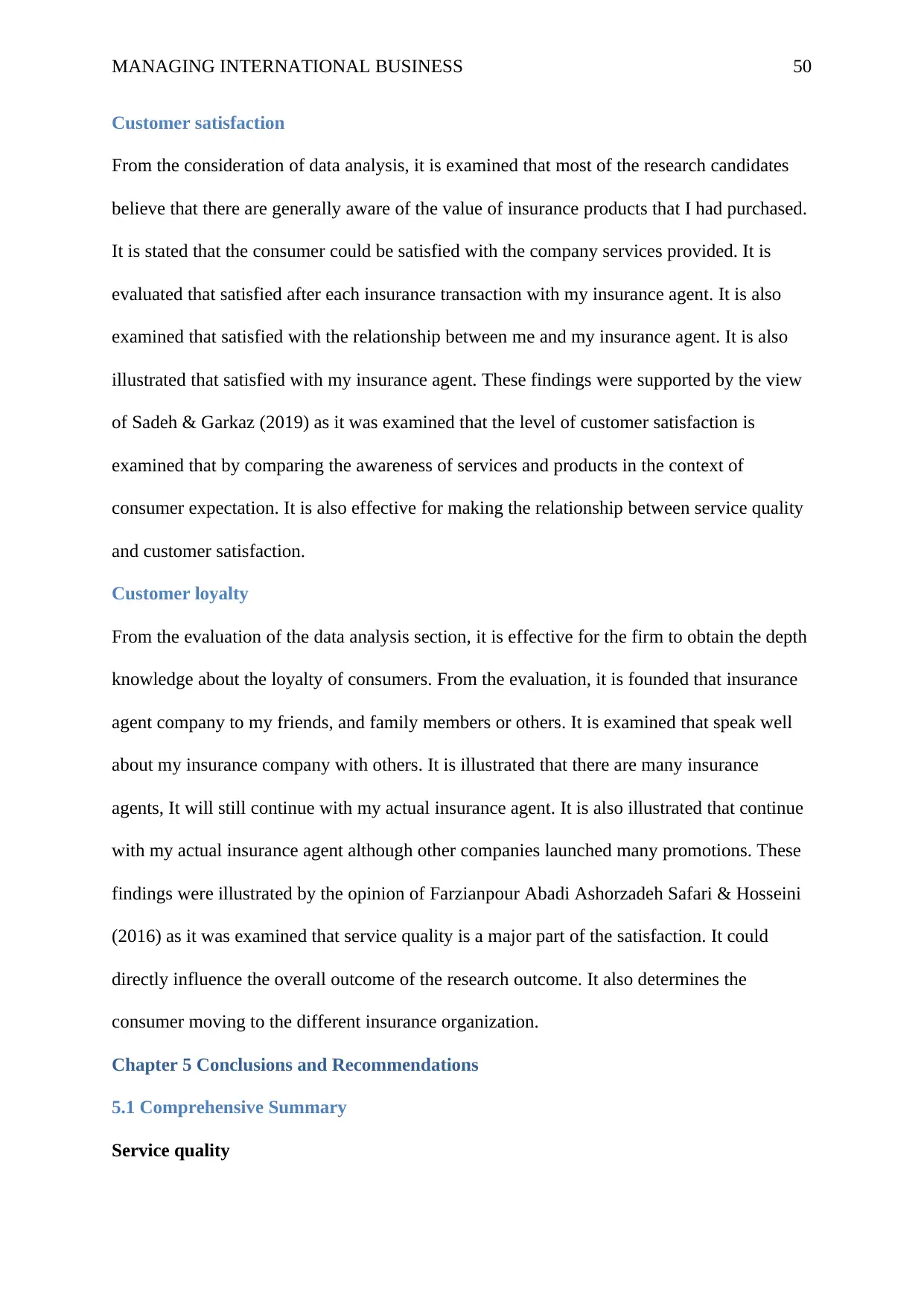
MANAGING INTERNATIONAL BUSINESS 50
Customer satisfaction
From the consideration of data analysis, it is examined that most of the research candidates
believe that there are generally aware of the value of insurance products that I had purchased.
It is stated that the consumer could be satisfied with the company services provided. It is
evaluated that satisfied after each insurance transaction with my insurance agent. It is also
examined that satisfied with the relationship between me and my insurance agent. It is also
illustrated that satisfied with my insurance agent. These findings were supported by the view
of Sadeh & Garkaz (2019) as it was examined that the level of customer satisfaction is
examined that by comparing the awareness of services and products in the context of
consumer expectation. It is also effective for making the relationship between service quality
and customer satisfaction.
Customer loyalty
From the evaluation of the data analysis section, it is effective for the firm to obtain the depth
knowledge about the loyalty of consumers. From the evaluation, it is founded that insurance
agent company to my friends, and family members or others. It is examined that speak well
about my insurance company with others. It is illustrated that there are many insurance
agents, It will still continue with my actual insurance agent. It is also illustrated that continue
with my actual insurance agent although other companies launched many promotions. These
findings were illustrated by the opinion of Farzianpour Abadi Ashorzadeh Safari & Hosseini
(2016) as it was examined that service quality is a major part of the satisfaction. It could
directly influence the overall outcome of the research outcome. It also determines the
consumer moving to the different insurance organization.
Chapter 5 Conclusions and Recommendations
5.1 Comprehensive Summary
Service quality
Customer satisfaction
From the consideration of data analysis, it is examined that most of the research candidates
believe that there are generally aware of the value of insurance products that I had purchased.
It is stated that the consumer could be satisfied with the company services provided. It is
evaluated that satisfied after each insurance transaction with my insurance agent. It is also
examined that satisfied with the relationship between me and my insurance agent. It is also
illustrated that satisfied with my insurance agent. These findings were supported by the view
of Sadeh & Garkaz (2019) as it was examined that the level of customer satisfaction is
examined that by comparing the awareness of services and products in the context of
consumer expectation. It is also effective for making the relationship between service quality
and customer satisfaction.
Customer loyalty
From the evaluation of the data analysis section, it is effective for the firm to obtain the depth
knowledge about the loyalty of consumers. From the evaluation, it is founded that insurance
agent company to my friends, and family members or others. It is examined that speak well
about my insurance company with others. It is illustrated that there are many insurance
agents, It will still continue with my actual insurance agent. It is also illustrated that continue
with my actual insurance agent although other companies launched many promotions. These
findings were illustrated by the opinion of Farzianpour Abadi Ashorzadeh Safari & Hosseini
(2016) as it was examined that service quality is a major part of the satisfaction. It could
directly influence the overall outcome of the research outcome. It also determines the
consumer moving to the different insurance organization.
Chapter 5 Conclusions and Recommendations
5.1 Comprehensive Summary
Service quality
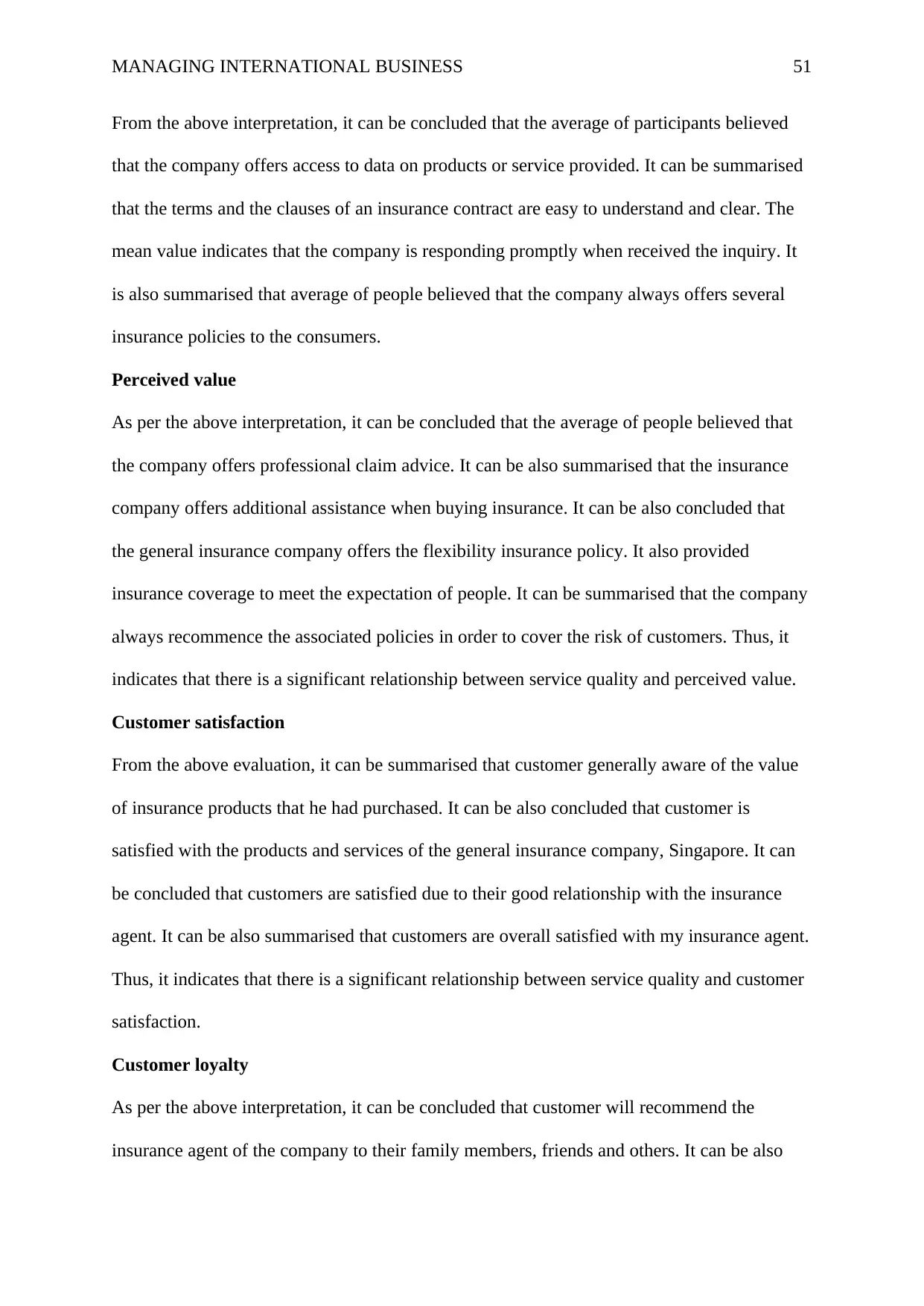
MANAGING INTERNATIONAL BUSINESS 51
From the above interpretation, it can be concluded that the average of participants believed
that the company offers access to data on products or service provided. It can be summarised
that the terms and the clauses of an insurance contract are easy to understand and clear. The
mean value indicates that the company is responding promptly when received the inquiry. It
is also summarised that average of people believed that the company always offers several
insurance policies to the consumers.
Perceived value
As per the above interpretation, it can be concluded that the average of people believed that
the company offers professional claim advice. It can be also summarised that the insurance
company offers additional assistance when buying insurance. It can be also concluded that
the general insurance company offers the flexibility insurance policy. It also provided
insurance coverage to meet the expectation of people. It can be summarised that the company
always recommence the associated policies in order to cover the risk of customers. Thus, it
indicates that there is a significant relationship between service quality and perceived value.
Customer satisfaction
From the above evaluation, it can be summarised that customer generally aware of the value
of insurance products that he had purchased. It can be also concluded that customer is
satisfied with the products and services of the general insurance company, Singapore. It can
be concluded that customers are satisfied due to their good relationship with the insurance
agent. It can be also summarised that customers are overall satisfied with my insurance agent.
Thus, it indicates that there is a significant relationship between service quality and customer
satisfaction.
Customer loyalty
As per the above interpretation, it can be concluded that customer will recommend the
insurance agent of the company to their family members, friends and others. It can be also
From the above interpretation, it can be concluded that the average of participants believed
that the company offers access to data on products or service provided. It can be summarised
that the terms and the clauses of an insurance contract are easy to understand and clear. The
mean value indicates that the company is responding promptly when received the inquiry. It
is also summarised that average of people believed that the company always offers several
insurance policies to the consumers.
Perceived value
As per the above interpretation, it can be concluded that the average of people believed that
the company offers professional claim advice. It can be also summarised that the insurance
company offers additional assistance when buying insurance. It can be also concluded that
the general insurance company offers the flexibility insurance policy. It also provided
insurance coverage to meet the expectation of people. It can be summarised that the company
always recommence the associated policies in order to cover the risk of customers. Thus, it
indicates that there is a significant relationship between service quality and perceived value.
Customer satisfaction
From the above evaluation, it can be summarised that customer generally aware of the value
of insurance products that he had purchased. It can be also concluded that customer is
satisfied with the products and services of the general insurance company, Singapore. It can
be concluded that customers are satisfied due to their good relationship with the insurance
agent. It can be also summarised that customers are overall satisfied with my insurance agent.
Thus, it indicates that there is a significant relationship between service quality and customer
satisfaction.
Customer loyalty
As per the above interpretation, it can be concluded that customer will recommend the
insurance agent of the company to their family members, friends and others. It can be also
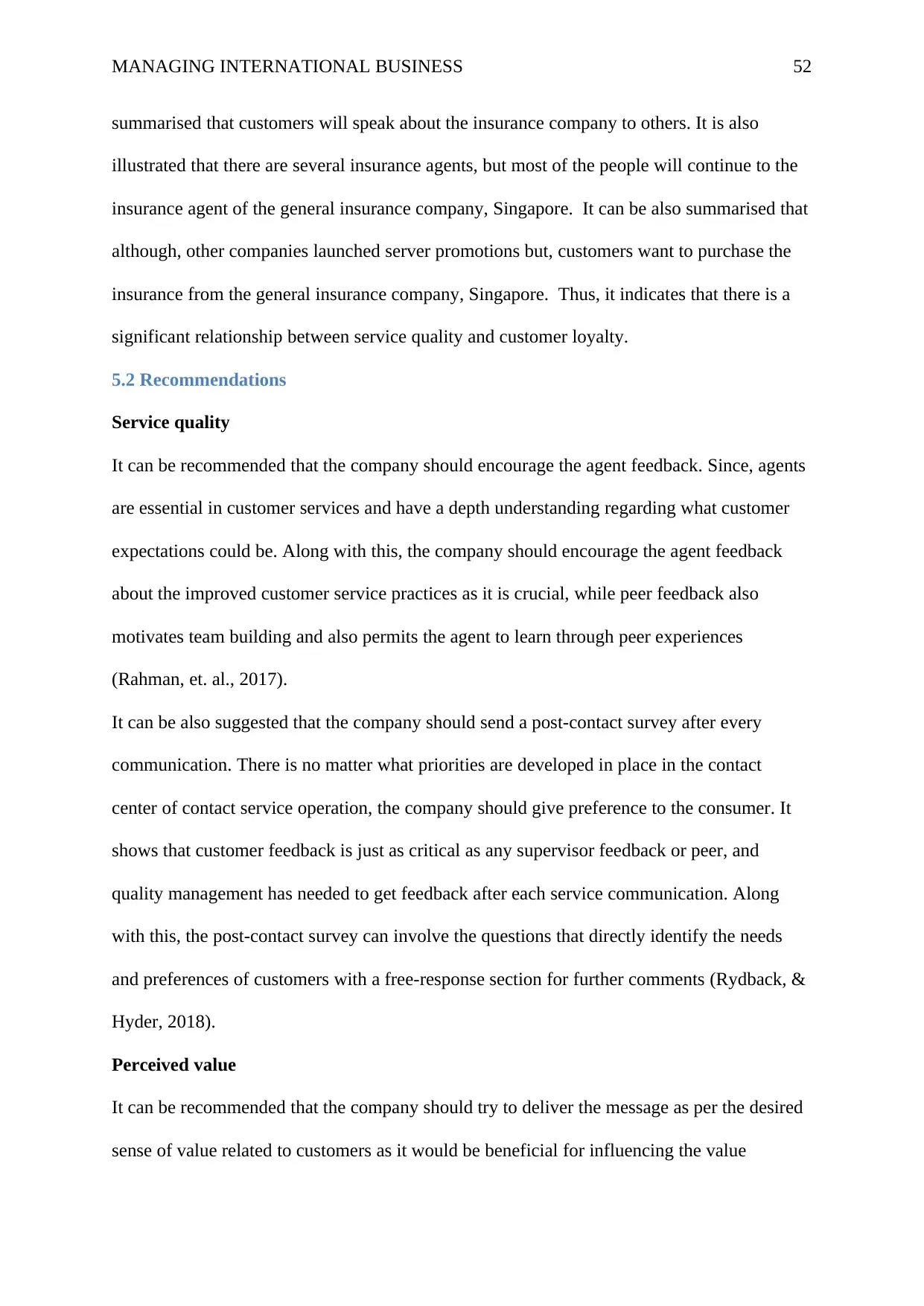
MANAGING INTERNATIONAL BUSINESS 52
summarised that customers will speak about the insurance company to others. It is also
illustrated that there are several insurance agents, but most of the people will continue to the
insurance agent of the general insurance company, Singapore. It can be also summarised that
although, other companies launched server promotions but, customers want to purchase the
insurance from the general insurance company, Singapore. Thus, it indicates that there is a
significant relationship between service quality and customer loyalty.
5.2 Recommendations
Service quality
It can be recommended that the company should encourage the agent feedback. Since, agents
are essential in customer services and have a depth understanding regarding what customer
expectations could be. Along with this, the company should encourage the agent feedback
about the improved customer service practices as it is crucial, while peer feedback also
motivates team building and also permits the agent to learn through peer experiences
(Rahman, et. al., 2017).
It can be also suggested that the company should send a post-contact survey after every
communication. There is no matter what priorities are developed in place in the contact
center of contact service operation, the company should give preference to the consumer. It
shows that customer feedback is just as critical as any supervisor feedback or peer, and
quality management has needed to get feedback after each service communication. Along
with this, the post-contact survey can involve the questions that directly identify the needs
and preferences of customers with a free-response section for further comments (Rydback, &
Hyder, 2018).
Perceived value
It can be recommended that the company should try to deliver the message as per the desired
sense of value related to customers as it would be beneficial for influencing the value
summarised that customers will speak about the insurance company to others. It is also
illustrated that there are several insurance agents, but most of the people will continue to the
insurance agent of the general insurance company, Singapore. It can be also summarised that
although, other companies launched server promotions but, customers want to purchase the
insurance from the general insurance company, Singapore. Thus, it indicates that there is a
significant relationship between service quality and customer loyalty.
5.2 Recommendations
Service quality
It can be recommended that the company should encourage the agent feedback. Since, agents
are essential in customer services and have a depth understanding regarding what customer
expectations could be. Along with this, the company should encourage the agent feedback
about the improved customer service practices as it is crucial, while peer feedback also
motivates team building and also permits the agent to learn through peer experiences
(Rahman, et. al., 2017).
It can be also suggested that the company should send a post-contact survey after every
communication. There is no matter what priorities are developed in place in the contact
center of contact service operation, the company should give preference to the consumer. It
shows that customer feedback is just as critical as any supervisor feedback or peer, and
quality management has needed to get feedback after each service communication. Along
with this, the post-contact survey can involve the questions that directly identify the needs
and preferences of customers with a free-response section for further comments (Rydback, &
Hyder, 2018).
Perceived value
It can be recommended that the company should try to deliver the message as per the desired
sense of value related to customers as it would be beneficial for influencing the value
Secure Best Marks with AI Grader
Need help grading? Try our AI Grader for instant feedback on your assignments.
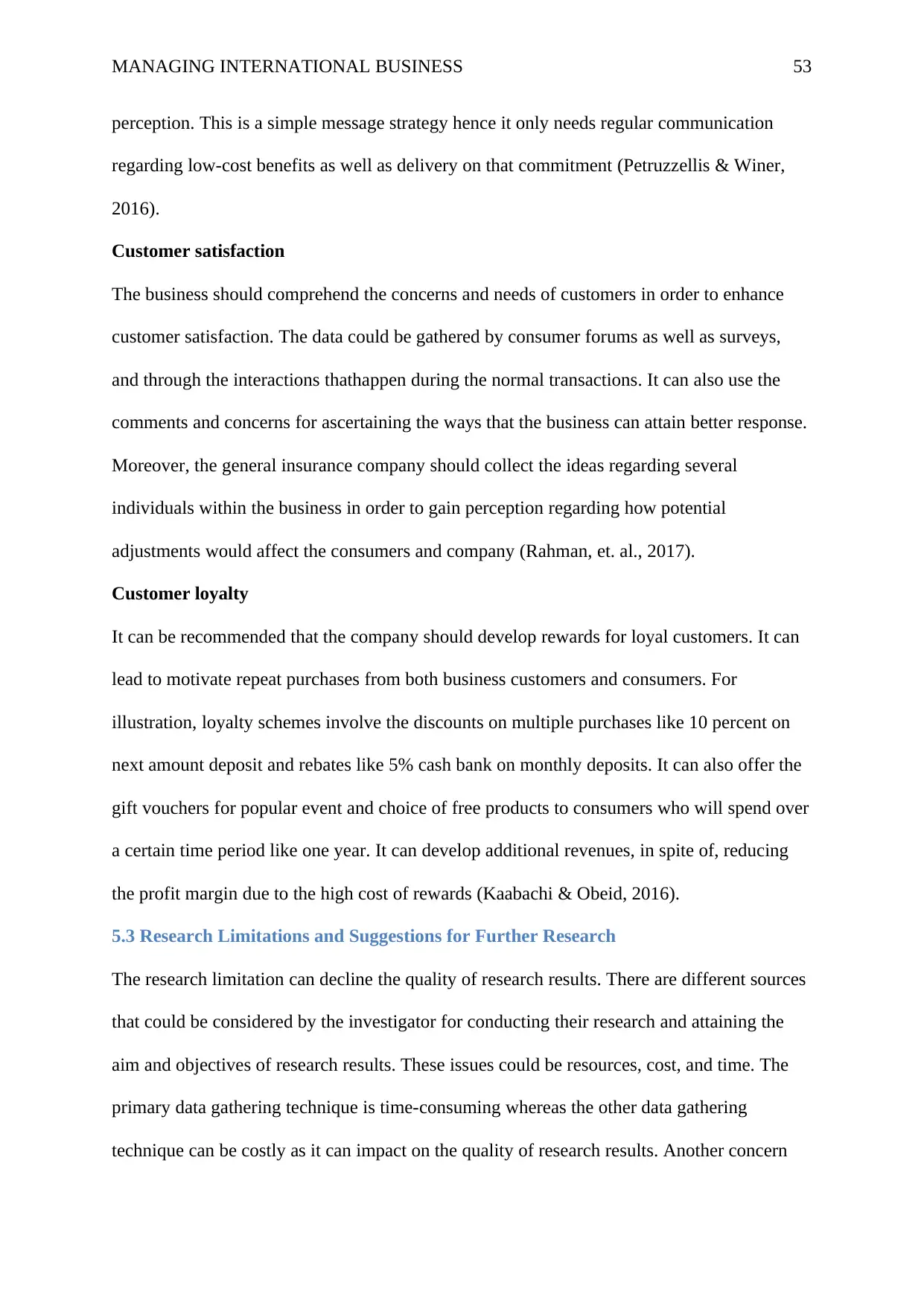
MANAGING INTERNATIONAL BUSINESS 53
perception. This is a simple message strategy hence it only needs regular communication
regarding low-cost benefits as well as delivery on that commitment (Petruzzellis & Winer,
2016).
Customer satisfaction
The business should comprehend the concerns and needs of customers in order to enhance
customer satisfaction. The data could be gathered by consumer forums as well as surveys,
and through the interactions thathappen during the normal transactions. It can also use the
comments and concerns for ascertaining the ways that the business can attain better response.
Moreover, the general insurance company should collect the ideas regarding several
individuals within the business in order to gain perception regarding how potential
adjustments would affect the consumers and company (Rahman, et. al., 2017).
Customer loyalty
It can be recommended that the company should develop rewards for loyal customers. It can
lead to motivate repeat purchases from both business customers and consumers. For
illustration, loyalty schemes involve the discounts on multiple purchases like 10 percent on
next amount deposit and rebates like 5% cash bank on monthly deposits. It can also offer the
gift vouchers for popular event and choice of free products to consumers who will spend over
a certain time period like one year. It can develop additional revenues, in spite of, reducing
the profit margin due to the high cost of rewards (Kaabachi & Obeid, 2016).
5.3 Research Limitations and Suggestions for Further Research
The research limitation can decline the quality of research results. There are different sources
that could be considered by the investigator for conducting their research and attaining the
aim and objectives of research results. These issues could be resources, cost, and time. The
primary data gathering technique is time-consuming whereas the other data gathering
technique can be costly as it can impact on the quality of research results. Another concern
perception. This is a simple message strategy hence it only needs regular communication
regarding low-cost benefits as well as delivery on that commitment (Petruzzellis & Winer,
2016).
Customer satisfaction
The business should comprehend the concerns and needs of customers in order to enhance
customer satisfaction. The data could be gathered by consumer forums as well as surveys,
and through the interactions thathappen during the normal transactions. It can also use the
comments and concerns for ascertaining the ways that the business can attain better response.
Moreover, the general insurance company should collect the ideas regarding several
individuals within the business in order to gain perception regarding how potential
adjustments would affect the consumers and company (Rahman, et. al., 2017).
Customer loyalty
It can be recommended that the company should develop rewards for loyal customers. It can
lead to motivate repeat purchases from both business customers and consumers. For
illustration, loyalty schemes involve the discounts on multiple purchases like 10 percent on
next amount deposit and rebates like 5% cash bank on monthly deposits. It can also offer the
gift vouchers for popular event and choice of free products to consumers who will spend over
a certain time period like one year. It can develop additional revenues, in spite of, reducing
the profit margin due to the high cost of rewards (Kaabachi & Obeid, 2016).
5.3 Research Limitations and Suggestions for Further Research
The research limitation can decline the quality of research results. There are different sources
that could be considered by the investigator for conducting their research and attaining the
aim and objectives of research results. These issues could be resources, cost, and time. The
primary data gathering technique is time-consuming whereas the other data gathering
technique can be costly as it can impact on the quality of research results. Another concern
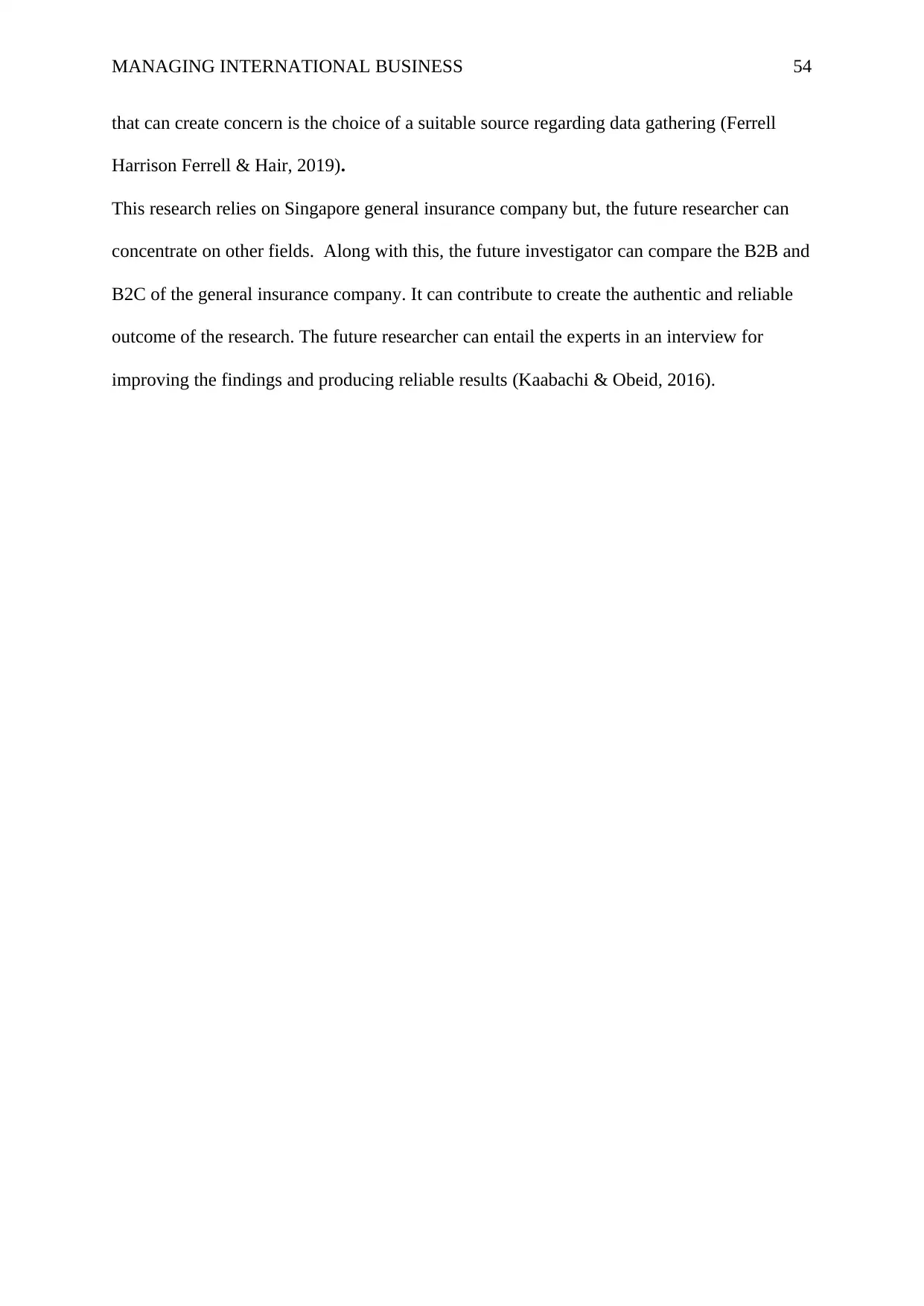
MANAGING INTERNATIONAL BUSINESS 54
that can create concern is the choice of a suitable source regarding data gathering (Ferrell
Harrison Ferrell & Hair, 2019).
This research relies on Singapore general insurance company but, the future researcher can
concentrate on other fields. Along with this, the future investigator can compare the B2B and
B2C of the general insurance company. It can contribute to create the authentic and reliable
outcome of the research. The future researcher can entail the experts in an interview for
improving the findings and producing reliable results (Kaabachi & Obeid, 2016).
that can create concern is the choice of a suitable source regarding data gathering (Ferrell
Harrison Ferrell & Hair, 2019).
This research relies on Singapore general insurance company but, the future researcher can
concentrate on other fields. Along with this, the future investigator can compare the B2B and
B2C of the general insurance company. It can contribute to create the authentic and reliable
outcome of the research. The future researcher can entail the experts in an interview for
improving the findings and producing reliable results (Kaabachi & Obeid, 2016).
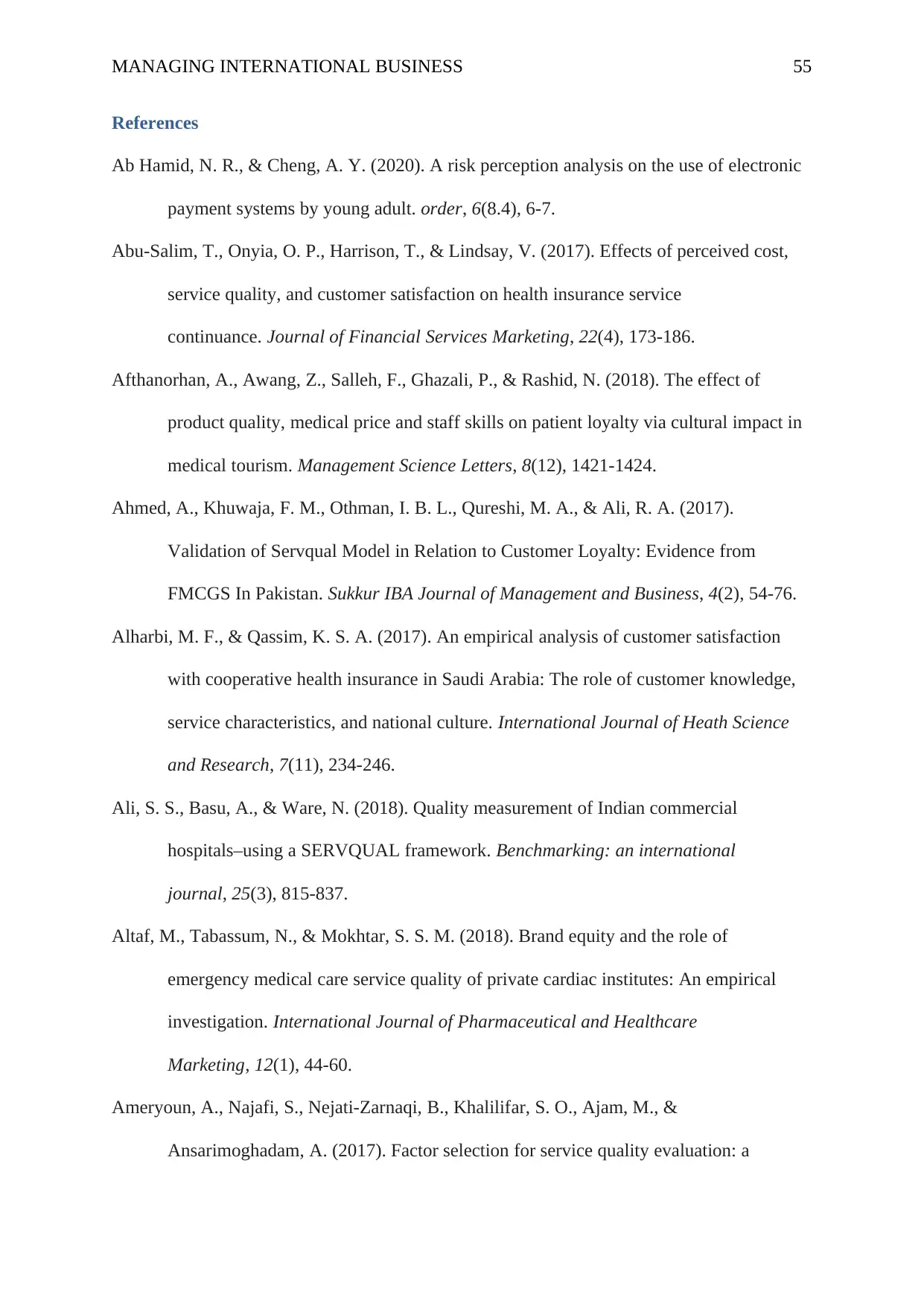
MANAGING INTERNATIONAL BUSINESS 55
References
Ab Hamid, N. R., & Cheng, A. Y. (2020). A risk perception analysis on the use of electronic
payment systems by young adult. order, 6(8.4), 6-7.
Abu-Salim, T., Onyia, O. P., Harrison, T., & Lindsay, V. (2017). Effects of perceived cost,
service quality, and customer satisfaction on health insurance service
continuance. Journal of Financial Services Marketing, 22(4), 173-186.
Afthanorhan, A., Awang, Z., Salleh, F., Ghazali, P., & Rashid, N. (2018). The effect of
product quality, medical price and staff skills on patient loyalty via cultural impact in
medical tourism. Management Science Letters, 8(12), 1421-1424.
Ahmed, A., Khuwaja, F. M., Othman, I. B. L., Qureshi, M. A., & Ali, R. A. (2017).
Validation of Servqual Model in Relation to Customer Loyalty: Evidence from
FMCGS In Pakistan. Sukkur IBA Journal of Management and Business, 4(2), 54-76.
Alharbi, M. F., & Qassim, K. S. A. (2017). An empirical analysis of customer satisfaction
with cooperative health insurance in Saudi Arabia: The role of customer knowledge,
service characteristics, and national culture. International Journal of Heath Science
and Research, 7(11), 234-246.
Ali, S. S., Basu, A., & Ware, N. (2018). Quality measurement of Indian commercial
hospitals–using a SERVQUAL framework. Benchmarking: an international
journal, 25(3), 815-837.
Altaf, M., Tabassum, N., & Mokhtar, S. S. M. (2018). Brand equity and the role of
emergency medical care service quality of private cardiac institutes: An empirical
investigation. International Journal of Pharmaceutical and Healthcare
Marketing, 12(1), 44-60.
Ameryoun, A., Najafi, S., Nejati-Zarnaqi, B., Khalilifar, S. O., Ajam, M., &
Ansarimoghadam, A. (2017). Factor selection for service quality evaluation: a
References
Ab Hamid, N. R., & Cheng, A. Y. (2020). A risk perception analysis on the use of electronic
payment systems by young adult. order, 6(8.4), 6-7.
Abu-Salim, T., Onyia, O. P., Harrison, T., & Lindsay, V. (2017). Effects of perceived cost,
service quality, and customer satisfaction on health insurance service
continuance. Journal of Financial Services Marketing, 22(4), 173-186.
Afthanorhan, A., Awang, Z., Salleh, F., Ghazali, P., & Rashid, N. (2018). The effect of
product quality, medical price and staff skills on patient loyalty via cultural impact in
medical tourism. Management Science Letters, 8(12), 1421-1424.
Ahmed, A., Khuwaja, F. M., Othman, I. B. L., Qureshi, M. A., & Ali, R. A. (2017).
Validation of Servqual Model in Relation to Customer Loyalty: Evidence from
FMCGS In Pakistan. Sukkur IBA Journal of Management and Business, 4(2), 54-76.
Alharbi, M. F., & Qassim, K. S. A. (2017). An empirical analysis of customer satisfaction
with cooperative health insurance in Saudi Arabia: The role of customer knowledge,
service characteristics, and national culture. International Journal of Heath Science
and Research, 7(11), 234-246.
Ali, S. S., Basu, A., & Ware, N. (2018). Quality measurement of Indian commercial
hospitals–using a SERVQUAL framework. Benchmarking: an international
journal, 25(3), 815-837.
Altaf, M., Tabassum, N., & Mokhtar, S. S. M. (2018). Brand equity and the role of
emergency medical care service quality of private cardiac institutes: An empirical
investigation. International Journal of Pharmaceutical and Healthcare
Marketing, 12(1), 44-60.
Ameryoun, A., Najafi, S., Nejati-Zarnaqi, B., Khalilifar, S. O., Ajam, M., &
Ansarimoghadam, A. (2017). Factor selection for service quality evaluation: a
Paraphrase This Document
Need a fresh take? Get an instant paraphrase of this document with our AI Paraphraser

MANAGING INTERNATIONAL BUSINESS 56
hospital case study. International journal of health care quality assurance, 30(1), 58-
66.
Aruan, D. T. H., Crouch, R., & Quester, P. (2018). Relative importance of country of service
delivery, country of person and country of brand in hybrid service evaluation: a
conjoint analysis approach. Journal of Product & Brand Management, 27(7), 819-
831.
Aziz, S., Md Husin, M., Hussin, N., & Afaq, Z. (2019). Factors that influence individuals’
intentions to purchase family takaful mediating role of perceived trust. Asia Pacific
Journal of Marketing and Logistics, 31(1), 81-104.
Chakrabarti, S., Trehan, D., & Makhija, M. (2018). Assessment of service quality using text
mining–evidence from private sector banks in India. International Journal of Bank
Marketing, 36(4), 594-615.
Chow-Chua, C., & Lim, G. (2000). A demand audit of the insurance market in
Singapore. Managerial Auditing Journal, 15(7), 372-382.
https://doi.org/10.1108/02686900010344647
Clauss, T., Harengel, P., & Hock, M. (2018). The perception of value of platform-based
business models in the sharing economy: determining the drivers of user
loyalty. Review of Managerial Science, 1-30.
Cronin Jr, J. J., & Taylor, S. A. (1992). Measuring service quality: a reexamination and
extension. Journal of marketing, 56(3), 55-68.
Crosby, L. A., & Stephens, N. (1987). Effects of relationship marketing on satisfaction,
retention, and prices in the life insurance industry. Journal of marketing
research, 24(4), 404-411.
hospital case study. International journal of health care quality assurance, 30(1), 58-
66.
Aruan, D. T. H., Crouch, R., & Quester, P. (2018). Relative importance of country of service
delivery, country of person and country of brand in hybrid service evaluation: a
conjoint analysis approach. Journal of Product & Brand Management, 27(7), 819-
831.
Aziz, S., Md Husin, M., Hussin, N., & Afaq, Z. (2019). Factors that influence individuals’
intentions to purchase family takaful mediating role of perceived trust. Asia Pacific
Journal of Marketing and Logistics, 31(1), 81-104.
Chakrabarti, S., Trehan, D., & Makhija, M. (2018). Assessment of service quality using text
mining–evidence from private sector banks in India. International Journal of Bank
Marketing, 36(4), 594-615.
Chow-Chua, C., & Lim, G. (2000). A demand audit of the insurance market in
Singapore. Managerial Auditing Journal, 15(7), 372-382.
https://doi.org/10.1108/02686900010344647
Clauss, T., Harengel, P., & Hock, M. (2018). The perception of value of platform-based
business models in the sharing economy: determining the drivers of user
loyalty. Review of Managerial Science, 1-30.
Cronin Jr, J. J., & Taylor, S. A. (1992). Measuring service quality: a reexamination and
extension. Journal of marketing, 56(3), 55-68.
Crosby, L. A., & Stephens, N. (1987). Effects of relationship marketing on satisfaction,
retention, and prices in the life insurance industry. Journal of marketing
research, 24(4), 404-411.
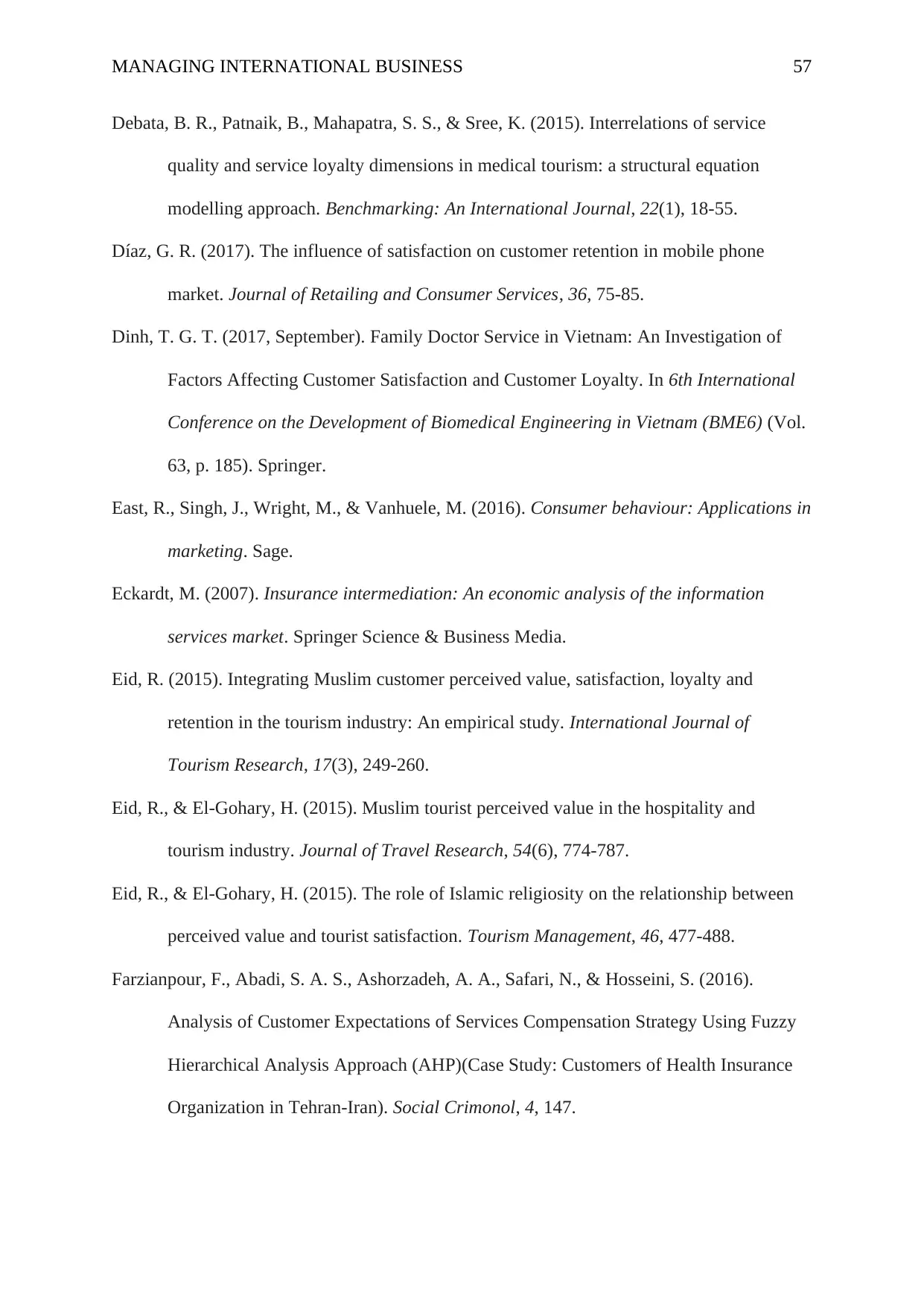
MANAGING INTERNATIONAL BUSINESS 57
Debata, B. R., Patnaik, B., Mahapatra, S. S., & Sree, K. (2015). Interrelations of service
quality and service loyalty dimensions in medical tourism: a structural equation
modelling approach. Benchmarking: An International Journal, 22(1), 18-55.
Díaz, G. R. (2017). The influence of satisfaction on customer retention in mobile phone
market. Journal of Retailing and Consumer Services, 36, 75-85.
Dinh, T. G. T. (2017, September). Family Doctor Service in Vietnam: An Investigation of
Factors Affecting Customer Satisfaction and Customer Loyalty. In 6th International
Conference on the Development of Biomedical Engineering in Vietnam (BME6) (Vol.
63, p. 185). Springer.
East, R., Singh, J., Wright, M., & Vanhuele, M. (2016). Consumer behaviour: Applications in
marketing. Sage.
Eckardt, M. (2007). Insurance intermediation: An economic analysis of the information
services market. Springer Science & Business Media.
Eid, R. (2015). Integrating Muslim customer perceived value, satisfaction, loyalty and
retention in the tourism industry: An empirical study. International Journal of
Tourism Research, 17(3), 249-260.
Eid, R., & El-Gohary, H. (2015). Muslim tourist perceived value in the hospitality and
tourism industry. Journal of Travel Research, 54(6), 774-787.
Eid, R., & El-Gohary, H. (2015). The role of Islamic religiosity on the relationship between
perceived value and tourist satisfaction. Tourism Management, 46, 477-488.
Farzianpour, F., Abadi, S. A. S., Ashorzadeh, A. A., Safari, N., & Hosseini, S. (2016).
Analysis of Customer Expectations of Services Compensation Strategy Using Fuzzy
Hierarchical Analysis Approach (AHP)(Case Study: Customers of Health Insurance
Organization in Tehran-Iran). Social Crimonol, 4, 147.
Debata, B. R., Patnaik, B., Mahapatra, S. S., & Sree, K. (2015). Interrelations of service
quality and service loyalty dimensions in medical tourism: a structural equation
modelling approach. Benchmarking: An International Journal, 22(1), 18-55.
Díaz, G. R. (2017). The influence of satisfaction on customer retention in mobile phone
market. Journal of Retailing and Consumer Services, 36, 75-85.
Dinh, T. G. T. (2017, September). Family Doctor Service in Vietnam: An Investigation of
Factors Affecting Customer Satisfaction and Customer Loyalty. In 6th International
Conference on the Development of Biomedical Engineering in Vietnam (BME6) (Vol.
63, p. 185). Springer.
East, R., Singh, J., Wright, M., & Vanhuele, M. (2016). Consumer behaviour: Applications in
marketing. Sage.
Eckardt, M. (2007). Insurance intermediation: An economic analysis of the information
services market. Springer Science & Business Media.
Eid, R. (2015). Integrating Muslim customer perceived value, satisfaction, loyalty and
retention in the tourism industry: An empirical study. International Journal of
Tourism Research, 17(3), 249-260.
Eid, R., & El-Gohary, H. (2015). Muslim tourist perceived value in the hospitality and
tourism industry. Journal of Travel Research, 54(6), 774-787.
Eid, R., & El-Gohary, H. (2015). The role of Islamic religiosity on the relationship between
perceived value and tourist satisfaction. Tourism Management, 46, 477-488.
Farzianpour, F., Abadi, S. A. S., Ashorzadeh, A. A., Safari, N., & Hosseini, S. (2016).
Analysis of Customer Expectations of Services Compensation Strategy Using Fuzzy
Hierarchical Analysis Approach (AHP)(Case Study: Customers of Health Insurance
Organization in Tehran-Iran). Social Crimonol, 4, 147.
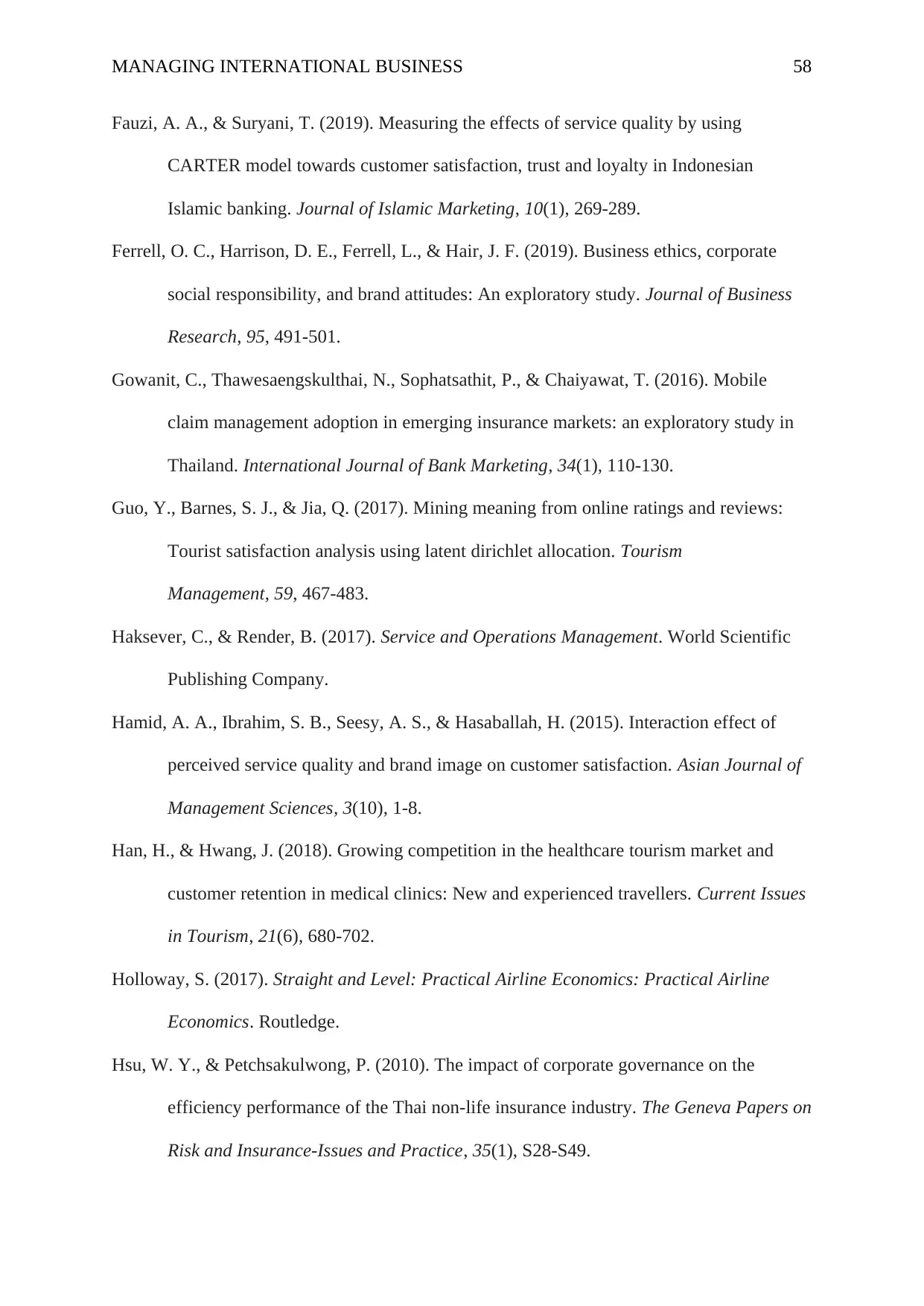
MANAGING INTERNATIONAL BUSINESS 58
Fauzi, A. A., & Suryani, T. (2019). Measuring the effects of service quality by using
CARTER model towards customer satisfaction, trust and loyalty in Indonesian
Islamic banking. Journal of Islamic Marketing, 10(1), 269-289.
Ferrell, O. C., Harrison, D. E., Ferrell, L., & Hair, J. F. (2019). Business ethics, corporate
social responsibility, and brand attitudes: An exploratory study. Journal of Business
Research, 95, 491-501.
Gowanit, C., Thawesaengskulthai, N., Sophatsathit, P., & Chaiyawat, T. (2016). Mobile
claim management adoption in emerging insurance markets: an exploratory study in
Thailand. International Journal of Bank Marketing, 34(1), 110-130.
Guo, Y., Barnes, S. J., & Jia, Q. (2017). Mining meaning from online ratings and reviews:
Tourist satisfaction analysis using latent dirichlet allocation. Tourism
Management, 59, 467-483.
Haksever, C., & Render, B. (2017). Service and Operations Management. World Scientific
Publishing Company.
Hamid, A. A., Ibrahim, S. B., Seesy, A. S., & Hasaballah, H. (2015). Interaction effect of
perceived service quality and brand image on customer satisfaction. Asian Journal of
Management Sciences, 3(10), 1-8.
Han, H., & Hwang, J. (2018). Growing competition in the healthcare tourism market and
customer retention in medical clinics: New and experienced travellers. Current Issues
in Tourism, 21(6), 680-702.
Holloway, S. (2017). Straight and Level: Practical Airline Economics: Practical Airline
Economics. Routledge.
Hsu, W. Y., & Petchsakulwong, P. (2010). The impact of corporate governance on the
efficiency performance of the Thai non-life insurance industry. The Geneva Papers on
Risk and Insurance-Issues and Practice, 35(1), S28-S49.
Fauzi, A. A., & Suryani, T. (2019). Measuring the effects of service quality by using
CARTER model towards customer satisfaction, trust and loyalty in Indonesian
Islamic banking. Journal of Islamic Marketing, 10(1), 269-289.
Ferrell, O. C., Harrison, D. E., Ferrell, L., & Hair, J. F. (2019). Business ethics, corporate
social responsibility, and brand attitudes: An exploratory study. Journal of Business
Research, 95, 491-501.
Gowanit, C., Thawesaengskulthai, N., Sophatsathit, P., & Chaiyawat, T. (2016). Mobile
claim management adoption in emerging insurance markets: an exploratory study in
Thailand. International Journal of Bank Marketing, 34(1), 110-130.
Guo, Y., Barnes, S. J., & Jia, Q. (2017). Mining meaning from online ratings and reviews:
Tourist satisfaction analysis using latent dirichlet allocation. Tourism
Management, 59, 467-483.
Haksever, C., & Render, B. (2017). Service and Operations Management. World Scientific
Publishing Company.
Hamid, A. A., Ibrahim, S. B., Seesy, A. S., & Hasaballah, H. (2015). Interaction effect of
perceived service quality and brand image on customer satisfaction. Asian Journal of
Management Sciences, 3(10), 1-8.
Han, H., & Hwang, J. (2018). Growing competition in the healthcare tourism market and
customer retention in medical clinics: New and experienced travellers. Current Issues
in Tourism, 21(6), 680-702.
Holloway, S. (2017). Straight and Level: Practical Airline Economics: Practical Airline
Economics. Routledge.
Hsu, W. Y., & Petchsakulwong, P. (2010). The impact of corporate governance on the
efficiency performance of the Thai non-life insurance industry. The Geneva Papers on
Risk and Insurance-Issues and Practice, 35(1), S28-S49.
Secure Best Marks with AI Grader
Need help grading? Try our AI Grader for instant feedback on your assignments.
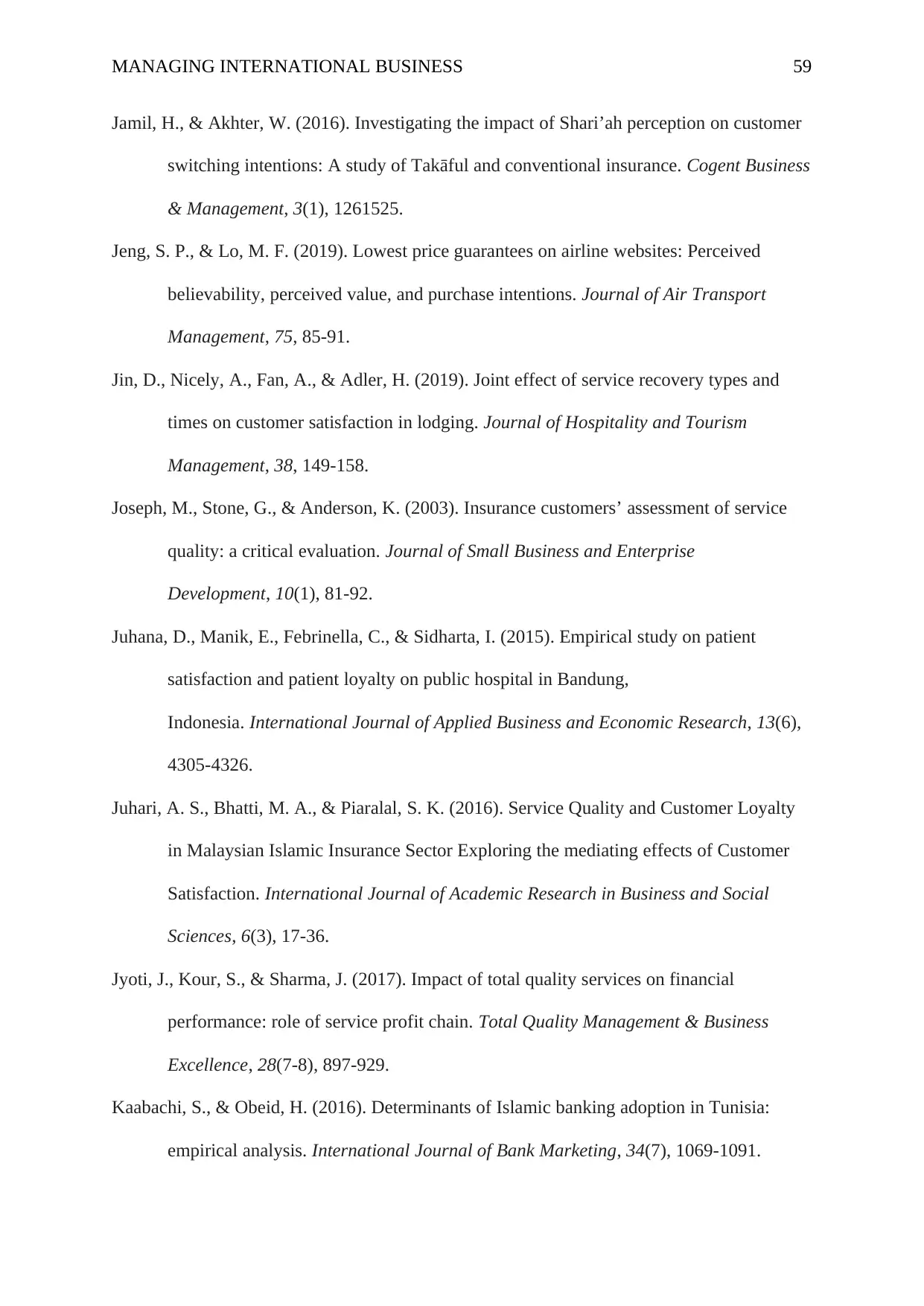
MANAGING INTERNATIONAL BUSINESS 59
Jamil, H., & Akhter, W. (2016). Investigating the impact of Shari’ah perception on customer
switching intentions: A study of Takāful and conventional insurance. Cogent Business
& Management, 3(1), 1261525.
Jeng, S. P., & Lo, M. F. (2019). Lowest price guarantees on airline websites: Perceived
believability, perceived value, and purchase intentions. Journal of Air Transport
Management, 75, 85-91.
Jin, D., Nicely, A., Fan, A., & Adler, H. (2019). Joint effect of service recovery types and
times on customer satisfaction in lodging. Journal of Hospitality and Tourism
Management, 38, 149-158.
Joseph, M., Stone, G., & Anderson, K. (2003). Insurance customers’ assessment of service
quality: a critical evaluation. Journal of Small Business and Enterprise
Development, 10(1), 81-92.
Juhana, D., Manik, E., Febrinella, C., & Sidharta, I. (2015). Empirical study on patient
satisfaction and patient loyalty on public hospital in Bandung,
Indonesia. International Journal of Applied Business and Economic Research, 13(6),
4305-4326.
Juhari, A. S., Bhatti, M. A., & Piaralal, S. K. (2016). Service Quality and Customer Loyalty
in Malaysian Islamic Insurance Sector Exploring the mediating effects of Customer
Satisfaction. International Journal of Academic Research in Business and Social
Sciences, 6(3), 17-36.
Jyoti, J., Kour, S., & Sharma, J. (2017). Impact of total quality services on financial
performance: role of service profit chain. Total Quality Management & Business
Excellence, 28(7-8), 897-929.
Kaabachi, S., & Obeid, H. (2016). Determinants of Islamic banking adoption in Tunisia:
empirical analysis. International Journal of Bank Marketing, 34(7), 1069-1091.
Jamil, H., & Akhter, W. (2016). Investigating the impact of Shari’ah perception on customer
switching intentions: A study of Takāful and conventional insurance. Cogent Business
& Management, 3(1), 1261525.
Jeng, S. P., & Lo, M. F. (2019). Lowest price guarantees on airline websites: Perceived
believability, perceived value, and purchase intentions. Journal of Air Transport
Management, 75, 85-91.
Jin, D., Nicely, A., Fan, A., & Adler, H. (2019). Joint effect of service recovery types and
times on customer satisfaction in lodging. Journal of Hospitality and Tourism
Management, 38, 149-158.
Joseph, M., Stone, G., & Anderson, K. (2003). Insurance customers’ assessment of service
quality: a critical evaluation. Journal of Small Business and Enterprise
Development, 10(1), 81-92.
Juhana, D., Manik, E., Febrinella, C., & Sidharta, I. (2015). Empirical study on patient
satisfaction and patient loyalty on public hospital in Bandung,
Indonesia. International Journal of Applied Business and Economic Research, 13(6),
4305-4326.
Juhari, A. S., Bhatti, M. A., & Piaralal, S. K. (2016). Service Quality and Customer Loyalty
in Malaysian Islamic Insurance Sector Exploring the mediating effects of Customer
Satisfaction. International Journal of Academic Research in Business and Social
Sciences, 6(3), 17-36.
Jyoti, J., Kour, S., & Sharma, J. (2017). Impact of total quality services on financial
performance: role of service profit chain. Total Quality Management & Business
Excellence, 28(7-8), 897-929.
Kaabachi, S., & Obeid, H. (2016). Determinants of Islamic banking adoption in Tunisia:
empirical analysis. International Journal of Bank Marketing, 34(7), 1069-1091.
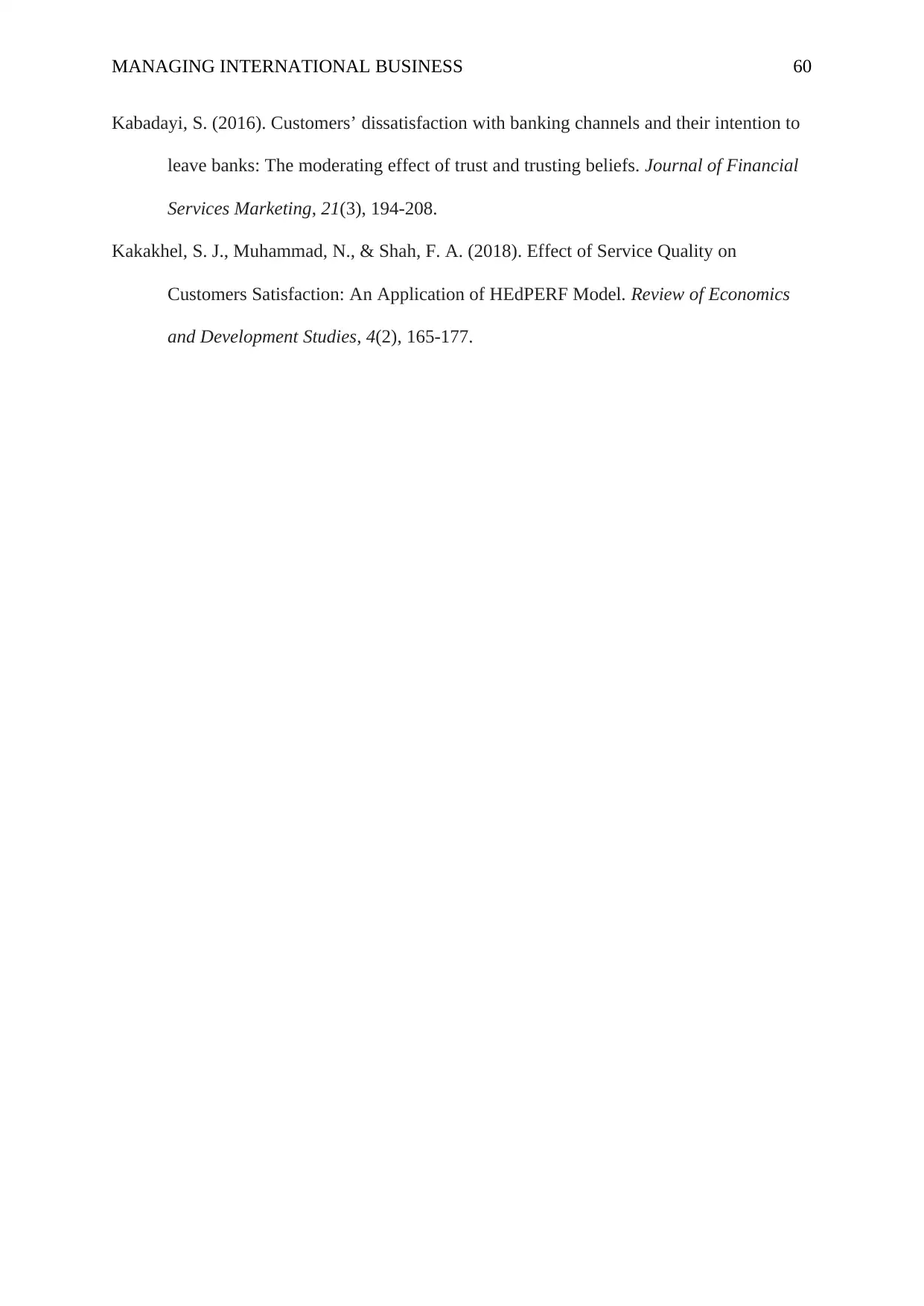
MANAGING INTERNATIONAL BUSINESS 60
Kabadayi, S. (2016). Customers’ dissatisfaction with banking channels and their intention to
leave banks: The moderating effect of trust and trusting beliefs. Journal of Financial
Services Marketing, 21(3), 194-208.
Kakakhel, S. J., Muhammad, N., & Shah, F. A. (2018). Effect of Service Quality on
Customers Satisfaction: An Application of HEdPERF Model. Review of Economics
and Development Studies, 4(2), 165-177.
Kabadayi, S. (2016). Customers’ dissatisfaction with banking channels and their intention to
leave banks: The moderating effect of trust and trusting beliefs. Journal of Financial
Services Marketing, 21(3), 194-208.
Kakakhel, S. J., Muhammad, N., & Shah, F. A. (2018). Effect of Service Quality on
Customers Satisfaction: An Application of HEdPERF Model. Review of Economics
and Development Studies, 4(2), 165-177.
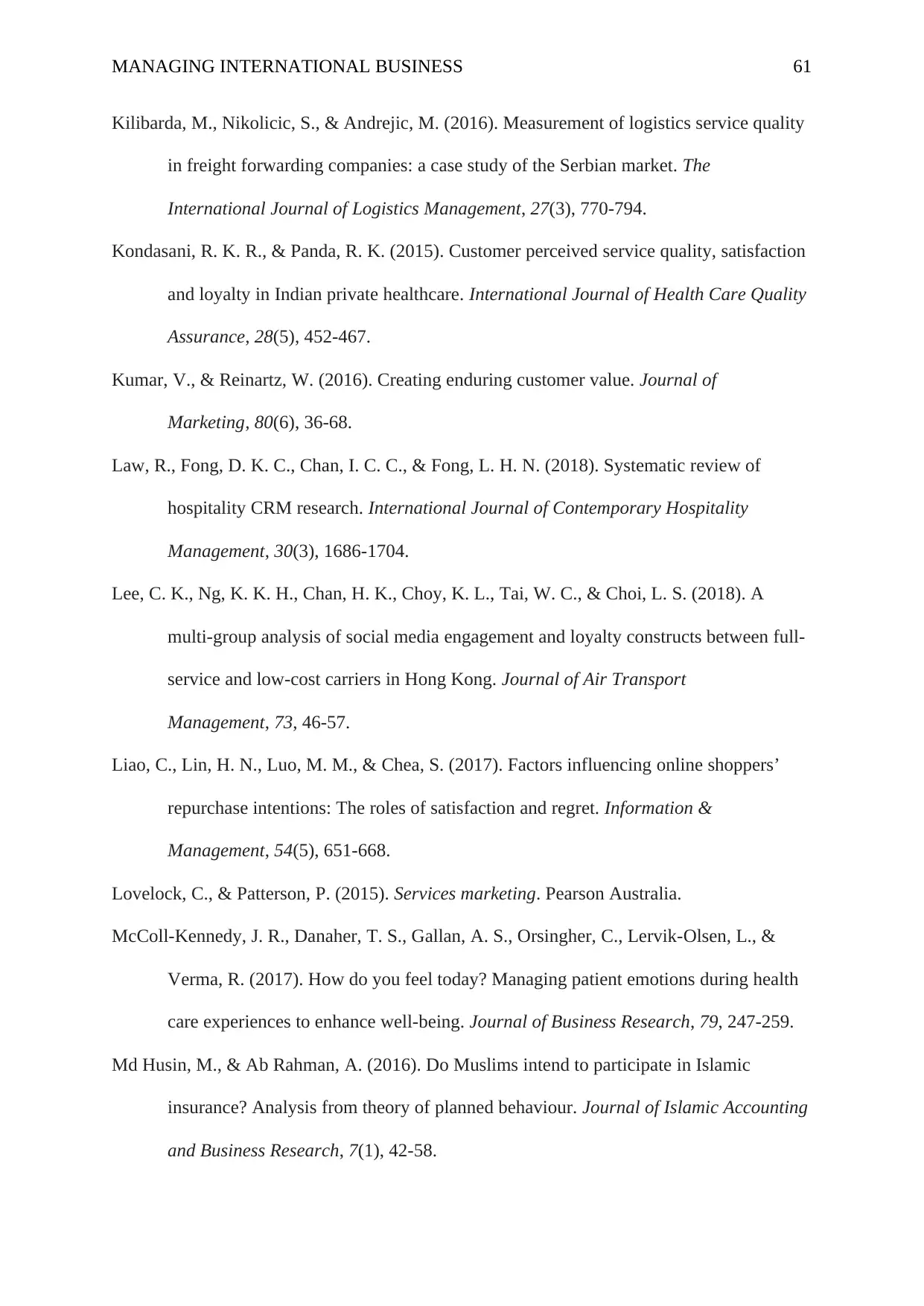
MANAGING INTERNATIONAL BUSINESS 61
Kilibarda, M., Nikolicic, S., & Andrejic, M. (2016). Measurement of logistics service quality
in freight forwarding companies: a case study of the Serbian market. The
International Journal of Logistics Management, 27(3), 770-794.
Kondasani, R. K. R., & Panda, R. K. (2015). Customer perceived service quality, satisfaction
and loyalty in Indian private healthcare. International Journal of Health Care Quality
Assurance, 28(5), 452-467.
Kumar, V., & Reinartz, W. (2016). Creating enduring customer value. Journal of
Marketing, 80(6), 36-68.
Law, R., Fong, D. K. C., Chan, I. C. C., & Fong, L. H. N. (2018). Systematic review of
hospitality CRM research. International Journal of Contemporary Hospitality
Management, 30(3), 1686-1704.
Lee, C. K., Ng, K. K. H., Chan, H. K., Choy, K. L., Tai, W. C., & Choi, L. S. (2018). A
multi-group analysis of social media engagement and loyalty constructs between full-
service and low-cost carriers in Hong Kong. Journal of Air Transport
Management, 73, 46-57.
Liao, C., Lin, H. N., Luo, M. M., & Chea, S. (2017). Factors influencing online shoppers’
repurchase intentions: The roles of satisfaction and regret. Information &
Management, 54(5), 651-668.
Lovelock, C., & Patterson, P. (2015). Services marketing. Pearson Australia.
McColl-Kennedy, J. R., Danaher, T. S., Gallan, A. S., Orsingher, C., Lervik-Olsen, L., &
Verma, R. (2017). How do you feel today? Managing patient emotions during health
care experiences to enhance well-being. Journal of Business Research, 79, 247-259.
Md Husin, M., & Ab Rahman, A. (2016). Do Muslims intend to participate in Islamic
insurance? Analysis from theory of planned behaviour. Journal of Islamic Accounting
and Business Research, 7(1), 42-58.
Kilibarda, M., Nikolicic, S., & Andrejic, M. (2016). Measurement of logistics service quality
in freight forwarding companies: a case study of the Serbian market. The
International Journal of Logistics Management, 27(3), 770-794.
Kondasani, R. K. R., & Panda, R. K. (2015). Customer perceived service quality, satisfaction
and loyalty in Indian private healthcare. International Journal of Health Care Quality
Assurance, 28(5), 452-467.
Kumar, V., & Reinartz, W. (2016). Creating enduring customer value. Journal of
Marketing, 80(6), 36-68.
Law, R., Fong, D. K. C., Chan, I. C. C., & Fong, L. H. N. (2018). Systematic review of
hospitality CRM research. International Journal of Contemporary Hospitality
Management, 30(3), 1686-1704.
Lee, C. K., Ng, K. K. H., Chan, H. K., Choy, K. L., Tai, W. C., & Choi, L. S. (2018). A
multi-group analysis of social media engagement and loyalty constructs between full-
service and low-cost carriers in Hong Kong. Journal of Air Transport
Management, 73, 46-57.
Liao, C., Lin, H. N., Luo, M. M., & Chea, S. (2017). Factors influencing online shoppers’
repurchase intentions: The roles of satisfaction and regret. Information &
Management, 54(5), 651-668.
Lovelock, C., & Patterson, P. (2015). Services marketing. Pearson Australia.
McColl-Kennedy, J. R., Danaher, T. S., Gallan, A. S., Orsingher, C., Lervik-Olsen, L., &
Verma, R. (2017). How do you feel today? Managing patient emotions during health
care experiences to enhance well-being. Journal of Business Research, 79, 247-259.
Md Husin, M., & Ab Rahman, A. (2016). Do Muslims intend to participate in Islamic
insurance? Analysis from theory of planned behaviour. Journal of Islamic Accounting
and Business Research, 7(1), 42-58.
Paraphrase This Document
Need a fresh take? Get an instant paraphrase of this document with our AI Paraphraser
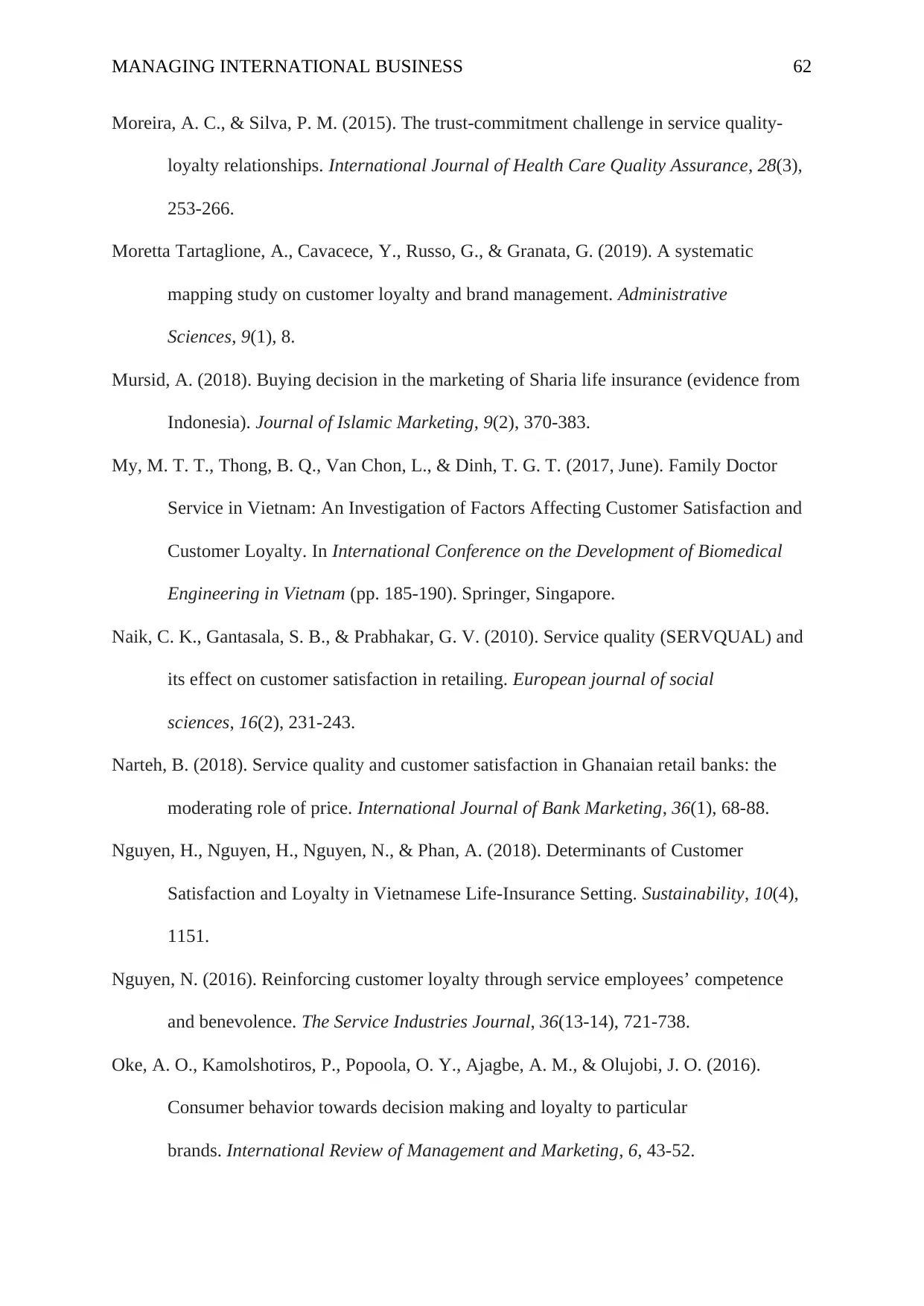
MANAGING INTERNATIONAL BUSINESS 62
Moreira, A. C., & Silva, P. M. (2015). The trust-commitment challenge in service quality-
loyalty relationships. International Journal of Health Care Quality Assurance, 28(3),
253-266.
Moretta Tartaglione, A., Cavacece, Y., Russo, G., & Granata, G. (2019). A systematic
mapping study on customer loyalty and brand management. Administrative
Sciences, 9(1), 8.
Mursid, A. (2018). Buying decision in the marketing of Sharia life insurance (evidence from
Indonesia). Journal of Islamic Marketing, 9(2), 370-383.
My, M. T. T., Thong, B. Q., Van Chon, L., & Dinh, T. G. T. (2017, June). Family Doctor
Service in Vietnam: An Investigation of Factors Affecting Customer Satisfaction and
Customer Loyalty. In International Conference on the Development of Biomedical
Engineering in Vietnam (pp. 185-190). Springer, Singapore.
Naik, C. K., Gantasala, S. B., & Prabhakar, G. V. (2010). Service quality (SERVQUAL) and
its effect on customer satisfaction in retailing. European journal of social
sciences, 16(2), 231-243.
Narteh, B. (2018). Service quality and customer satisfaction in Ghanaian retail banks: the
moderating role of price. International Journal of Bank Marketing, 36(1), 68-88.
Nguyen, H., Nguyen, H., Nguyen, N., & Phan, A. (2018). Determinants of Customer
Satisfaction and Loyalty in Vietnamese Life-Insurance Setting. Sustainability, 10(4),
1151.
Nguyen, N. (2016). Reinforcing customer loyalty through service employees’ competence
and benevolence. The Service Industries Journal, 36(13-14), 721-738.
Oke, A. O., Kamolshotiros, P., Popoola, O. Y., Ajagbe, A. M., & Olujobi, J. O. (2016).
Consumer behavior towards decision making and loyalty to particular
brands. International Review of Management and Marketing, 6, 43-52.
Moreira, A. C., & Silva, P. M. (2015). The trust-commitment challenge in service quality-
loyalty relationships. International Journal of Health Care Quality Assurance, 28(3),
253-266.
Moretta Tartaglione, A., Cavacece, Y., Russo, G., & Granata, G. (2019). A systematic
mapping study on customer loyalty and brand management. Administrative
Sciences, 9(1), 8.
Mursid, A. (2018). Buying decision in the marketing of Sharia life insurance (evidence from
Indonesia). Journal of Islamic Marketing, 9(2), 370-383.
My, M. T. T., Thong, B. Q., Van Chon, L., & Dinh, T. G. T. (2017, June). Family Doctor
Service in Vietnam: An Investigation of Factors Affecting Customer Satisfaction and
Customer Loyalty. In International Conference on the Development of Biomedical
Engineering in Vietnam (pp. 185-190). Springer, Singapore.
Naik, C. K., Gantasala, S. B., & Prabhakar, G. V. (2010). Service quality (SERVQUAL) and
its effect on customer satisfaction in retailing. European journal of social
sciences, 16(2), 231-243.
Narteh, B. (2018). Service quality and customer satisfaction in Ghanaian retail banks: the
moderating role of price. International Journal of Bank Marketing, 36(1), 68-88.
Nguyen, H., Nguyen, H., Nguyen, N., & Phan, A. (2018). Determinants of Customer
Satisfaction and Loyalty in Vietnamese Life-Insurance Setting. Sustainability, 10(4),
1151.
Nguyen, N. (2016). Reinforcing customer loyalty through service employees’ competence
and benevolence. The Service Industries Journal, 36(13-14), 721-738.
Oke, A. O., Kamolshotiros, P., Popoola, O. Y., Ajagbe, A. M., & Olujobi, J. O. (2016).
Consumer behavior towards decision making and loyalty to particular
brands. International Review of Management and Marketing, 6, 43-52.
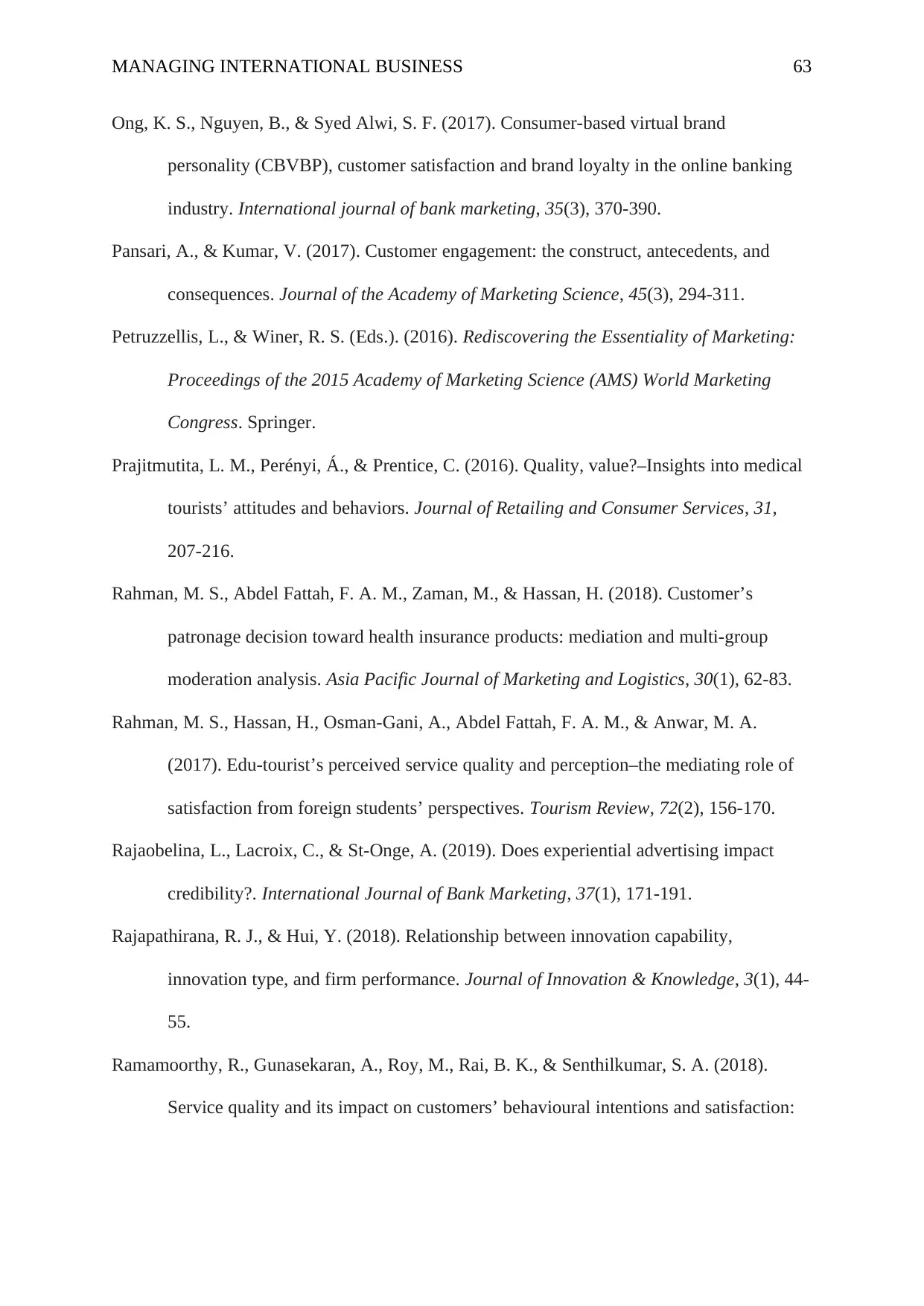
MANAGING INTERNATIONAL BUSINESS 63
Ong, K. S., Nguyen, B., & Syed Alwi, S. F. (2017). Consumer-based virtual brand
personality (CBVBP), customer satisfaction and brand loyalty in the online banking
industry. International journal of bank marketing, 35(3), 370-390.
Pansari, A., & Kumar, V. (2017). Customer engagement: the construct, antecedents, and
consequences. Journal of the Academy of Marketing Science, 45(3), 294-311.
Petruzzellis, L., & Winer, R. S. (Eds.). (2016). Rediscovering the Essentiality of Marketing:
Proceedings of the 2015 Academy of Marketing Science (AMS) World Marketing
Congress. Springer.
Prajitmutita, L. M., Perényi, Á., & Prentice, C. (2016). Quality, value?–Insights into medical
tourists’ attitudes and behaviors. Journal of Retailing and Consumer Services, 31,
207-216.
Rahman, M. S., Abdel Fattah, F. A. M., Zaman, M., & Hassan, H. (2018). Customer’s
patronage decision toward health insurance products: mediation and multi-group
moderation analysis. Asia Pacific Journal of Marketing and Logistics, 30(1), 62-83.
Rahman, M. S., Hassan, H., Osman-Gani, A., Abdel Fattah, F. A. M., & Anwar, M. A.
(2017). Edu-tourist’s perceived service quality and perception–the mediating role of
satisfaction from foreign students’ perspectives. Tourism Review, 72(2), 156-170.
Rajaobelina, L., Lacroix, C., & St-Onge, A. (2019). Does experiential advertising impact
credibility?. International Journal of Bank Marketing, 37(1), 171-191.
Rajapathirana, R. J., & Hui, Y. (2018). Relationship between innovation capability,
innovation type, and firm performance. Journal of Innovation & Knowledge, 3(1), 44-
55.
Ramamoorthy, R., Gunasekaran, A., Roy, M., Rai, B. K., & Senthilkumar, S. A. (2018).
Service quality and its impact on customers’ behavioural intentions and satisfaction:
Ong, K. S., Nguyen, B., & Syed Alwi, S. F. (2017). Consumer-based virtual brand
personality (CBVBP), customer satisfaction and brand loyalty in the online banking
industry. International journal of bank marketing, 35(3), 370-390.
Pansari, A., & Kumar, V. (2017). Customer engagement: the construct, antecedents, and
consequences. Journal of the Academy of Marketing Science, 45(3), 294-311.
Petruzzellis, L., & Winer, R. S. (Eds.). (2016). Rediscovering the Essentiality of Marketing:
Proceedings of the 2015 Academy of Marketing Science (AMS) World Marketing
Congress. Springer.
Prajitmutita, L. M., Perényi, Á., & Prentice, C. (2016). Quality, value?–Insights into medical
tourists’ attitudes and behaviors. Journal of Retailing and Consumer Services, 31,
207-216.
Rahman, M. S., Abdel Fattah, F. A. M., Zaman, M., & Hassan, H. (2018). Customer’s
patronage decision toward health insurance products: mediation and multi-group
moderation analysis. Asia Pacific Journal of Marketing and Logistics, 30(1), 62-83.
Rahman, M. S., Hassan, H., Osman-Gani, A., Abdel Fattah, F. A. M., & Anwar, M. A.
(2017). Edu-tourist’s perceived service quality and perception–the mediating role of
satisfaction from foreign students’ perspectives. Tourism Review, 72(2), 156-170.
Rajaobelina, L., Lacroix, C., & St-Onge, A. (2019). Does experiential advertising impact
credibility?. International Journal of Bank Marketing, 37(1), 171-191.
Rajapathirana, R. J., & Hui, Y. (2018). Relationship between innovation capability,
innovation type, and firm performance. Journal of Innovation & Knowledge, 3(1), 44-
55.
Ramamoorthy, R., Gunasekaran, A., Roy, M., Rai, B. K., & Senthilkumar, S. A. (2018).
Service quality and its impact on customers’ behavioural intentions and satisfaction:
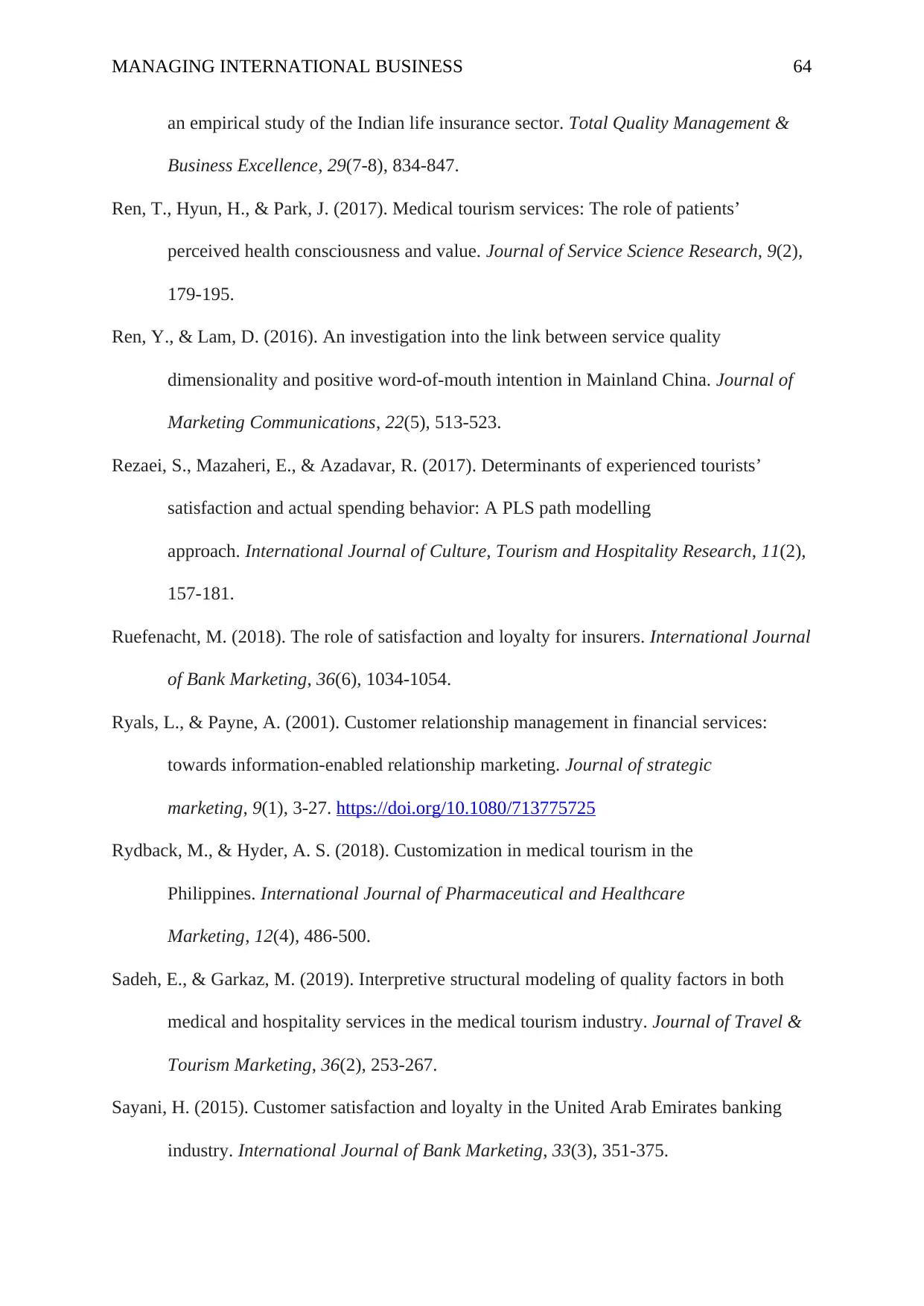
MANAGING INTERNATIONAL BUSINESS 64
an empirical study of the Indian life insurance sector. Total Quality Management &
Business Excellence, 29(7-8), 834-847.
Ren, T., Hyun, H., & Park, J. (2017). Medical tourism services: The role of patients’
perceived health consciousness and value. Journal of Service Science Research, 9(2),
179-195.
Ren, Y., & Lam, D. (2016). An investigation into the link between service quality
dimensionality and positive word-of-mouth intention in Mainland China. Journal of
Marketing Communications, 22(5), 513-523.
Rezaei, S., Mazaheri, E., & Azadavar, R. (2017). Determinants of experienced tourists’
satisfaction and actual spending behavior: A PLS path modelling
approach. International Journal of Culture, Tourism and Hospitality Research, 11(2),
157-181.
Ruefenacht, M. (2018). The role of satisfaction and loyalty for insurers. International Journal
of Bank Marketing, 36(6), 1034-1054.
Ryals, L., & Payne, A. (2001). Customer relationship management in financial services:
towards information-enabled relationship marketing. Journal of strategic
marketing, 9(1), 3-27. https://doi.org/10.1080/713775725
Rydback, M., & Hyder, A. S. (2018). Customization in medical tourism in the
Philippines. International Journal of Pharmaceutical and Healthcare
Marketing, 12(4), 486-500.
Sadeh, E., & Garkaz, M. (2019). Interpretive structural modeling of quality factors in both
medical and hospitality services in the medical tourism industry. Journal of Travel &
Tourism Marketing, 36(2), 253-267.
Sayani, H. (2015). Customer satisfaction and loyalty in the United Arab Emirates banking
industry. International Journal of Bank Marketing, 33(3), 351-375.
an empirical study of the Indian life insurance sector. Total Quality Management &
Business Excellence, 29(7-8), 834-847.
Ren, T., Hyun, H., & Park, J. (2017). Medical tourism services: The role of patients’
perceived health consciousness and value. Journal of Service Science Research, 9(2),
179-195.
Ren, Y., & Lam, D. (2016). An investigation into the link between service quality
dimensionality and positive word-of-mouth intention in Mainland China. Journal of
Marketing Communications, 22(5), 513-523.
Rezaei, S., Mazaheri, E., & Azadavar, R. (2017). Determinants of experienced tourists’
satisfaction and actual spending behavior: A PLS path modelling
approach. International Journal of Culture, Tourism and Hospitality Research, 11(2),
157-181.
Ruefenacht, M. (2018). The role of satisfaction and loyalty for insurers. International Journal
of Bank Marketing, 36(6), 1034-1054.
Ryals, L., & Payne, A. (2001). Customer relationship management in financial services:
towards information-enabled relationship marketing. Journal of strategic
marketing, 9(1), 3-27. https://doi.org/10.1080/713775725
Rydback, M., & Hyder, A. S. (2018). Customization in medical tourism in the
Philippines. International Journal of Pharmaceutical and Healthcare
Marketing, 12(4), 486-500.
Sadeh, E., & Garkaz, M. (2019). Interpretive structural modeling of quality factors in both
medical and hospitality services in the medical tourism industry. Journal of Travel &
Tourism Marketing, 36(2), 253-267.
Sayani, H. (2015). Customer satisfaction and loyalty in the United Arab Emirates banking
industry. International Journal of Bank Marketing, 33(3), 351-375.
Secure Best Marks with AI Grader
Need help grading? Try our AI Grader for instant feedback on your assignments.
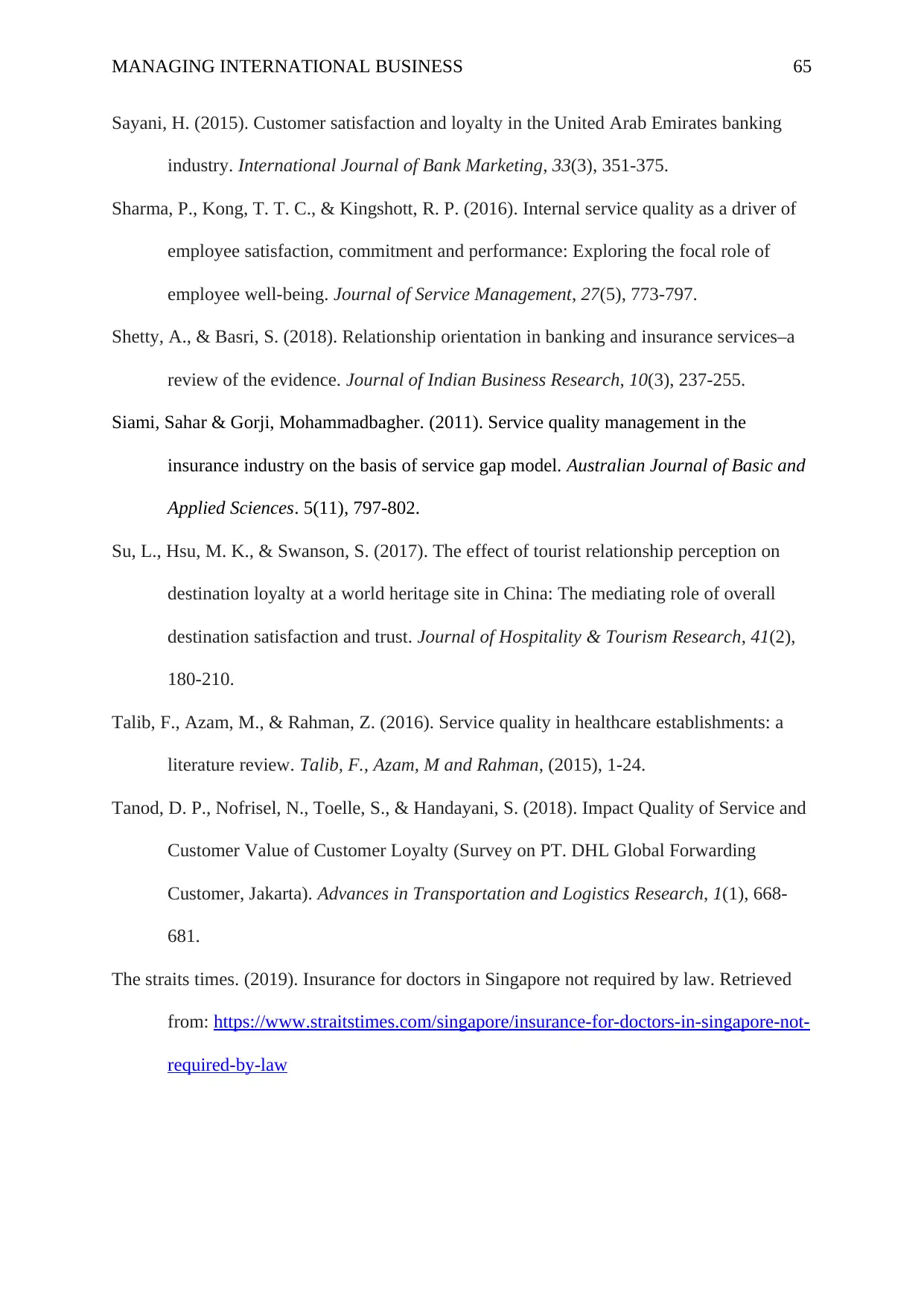
MANAGING INTERNATIONAL BUSINESS 65
Sayani, H. (2015). Customer satisfaction and loyalty in the United Arab Emirates banking
industry. International Journal of Bank Marketing, 33(3), 351-375.
Sharma, P., Kong, T. T. C., & Kingshott, R. P. (2016). Internal service quality as a driver of
employee satisfaction, commitment and performance: Exploring the focal role of
employee well-being. Journal of Service Management, 27(5), 773-797.
Shetty, A., & Basri, S. (2018). Relationship orientation in banking and insurance services–a
review of the evidence. Journal of Indian Business Research, 10(3), 237-255.
Siami, Sahar & Gorji, Mohammadbagher. (2011). Service quality management in the
insurance industry on the basis of service gap model. Australian Journal of Basic and
Applied Sciences. 5(11), 797-802.
Su, L., Hsu, M. K., & Swanson, S. (2017). The effect of tourist relationship perception on
destination loyalty at a world heritage site in China: The mediating role of overall
destination satisfaction and trust. Journal of Hospitality & Tourism Research, 41(2),
180-210.
Talib, F., Azam, M., & Rahman, Z. (2016). Service quality in healthcare establishments: a
literature review. Talib, F., Azam, M and Rahman, (2015), 1-24.
Tanod, D. P., Nofrisel, N., Toelle, S., & Handayani, S. (2018). Impact Quality of Service and
Customer Value of Customer Loyalty (Survey on PT. DHL Global Forwarding
Customer, Jakarta). Advances in Transportation and Logistics Research, 1(1), 668-
681.
The straits times. (2019). Insurance for doctors in Singapore not required by law. Retrieved
from: https://www.straitstimes.com/singapore/insurance-for-doctors-in-singapore-not-
required-by-law
Sayani, H. (2015). Customer satisfaction and loyalty in the United Arab Emirates banking
industry. International Journal of Bank Marketing, 33(3), 351-375.
Sharma, P., Kong, T. T. C., & Kingshott, R. P. (2016). Internal service quality as a driver of
employee satisfaction, commitment and performance: Exploring the focal role of
employee well-being. Journal of Service Management, 27(5), 773-797.
Shetty, A., & Basri, S. (2018). Relationship orientation in banking and insurance services–a
review of the evidence. Journal of Indian Business Research, 10(3), 237-255.
Siami, Sahar & Gorji, Mohammadbagher. (2011). Service quality management in the
insurance industry on the basis of service gap model. Australian Journal of Basic and
Applied Sciences. 5(11), 797-802.
Su, L., Hsu, M. K., & Swanson, S. (2017). The effect of tourist relationship perception on
destination loyalty at a world heritage site in China: The mediating role of overall
destination satisfaction and trust. Journal of Hospitality & Tourism Research, 41(2),
180-210.
Talib, F., Azam, M., & Rahman, Z. (2016). Service quality in healthcare establishments: a
literature review. Talib, F., Azam, M and Rahman, (2015), 1-24.
Tanod, D. P., Nofrisel, N., Toelle, S., & Handayani, S. (2018). Impact Quality of Service and
Customer Value of Customer Loyalty (Survey on PT. DHL Global Forwarding
Customer, Jakarta). Advances in Transportation and Logistics Research, 1(1), 668-
681.
The straits times. (2019). Insurance for doctors in Singapore not required by law. Retrieved
from: https://www.straitstimes.com/singapore/insurance-for-doctors-in-singapore-not-
required-by-law
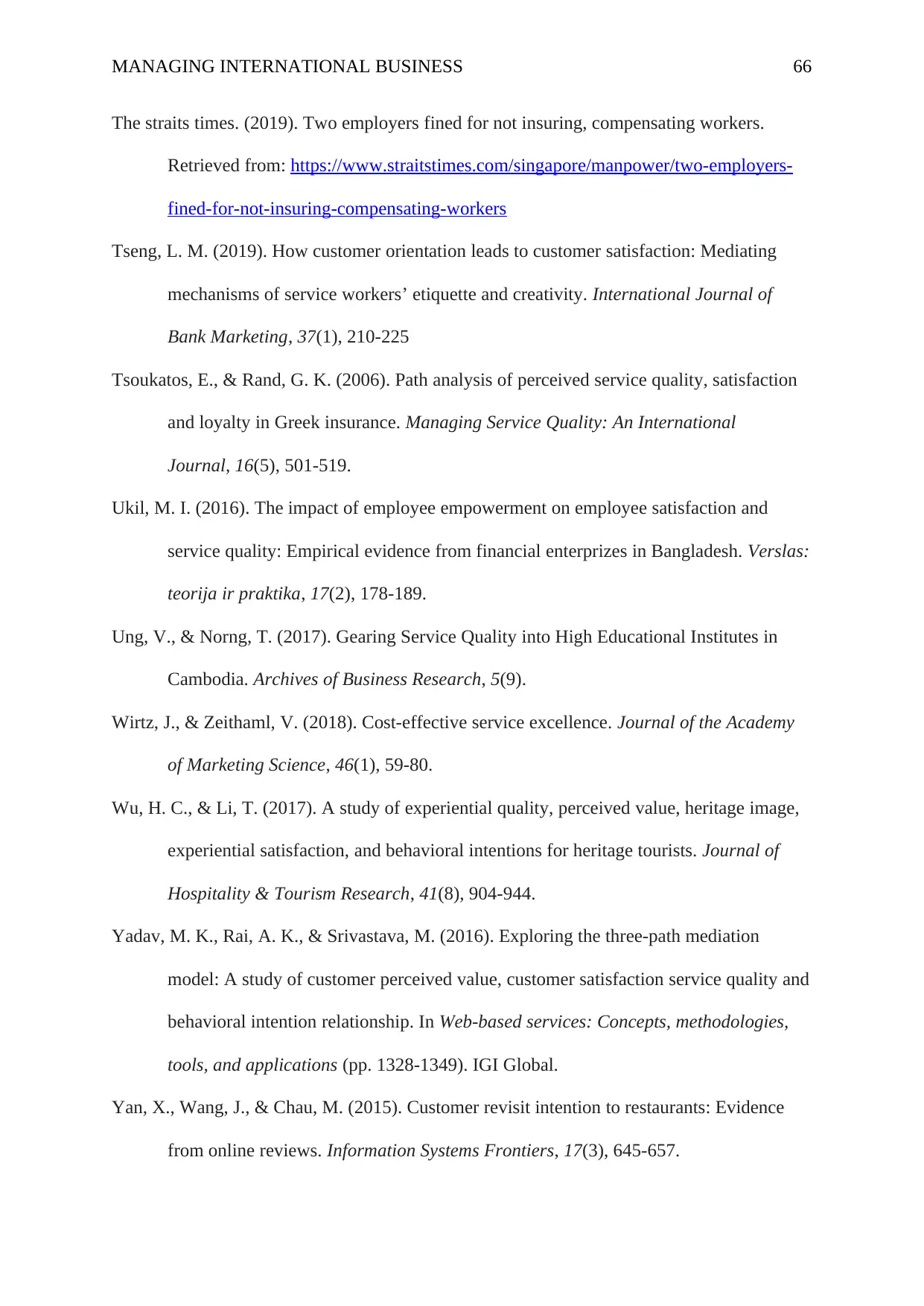
MANAGING INTERNATIONAL BUSINESS 66
The straits times. (2019). Two employers fined for not insuring, compensating workers.
Retrieved from: https://www.straitstimes.com/singapore/manpower/two-employers-
fined-for-not-insuring-compensating-workers
Tseng, L. M. (2019). How customer orientation leads to customer satisfaction: Mediating
mechanisms of service workers’ etiquette and creativity. International Journal of
Bank Marketing, 37(1), 210-225
Tsoukatos, E., & Rand, G. K. (2006). Path analysis of perceived service quality, satisfaction
and loyalty in Greek insurance. Managing Service Quality: An International
Journal, 16(5), 501-519.
Ukil, M. I. (2016). The impact of employee empowerment on employee satisfaction and
service quality: Empirical evidence from financial enterprizes in Bangladesh. Verslas:
teorija ir praktika, 17(2), 178-189.
Ung, V., & Norng, T. (2017). Gearing Service Quality into High Educational Institutes in
Cambodia. Archives of Business Research, 5(9).
Wirtz, J., & Zeithaml, V. (2018). Cost-effective service excellence. Journal of the Academy
of Marketing Science, 46(1), 59-80.
Wu, H. C., & Li, T. (2017). A study of experiential quality, perceived value, heritage image,
experiential satisfaction, and behavioral intentions for heritage tourists. Journal of
Hospitality & Tourism Research, 41(8), 904-944.
Yadav, M. K., Rai, A. K., & Srivastava, M. (2016). Exploring the three-path mediation
model: A study of customer perceived value, customer satisfaction service quality and
behavioral intention relationship. In Web-based services: Concepts, methodologies,
tools, and applications (pp. 1328-1349). IGI Global.
Yan, X., Wang, J., & Chau, M. (2015). Customer revisit intention to restaurants: Evidence
from online reviews. Information Systems Frontiers, 17(3), 645-657.
The straits times. (2019). Two employers fined for not insuring, compensating workers.
Retrieved from: https://www.straitstimes.com/singapore/manpower/two-employers-
fined-for-not-insuring-compensating-workers
Tseng, L. M. (2019). How customer orientation leads to customer satisfaction: Mediating
mechanisms of service workers’ etiquette and creativity. International Journal of
Bank Marketing, 37(1), 210-225
Tsoukatos, E., & Rand, G. K. (2006). Path analysis of perceived service quality, satisfaction
and loyalty in Greek insurance. Managing Service Quality: An International
Journal, 16(5), 501-519.
Ukil, M. I. (2016). The impact of employee empowerment on employee satisfaction and
service quality: Empirical evidence from financial enterprizes in Bangladesh. Verslas:
teorija ir praktika, 17(2), 178-189.
Ung, V., & Norng, T. (2017). Gearing Service Quality into High Educational Institutes in
Cambodia. Archives of Business Research, 5(9).
Wirtz, J., & Zeithaml, V. (2018). Cost-effective service excellence. Journal of the Academy
of Marketing Science, 46(1), 59-80.
Wu, H. C., & Li, T. (2017). A study of experiential quality, perceived value, heritage image,
experiential satisfaction, and behavioral intentions for heritage tourists. Journal of
Hospitality & Tourism Research, 41(8), 904-944.
Yadav, M. K., Rai, A. K., & Srivastava, M. (2016). Exploring the three-path mediation
model: A study of customer perceived value, customer satisfaction service quality and
behavioral intention relationship. In Web-based services: Concepts, methodologies,
tools, and applications (pp. 1328-1349). IGI Global.
Yan, X., Wang, J., & Chau, M. (2015). Customer revisit intention to restaurants: Evidence
from online reviews. Information Systems Frontiers, 17(3), 645-657.
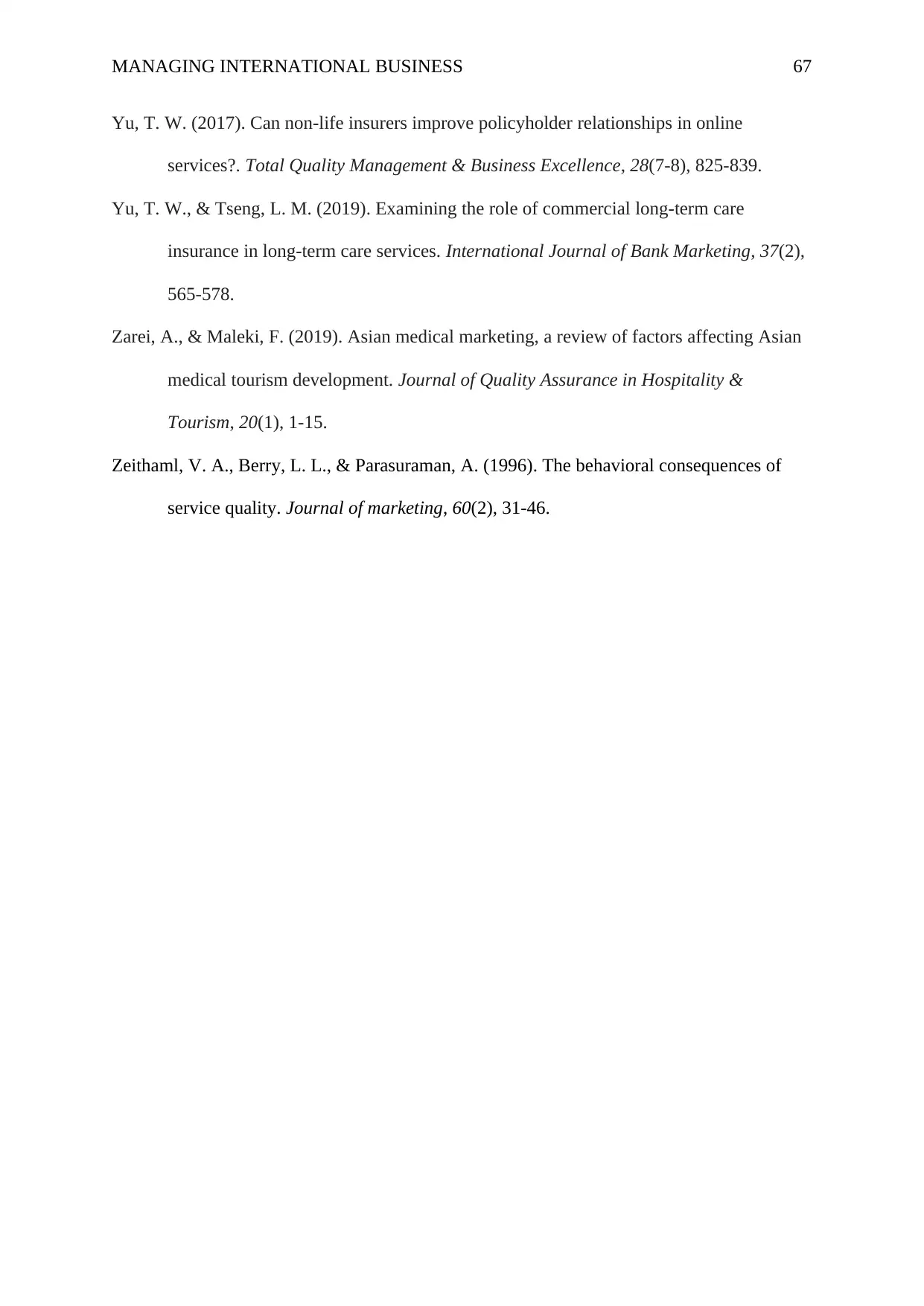
MANAGING INTERNATIONAL BUSINESS 67
Yu, T. W. (2017). Can non-life insurers improve policyholder relationships in online
services?. Total Quality Management & Business Excellence, 28(7-8), 825-839.
Yu, T. W., & Tseng, L. M. (2019). Examining the role of commercial long-term care
insurance in long-term care services. International Journal of Bank Marketing, 37(2),
565-578.
Zarei, A., & Maleki, F. (2019). Asian medical marketing, a review of factors affecting Asian
medical tourism development. Journal of Quality Assurance in Hospitality &
Tourism, 20(1), 1-15.
Zeithaml, V. A., Berry, L. L., & Parasuraman, A. (1996). The behavioral consequences of
service quality. Journal of marketing, 60(2), 31-46.
Yu, T. W. (2017). Can non-life insurers improve policyholder relationships in online
services?. Total Quality Management & Business Excellence, 28(7-8), 825-839.
Yu, T. W., & Tseng, L. M. (2019). Examining the role of commercial long-term care
insurance in long-term care services. International Journal of Bank Marketing, 37(2),
565-578.
Zarei, A., & Maleki, F. (2019). Asian medical marketing, a review of factors affecting Asian
medical tourism development. Journal of Quality Assurance in Hospitality &
Tourism, 20(1), 1-15.
Zeithaml, V. A., Berry, L. L., & Parasuraman, A. (1996). The behavioral consequences of
service quality. Journal of marketing, 60(2), 31-46.
Paraphrase This Document
Need a fresh take? Get an instant paraphrase of this document with our AI Paraphraser
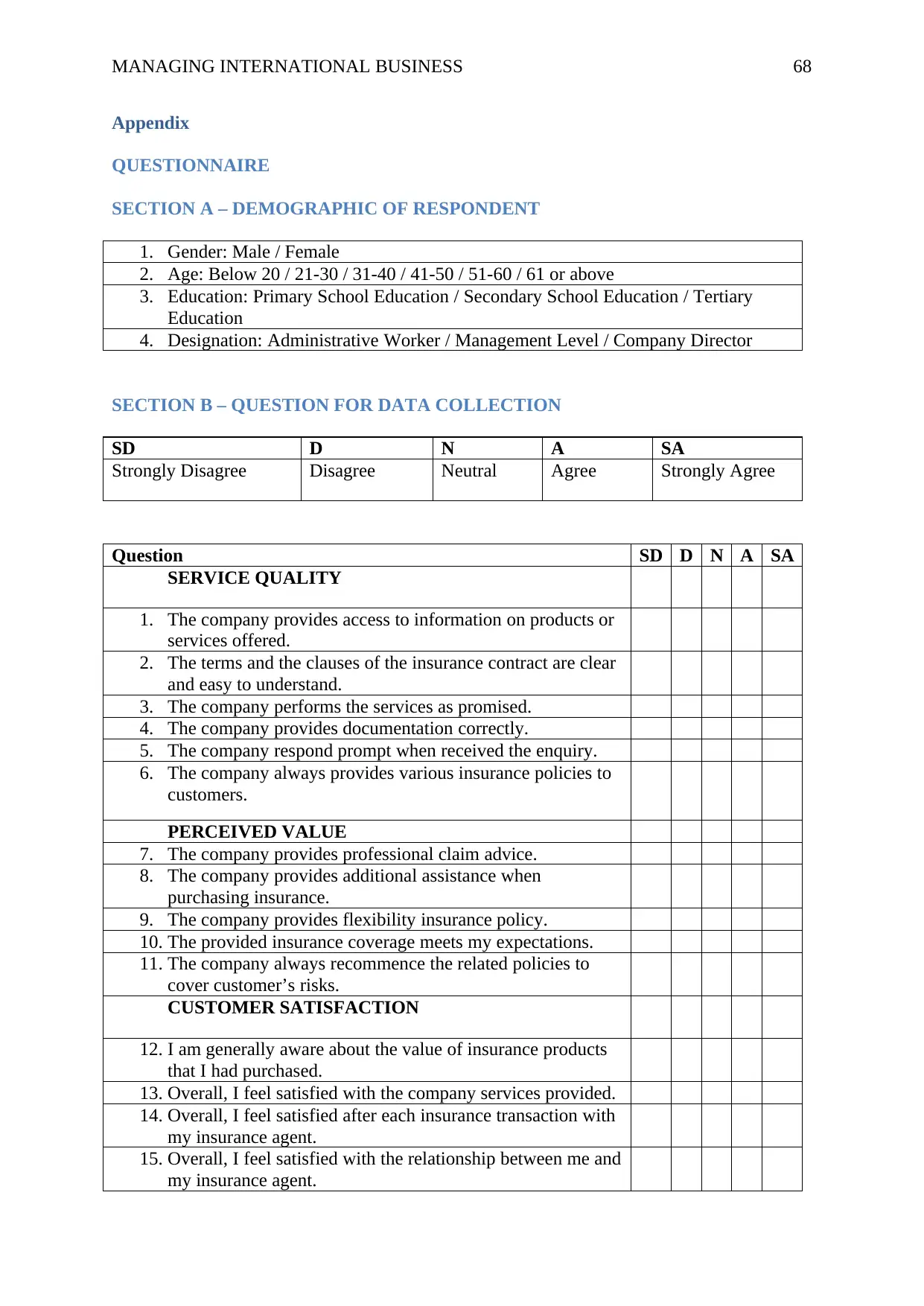
MANAGING INTERNATIONAL BUSINESS 68
Appendix
QUESTIONNAIRE
SECTION A – DEMOGRAPHIC OF RESPONDENT
1. Gender: Male / Female
2. Age: Below 20 / 21-30 / 31-40 / 41-50 / 51-60 / 61 or above
3. Education: Primary School Education / Secondary School Education / Tertiary
Education
4. Designation: Administrative Worker / Management Level / Company Director
SECTION B – QUESTION FOR DATA COLLECTION
SD D N A SA
Strongly Disagree Disagree Neutral Agree Strongly Agree
Question SD D N A SA
SERVICE QUALITY
1. The company provides access to information on products or
services offered.
2. The terms and the clauses of the insurance contract are clear
and easy to understand.
3. The company performs the services as promised.
4. The company provides documentation correctly.
5. The company respond prompt when received the enquiry.
6. The company always provides various insurance policies to
customers.
PERCEIVED VALUE
7. The company provides professional claim advice.
8. The company provides additional assistance when
purchasing insurance.
9. The company provides flexibility insurance policy.
10. The provided insurance coverage meets my expectations.
11. The company always recommence the related policies to
cover customer’s risks.
CUSTOMER SATISFACTION
12. I am generally aware about the value of insurance products
that I had purchased.
13. Overall, I feel satisfied with the company services provided.
14. Overall, I feel satisfied after each insurance transaction with
my insurance agent.
15. Overall, I feel satisfied with the relationship between me and
my insurance agent.
Appendix
QUESTIONNAIRE
SECTION A – DEMOGRAPHIC OF RESPONDENT
1. Gender: Male / Female
2. Age: Below 20 / 21-30 / 31-40 / 41-50 / 51-60 / 61 or above
3. Education: Primary School Education / Secondary School Education / Tertiary
Education
4. Designation: Administrative Worker / Management Level / Company Director
SECTION B – QUESTION FOR DATA COLLECTION
SD D N A SA
Strongly Disagree Disagree Neutral Agree Strongly Agree
Question SD D N A SA
SERVICE QUALITY
1. The company provides access to information on products or
services offered.
2. The terms and the clauses of the insurance contract are clear
and easy to understand.
3. The company performs the services as promised.
4. The company provides documentation correctly.
5. The company respond prompt when received the enquiry.
6. The company always provides various insurance policies to
customers.
PERCEIVED VALUE
7. The company provides professional claim advice.
8. The company provides additional assistance when
purchasing insurance.
9. The company provides flexibility insurance policy.
10. The provided insurance coverage meets my expectations.
11. The company always recommence the related policies to
cover customer’s risks.
CUSTOMER SATISFACTION
12. I am generally aware about the value of insurance products
that I had purchased.
13. Overall, I feel satisfied with the company services provided.
14. Overall, I feel satisfied after each insurance transaction with
my insurance agent.
15. Overall, I feel satisfied with the relationship between me and
my insurance agent.
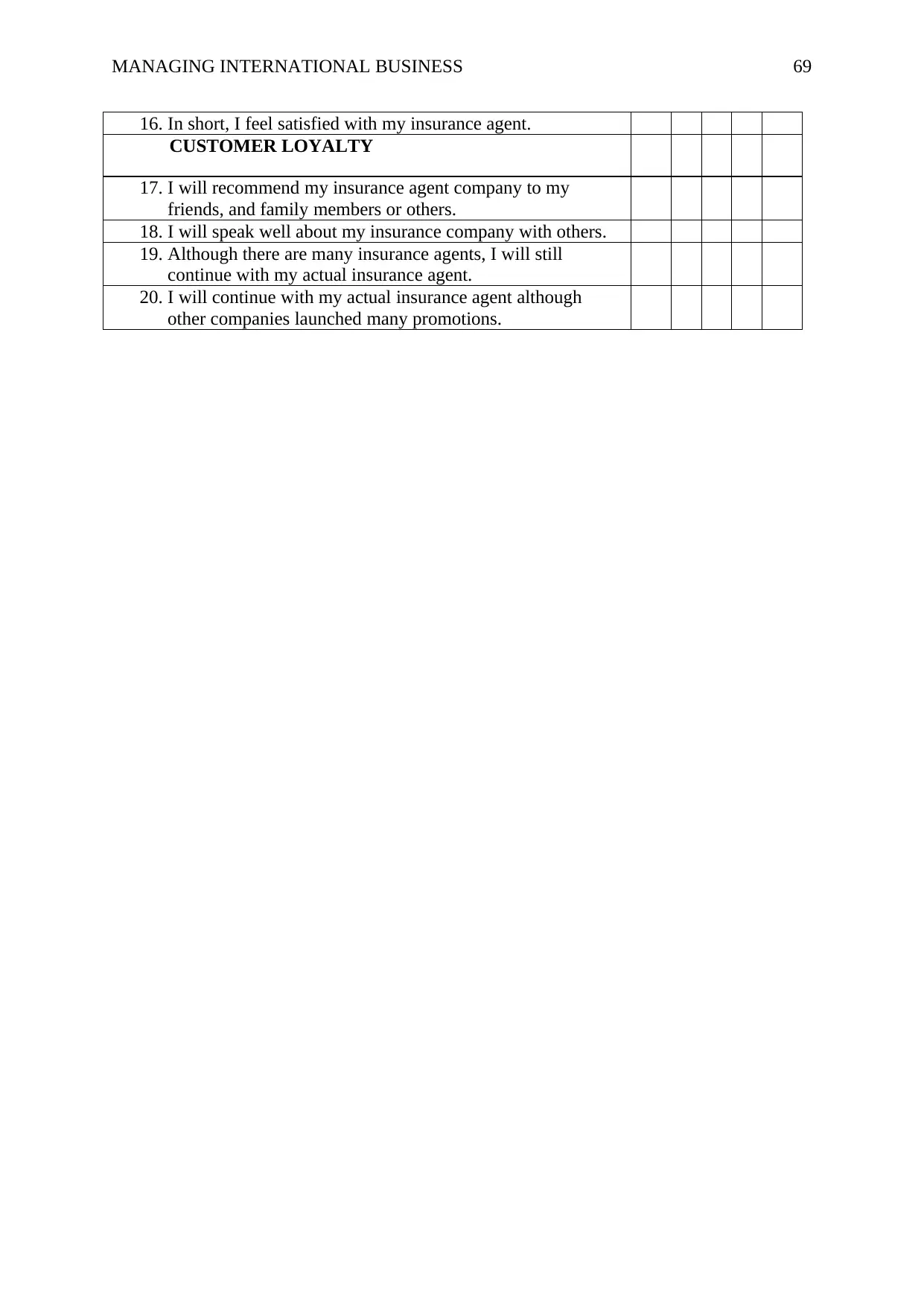
MANAGING INTERNATIONAL BUSINESS 69
16. In short, I feel satisfied with my insurance agent.
CUSTOMER LOYALTY
17. I will recommend my insurance agent company to my
friends, and family members or others.
18. I will speak well about my insurance company with others.
19. Although there are many insurance agents, I will still
continue with my actual insurance agent.
20. I will continue with my actual insurance agent although
other companies launched many promotions.
16. In short, I feel satisfied with my insurance agent.
CUSTOMER LOYALTY
17. I will recommend my insurance agent company to my
friends, and family members or others.
18. I will speak well about my insurance company with others.
19. Although there are many insurance agents, I will still
continue with my actual insurance agent.
20. I will continue with my actual insurance agent although
other companies launched many promotions.
1 out of 69
Related Documents
Your All-in-One AI-Powered Toolkit for Academic Success.
+13062052269
info@desklib.com
Available 24*7 on WhatsApp / Email
![[object Object]](/_next/static/media/star-bottom.7253800d.svg)
Unlock your academic potential
© 2024 | Zucol Services PVT LTD | All rights reserved.





